

Traveling To Japan With A Baby Or Toddler: What To Know!
THIS POST MAY CONTAIN COMPENSATED LINKS. FIND MORE INFO IN MY DISCLAIMER.
Home » Traveling To Japan With A Baby Or Toddler: What To Know!
There’s no denying it: All countries are different. But believe it or not, Japan is somehow more different than most.
Imagine a country where tipping is considered disrespectful; English is not the national language but is widely used and understood!
For any grown-up visitor, Japan is an exotic destination. It is a unique country that offers an exciting escape from familiar surroundings, with its peculiarity being part of the captivating appeal.
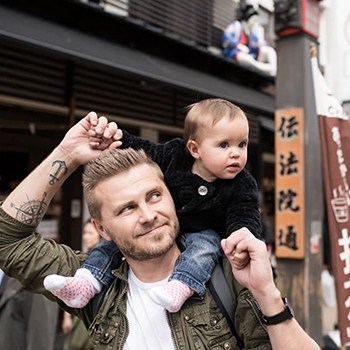
🏆 Best Baby-Friendly Hotels in Japan
Don’t have time to read the whole article? Here are my picks for baby and toddler-friendly hotels in Japan!
- Hotel In Tokyo: Imperial Hotel Tokyo (5-Star) (Where we stayed!)
- Hotel In Kyoto: Hotel Imagine Kyoto (4-Star) (Where I wished we stayed!)
- Hotel In Osaka: Hotel Nikko Osaka (4-Star) (Most popular hotel for families)
The big question, however, remains; can you travel to Japan with a baby or toddler?
Is Japan safe and baby-friendly? And where can you stock up on baby supplies?
We cover all these questions in our guide below.
What You Will Find In This Article:
Click to hop straight to these sections.
- Is Japan Baby-Friendly ?
- Japan with a Baby: Everything You Need To Know (Tips, What to expect, where to find supplies & more!)
- Where to go in Japan with a Baby or Toddler
Traveling to Japan with a Baby: Is Japan Baby-Friendly?
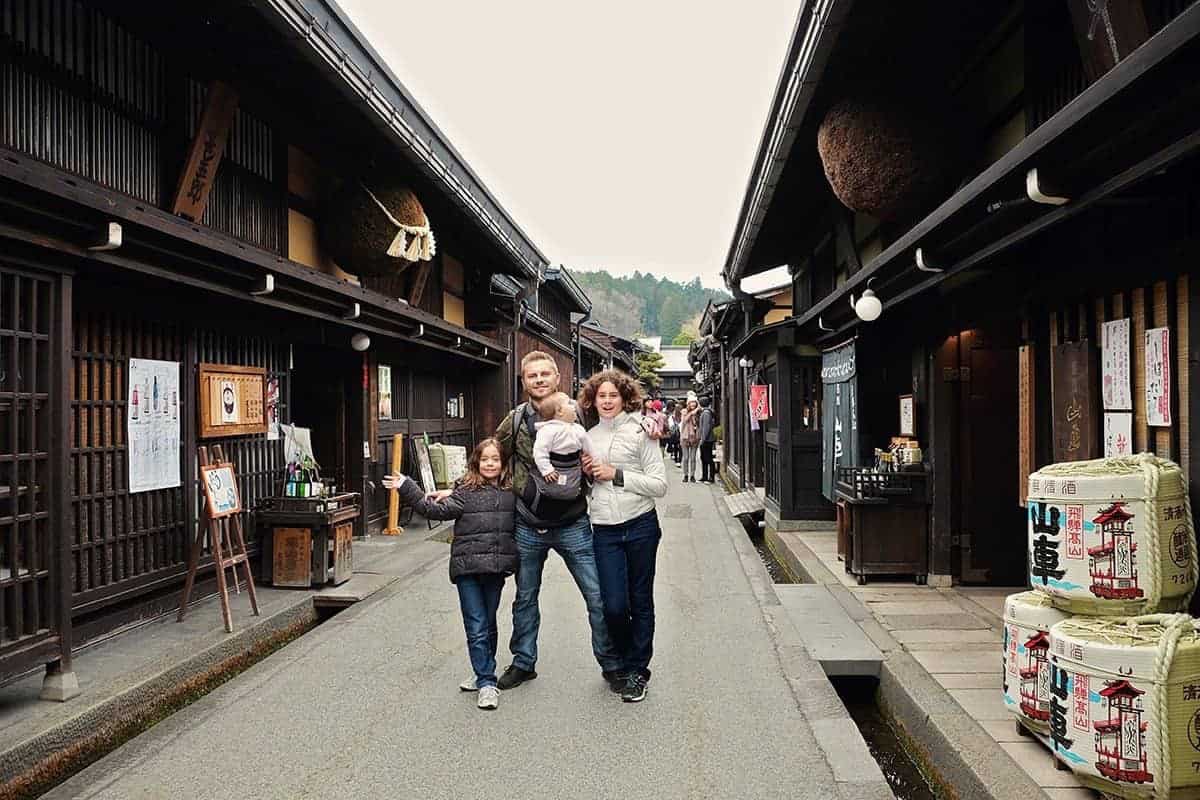
We have read repeatedly about how baby-friendly Japan is, yet we found the holiday a bit challenging (*honest truth).
(We have a complete guide of other ideas on the best places to go on a holiday with a baby .)
So here are my thoughts: if you are traveling to Japan with only a baby (and no other kids), I think Japan is a great destination. It is also crucial to pick one to three destinations at most to visit during your trip (we did seven different places). Keep it easy.
We were traveling with three kids, though, and together with having to drag luggage + hold hands + carry a baby up and down stairs to subways & train stations regularly ; we found the trip REALLY HARD. The same would be true if you visited Japan with a toddler.
However, I have some invaluable tips on how to ensure your holiday will be easier than ours! Learn from our mistakes and take them on board.
There are definitely many benefits to visiting Japan with a baby. The country is safe.
You can find baby supplies in the stores. The streets are stroller-friendly.
You will even often see little baby seats in toilet cubicles so you can pop your baby down whilst you do what you need to do.
A vacation to Japan is a once-in-a-lifetime opportunity that promises lots of adventure, education, and a giddy blend of culture, it is always worth a little challenge.
Guide to a Baby-Friendly Japan Trip: Top Tips + Everything You Should Know
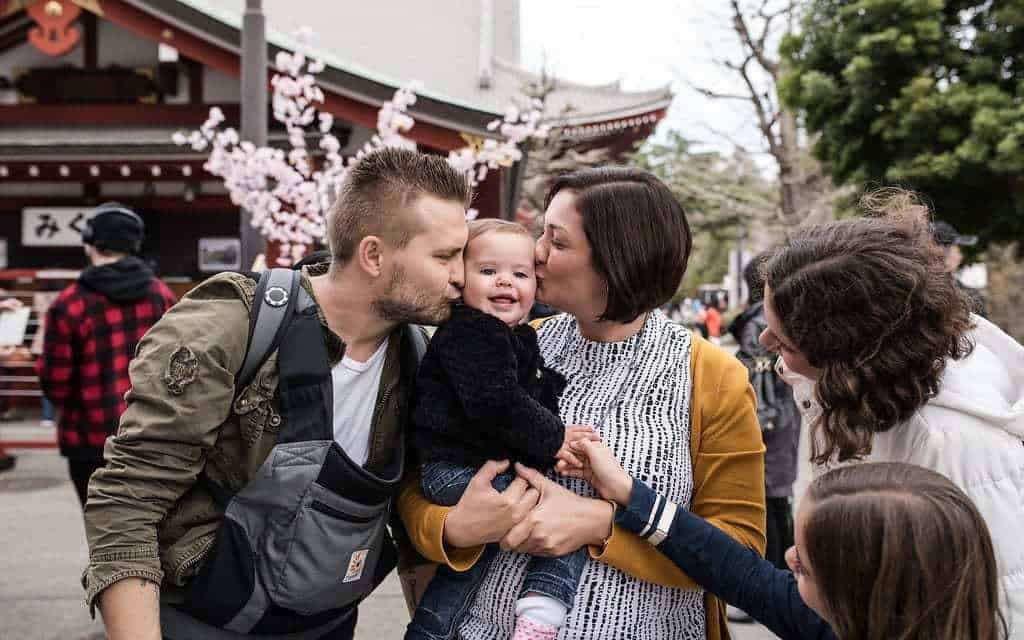
Before you embark on your journey to Japan, these great tips will help you create the ultimate baby holiday in Japan.
This guide will also be helpful to those traveling to Japan with a toddler.
You will find all the information about how to prepare for your trip, where to find baby supplies, how to explore, and more!
You will find information on where to go in Japan with a baby or toddler down lower in the post.
1. Passports
Children are required to have their passports to be allowed to travel to and around Japan.
You will also need to carry the passport when you travel on trains as you might be required to show it.
2. Vaccinations
There are no mandatory vaccinations for a child to travel to Japan.
3. Don’t Pack Too Much!
Getting from one destination/attraction to the next in Japan can be a bit of a mission when you have too much luggage, especially when traveling with your baby!
While the train system is super-efficient, taxis are costly , so you will most likely use the trains to get around.
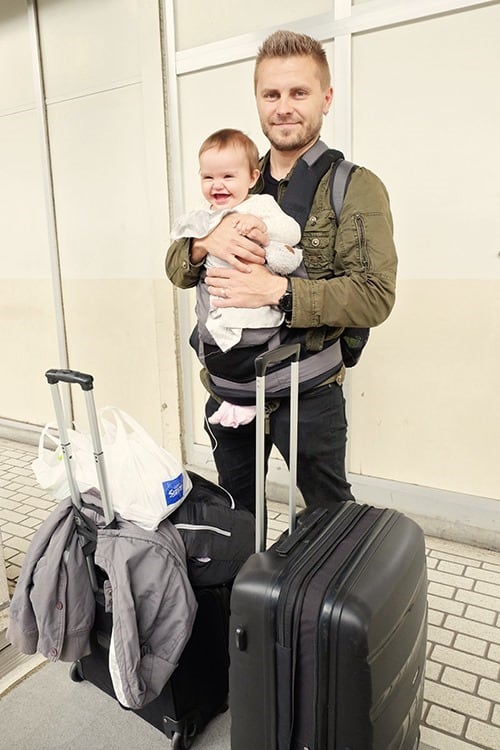
We found that very few stations had lifts or escalators, which meant that we had to carry our baby (in a carrier) and all the luggage down and up too many stairs.
So is Japan baby friendly? Not always!
Try to minimize and pack as light as you can.
Think hard about which items you will really need. (We have a complete list of the best baby travel gear you might find helpful).
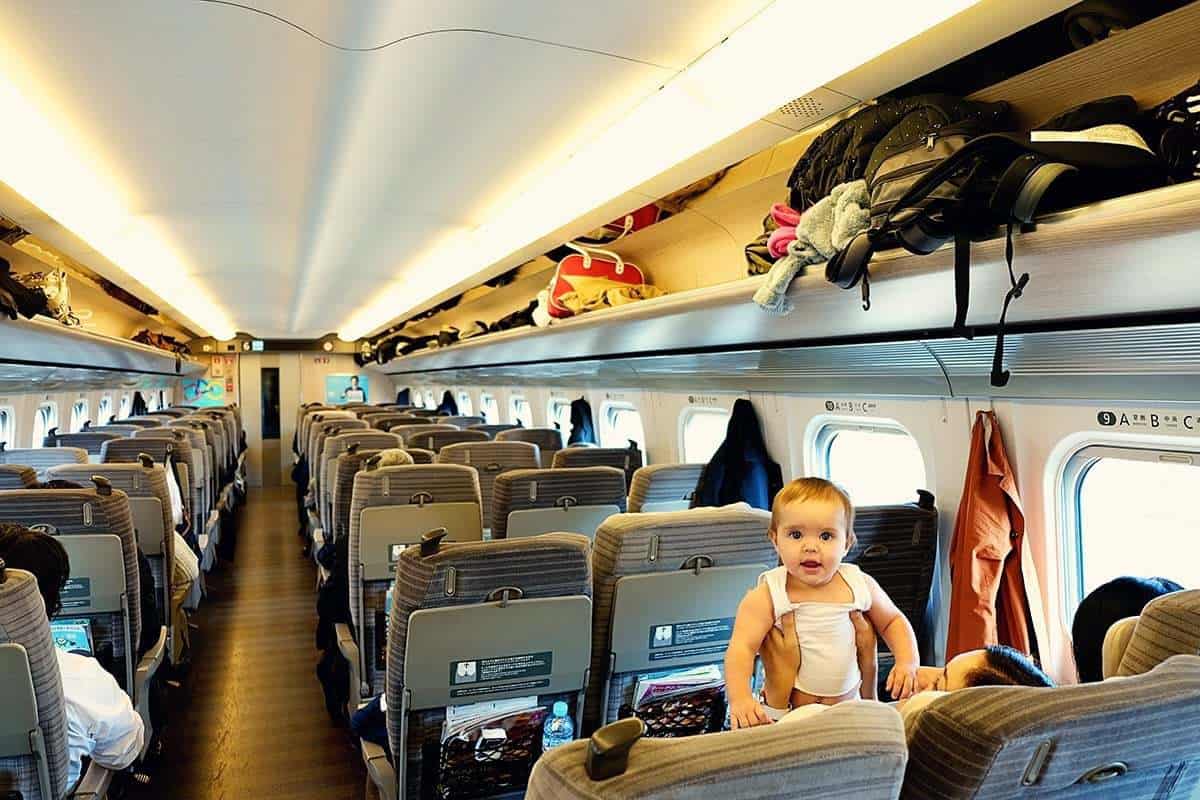
You will also need to be able to fit the luggage in the luggage compartment above your seat (see the photo above to see how much space you have – not much!).
Tip: If, like us, you find it too hard to drag all your luggage from one destination to the next, here is a handy tip: Japan has a luggage forwarding system!
We used this because we got so sick and tired of struggling to get from point A to point B.
Essentially, you can organize and pay for your luggage to be collected from your hotel in one city and dropped off at your hotel in the next city.
You can do this at the hotel reception. We thought the prices were pretty reasonable (nothing in Japan is cheap).
Important to note that the process typically works overnight, so you will have your bag the next day (depending on how far they have to travel).
So we always took our essentials in one suitcase and only carried that suitcase with us.
You can learn more about this forwarding system here .
4. Be Prepared for the Flight to Japan
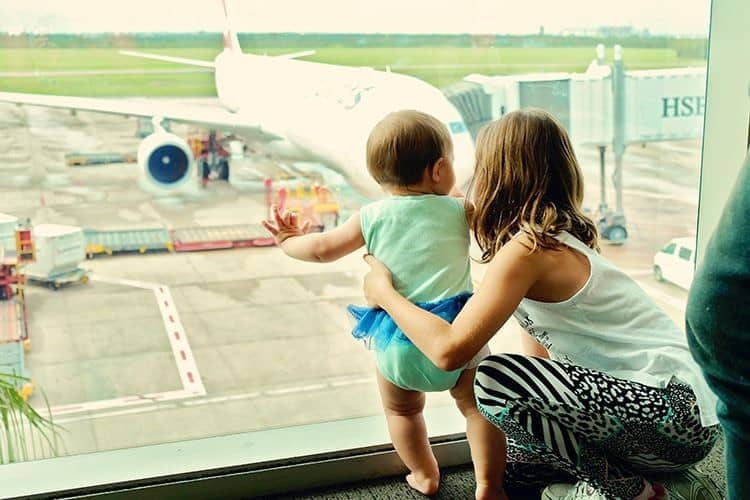
Remember to book bulkhead seats with a bassinet when traveling to Japan with a baby.
You can use the bassinet and have loads more room (and no reclining seats in front of you!).
You should also know what your ticket price includes.
If your baby is eating solids, remember to call the airline and request a baby meal. This meal usually includes a drink box and some pureed food pouches.
Remember, airline food is never guaranteed to be a hit with kids. So make sure you have your own snacks and baby food supplies for the trip on hand.
- We have loads of tips for flying with a baby that you can read in our post here .
- You can also find bucketloads of traveling with baby tips by clicking on our baby or toddler travel guide here.
- Find a list of the best travel items for toddlers in our complete guide here.
5. Is Japan Stroller Friendly?
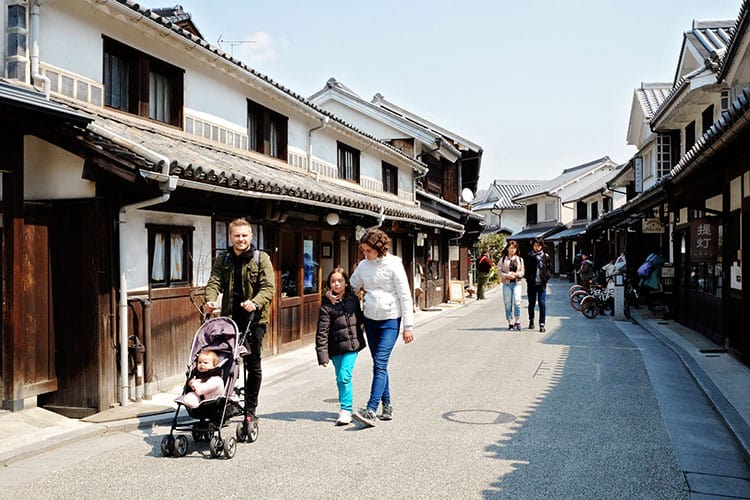
The streets and parks are definitely stroller friendly! In fact, there is so much walking from subway stations to tourist attractions that a stroller could definitely be useful.
The only thing is that there are typically no lifts or escalators leading to the subway station and you might have lots of stairs to climb, so my suggestion is to make sure that you have a lightweight stroller.
When we visited Japan, our daughter was still pretty young and so we mostly had her in a baby carrier.
It was cold during our trip so it also helped to keep her warm as we didn’t have all the fancy gear that Japanese moms use to keep their little ones warm in the strollers.
We actually ended up sending our stroller to the storage at the airport as we got sick and tired of carrying it up and down the stairs at subway stations, but if our daughter was older and heavier I think we would have kept our stroller instead.
6. Travel Slower
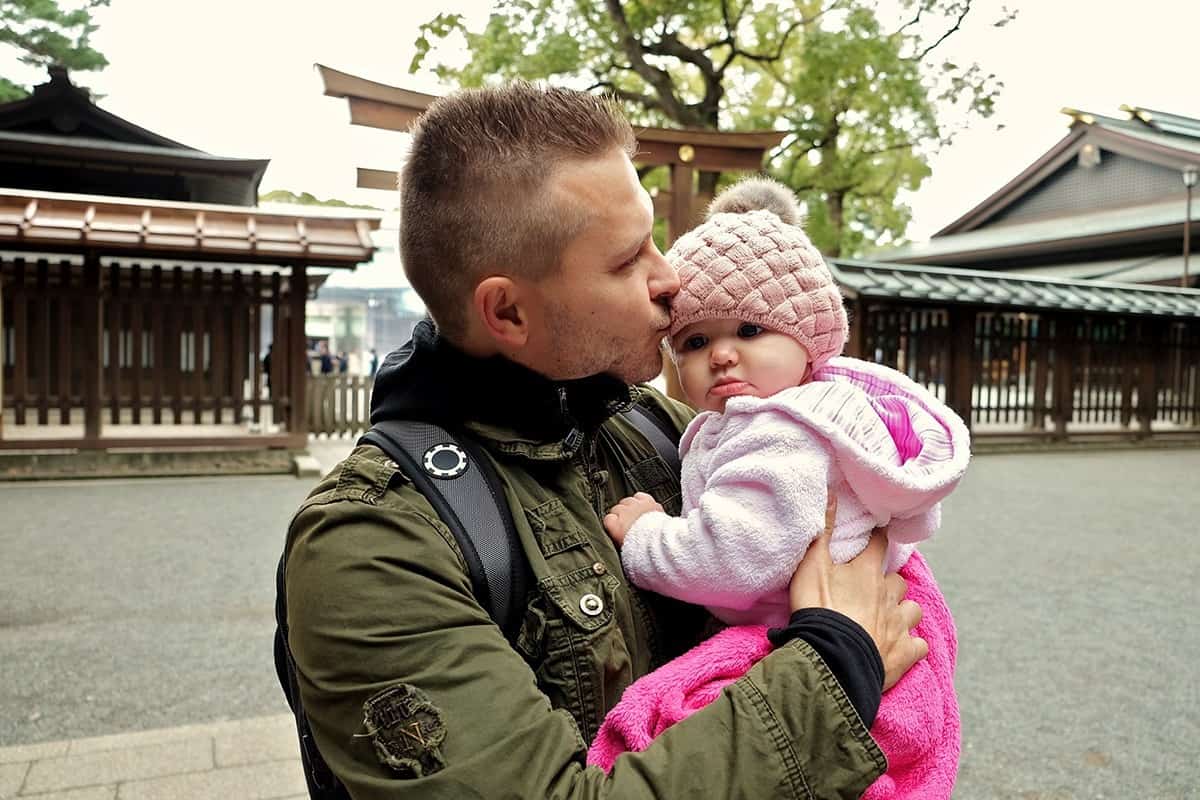
Traveling through Japan with a little one will undoubtedly slow you down.
One of the downsides is that you won’t be able to visit as many locations as you’d have wanted.
You should, therefore, always consider planning activities that are close to one another.
Ensure you travel slower and allow plenty of time for your baby to be changed, fed, or rocked to sleep.
Don’t forget to schedule some downtime for yourself too; otherwise , you might get exhausted.
Because it can be so tricky getting from point A to B in Japan with a baby, I recommend minimizing the number of cities you will be visiting.
We tried to see Tokyo, Kyoto , Miyajima , Nara, Shirakawa-Go, Takayama , and Kanazawa on our 3-week trip, and we were exhausted by the end of it!
So pick 1-3 cities for your trip and keep it simple and easy.
Tokyo with a baby is lots of fun, and so is Osaka and Tokyo – you can find more information about these cities down further in our post!
7. Always go for Public Transport in Japan
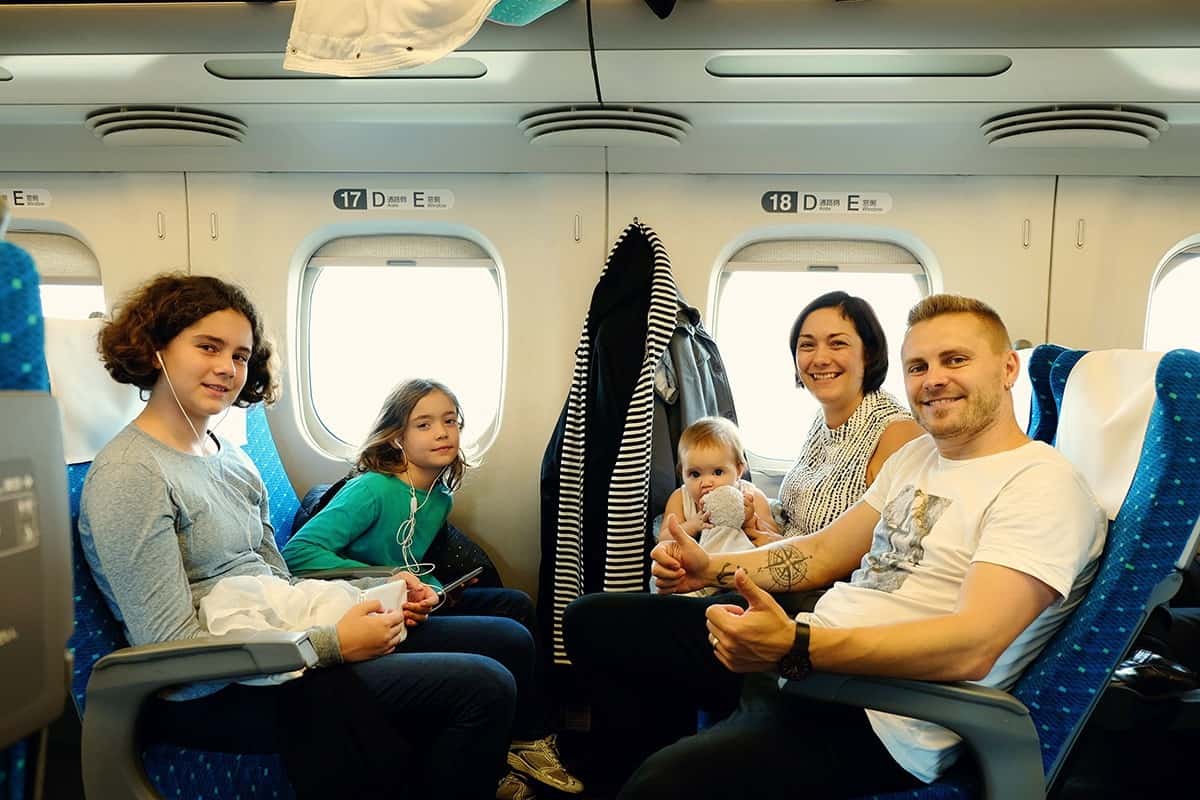
While we are on the topic of transport, here is another tip: If you’re planning to stay in Japan for longer than a week and plan to travel between major cities such as Tokyo, Osaka, and Kyoto (which is obvious), traveling by rail would be the most economical option.
Japanese public transport is undoubtedly one of the best in the world!
So whether it’s a bus, a subway, or the Japan Rail Pass (basically long-distance train travel), Japanese public transport is a great option for those with kids. Kids under the age of 6 can travel for free, and kids between 6 and 12 will be half-price.
This makes Japan with kids a whole lot more affordable!
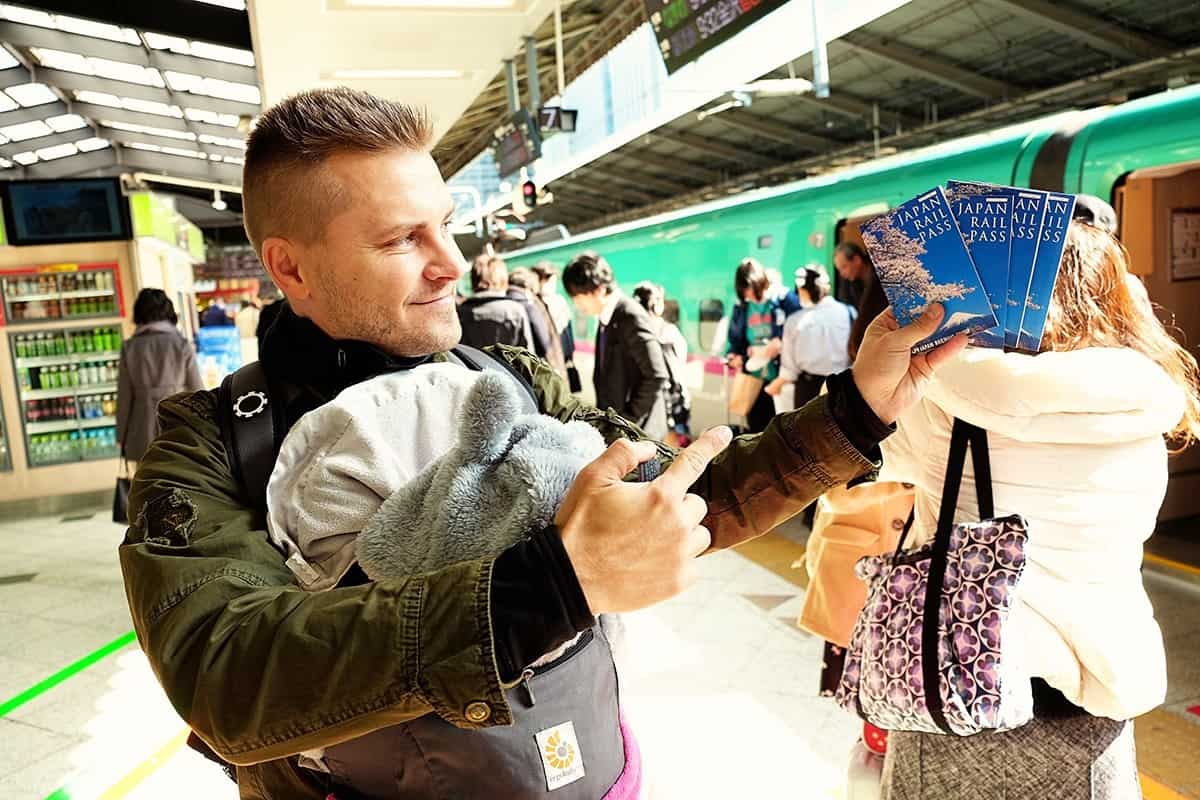
- Further Reading: Let us help you decide whether the Japan Rail Pass will be of benefit to you.
Tip: Always avoid rush hour in the main cities. This is because it can sometimes get hectic, and the lack of space can scare the little one.
You will be surprised at how many people can squash into the trains at these times. I wouldn’t recommend it.
The weekday rush hours peak between 8 am and 9 am in the morning and shortly after 5 pm in the evening.
8. Do you Need a Car Seat in Japan?
Legally if you rent a car you do need to use a car seat for children under 6 years of age, you can find more information on car seats in Japan here .
Because taxis are so expensive we only used a taxi once and we did not use a car seat for the taxi.
We also hired a private driver to take us from Kanazawa to Shirakawa-Go because the bus was already sold out. The drive took around 1 hour and we did not have a car seat.
Overall I highly suggest a car seat for obvious safety reasons. We planned on public transport and relied on trains and buses because we did not want to carry a car seat around with us on top of all the other luggage.
9. Try to Travel Hands-Free
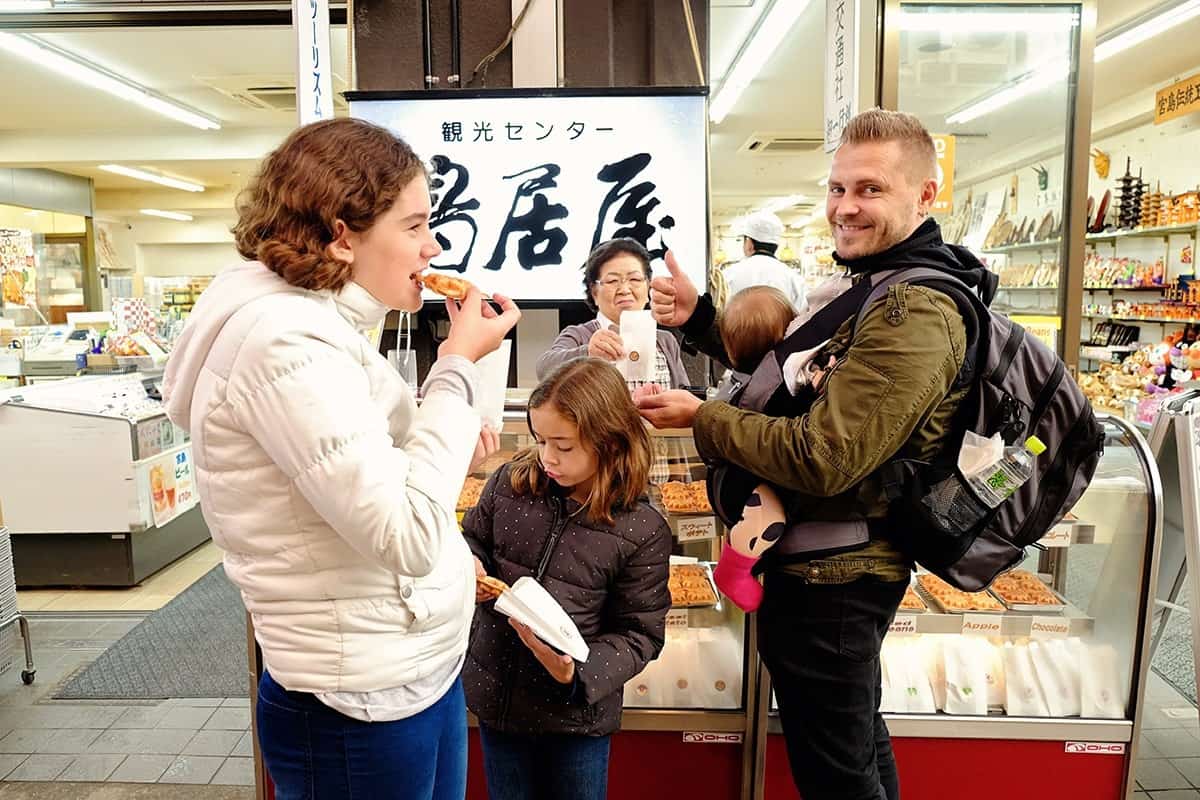
We found that many attractions were located in beautiful hilly areas, which meant that not only did we have to deal with stairs at the train stations, but we also had to climb stairs at the attractions!
While we did indeed take our baby stroller along, we barely ever used it on our Japan trip, and I would suggest that you leave it behind altogether.
Instead, try to travel hands-free. We had Avalee in a baby carrier all the time. It made life so much easier as we climbed many stairs at attractions or headed down all the stairs to the subways.
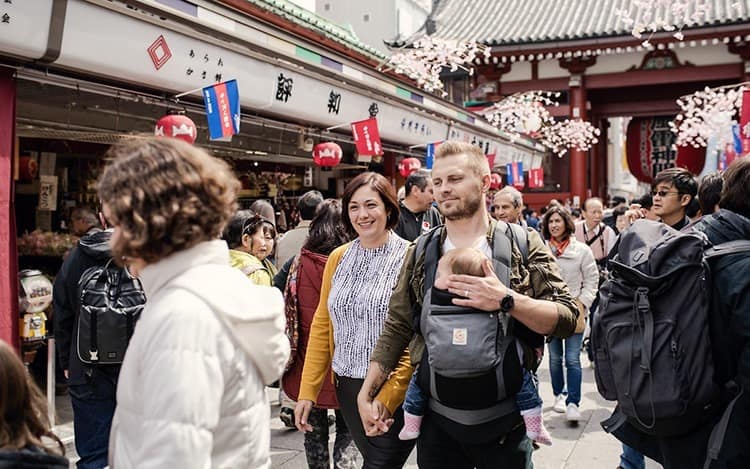
We also prefer to travel with a backpack diaper bag , which is great to not only balance out the weight of our baby on the front but also makes it easier for us to have our hands free to deal with money and tickets (and to hold our other two daughters hands at the busy train stations).
Tip: If you find that you do need a stroller, you can always rent one.
There are a lot of online shops that offer baby cots, car seats, baby carriers, and many more baby amenities at affordable prices.
There’s also some great baby food in Japan! Everything is in Japanese , so best to ask your hotel receptionist to help you. They tend to be super friendly and happy to help.
Most of the department stores and shopping centers in Tokyo have free stroller rentals, which will give you a break from the carrier if you need it .
10. Japanese Department Stores Are Baby-Friendly
Most department stores in Japan are extremely baby-friendly.
They have nurseries with changing tables and private breastfeeding rooms. Some well-known stores with these amenities include; Daimaru, Isetan, Matsuya, and Mitsukoshi.
We often found it best to head to the drug stores instead of the supermarkets for food and baby supplies.
Drug stores are an excellent source of baby supplies, and you can typically find them easily. They will sell your pre-packaged baby food, formulae, snacks, and diapers.
- Pureed Baby Food: Our baby didn’t like Japanese baby food and purees, so make sure you pack your own just as a backup.
- Baby Formula: Our baby didn’t mind the baby formula in Japan. The best brands are Meiji, Morinaga, and Icreo. We couldn’t understand how many scoops to add, but our hotel receptionist managed to translate the instructions for us, so ask if you are confused.
- Baby Diapers: While they are readily available, they are expensive. Our Australian diapers were much better quality as well, so we made sure to keep a good supply of our diapers for the flight home (because nobody wants to change a baby’s diaper more often on a plane than is necessary)
Note: We did struggle to find supplies in the smaller towns, so stock up in the cities before you head out to islands or remote destinations.
11. Restaurants in Japan
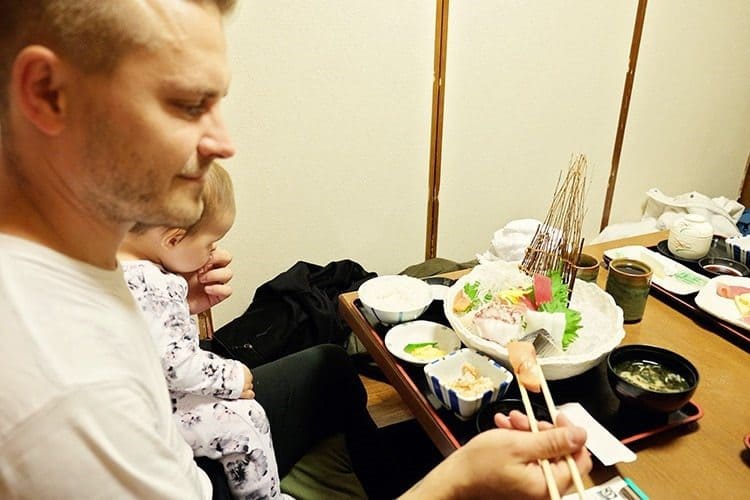
While most restaurants and pubs allow babies, use your common sense when deciding which restaurant is appropriate for him/her.
Many restaurants in Japan are tiny, crowded, and noisy, which is such a great atmosphere for us but can be pretty overwhelming for a baby.
Smoking in restaurants is also allowed, and we often walked into a restaurant only to turn back around when we realized how heavy the cigarette and cigar smoke was.
You also won’t easily find a high chair in these restaurants, so expect to hold your baby on our lap or in your baby carrier.
If your baby is a bit older, you might like to take a lightweight travel high chair with you. Here are our recommendations for portable high chairs .
Dinner time for us typically meant that our baby Avalee was tired, but the restaurants were way too noisy, so we struggled to get her to sleep, and she spent dinner crying. It wasn’t fun.
So my tip here is to remember that they have Domino’s Pizza Delivery.
We ended up ordering delivery for a few nights so that we could eat in our VRBO apartment instead (and that way, Avie could get some sleep in her portable cot) – dinner + peace = heaven!
12. Breastfeeding in Japan
If you are planning on breastfeeding in Japan, I highly suggest you pack in a cover-up.
While breastfeeding in public is fine, I never saw anyone with their boob visibly out; it is all about discretion.
If you prefer to feed in breastfeeding rooms, you will always find them in department stores, museums, and play centers.
13. Book a Machiya (Japanese-Style House) or VRBO Apartment
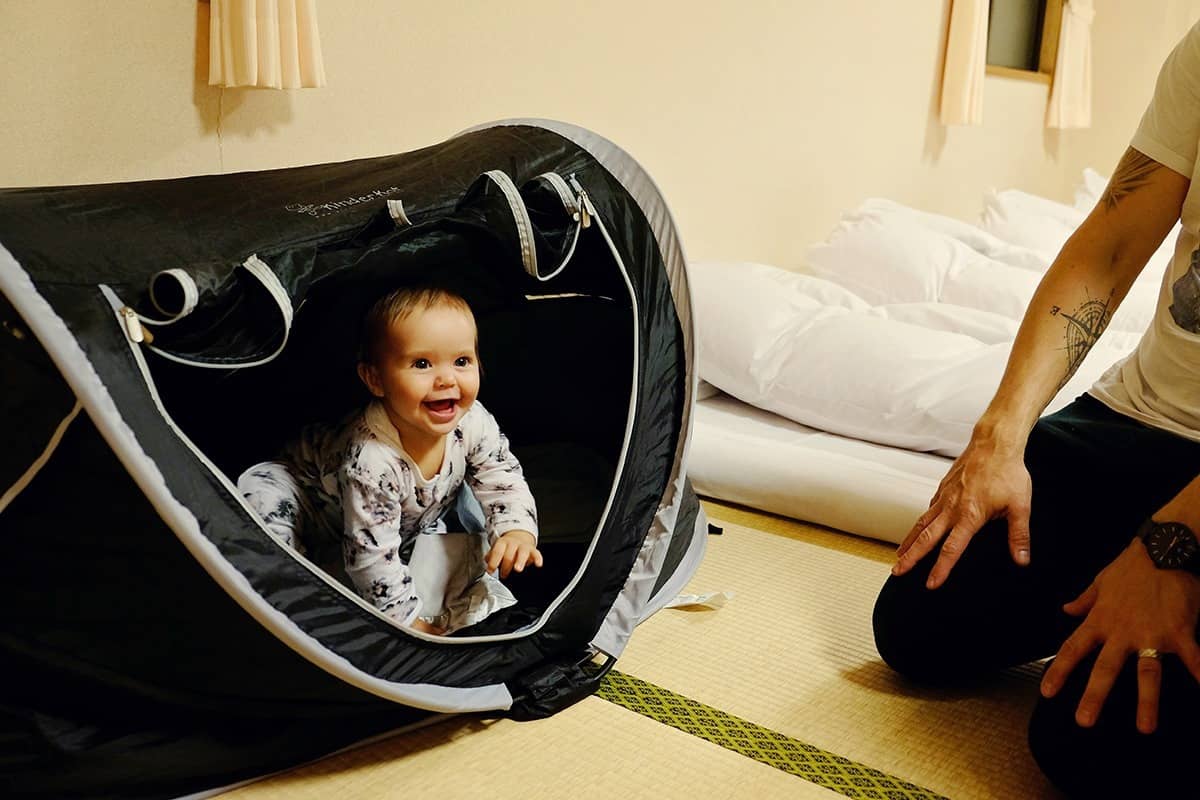
As a pre-warning, hotel rooms in Japan are really tiny and pretty pricey. I also highly recommend asking them if a baby cot will be available.
If your baby is moving, you might prefer a Machiya or an VRBO rather than a hotel so that there is room for your little one to crawl and play.
They are also fabulous choices for those who can’t afford the pricey prices of the hotels.
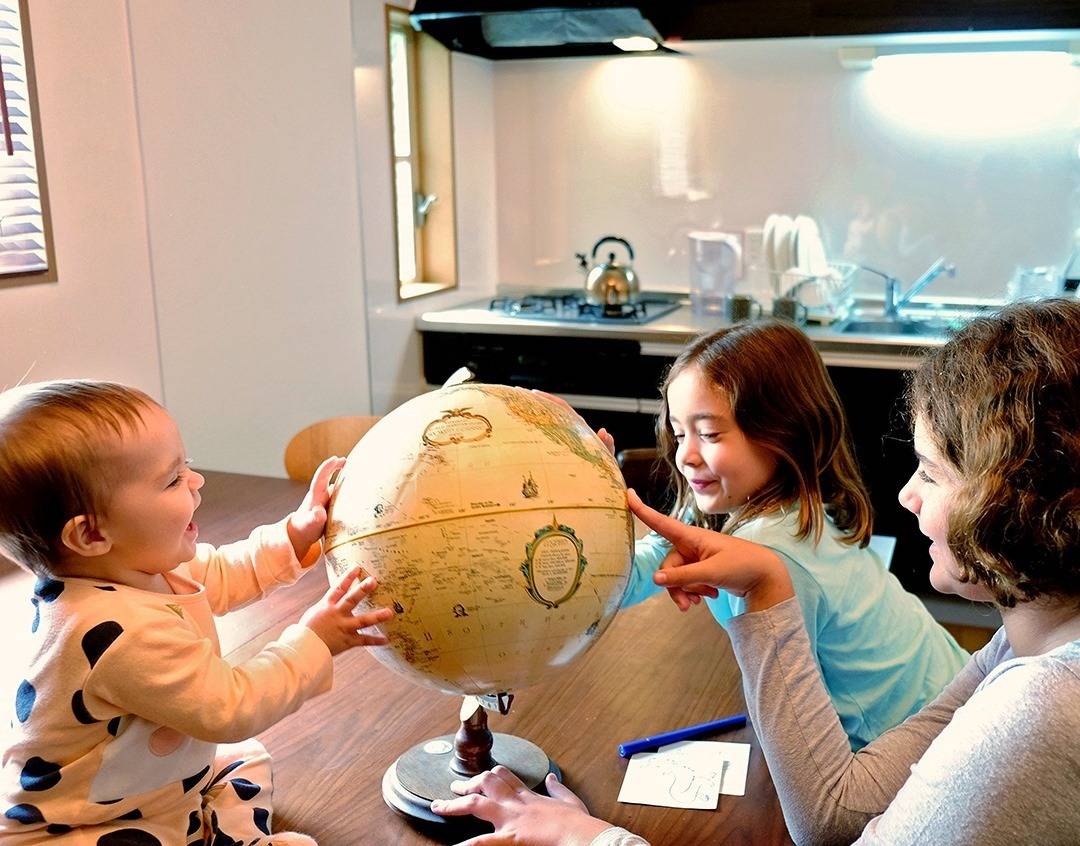
We enjoyed staying in a mix of all three of the above.
We loved our VRBO’s in Japan as they typically come with a fully functional kitchen that certainly allows you to cook your meals, especially for the baby.
Most also have a washing machine that will make the baby’s laundry easier.
I will share some hotel links below for those who wish to stay in a hotel.
You will find that most hotels will have some information on their cots/extra beds that say, “There is no capacity in this room for a cot”, so if you use our links below for hotels that do offer and have space for cots it will save you loads of research time.
Note about cots: We ended up taking a portable baby cot with us to Japan as many of the hotels and VRBO’s did not have a cot available, so it is essential to ask the question before you book to ensure that baby has a safe space to sleep.
>>> Click here to see a list of recommended travel cribs to take along.
Let’s look at our top recommended places to visit with a baby and I will also include our recommendations of which hotels actually provide a baby cot.
Where to go In Japan with a Baby or Toddler
Wondering where to go in Japan with your little one? We share a simplified version of our way-to-busy itinerary.
Find below 3 destinations that I recommend you include in your Japan Itinerary with a baby or toddler.
1. Tokyo with a Baby or Toddler
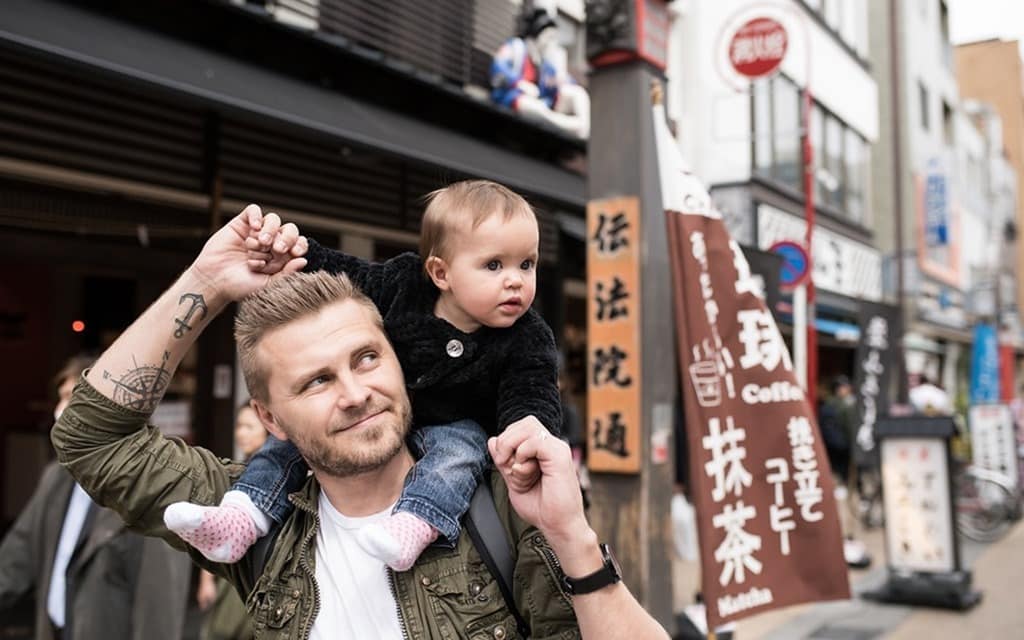
Is Tokyo baby-friendly? Yes – well mostly!
Here are our top tips for traveling to Tokyo with a baby or toddler.
Tokyo’s streets are narrow and popular spots will be packed to the brim with people. Many of Tokyo’s subway stations don’t have elevators or escalators, so keep in mind that you need to be able to carry all your luggage and strollers up and down stairs if you take public transportation.
So a small lightweight stroller will be key. A stroller will be helpful though because you will be walking A LOT.
So even if you have a toddler that loves walking, they will get tired and the stroller will be very helpful to have.
See if you can book a hotel or VRBO that is close to the subway station – honestly, you will be surprised at how many trains you will be catching during your stay.
Things to do in Tokyo with a Baby or Toddler:
- Meiji Shrine & Yoyogi Park
- Senso-ji Temple Tokyo and Ueno Park
- Day Trip to Nikko (lots of stairs so don’t bother taking the stroller – book a tour here )
- Visit the Government Building for views over Tokyo
- Shinjuku Gyoen National Garden
- Imperial Palace
- Tokyo Disney Parks (for older toddlers – buy your 1 day pass online here )
How Many Nights to Stay for:
- I recommend staying for 5-7 nights in Tokyo.
Where to Stay in Tokyo with a Baby:
Find below our three favorite accommodation options for those traveling with a baby.
- Imperial Hotel Tokyo (5-Star): This hotel is perfect if you can reach the price. It is convenient with an airport shuttle drop-off at its front door. It is also in a central location with three stations within a 5-minute walk. They have family rooms available that offer more space. Babysitting is available, as well as cribs. Click here to check availability and prices .
- Four Seasons Hotel Tokyo at Marunouchi (5-Star): Another fabulous option as it is directly accessible from JR Tokyo Station. They also have babysitting services as well as cribs available. Fabulous location; you can’t go wrong. Click here to check availability and prices .
- Nohga Hotel Ueno (4-Star): This hotel is conveniently located 3.3 km from Tokyo Skytree, in the Taito district of Tokyo. No babysitting services here, but you can request a cot for free. Click here to check availability and prices .
After more suggestions of where to stay in Tokyo? You can find our list of the best family hotels in Tokyo here.
2. Osaka with a Baby or Toddler
Osaka is fairly easy to explore with a baby or toddler. Our favorite thing to do in this city was to use it as a base for some stunning day trips.
Things to do in Osaka with a Baby or Toddler:
- Stroll Around Dontonbori (A good place to go for food)
- Osaka Castle Park
- Miyajima Day Trip (You can either DIY or book an organized tour here )
- Kurashiki Day Trip
- Himeji Castle Day Trip
- Universal Studios (for older toddlers – book your transport + entrance ticket online here )
- Nara Day Trip (You can either DIY or book a guided tour here )
- I recommend staying for 3-4 nights in Osaka.
Where to Stay in Osaka with a Baby:
- InterContinental Hotel Osaka (5-Star): In an excellent location and only a 5-minute walk from JR Osaka Train Station. Their rooms are lovely and soundproof. They have babysitters available as well as free cribs. Click here to check availability and prices .
- Art Hotel Osaka Bay Tower (4-Star): This hotel is conveniently located close to the train station. They have larger family rooms available to offer space. The rooms are soundproof, and cribs are available as well. Click here to check availability and prices .
- Hotel Nikko Osaka (4-Star): The Hotel Nikko brand is a popular one for travelers due to their affordable prices. They are also located with direct access from the airport shuttles. It is also directly connected to Shinsaibashi Subway Station. They also have cribs available as well. Click here to check availability and prices .
2. Kyoto with a Baby or Toddler
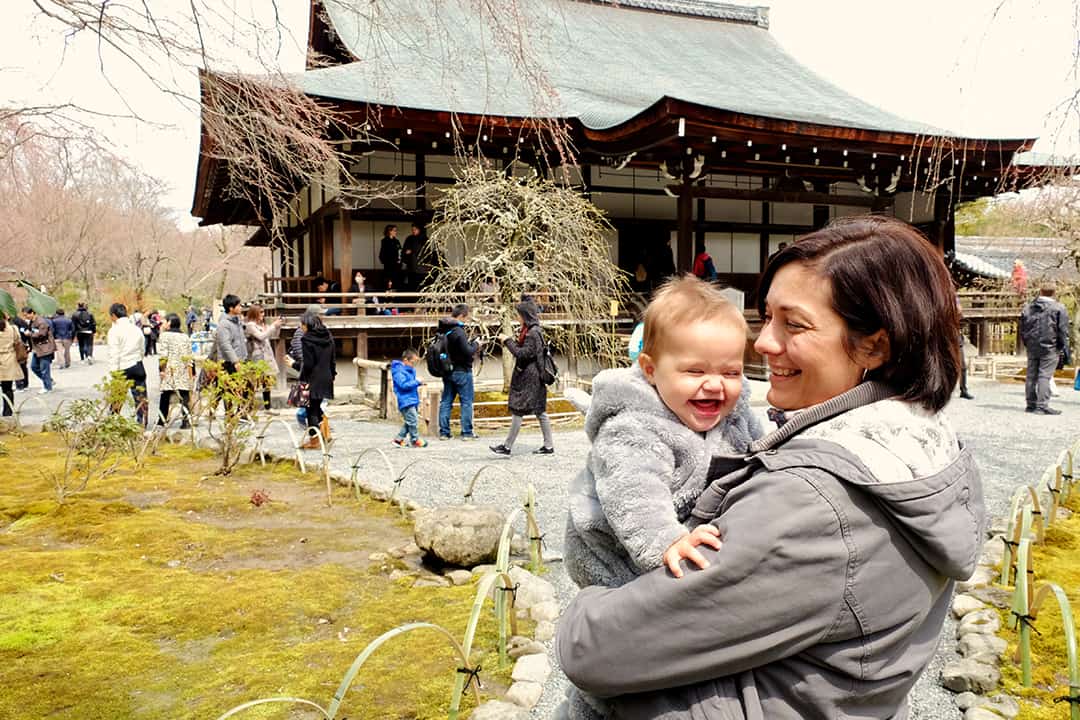
Kyoto is a BIG city. Expect to spend a lot of time on public transport in order to get from one tourist attraction to the next.
Try to stay close to a train or bus station to make life a bit easier.
Streets and many tourist spots are stroller-friendly.
Things to do in Kyoto with a Baby or Toddler:
- Explore Arashiyama and the Fushimi Inari Shrine (Included highlights include The Kimono Forest of Arashiyama, Arashiyama Bamboo Grove, Tenryu-ji Temple, and Fushimi Inari Shrine)
- Ginkaku-ji Temple, Nanzen-ji Temple, Shimbashi Street, and Gion District (A great way to see these sights is on a private walking tour ).
- Southern Higashiyama, Nijo Castle, and the Golden Pavilion
- To make life really easy, you could also see all the Kyoto highlights on a full-day tour. Check prices and availability for the Kyoto highlights tour here .
- I recommend staying for 4-6 nights in Kyoto.
Where to stay in Kyoto with a baby:
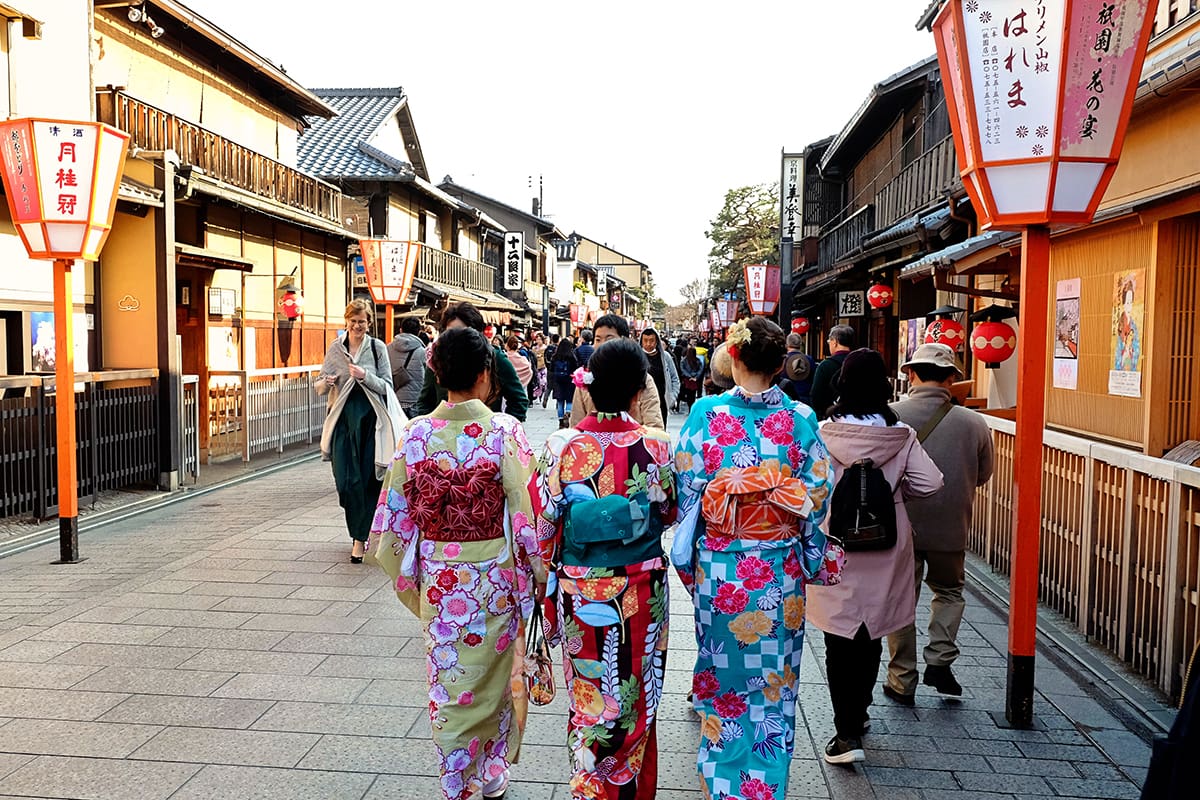
Find below our two favorite accommodation options for those traveling with a baby.
- Hotel Imagine Kyoto (4-Star): What we love about this hotel is that all the units have a seating area (which means more space). The hotel is close to Kyoto station, so exploring other areas of Kyoto is easy. Free cots are available too. Click here to check availability and prices .
- Kyoto Tokyu Hotel (4-Star): This hotel offers a free 5 min shuttle to the Kyoto Station. The World Heritage site Nishi Honganji Temple is just a 5-minute walk away. We love their family-size rooms, and they have cots available as well. Click here to check availability and prices .
Of course, if you want to include a few more destinations, then you can check out our guide on the most beautiful places to visit in Japan for first-timers .
Conclusion To Our Japan with Toddlers or Babies Guide
The idea of traveling to a foreign country is often an intimidating prospect for many.
The idea of making the trip with a baby or toddler in tow is even more worrying to many, but that doesn’t mean parents cannot have an exciting holiday in a foreign land far away from home.
You can travel to Japan with your baby; you must be well-prepared!
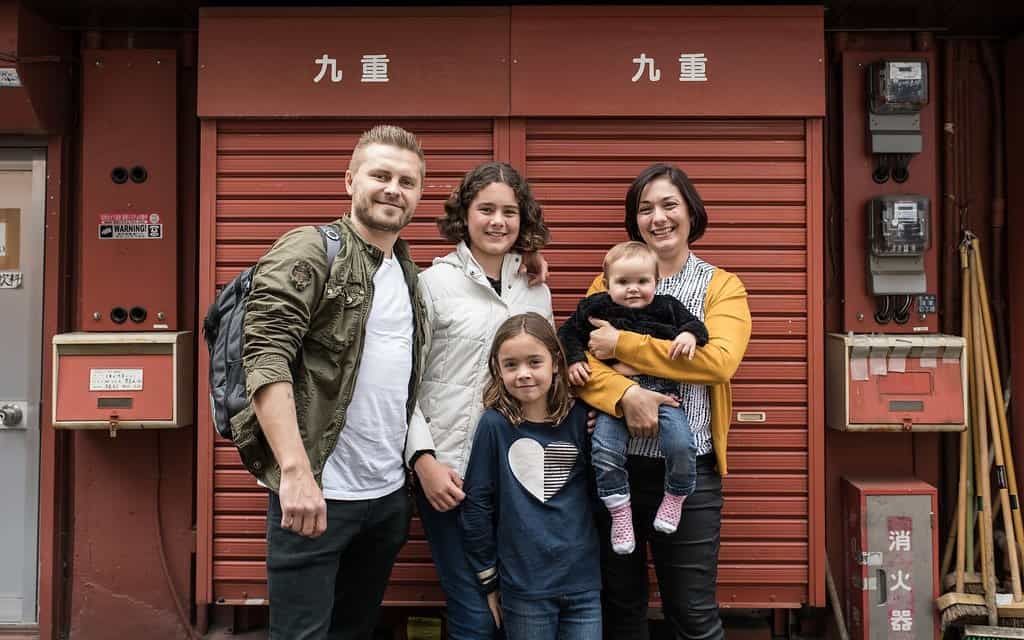
Visiting Japan with a baby is more straightforward than in many other countries.
That’s because Japan is a baby/kid-friendly country, and everybody seems to love babies.
To highlight this, there are seats for babies to sit on in many public places and kid areas for children to let loose, run around and have some fun!
Believe it or not, changing tables are everywhere, including in the men’s bathroom! Some places even offer free diapers and microwaves.
This is a place where you’ll walk in big cities such as Tokyo and Kyoto and see babies everywhere.
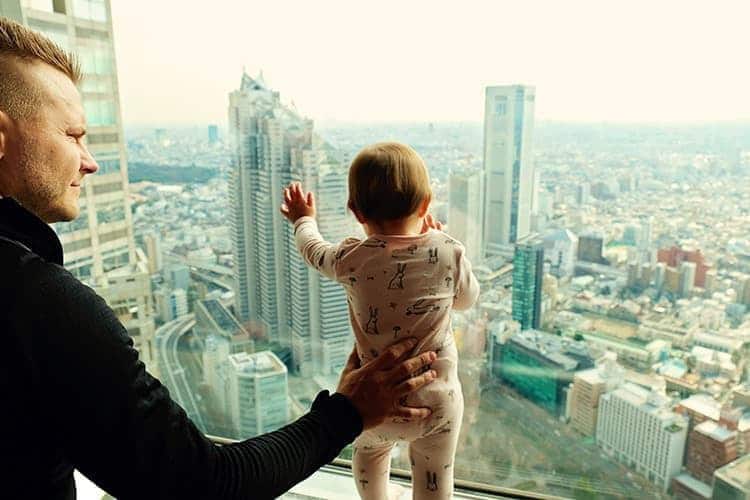
But do learn from our mistakes and travel slowly and lightly for your Japan travels.
So if you’ve been planning to travel to Japan and have some worries about going with your baby, know that it is an excellent destination if you use our tips above (do it better than us!)
Traveling to Japan with a baby or toddler is possible! All you have to do is keep up with the above fantastic tips, and you and your baby will be good to go.
Over to You:
- Do you have any helpful tips to add to our Japan baby travel guide?
- Do you have any other questions that you need answers to?
- Looking for best places to travel with toddlers ? Read our complete guide to worldwide destinations.
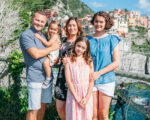
Jolene Ejmont
40 thoughts on “traveling to japan with a baby or toddler: what to know”.
Great article and thank you for the tips – we are travelling in May 2019 with our baby boy who will be 2 years old by then. Would you be able to recommend the AIRBNB places you stayed in, please?
This is amazing! We are planning to travel in December with a 7 month old! Will it be too cold for him? What do you recommend to tackle the cold weather?
Hi, looks like the temperature will be similar to when we went with our little one. Make sure to take layers – we had leggings on the legs with jeans over the top, layer a jumper with warm jacket over the top. Beanie on the head. Many people in Japan used a special warm cocoon on their prams to combat the cold as well. We chose to baby-wear our little one to help with body temp instead as we knew we wouldn’t use the pram cocoon again after the trip, but could be worth looking into as well.
Such a fantastic post – thanks for all the tips! We are going in 2 weeks time and have pretty much sorted itinerary and travel. Only question I have is where would you recommend staying in Tokyo (AirBnB) there are soo many properties!
Hi, we had a super dodgy place in Tokyo that I don’t want to recommend – it didn’t have a mattress on the bed, just the base!! Make sure you pick a property that has lots of reviews on it and that has at least a 4-star rating! We went during Cherry Blossom season and made the mistake of booking to late, so was left with the newly added properties that hadn’t been reviewed yet – big mistake.
Hi Jolene! We are going to Japan in December with our 10 months old baby, just to let you know that your tips are very useful! Thanks a lot 🙂
Hi there, thanks for your article. I will be traveling in Feb -Mar for 2 & a half weeks with my hubby and baby (who will be turning one over there) . Just wondering what you recommend we do with the JR rail pass. I thought I would just get a two week pass instead of three weeks (to save on Money) and activate when we leave Tokyo to our next destination however I wasnt sure if we’d need this pass activated on arrival to Tokyo to get from the airport to the accommodation. What do you think would be the most cost efficient option for us? Get the 3wks JR pass or organise a transfer to the hotel from the airport maybe? Also are there any destinations that are easy with a baby or on the other hand to difficult with a baby and we should avoid? Thanks for your help!!
Hi! Your post is so helpful! We plan to travel on February and witness the snow festivals in Sapporo. My baby will be 1 year old by then 🙂 What winter clothes would you recommend? And is the water in Japan safe for our baby? We are feeding him formula milk so I’m worried if there will be safe water to use.
Hi Jen, water in Japan is safe. Japan is such a modern country you really don’t have to worry. In regards to clothing, I highly recommend you layer her up, you might also like to baby-wear your 1 year old for extra warmth. Take a beanie or warm hat too. we had leggings under jeans for our little one and a vest, long sleeve t-shirt, jumper with a thick jacket over the top. Easier to take off some layers when/if a day warms up. Have a fabulous trip!
We’re leaving in a few weeks to Tokyo to attend the Sapporo Ice Festival as well. We have a doona stroller that converts from a stroller to a car seat. Would you recommend just leaving that behind? Or bringing it with? I ask because we’re not planning on strolling her that much, and she has a carrier, but for the car seat. Did you bring a car seat? And if so was it helpful on the plane to have a place for her to settle in? Or did you do a lap baby ticket?
Hi, we used a lap baby ticket and had her sleeping in the baby carrier on the plane and in the car trips as well. We mostly used the trains and to be honest it is really tricky when you have to much ‘stuff’ and you use the trains as space for luggage, prams etc are so limited. Travel as light as you can if you plan on moving around Japan.
Hi Jolene, your article is great and full of good tips. I am trying to plan a 8 to 10 day trip to Japan in May with my husband and 2 year old son. I cannot decide if we should stay in tokyo for about 6 days and then head out to Fuji 5 lakes area (mainly to check Thomas the tank engine Land) or head south to Kyoto and Osaka. What would you recommend for a first time trip or could we squeeze in both Osaka and Fuji?
Well, I love Kyoto and Osaka much more than Tokyo – but that is probably for personal reasons 🙂 You can also visit Universal Studios Japan if you head that way. You could try to do Osaka and Fuji but the thing with Fuji is that you don’t want to have anything set in stone, because it is actually tricky to get visibility on it – so best to call them in the morning to check if it is worth the trip or not.
This is super helpful! My partner and I are in love with Japan and have been three time so far, but have been feeling a bit nervous about going back with baby, so it’s super reassuring to hear from someone who’s survived! 🙂
Haha, we survived 🙂 Just pack light and make sure to take a baby carrier along with you on the trip. Have a fabulous time!
This is such an inspirational and helpful post! We are hoping to travel to Japan with our then 10 month old during the cherry blossom season this April. Which travel bed is Avie pictured in here? Also, for a trip of about 10 days, would you suggest about 2 days in Tokyo and then having a main base out of Kyoto or Osaka? TIA!
Hi Avi, our little one is in the PeaPod travel bed, which worked nicely. You will probably need more than 2 days in Tokyo (depends on what you want to see though), but the city is MASSIVE and it takes a while to get to interest points. For Cherry Blossom season I would definitely choose Kyoto as a base and just do a day trip to Osaka from there. Be prepared for crowds though – recommend taking a baby carrier as it will be hard to squeeze into the crowds with a stroller.
Do you plan where to break when the baby wanto take a nap?
Where is like a good place to rest while baby sleep
Our baby mostly slept on the go. We used the baby carrier a lot and she just fell asleep in there whilst we kept on exploring.
Your blog is what encouraged us to plan a trip to Japan with our 3 month old baby for end March/beginning April 2019. Considering how young he is he’ll almost always be in the carrier facing inward, so won’t get to see nor interact with much during the trip, especially with the weather being cold, so we are a bit apprehensive of our decision. I guess the main concern is, will it be miserable for the little one since he’s awake most of the day? He barely takes naps during the day. Any words of wisdom would be great!
We went around that time and it sure was chilly, but our little one was cozy in layers of clothes (because it does warm up in the day), a beanie and in the baby carrier close to our warmth. Our little one didn’t sleep easily out of our arms, but she did fall asleep easily in the carrier though. You could keep your outings short if you want and just head out at midday when the day is warmer and keep inside in the morning and late afternoon when it is colder.
Where are you planning on going?
Very very cool blog! I’ve been living in Kyoto for the last 5 years and recently had a little baby girl. Living here obviously makes it completely different, but after travelling quite a bit with her this winter in Europe, here are the things I love about Kyoto; (hopefully you do not mind me sharing this with everyone, I don’t mean to hijack your post!!)
1- Most traditional restaurants here in Kyoto have tatami floor seating; so even without a high chair, you can just lay/sit baby on the floor and actually enjoy a meal!! 2- You’ll find a nursing room in almost ANY department store. 3- Hotels (or air bnb rentals) again are great; no need for a baby cot because you can just sleep on futons! Most of them have a rental one if you ask them though.
I hope that all the families planning a trip here will have an amazing time. I look forward to reading more of your articles!
Hi there, thanks for your thoughts 🙂 Our baby was moving around a lot, so the tatami floors didn’t always suit, sometimes we needed her strapped in to stop her from getting up to nonsense – but a helpful suggestion for those with little babies. Also, the boutique hotels we stayed in didn’t have cots, only the larger chain hotels did, so I would ask before I book, not after 🙂 I love Kyoto, I think it might be my favorite city 🙂 Thanks for sharing some tips – always helpful for our next readers to have choices so they can pick what suits them 🙂
Thanks Jolene for amazing article, it is full of great information. I’m planning to travel to Japan from the UK with my husband and our 4 months old baby this year. Do you think 4m baby is too little to travel so far? Also, please can you recommend a travel cot? Best, Monika
Hi, thanks – so glad you enjoyed the article. I don’t think travelling a long distance to Japan with a 4m baby is too far. Try and do overnight flights where possible. We have a link on the article that will take you to travel cots – there are some great ones on there. I would suggest seeing which one you prefer based on size, weight etc. When you have booked your accommodation, I would suggest reaching out to them to see if they can provide one before purchasing one to travel with. Thanks and have a great time!
Thanks for the information. We’ve been once before and now going back with a 1.5 year old in summer. It will be hot in a carrier, but we’ll use it sometimes and take a stroller too.
I’m looking for information about the laws of crossing the boarder into Japan with a car seat made for Canada. I think the car seats here are better regulated and maybe even cheaper. Do you know where I cam find information about this? I’d hate to get to customs and have to leave it behind.
Hi Sandra, no idea on the laws for that sorry. My main concern would be whether you would be able to strap the car seat into a car. Every country has a different adjustment for seats, in Australia we use an anchor strap, here in Italy, they have clips to clip the seat into and other countries often just use the seat belt. If it is for a rental car, I would suggest maybe just hiring a car seat with the car so that you know it will fit.
How old was your baby when you travelled to Japan? We were thinking of travelling with our baby end of May and he will only be 3 months old, do you think that is too young to be travelling to japan from vancouver, canada? He will have his first sets of shots by then but he is too young to get any extra vaccinations as per the travel clinics here in vancouver. Please let me know your thoughts, thank you so much!
Avie was around 6 months I think, but I would have zero hesitation in taking a 3-month-old to Japan. To me, Japan is on the same level as countries such as USA, Australia and European countries. I don’t even think we needed any vaccines for Japan as adults 🙂 Enjoy your trip and don’t stress about it 😉
Can you use your own car seat in Japan?
You would need to research how your car seat connects to a car and what type of connection they use in Japan. For example we are in Italy atm and they have both an anchor point in the back as well as two clips that the car seat connects to in the car seat, so our seats from Australia won’t work well here. Where are you from?
What a great way to live your life with passion. I have been to japan before and loved your post. This time I am traveling with a 1 year old and I just have one concern. Can I travel thru japan without a car seat? I will be taking both trains and cabs. Kindly advise.
Hi, yes you don’t need a car seat for taxi or for trains 🙂 Would, of course, be a good idea to have something to secure bubs to keep your little one safe. So consider an option, even having them constrained in a baby carrier and the seat belt inbetween you and your the baby carrier is safer than nothing at all.
Hi Jolene, such great post tons a great tips!! We are planning a one month travel with our 6 months old this November and we are hesitating between Australia/New Zealand or to go back to Japan. What would you recommend, since you lived in Australia?
Oh gosh, that is a tough question if I don’t know what you love doing and what your personalities are like. Australia and New Zealand are easy countries to visit and perfect for those who love nature. Japan obviously is a fabulous destination if you prefer a good dose of culture on your trips instead. What do you usually love doing on holidays?
Hi! This is such a great post. Can you recommend which AirBNBs you stayed at ?
Hi! Is it possible if we book 1 week in osaka and travel within those days to kyoto, tokyo and nara? thanks Hope to receive any recommendations. thank you in advance.
Hiya Irene, I really wouldn’t do that with only 1 week – you could easily fill up 1 week in Tokyo alone. You could, however, base yourself in Osaka and do a day trip to Nara and a day trip to Kyoto (although I LOVE Kyoto and would rather recommend you stay there for at least 2-3 nights). More info on day trips from Osaka here: https://www.wanderluststorytellers.com/absolute-best-day-trips-from-osaka/
Hi! When you were in the train (not the shinkansen one) for such a long trip (let say 1 hr) can baby eat snacks on the train?
Hi, we avoided it. You can though on regional long-distance trains – you will know as they will have a tray and cup holder. I think we did give her a milk bottle on some trains though and nobody complained about that.
Comments are closed.
2024 - Wanderlust Storytellers. All Rights Reserved.
About Us | Contact Us | Work with Us | Privacy Policy | Disclaimer
* Disclaimer: Wanderluststorytellers.com is a participant in the Amazon Services LLC Associates Program, an affiliate advertising program designed to provide a means for sites to earn advertising fees by advertising and linking to amazon.com and other Amazon sites.
Nomadic Matt's Travel Site
Travel Better, Cheaper, Longer
How to Travel Japan with a Baby
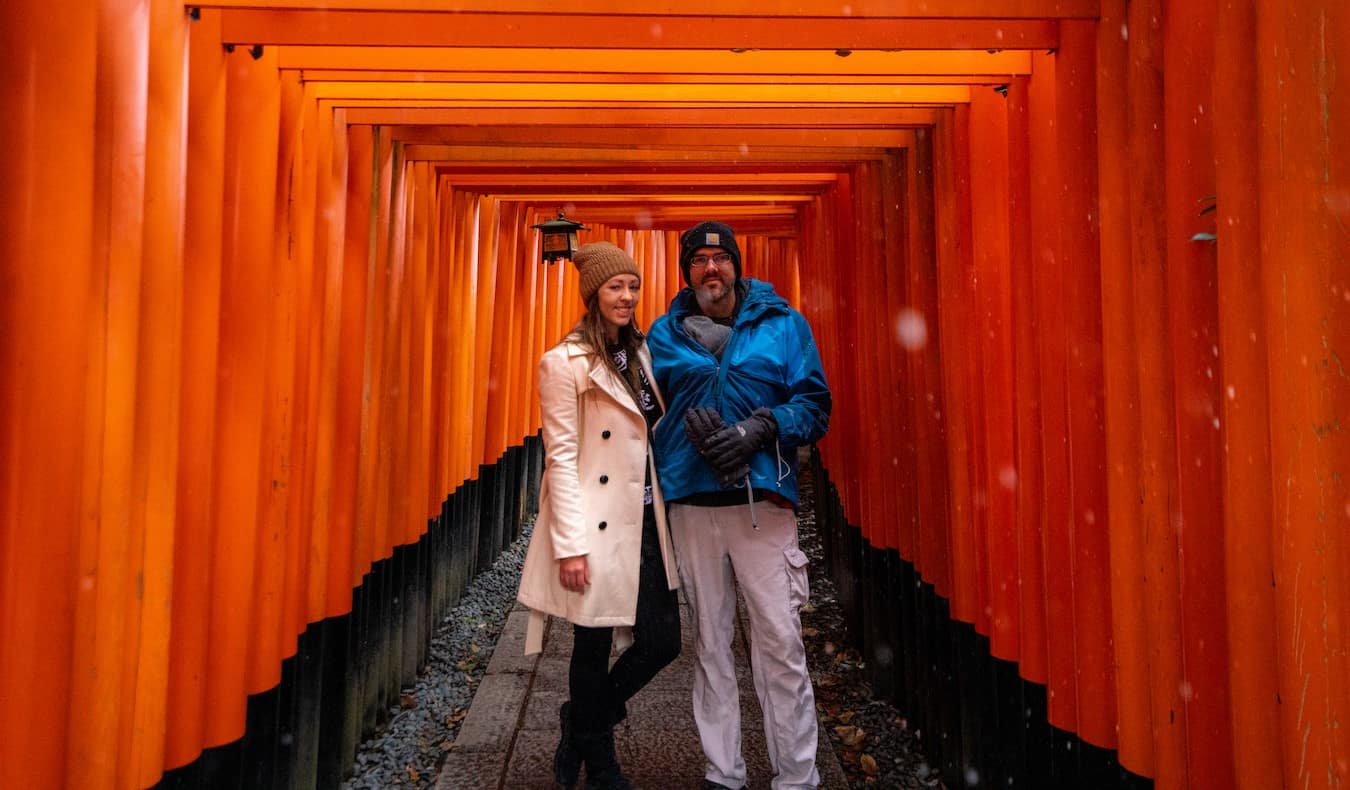
I love Japan. It’s one of my favorite countries in the world. But is it a suitable destination to visit with a baby? Solo female travel expert Kristin Addis from Be My Travel Muse was recently there with her baby and has tons of tips and advice for travelers thinking of taking a baby with them to Japan.
Japan was our first major international trip with our then six-month-old. I’d heard mixed things about how baby friendly Japan would be, from DMs telling me it wouldn’t be a great trip to the total opposite with people gushing about how baby friendly it was.
We decided to go for it, hitting four spots in two weeks, taking public transportation and staying in a mix of apartments and hotels. Traveling with a baby in Japan comes with some special considerations, but overall, it can be a great trip IF you plan it right. Here’s everything to know:
Table of Contents
Japan Baby and Toddler Friendliness
Getting around japan with a baby, packing light is wise for japan, renting baby gear in japan, buying baby essentials in japan, choosing where to stay in japan with a baby, baby sleep in japan, feeding and meals in japan, medical services in japan.
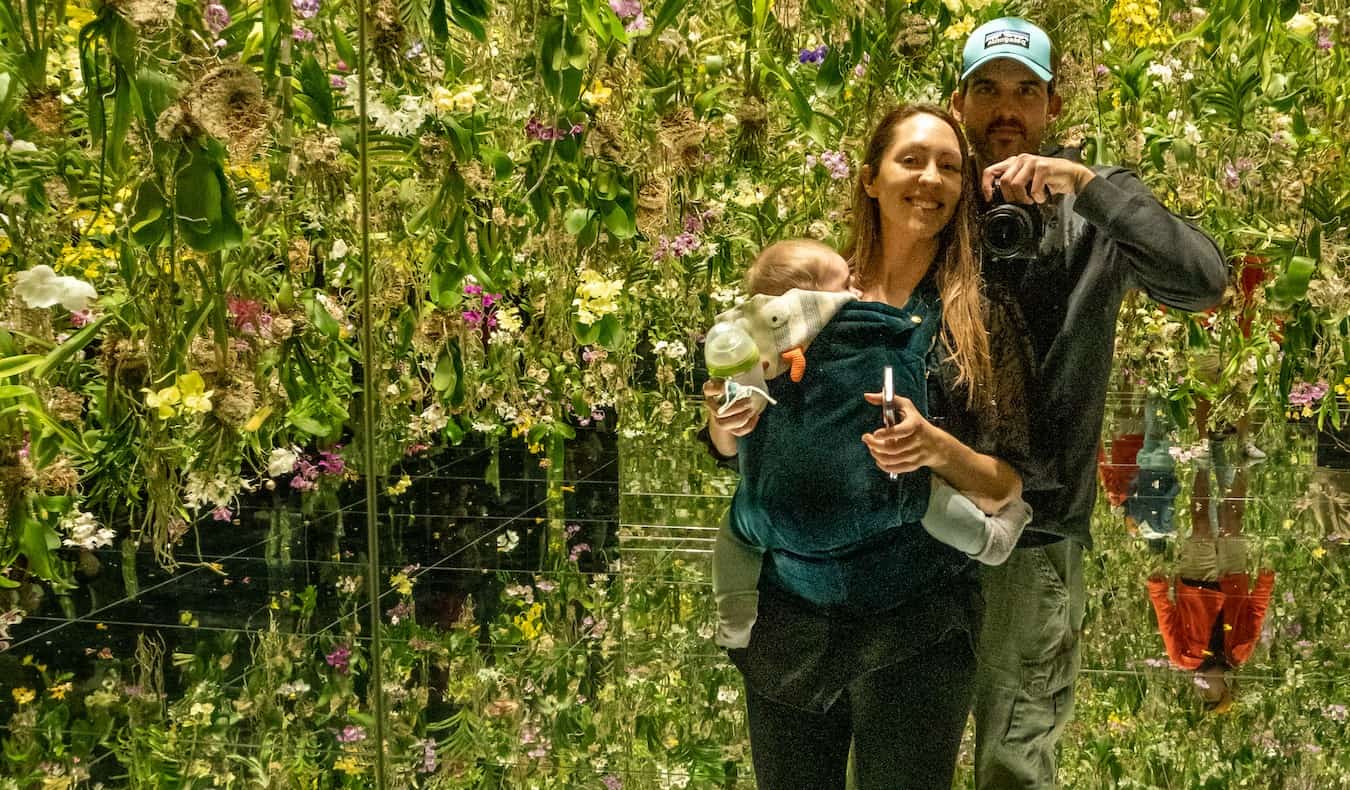
With a few strange exceptions, like the lack of cribs, Japan is one of the most baby and family-friendly places I have been. It all started when we were personally escorted to the aircraft by a Japan Airlines gate agent when boarding our flight to Osaka. They even offered me a place to sit with the baby while I waited. It felt like first class treatment.
Each time we encountered an airport queue in Japan, whether it was for security or boarding, they always had a family line, which is sadly missing from every US airport I’ve encountered.
There are family restrooms everywhere as well, and I really mean everywhere. Even the smallest metro and train stations had them, and I never encountered one that wasn’t sparkling clean. People respected that they were only meant for those with disabilities and young children, as well. I never had to wait to use one and never saw an able-bodied single person walk out of them, which I see all the time in the US.
The bathrooms are also full of useful items like a baby holder, which I’ve only otherwise seen in Singapore, changing tables, and padded benches for nursing. I’ve truly never seen a family bathroom as equipped as the ones in Japan.
The locals also LOVED our baby. Everywhere we went, people would play peek a boo with him, smile at him, and light up when they saw him. We felt very welcome everywhere we went with him.

Although they’re more expensive, we tended to prefer train travel to bus travel in Japan so that we could make use of the changing tables on the trains. They were more spacious, and the buses rarely had a place to change diapers.
If you’re traveling during high season, be sure to book train tickets ahead of time and reserve seats to avoid having to stand with your baby.
Alternatively, consider renting a car to get around. They can be pricey, and if you’re North American you’ll be driving on the opposite side of the road, but it also gives you ultimate flexibility.
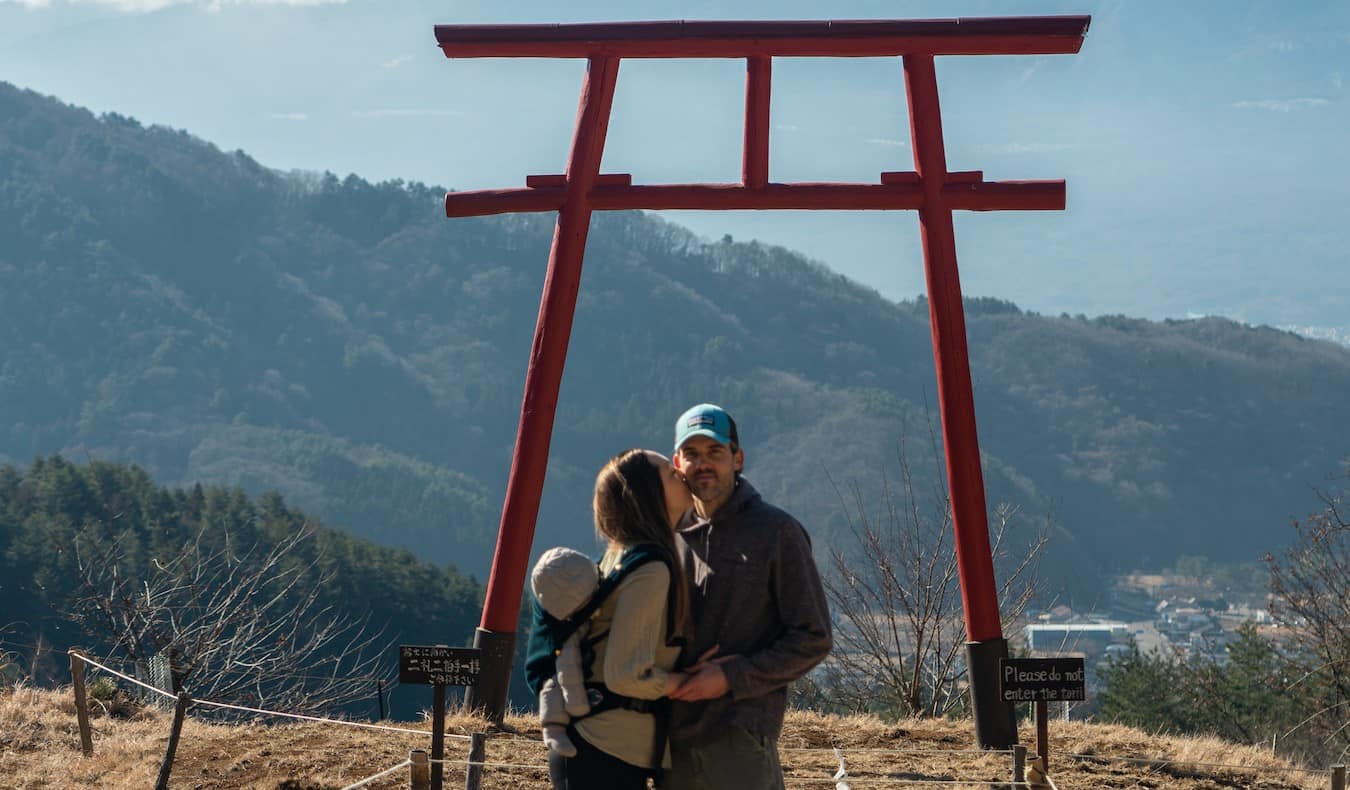
We opted to leave the stroller at home and just travel with a soft baby carrier . While a stroller can be helpful at times, Japan has a lot of stairs and some metro stations, even in Tokyo, don’t have elevators. We always found them at JR stations, though.
I have mixed feelings about this decision as we were aching by the end of the trip. If I were to do it with a toddler or older baby I’d probably opt for a hiking baby carrier instead. It distributes weight better and is a more comfortable experience, plus they have storage space. Just keep in mind that they’re bulky and you’ll most likely need to remove it when using public transport.
If you absolutely have to bring more than you can physically carry, there are luggage forwarding services in Japan that can help transport your luggage from hotel to hotel for you.
Since our baby was a bit younger and not yet mobile when we visited Japan, we felt OK with not having a dedicated sleeping space and utilizing the floor beds instead. However now that he’s older, he needs a dedicated sleeping space and ideally a stroller. If we were to visit now, I’d utilize rental services to keep our suitcases light and still have access to the items we need for safety and comfort.
It’s possible to rent strollers in various cities in Japan , depending on how remote you’re going. You can also rent other baby gear in some parts of Japan, particularly in the more major cities.
One way to pack lighter is to plan to buy baby essentials in Japan. It’s easy to find diapers, formula, and baby food if you know where to look.
If you’re doing baby-led weaning, which we were at the time, you can shop at any Japanese supermarket for fruit and veggies.
It was actually a treat to visit the grocery stores there since they had almost entirely different snacks and brands than I’ve seen elsewhere. The produce was also way better, as it was mostly locally grown. Even in the winter, we were eating perfectly ripe, locally-grown strawberries.
If you need diapers, baby food, or formula, you won’t find them at a grocery store. These items are for sale in drug stores only. Matsumoto Kiyoshi (with brown lettering) is the one we came across the most often.
Diapers were easy to buy. They will have the weight clearly displayed in kilograms. Jarred baby food and formula were in the same section of the store. If you need a specialized (non-cow) formula, that may be harder to find. Since we did for my baby, we brought enough with us from home for the whole trip.
Download the Google translate app so that you can hold your phone camera up to the Japanese Kanji and read what the ingredients and baby food flavors are. Don’t expect to see English translations in stores.
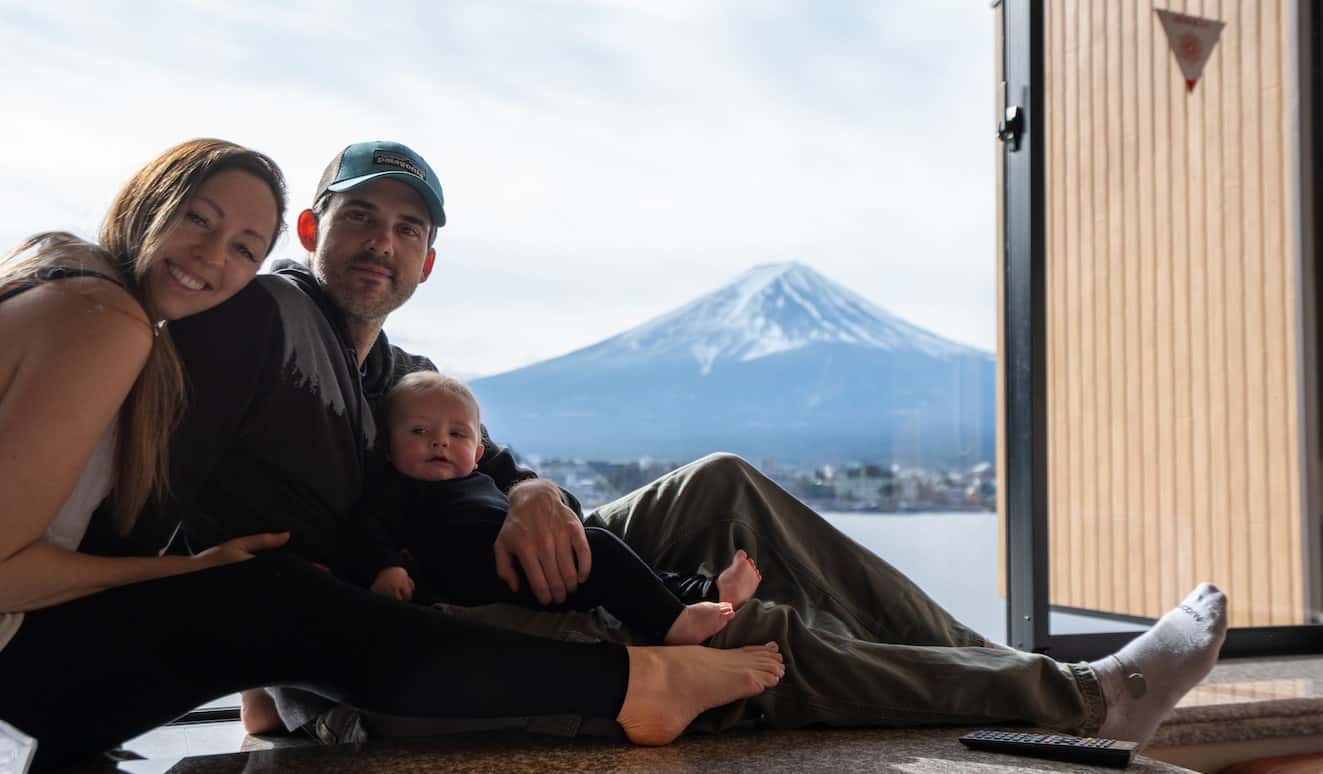
Unless you’re willing to pay up a bit more, especially in Tokyo, you can expect hotel rooms to be on the smaller side. However they tend to include breakfast, which makes life easier for parents with young children.
Apartments, which you can book on Airbnb, usually have two floors and a kitchen. The kitchen was helpful for food prepping for the baby, and the two we stayed in had microwaves. I travel with microwave steam bags to sanitize our bottles, so this was a nice surprise.
The two floors also gave us a place to hang out while he took his naps. Apartment rentals are almost always larger, and in my experience, more affordable than hotel rooms can be. Sometimes they have washers and dryers as well.
Hot water kettles are a nice feature whether you’re in an apartment or hotel room. They seem to be the standard in Japan, which makes sanitizing, washing, and heating water for formula easier. Tap water in Japan is generally safe to drink and wash with.
The most bewildering and disappointing thing about traveling in Japan with our baby was the lack of cribs. Even in the 5-star ryokan we stayed at in Kawaguchiko , there was no baby crib on offer. It made me wonder what locals do. Do they bring their own? Do they co-sleep?
In half of the places we stayed, the beds were traditional-style mattresses on the floor, so it was fine for our baby to sleep on the floor mattresses, however now that he’s more mobile, I’d want to bring along our travel bed.
One of the negative things I heard was that we’d be turned away from restaurants in Japan with our baby. While I’m sure it happens, I didn’t encounter this, even at kaiseki (which is the highest level of dining in Japan) restaurants. Sometimes they even had toys they’d bring out for our son.
We were told that the lounge in the hotel we stayed at in Tokyo wouldn’t be available to the baby in the evenings when alcohol was served, however. Some restaurants, including the Michelin star ones you might be hoping to eat at, could hold the same policy. There are some restaurants in Japan that are specifically geared towards families. The most common you’ll find are Bikkuri Donkey, Joyfull, and Gusto.
Most restaurants in Japan will have high chairs, but when at more casual ramen or yakitori restaurants, you’re less likely to come across them.
If you’re nursing, my sense in Japan was that it’s best done in private. I never saw anyone openly nursing in Japan, though I saw plenty of bottle feeding. The family restrooms are probably your best bet for a comfortable and private experience. I saw a nursing pod (a little room that offers nursing privacy, similar to the Mamava pods at US airports) at a few major train stations in Japan as well.
As a parent, I’m more concerned with the availability of healthcare services than I ever was before traveling with a baby. Thankfully Japan has a wonderful medical system with perfectly capable doctors.
I know this firsthand as I needed to visit a doctor in Kyoto when my asthma flared up. I was able to visit an international doctor at a clinic that services foreigners the same day. All of the medication the doctor prescribed was available there as well. In most cases they’ll want a cash payment which you can then submit to your travel insurance for reimbursement.
In non-emergency situations, look for a doctor that specializes in international patients as there can be language barriers. I was able to find mine easily on Google Maps. Otherwise, hospitals are widely available, even in smaller towns.
Overall, I loved traveling in Japan with our baby. The clean family bathrooms provided an easy place to change him, feeding and buying supplies were easy, and getting around was simple with such a well-connected rail system .
I was worried with so many stops and logistics that it might be a nightmare, but everything is so well-organized in Japan, it all worked out. Plus, the adorable interactions between our son and the locals made it a heartwarming experience.
Kristin Addis is a solo female travel expert who inspires women to travel the world in an authentic and adventurous way. A former investment banker who sold all of her belongings in 2012, Kristin has been traveling the world ever since. You can find more of her musings at Be My Travel Muse or on Instagram and Facebook .
Book Your Trip to Japan: Logistical Tips and Tricks
Book Your Flight Find a cheap flight by using Skyscanner . They are my favorite search engine because they search websites and airlines around the globe, so you always know no stone is left unturned!
Book Your Accommodation You can book your hostel with Hostelworld as they have the most comprehensive inventory so they are best for booking a hostel. If you want to stay in a hotel or guesthouse in Japan, use Booking.com as it consistently returns the cheapest rates for guesthouses and hotels.
Don’t Forget Travel Insurance Travel insurance will protect you against illness, injury, theft, and cancelations. It’s comprehensive protection in case anything goes wrong. I never go on a trip without it, as I’ve had to use it many times in the past. My favorite companies that offer the best service and value are:
- Safety Wing (best for everyone)
- Insure My Trip (for those 70 and over)
Looking for the Best Companies to Save Money With? Check out my resource page for the best companies to use when you travel! I list all the ones I use to save money when I travel — and I think they will help you too!
Be sure to check out the Japan Rail Pass if you’ll be traveling around the country. It comes in 7-, 14-, and 21-day passes and can save you a ton of money!
Looking for More Travel Tips for Japan? Check out my in-depth Japan travel guide for more ways to save money; information on costs; tips on what to see and do; suggested itineraries, reading, and packing lists; and much, much more!
Got a comment on this article? Join the conversation on Facebook , Instagram , or Twitter and share your thoughts!
Disclosure: Please note that some of the links above may be affiliate links, and at no additional cost to you, I earn a commission if you make a purchase. I recommend only products and companies I use and the income goes to keeping the site community supported and ad free.
Related Posts
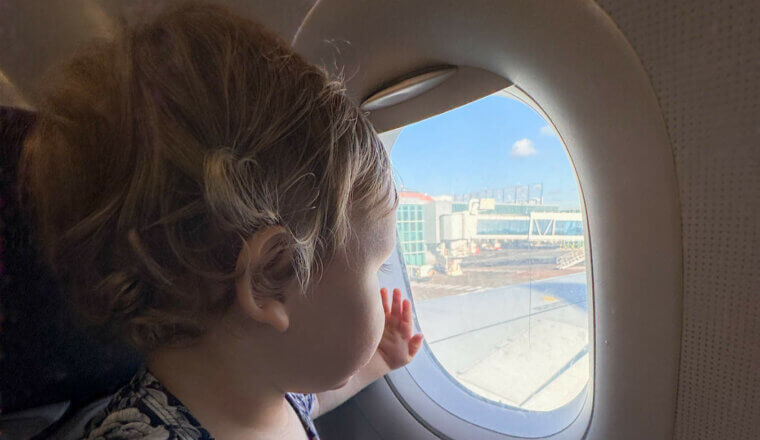
Get my best stuff sent straight to you!
Pin it on pinterest.
- Skip to main content
- Keyboard shortcuts for audio player

- LISTEN & FOLLOW
- Apple Podcasts
- Google Podcasts
- Amazon Music
Your support helps make our show possible and unlocks access to our sponsor-free feed.
I flew to Japan with my baby. Here's the travel advice that helped me survive the trip
Emily Siner

Journalist Emily Siner went on a trip to Japan with her 8-month-old son and knew it would be daunting. What should she pack? What should she expect? Photo Illustration by Becky Harlan/NPR hide caption
Journalist Emily Siner went on a trip to Japan with her 8-month-old son and knew it would be daunting. What should she pack? What should she expect?
Last winter, my husband and I made the ambitious decision to fly 13 hours with our 8 month old for a two-week vacation around Japan.
We knew flying with a baby would be daunting. What if he has a meltdown on the airplane? What gear do we bring? How will he adjust to the 15-hour time change? And ... will we actually get to enjoy ourselves?

Siner's husband and their 8-month-old son on the 13-hour flight to Tokyo. Siner says their baby loved watching other passengers on the plane. Emily Siner hide caption
Siner's husband and their 8-month-old son on the 13-hour flight to Tokyo. Siner says their baby loved watching other passengers on the plane.
Preethi Harbuck, author of the travel blog Local Passport Family and a mom of six agrees that taking a big trip with young children — that is, babies and toddlers under age 2 — isn't easy. But with the right preparation and mindset, it can also be fun for everyone. You may even be able to "connect with people and places in a new way that [you] wouldn't have been able to experience without kids," she says.
To help set parents up for success, Harbuck and Christine Sarkis, editor-in-chief of the travel website Family Vacationist , share tips on what to pack, how to overcome travel challenges and set realistic expectations.
Take a practice trip

Before you pack your passports for a big international trip, try a shorter trip that's closer to home so you can work out the kinks of traveling with a young child. Photo Illustration by Becky Harlan/NPR hide caption
Before you pack your passports for a big international trip, try a shorter trip that's closer to home so you can work out the kinks of traveling with a young child.
The first step to preparing for a big trip is to take a smaller one, like an overnight trip somewhere close by. It can give you a sense of what it's like to travel with your little one and grow your confidence, says Harbuck. "Find what feels comfortable and keep practicing. It will become easier."
Luckily, my husband and I had a chance to take some shorter trips with our baby before going to Japan. When our baby was three months old, we stayed overnight at a cabin about a half hour away by car. A month later, we took an 8-hour road trip to Chicago to see family.

How to take better (and more distinctive) photos on vacation
From these outings. I learned how important it was to pack a sound machine, which helps my baby fall asleep, and a portable diaper changing pad. I also learned that I didn't need to bring too many toys. My kid loved watching other people talk, walk and interact with each other.
So when we went to Japan, I put those lessons to use. I packed the essentials, left half the toys behind and made sure to sit in an aisle seat on the plane so that my baby, who sat on my lap, could get a good view of the passengers and stay entertained.
Make plans your future self will thank you for
When traveling with a baby or a toddler, everything becomes a little more complicated. There's a lot more to pack (more on that later) and a lot more considerations to make (like naps and kid-friendly meals, perhaps). So the key is to prioritize decisions that will simplify travel, says Sarkis. "Anything you can do to smooth your way [will make you] so happy with yourself."
Here are some planning decisions that our experts recommend.
Put your kid in their own plane seat. Many airlines allow kids under 2 to fly in your lap for a very low rate, sometimes even for free. While that can make travel more budget friendly, Harbuck says it's worth buying your child their own seat. Placing them in a car seat is the safest place for them to sit on an airplane, according to the Federal Aviation Administration. Plus, having your own seats can make long flights more comfortable for the both of you.
Consider their developmental stage. Keep in mind that your child's needs will change as they age. For example, if your kid is walking, it may be harder to "keep them busy and happy" on the airplane, says Sarkis. So you might enjoy your trip more if you choose a destination that's closer to home. Anticipate what stage they'll be in at the time of travel and plan accordingly.
Add more adults to the trip. My husband and I traveled with friends for part of our trip around Japan. They helped us carry luggage and held our baby while we ate. "If you have someone to trade off with, that's really helpful," says Sarkis.

7 tips to help you keep the peace when traveling with a group
Book a vacation rental. If you are traveling with a little one who still naps in the middle of the day or has an early bedtime, you may not want to book a single hotel room. Sarkis says she made that mistake on a trip once and had to bring pillows into the bathtub just to have a place to read after her kids went to bed. "Whereas in a vacation rental I could have sat on a couch."
Plan solo time. Carve out time for you and your travel partners to do things without the baby. On our trip to Japan, my husband and I decided we'd give each other as much time as we wanted in the guesthouse onsen , the heated communal bath, while the other watched our sleeping baby. Another night, we hired a babysitter so we could go out together and sing karaoke.
Pack well ... and lightly
It’s hard to travel light with a baby. So opt for the travel versions of strollers, cribs and car seats — they are often smaller and weigh less than the usual gear.
Credit: Becky Harlan/NPR
Portable cribs, high chairs, playpens and sleep canopies? There's no shortage of recommendations when it comes to choosing travel gear for your little one. But the No. 1 takeaway is to make sure "everything you're carrying is worth the stress of carrying it," says Sarkis.

Planning a trip? Here's how to pack like a pro
Focus on the basic gear. At the minimum, your child will likely need a stroller or baby carrier to get around, a car seat for car trips and a safe place to sleep, like a portable crib. See if you can get travel versions of that gear, which are often lighter, smaller and easier to carry. Many airlines will let you check a stroller and a car seat for free, either before you go through security or at the gate. (If you do this, get some sort of carrying case to protect them.)
Cut down the big stuff ... There may be opportunities to leave some of that gear behind, says Sarkis. Check whether you can rent a stroller at your destination. Your accommodation may offer baby cribs. And some ridesharing apps may have vehicles outfitted with infant car seats.
... and the little stuff. "Kids live all around the world so you can access most of what you really, truly need" at your destination, says Harbuck. If your luggage is getting too full, consider buying diapers, wipes, formula or baby food when you land. In Japan, we did laundry halfway through our trip to minimize the clothing we had to pack.
Set your expectations

Traveling with young children alters the nature of the experience. It's important to set realistic expectations for your trip. Photo Illustration by Becky Harlan/NPR hide caption
Traveling with young children alters the nature of the experience. It's important to set realistic expectations for your trip.
I'll be honest: There were a lot of moments on our trip when I felt overwhelmed and a bit disappointed. Like when my jet-lagged baby woke up crying at 1 a.m., 3 a.m. and somehow again at 3:30 a.m. — for two nights in a row.
Both Harbuck and Sarkis acknowledge that post-kid travel is harder in many ways. But there are a few things you can do to set yourself up for success.
Redirect your attention to the positive aspects of your journey. "If you're focused only on the challenges, you're going to miss the joys," says Sarkis. For me, it was delightful to witness my baby do new things in Japan. He ate new foods like udon, miso soup and smoked fish. He was mesmerized by the Ryoanji Temple's rock garden in Kyoto and even more mesmerized by the steady stream of tourists' faces to observe.

A flight expert's hot take on holiday travel: 'Don't do it'
See drawbacks as opportunities. If you have to go back to your hotel twice a day to let your child nap, see it as a moment to read, journal or "recharge for the next thing you do," says Sarkis.
Look out for special ways your child is helping you connect with the world. On flights, our neighbors told us about their own children or nieces and nephews. In restaurants, servers would come over to coo at him and make conversation with us in the process, despite the language barrier.
And finally, give yourself some kudos. For us parents, traveling was a big priority for us before he was born, and the experience made us proud to realize that yes — even with a small child, we can still see the world.
The audio portion of this episode was produced by Andee Tagle. The digital story was edited by Malaka Gharib. The visual editor is Beck Harlan. We'd love to hear from you. Leave us a voicemail at 202-216-9823, or email us at [email protected].
Listen to Life Kit on Apple Podcasts and Spotify , and sign up for our newsletter .
- Life Kit: Parenting
Want to visit Japan with an infant? Here's how to make your trip a success
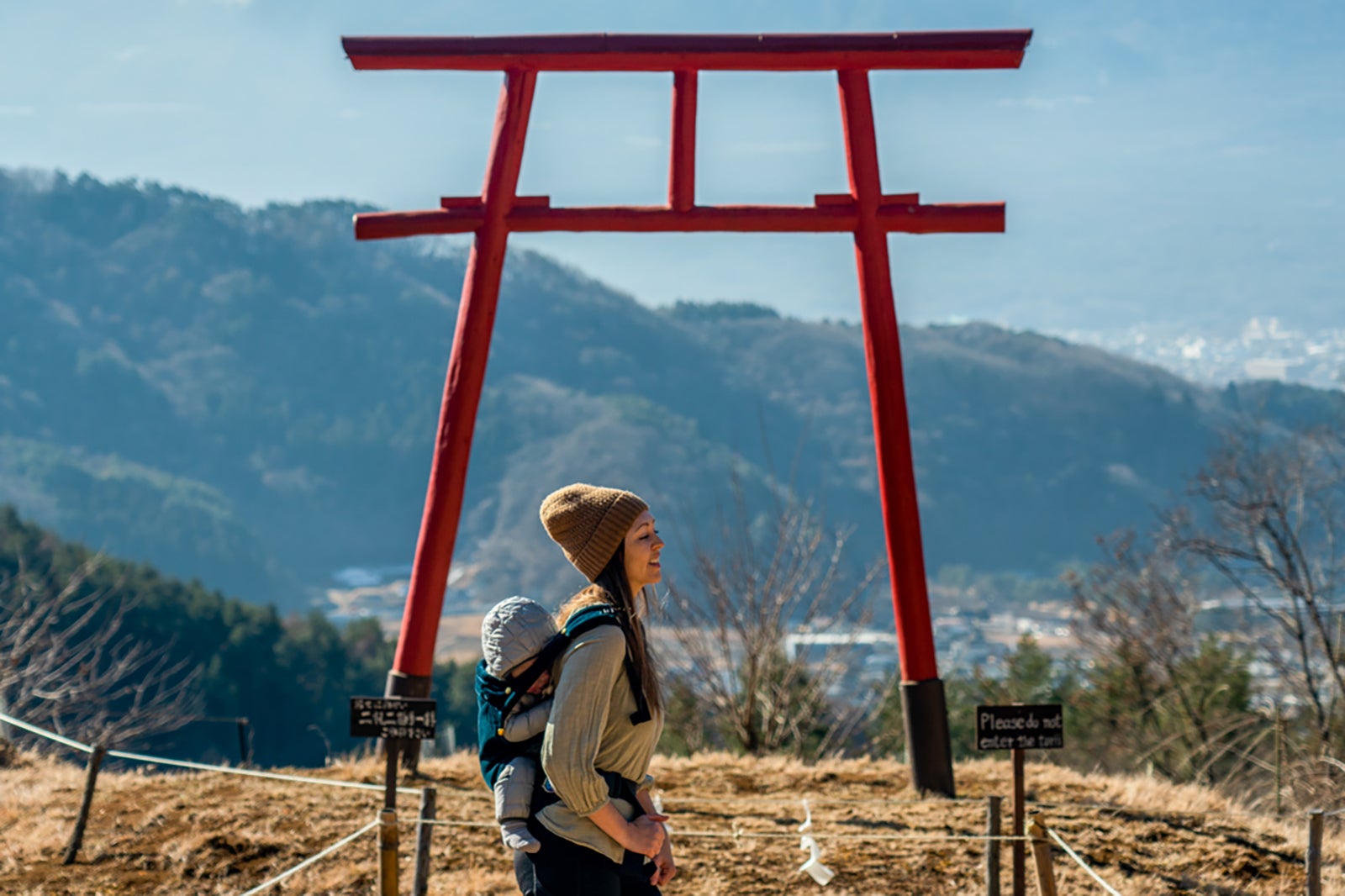
When I first started traveling solo and blogging 10 years ago, one of the most persistent things I got asked was, "When are you going to settle down?"
The question irked me. It suggested that there were only two paths in life. But it didn't seem to me that traveling and having a family had to be mutually exclusive.
Years later, having returned from my 20th flight with my now 7-month-old (which was our second international trip together), I know firsthand that adventures don't have to end just because you have a baby. That said, traveling does look different with a little one.
When I decided to visit Japan with a young child, for example, I asked my community on Instagram for suggestions and received a direct message saying that Japan was "not really baby friendly."
The more research I did, however, the more conflicting information I found.
People complained that the hotel rooms were too small, that some restaurants did not allow babies or children, and that transit could be difficult with all the extra baggage that children often require.
I'd been to Japan twice already, and I remembered it being one of the friendliest, most accommodating places I'd ever visited. So, I trusted my initial impression and decided to give it a shot for our first international family vacation. Fortunately, the country turned out to be just as welcoming to babies as I'd hoped.
Right away, Japan impressed me with its family-friendly amenities. There were impeccably clean family bathrooms almost everywhere, as well as ample changing tables. Several airports even have free strollers , should you decide to leave yours at home.
Restaurants were also quite accommodating, often offering an extra bowl of rice, a toy, a high chair and other amenities without us needing to ask. Plus, our baby got attention everywhere we went in the form of smiles and peek-a-boo interactions. I'm sure he'd happily move there full time.
That said, there were some key things I did to make our trip successful.
Related: 12 tips on how to travel internationally with a baby
Book business-class flights
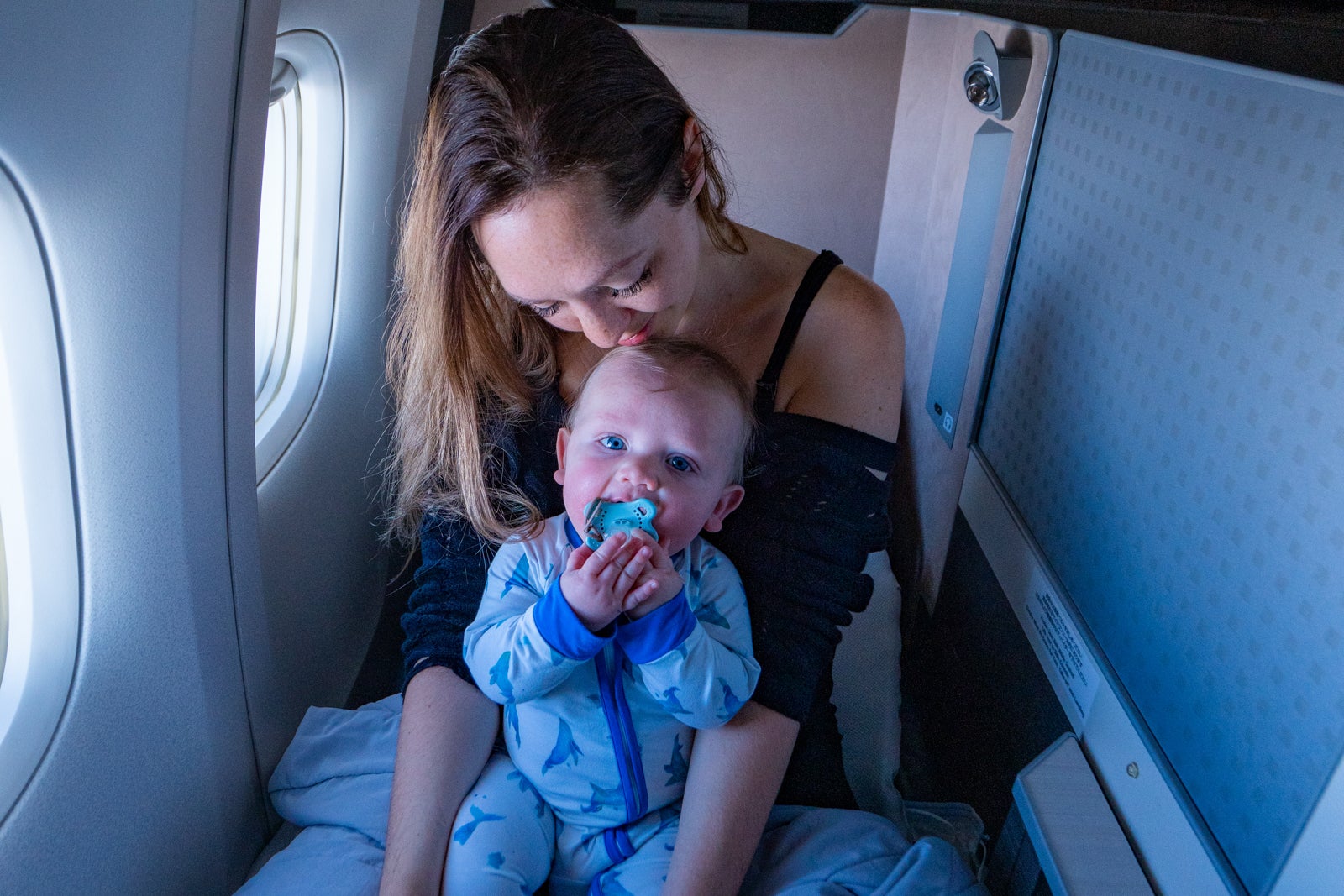
This was our first trip crossing the international date line and several time zones. My biggest worry was how we were going to get over the jet lag . I knew if we could have a comfortable experience flying to Japan and back, our chances of preserving nap time and having our baby sleep on the flight were much greater.
It just so happened that we flew both of Japan's major airlines during this trip. For our flight out, we struggled to find a mileage option that matched what I had banked, so I used American Express Travel's International Airline Program to find a 25% discount for our business-class flights with Japan Airlines and used my The Platinum Card® from American Express to book. The tickets were fairly reasonable at $2,000 each, plus $250 for having a lap infant .
I was so glad we opted for business class on this part of the trip. Not only was the service top-notch, but Japan Airlines' Sky Suite meant we had almost complete privacy, with plenty of room for naps and tummy time.
During the trip, I scanned for deals and found flights home on ANA via United for 90,000 miles each.
Like our experience with Japan Airlines, we thoroughly enjoyed our time in the air with ANA. Our little guy slept almost the entire overnight flight home, as did his parents.
If you're like me, you may worry about getting dirty looks for bringing a baby into business class. Don't stress about it, though, as we had no issues during our trip.
Odds are your child will not be the only baby (as was the case for us). People frequently remarked about how our son handles flights like a champ, even though we weren't doing anything special to keep him calm. Lie-flat seats and the white noise of an airplane can do wonders for sleep!
Related: The best ways to travel to Japan with points and miles
One of the toughest things to do with a baby is pack light. However, given the number of stairs in places like metro stations, I knew we'd thank ourselves later if we only took what we could carry. So, we left the stroller and car seat at home, opting to baby-wear and rely on public transportation.
Ultimately, it was the right way to go. Japan's public transit system is efficient and reliable, so you can easily get to all the places you'll want to visit without renting a car or using a ride-hailing service.
To make our journey to and from Japan that much easier, we also rolled the dice and opted not to bring his travel Pack 'n Play. As light as it is, it still requires its own bag and was too much to carry on this trip.
Instead of bringing a portable crib, focus on accommodations with floor beds so your child can easily have their own mattress. I did this and also took advantage of my American Express Fine Hotels + Resorts credit so we could stay at The Prince Gallery Tokyo Kioicho, a Marriott -affiliated property that offered a surprisingly rare family amenity: a crib.
Related: How to pack — and prepare — for travel with a baby
Feast on convenience store cuisine
It was a running joke during our trip that we were either eating like royalty or dining on convenience store cuisine. We enjoyed both ends of the culinary spectrum, sitting for traditional multicourse kaiseki dinners and taking multibowl ramen tours. We even brought 7-Eleven's finest back to our hotel so our baby could have his normal early bedtime routine. It saved us on long travel days, too.
I can't imagine any other country where I would be as pleased with eating so many meals from convenience stores, but as anyone who has been to Japan knows, the country has some incredible food. You can get everything from hot meals to dried fruit in addition to inventive chip flavors, boiled eggs, mochi and Belgian waffles, among other items.
An added bonus is that convenience stores are everywhere, from train stations to just about every major city block, so you won't have to venture far to grab a bite to eat. This proximity to affordable dining makes it extremely easy for anyone, especially a young family, to find sustenance.
Related: A beginners guide to visiting Tokyo: Everything you need to eat, see and do
Keep the itinerary loose
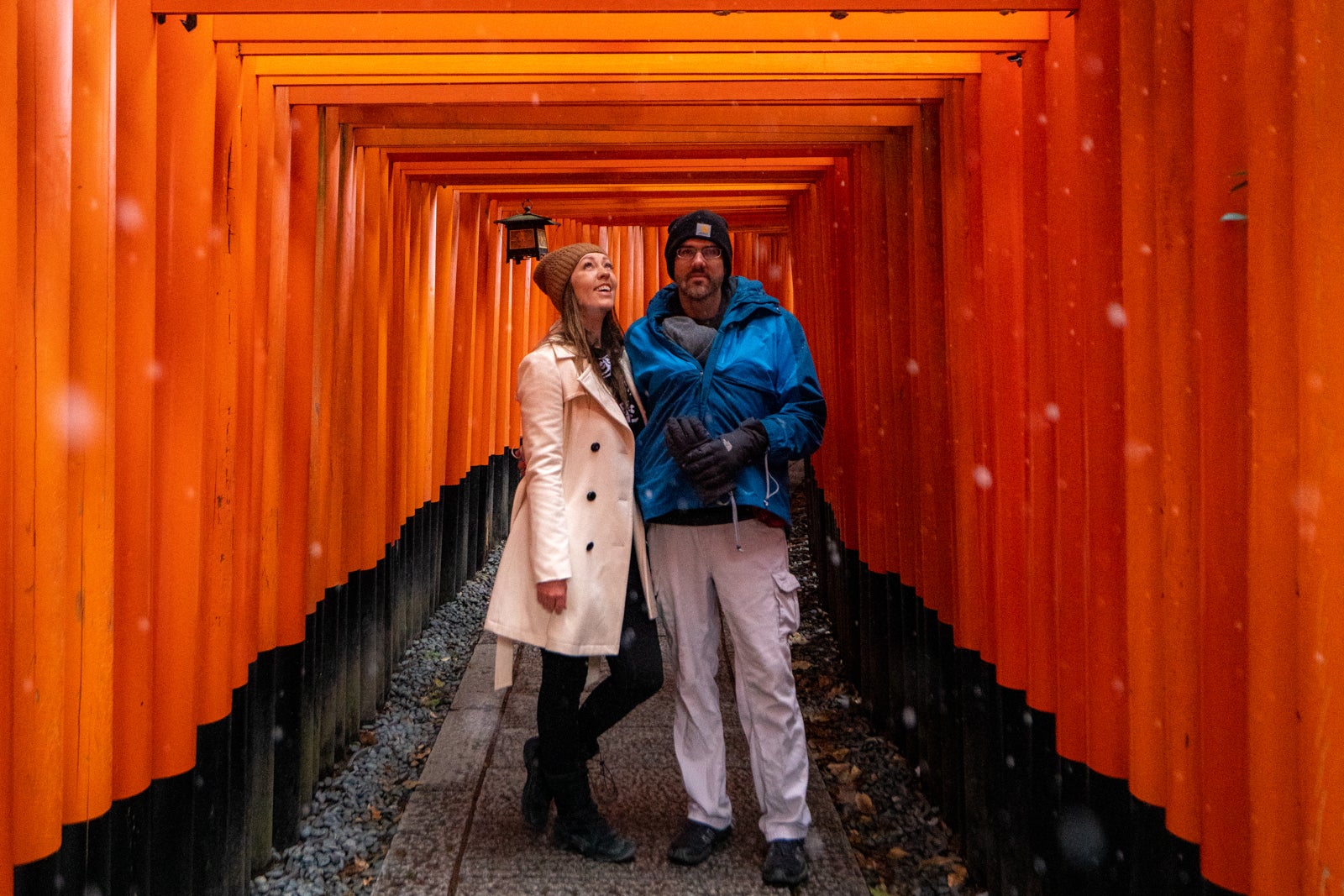
When traveling with a baby, flexibility is key. My biggest regret about the trip is that we did not have enough days for our first stop, Kyoto. Since we were still adjusting to the new time zone, we mostly stayed in our apartment rental until midday.
It was a good thing I hadn't planned or booked too many activities, as things always come up when traveling with a baby. Sure, that means you can't check as many things off a bucket list as you'd like, but the trade-off of watching your baby experience a world where everything is new to them is more than worth it. They may not remember the trip when they're older, but it still means a lot to them in the moment.
It means the world to me, too. Instead of squeezing in more sightseeing, I'm glad we decided to prioritize one or two things per stop so we could save time for precious spontaneous moments with our son. Anytime we were able to achieve more was a bonus, and we never regretted keeping our day-to-day activities limited.
Related: The best types of vacations to take with a baby
Bottom line
Though what your trips look like will ultimately change after expanding your family, it doesn't mean you have to limit your time away from home. There's a big world to see, and we all deserve to keep adventuring, regardless of our age.

Traveling in Japan with a baby
Whether by half-Japanese families or young parents in love with Japan, travel to Japan is totally feasible with a small kid. Yet, whether you want it or not, it will create some disruption to the kid’s habits. We can (hope to) minimize just about everything else but only flight duration and jet lag 🕓 remain unavoidable. Some babies easily deal with these disruptions, while the vast majority of the other kids do not. And it is hard to plan based on empirical evidence.
Let’s not be too optimistic or deeply anxious: accept the fact that those supporting your travel are mainly experienced travelers with kids and eventually supplemented by those who getting benefits from your departure. And in this context, there are obviously worse destinations than Japan!
The essential condition remains to plan your stay in advance in order to better approach it and therefore minimize unexpected events and worries once there.

Before leaving
Administration and security.
All Canadian, English or American children, from newborns to age 16, need their own passport to travel. Your child’s passport will be valid for a maximum of 5 years. A child’s passport is valid until it reaches its expiry date, even after the child turns 16.
You can apply for a passport online or print out the form online from the governmental websites to start the application process. Do not forget that it might take 4 to 6 weeks to obtain the final document.
It is also wise to check you insurance contract and especially the repatriation conditions, in case something happens.
Choosing the season
Regarding the period of the year for traveling, let’s review the highlights already given in the article here...

...which are:
- The hanami period will already be very crowded—too crowded to add another difficulty with an infant.
- Summer is much too humid and hot for young children.
Two excellent seasons to go to Japan, according to our experiences, are:
- During May , as soon as the Golden Week finishes: The temperatures are nicer without being stifling, the tsuyu is not here yet, and the greenness is beautiful (especially azaleas). It is also a break from tourists!
- From mid- September to the beginning of October : After the typhoon period, one can enjoy an Indian summer and its pleasant temperatures, just before the third touristy outburst of fall for the maple trees.
Duration of the stay
There are two quite opposite opinions about the duration of the stay.
Those thinking travel is already hard to swallow for a young kid may choose to stay a maximum of one to two weeks in Japan. Others may argue that, as they are going to handle all of these inconveniences, why not stay for a longer duration? They may decide to travel for three weeks or more.
Each family will make their own choices based on their knowledge and experience.
Choosing the flight
With the goal of minimizing the duration of the flight as much as possible, a direct flight should logically be the first and wisest choice. Only a few companies fly directly:
- From New York: All Nippon Airways (ANA) and Japan Airlines (JAL)
- From San Francisco: ANA and JAL
- From London: ANA, JAL, and British Airways
If you choose to land in Tokyo , favor flights arriving in Haneda and not Narita, as this will halve the transportation time to your accommodations.
Of course, the higher the class of seat, the larger the space that will be allocated, for your and your baby’s comfort. Therefore, a business class seat will allow everyone to lay down on the seat/bed, which will favor better sleep. For babies up to 9 kg, companies will provide a "bassinet" (a small cradle) and reserved seats: usually the first row of each class.
An infant’s fare depends on his or her age:
- Under 2 years old, we pay, at most, the airport taxes (about 10% of an adult’s fare)
- Above 2 years old, the fare usually varies from 25% to 50% of an adult ticket, but the kid will have his/her own seat.
A baby is also allowed several suitcases in the cabin and in the hold.
The stroller is usually considered a supplementary piece of luggage that can, in international airports, can be used up to the airplane’s doors. It is useless to invest in a costly model specific for cabins: a classic stroller will be enough. It is totally possible to bring water in a baby bottle or bottle (note how hypocritical it is for the rest of the population).
When going through customs 🛂 , a control may happen by testing the liquid or asking you to drink a little of it.
In the plane
If your baby has frequent otitis media or other ear infections, be very careful! It is not feasible to consider traveling with a baby who has otitis media, as his or her ears might not resist the takeoff and landing: the suffering is real, and aftermaths are possible. A health check-up is essential before planning any travel with a baby. To avoid discomfort during pressure changes, having a baby bottle ready will allow your baby to calm down during these moments of the flights.
Once at cruise, most companies’ staff will be caring. Patience and courage will be necessary during times when the baby is not sleeping. Get ready to walk the corridors. Depending on the baby’s age, an anime or cartoon on your smartphone 📱 (or on the plane ✈️ ’s screen) will help to make the baby quieter (although it might condense the excitement for later on…).
The ideal remains to test several of these conditions before locking up your family for 12 hours!
Maybe even more than for adults, the goal is to synchronize children as early as possible in the country to the rhythm for the same school hours. It is sometimes easier to cope with jet lag when arriving in Japan rather than when coming back from there, yet there is no true evidence—it depends on each person.
In Japan, the sun rises and sets very early, whatever the season is. This would not be an issue if Japanese homes had normal curtains or sun blinds… but they tend not to. It is not easy to have a baby wear a sleeping mask 😷 .
This could be a great opportunity to visit temples and shrines, which are empty of tourists at these early hours!
Health/hygiene
Naturally, prepare a health and medicine case with the essentials: anti-diarrhea/constipation medicine, anti-fever medicine and pain killers, anti-allergy medication and arnica balm, if your baby walks.
If your baby has fragile bottom, then plan to bring its daily diapers, although there are many sorts of Japanese supermarkets and pharmacies. One can easily find places to change your baby’s diaper in malls and train 🚅 stations.
Traveling in Japan does not require any vaccines, but the one against Japanese encephalitis is advised if you plan to go to rural areas or if you are planning to hike. Bring your health documents and health insurance with you.
Prepare a list of medical health centers: international and famous hospitals will allow you to easily find an English-speaking doctor.
Finally, avoid onsen ♨️ and sento, where temperatures are not adapted to babies’ bodies.
- Accommodation
Let’s be honest here: there is nothing more comfortable than a house or an apartment, and Airbnb happens to be the most resourceful website to find a good place. Some homes even have services and materials, such as baby beds or playpens. Also, the Japanese bathroom 🛁 , which is very watertight, makes it practical to clean yourself with your baby.
When everybody is tired, you might end up spending a lot of time inside, more than if you had traveled without your baby, so the choice of accommodation is critical and justifies a larger budget. If possible, avoid staying at multiple homes during your travel, or avoid constantly changing it.
Whatever the selected type of home, it is essential to find one with excellent insulation for heating during the harsh winters and cooling during the stifling summers. We will insist on this aspect, as it should be almost the first criterion, knowing the climate of Japan and the bad insulation quality of homes.
Attention: Baby-sitting services are not a cultural habit, so do not rely on them.
- Transportation
Commuting may be a problem when traveling with kids in Japan.
We more or less cannot find taxis with baby seats. Only one company, tokyo-taxi.jp , can have these childcare accessories and can easily be booked online in English; moreover, they only have services in Tokyo region. Yet, classic taxis will never refuse to have a baby come aboard. It will rely on you to determine if this sounds secure enough for you.
In public transportation (free for children under 6 years old), space reserved for strollers does not exist:
- Reserved seats in Tokyo trains and metros are still not respected;
- Buses happen to be a baffling problem (let’s not even talk about Kyoto ’s buses)
- The shinkansen remains the most comfortable, if you book seats in first class or in the last row to enjoy more space.
However, most train stations have lifts, which are very useful as strollers are forbidden in escalators. Expect to spend more time when transferring in a station, as numerous travelers with big suitcases, seniors and lazy people use them.
If baby is comfortable with it, do not hesitate to rent a car 🚙 and / or a bike 🚲 properly equipped to reduce commuting times and schedules by public transportation.
Depending on your baby’s feeding phase, you will need to plan to have a certain stock of baby formula or other favorite foods. Applesauce and prepared mashed potatoes are also very useful.
On site, the choice of baby food remains quite small. If you doubt whether to introduce raw fish sushi 🍣 to your kid, do not worry too much— Japanese cuisine offers a wide variety of food. Even while enjoying your sushi, your kid can have vegetarian or cooked sushi and maki.

For the rest, the huge amount of food choices in Japan will offer some interesting and funny tasting experiences, based on your ability to read the ingredients in Japanese.
Japan happens to be an easy country to enjoy with a baby, at least in the cities. Numerous visits are possible with a young child, and some are even created for them (including numerous gardens and squares in Japan). Also, we easily find bathrooms for babies with changing tables in malls.
In the countryside, it is a little more complicated, and it is wise to correctly inform yourself before climbing a mountain to reach a temple, for example.
The essential accessory for travel with a baby is a stroller and/or a baby carrier, which will allow you:
- to comfortably access numerous places;
- to start nap time while still visiting, which is more convenient: no need to go back to the hotel/apartment in the middle of the day; and
- to tidy up the space around you, if needed, in public transportation, for example.
A stroller is easier to use, and you can still enjoy access numerous attractions.
With one objective being to minimize transportation time, it is important to plan ahead district by district.
Avoid planning very busy days, as they will be tiring both for you and your child.
Feelings and benefits for baby
Your child’s consideration and enjoyment of the travel will vary depending on the age and developmental phase of your child. Most babies are emotional sponges (even perhaps with delayed effects). Travel can be tiring and stressful, even more so when having to take care of a baby. The main goal for parents is to remain as serene as possible.
It is important to take the baby’s favorite games and toys, with which he or she spends most of his or her time playing, without forgetting the doudou—your baby’s comforting toy or blanket. Keep a secure and reassuring cocoon around your kid to prevent anxiety. As a rule, Japanese people tend to accept babies’ anger crises (from their own babies and those of others!).
When everything is going well, interacting with locals becomes so interesting. Japanese people of all ages will remove their serious faces, even the strictest salarymen. Therefore, we will ask the mother the age of the child. And if your baby is blonde, get ready to hear massive amounts of " kawaii "!
A little vocabulary
- baby: 赤ちゃん aka- chan
- stroller: ベビーカー baby-car
- diaper: おむつ omutsu
- Flights and Airports
- Internet & Phones
- Budget and money
- Japanese Food
- Visit with Kids
- Seasons: spring / summer / autumn / winter
- Weather forecast
- Time in Japan
- Holidays & Festivals
- Natural Disasters
- Customs and Duties
- Works and Closures
- From April 14 to 15 -- Sanno Matsuri (the Spring Takayama Festival)
- From April 29 to 5 May -- Japanese Golden Week
- May 12 -- Mother's Day in Japan
- June 6 -- Beginning of the rainy season (Tsuyu) in Japan
- June 21 -- Summer starts in Japan
- From July 1 to 31 -- Gion Matsuri Festival in Kyoto with float processions on July 17 and 24
- Tokyo : Shinjuku , Shibuya , Harajuku , Asakusa , Akihabara , Odaiba , Ikebukuro , Ueno , Roppongi , Chiyoda , Ryogoku ...
- Around Tokyo: Kamakura , Nikko , Hakone , Mount Fuji , Mount Takao , Yokohama ...
- Kansai: Kyoto , Nara , Osaka , Mount Koya , Himeji , Kobe , Kinosaki , Kumano Kodo , Ise ...
- Japanese Alps: Kanazawa , Matsumoto , Takayama , Shirakawa-go , Nakasendo ...
- West: Hiroshima , Miyajima , Shikoku , Onomichi , Naoshima , Izumo , Kurashiki , Matsue ...
- South: Kyushu , Okinawa , Yakushima ...
- North: Hokkaido , Tohoku ...

- Temples and Shrines
- Gardens and Parks
- Hiking and Trekking
- Observation Decks
- Public Baths (Onsen and Sento)
- Festivals (Matsuri)
- Amusement Parks
- Visit on a Budget / Luxury

Keikaku is a travel agency specialist of Japan and providing different kind of services:
- Japan Rail Pass
- English speaking Guides
- Pocket Wi-fi
- Japan Nightlife
- Working in Japan
- Religion and Spirituality
- Arts and History
- Movies / Animated Movies
- Japanese Music
- Studio Ghibli
- Photos / Videos
- Weird Japan
- Translations
- Kana & Kanji
- Japanese Swear Words
- Honorific Suffixes (san, kun, chan...)
- Introducing yourself
- Thank you / Apologize
- Count / Say Your Age
- Say the Date / Tell the Time
- Happy birthday
- Enjoy Your Meal
- Writing your name

Kanas are the much-needed basic characters of written Japanese language. Memorize them at a fast pace with our method.

Ask any kind of question and share your knowledge about Japan in Kanpai’s community space, our Q&A section Kotaete.

Isshoni means "together" in Japanese: share your trip details (dates, places you would like to visit) and find companions to travel in Japan.

Create your Kanpai account to manage your profile and view your participation history (questions, answers).
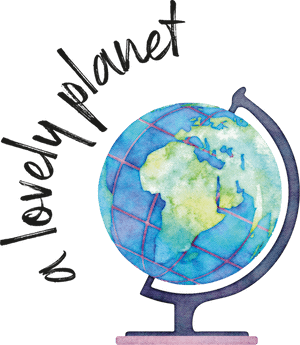
How to Travel Japan with a Baby and Toddler
I travelled a lot before having children and since welcoming two lovely babies into the world I’ve been keen to continue exploring, taking them with me. Some places are easier than others to travel with kids and as we recently experienced, Japan is an excellent place to travel with babies.
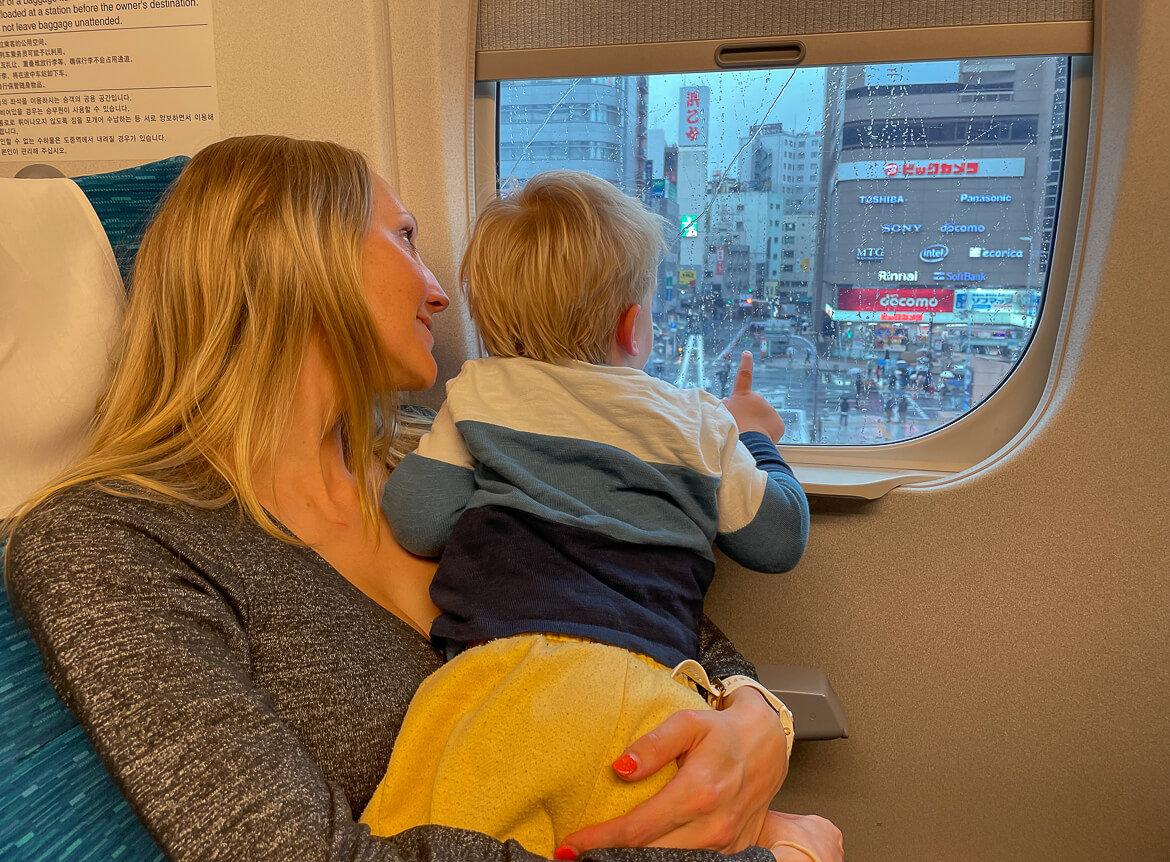
Disclosure: This article contains affiliate links. This means that if you click a link and purchase something I’ve recommended I’ll earn a small commission. This does not affect the price you pay but helps me to run this site. As an Amazon Associate, I earn from qualifying purchases. You can read my full affiliate disclosure here.
We spent a week travelling Japan with a baby and a toddler and would recommend taking your little ones there for a holiday. It’s clean, it’s safe and has excellent transport, delicious food and great baby facilities. We did a lot of research before travelling, spoke to other families that had travelled and after visiting ourselves now have some key tips to make a holiday in Japan with babies as stress-free as possible.
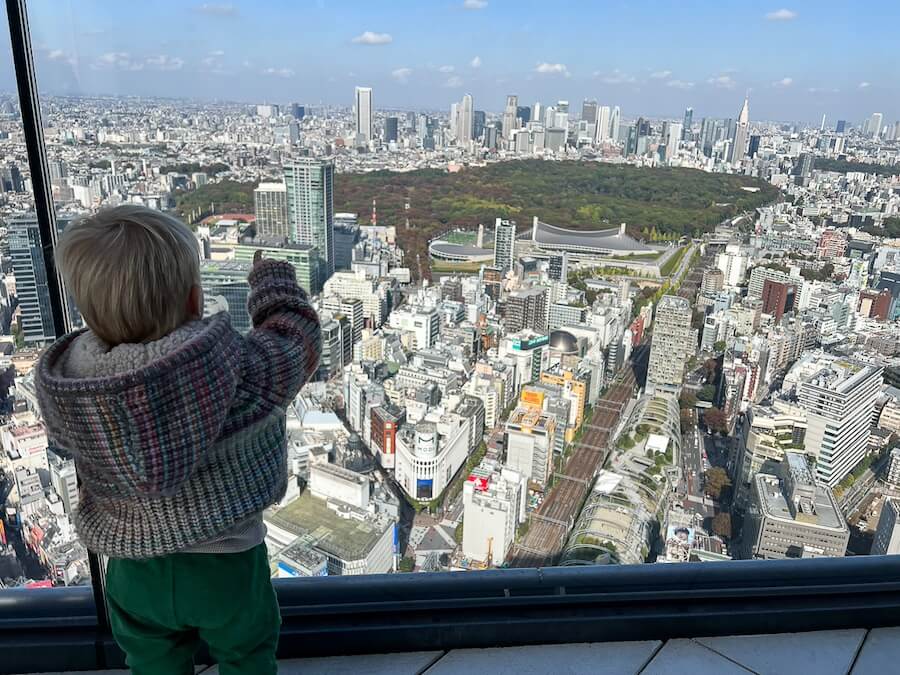
Take the Shinkansen Train
We loved travelling on the Shinkansen with the babies. It’s speedy and comfortable, and you can take plenty of snacks, drinks and all your luggage on board. Previously, many people opted to purchase the JR Pass which allows unlimited travel on most Shinkansen train services for a set period. (7, 14 or 21 days). However, the prices went up significantly in October 2023, so if you’re only taking a few train journeys in Japan then it makes much more sense to book individual point-to-point (P2P) train tickets , which is what we did. The other bonus of this is you can take the fastest trains (Nozomi and Mizuho Shinkansen Bullet Trains) which weren’t previously included in the JR Pass.
Our Japan family itinerary started and ended in Tokyo with a stay in Kyoto in between. So purchasing two single tickets was the best option and even if we had visited an additional city such as Osaka, P2P tickets would still be cheaper than buying a JR Pass.
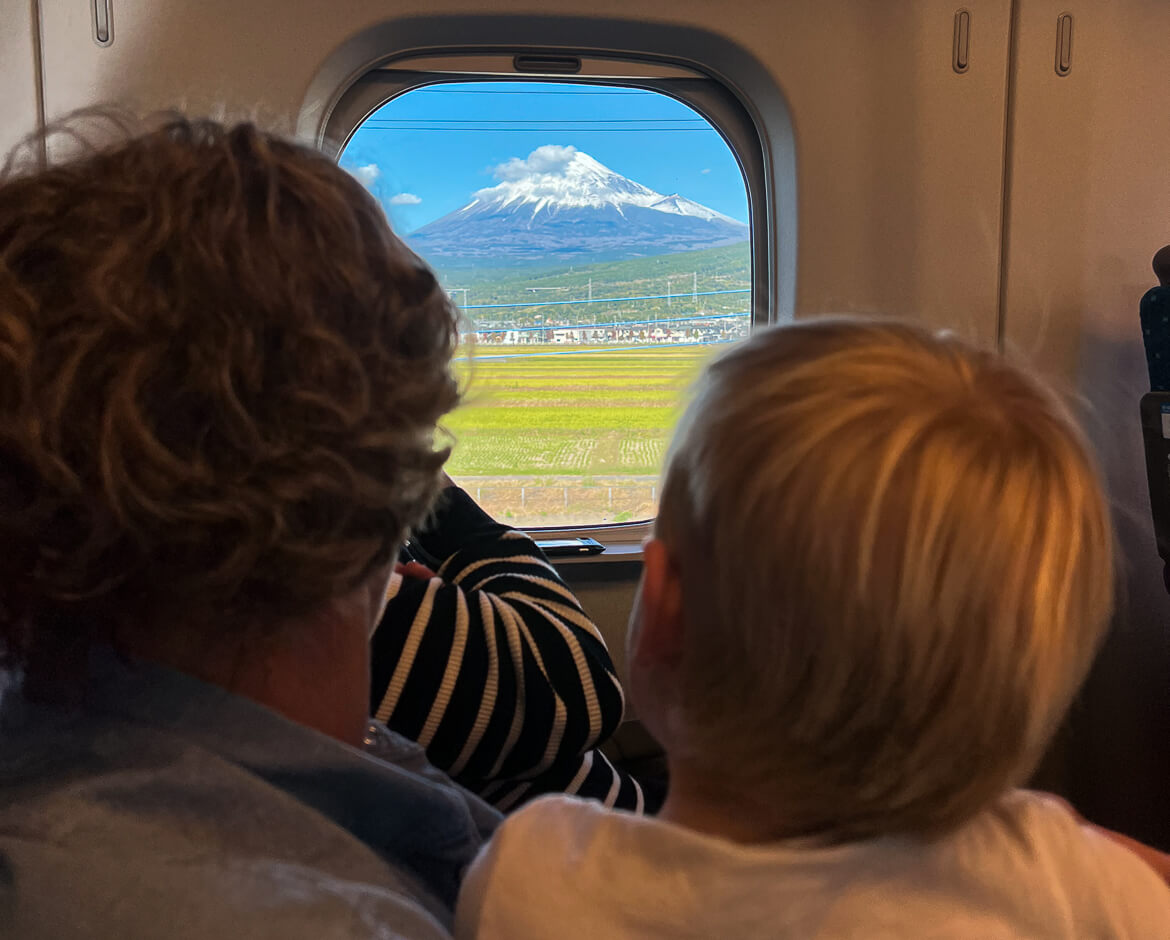
We booked our tickets through Klook . Make sure you select a ticket with ‘reserved seat’ on booking, which allocates you a seat. Babies and toddlers don’t require a ticket, but they won’t have their own seats unless you purchase them a ticket with a seat reservation. We had both the toddler and baby on our laps for the 2 hour train trip and it was fine.
There is just one row on each Shinkansen carriage that has an allocated space for large luggage, so if you need this, pop to a train station in Japan before your journey and ask to swap your reservation to that seat. Alternatively, you can pay a fine onboard which is 1000 yen to store your luggage providing there is space. (The reservation swap is free for one change). If you have small pieces of luggage then you can place them in the luggage racks above the seats.
One tip for taking the Shinkansen with a toddler and a baby is to make sure you get prepared for embarking/disembarking early. The trains don’t stop for very long, so it’s good to have one parent dealing with the bags while the other focuses on getting the kids on and off. A baby carrier is a good idea for this.
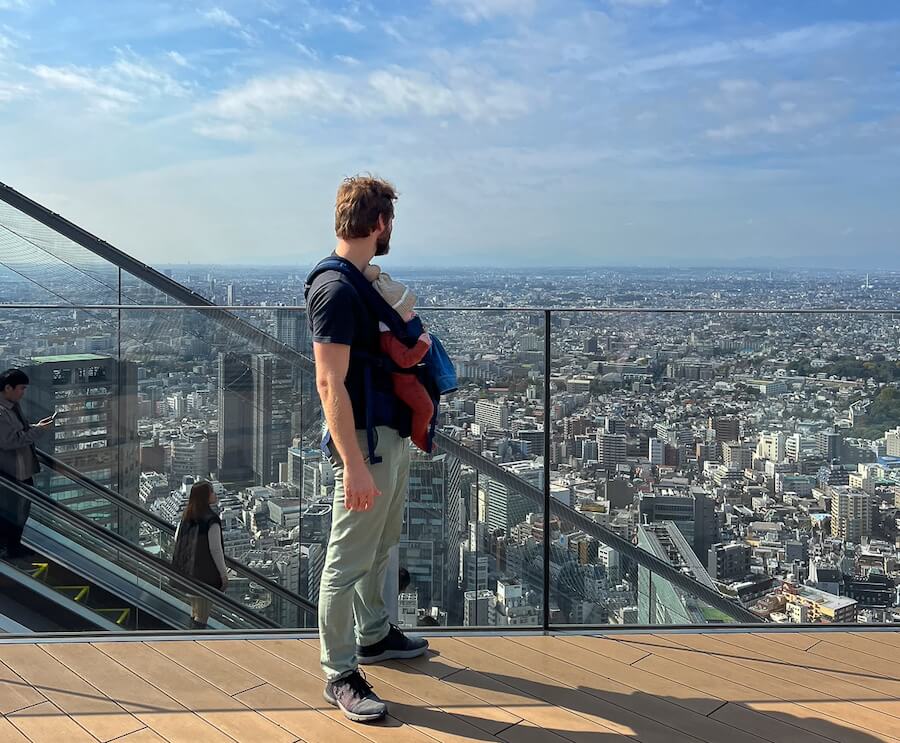
Take a Travel Pram and a Baby Carrier
It’s hard work lugging a big pram around, especially if you are taking the Metro and Shinkansen, so it is a good idea to take a travel pram to Japan. We have a double travel pram so that both the baby and the toddler can nap on the go, and it made it much easier to navigate the busy streets. It is compact enough to easily get on and off the train when folded and we took it on the Metro with no problem. Just be aware that not all stations have lifts, but we were always able to manage on the escalators. It’s also available as a single .
In Tokyo, we also visited the Tsukiji Fish Market, which is pretty busy and the stroller was narrow enough that it wasn’t too stressful! However most of the time, we kept the baby in a baby carrier – I think it was more enjoyable for her and in busy places like Tokyo it’s much easier. So if you don’t already have one it’s worth investing in a good baby carrier before the trip. We love the Ergobaby Omni Breeze . The baby also slept most of the flight there and back in the carrier too.
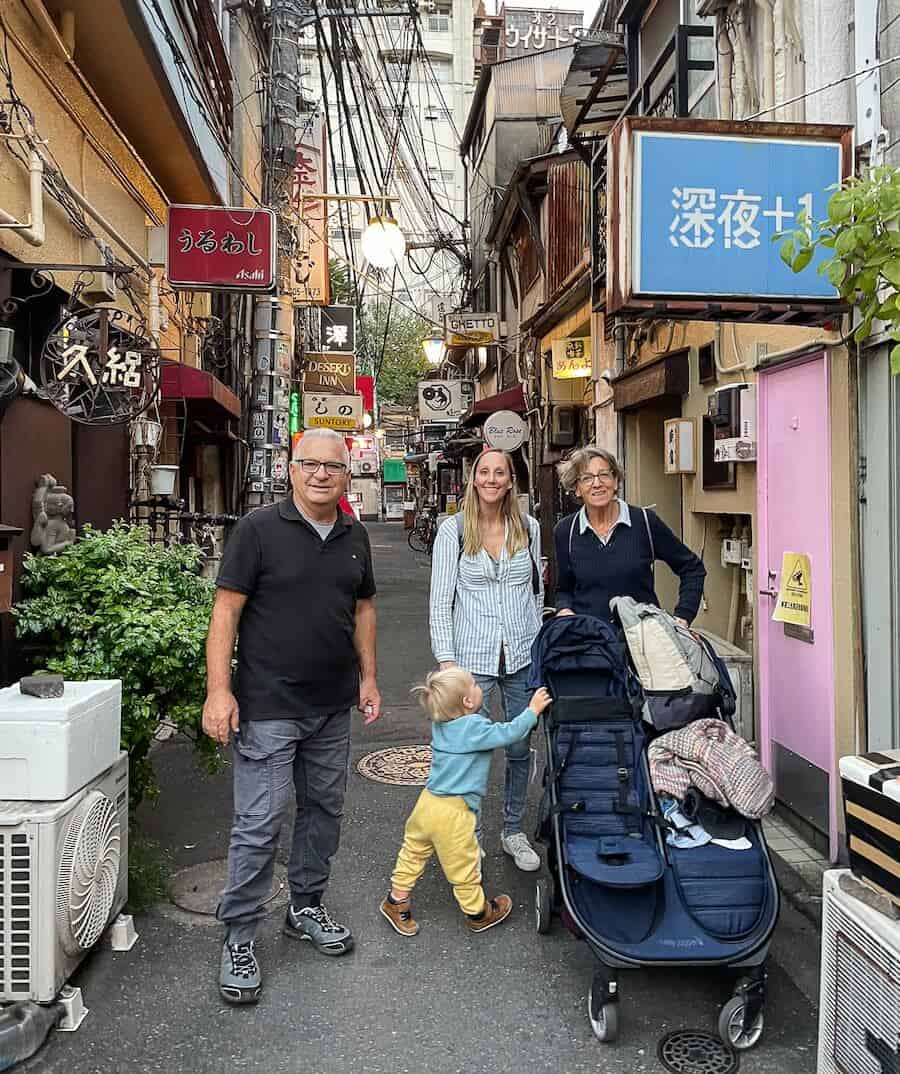
It’s worth noting that not all tourist attractions are stroller-friendly. For example, Fushimi Inari Shrine in Kyoto has lots of steps, especially the later sections. So it’s better to leave the pram at your accommodation when visiting and use a baby carrier.
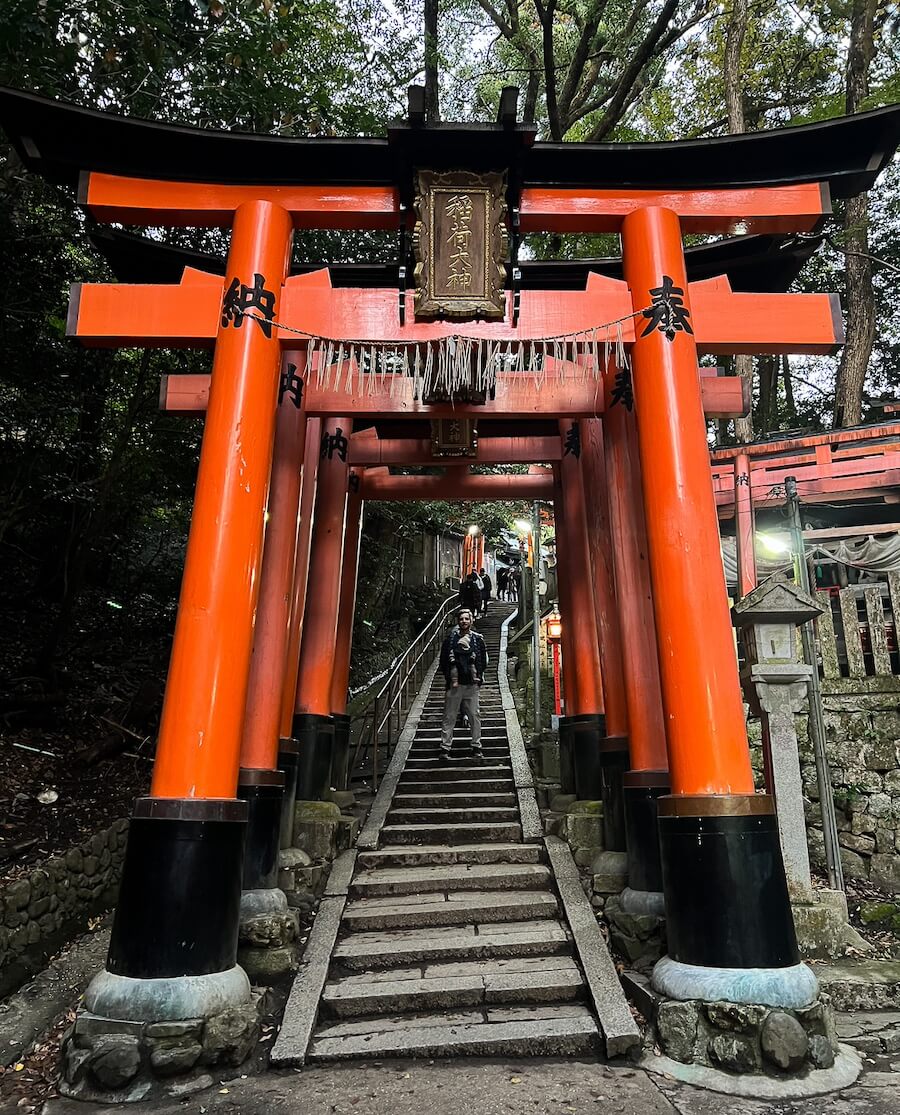
Family Friendly Accommodation in Japan
Japanese hotel rooms are notoriously small, so I highly recommend booking an apartment hotel in Japan. We stayed our entire trip at Mimaru Suites – a chain of apartment hotels – which we loved. These are perfect for families, with one, two and three bedroom apartments with kitchens and living spaces. Most also have a washing machine which is ideal for washing baby clothes after a poonami or a messy dinner. All of the apartments had microwaves so I could sterilise dummies and bottles in this handy reusable sterilisation bag .
It also means that you can put the babies to bed and enjoy an evening in the living space – rather than having to sit in the dark and trying not to wake the kids – something we did in Milan before realising apartments are the way to travel with children!
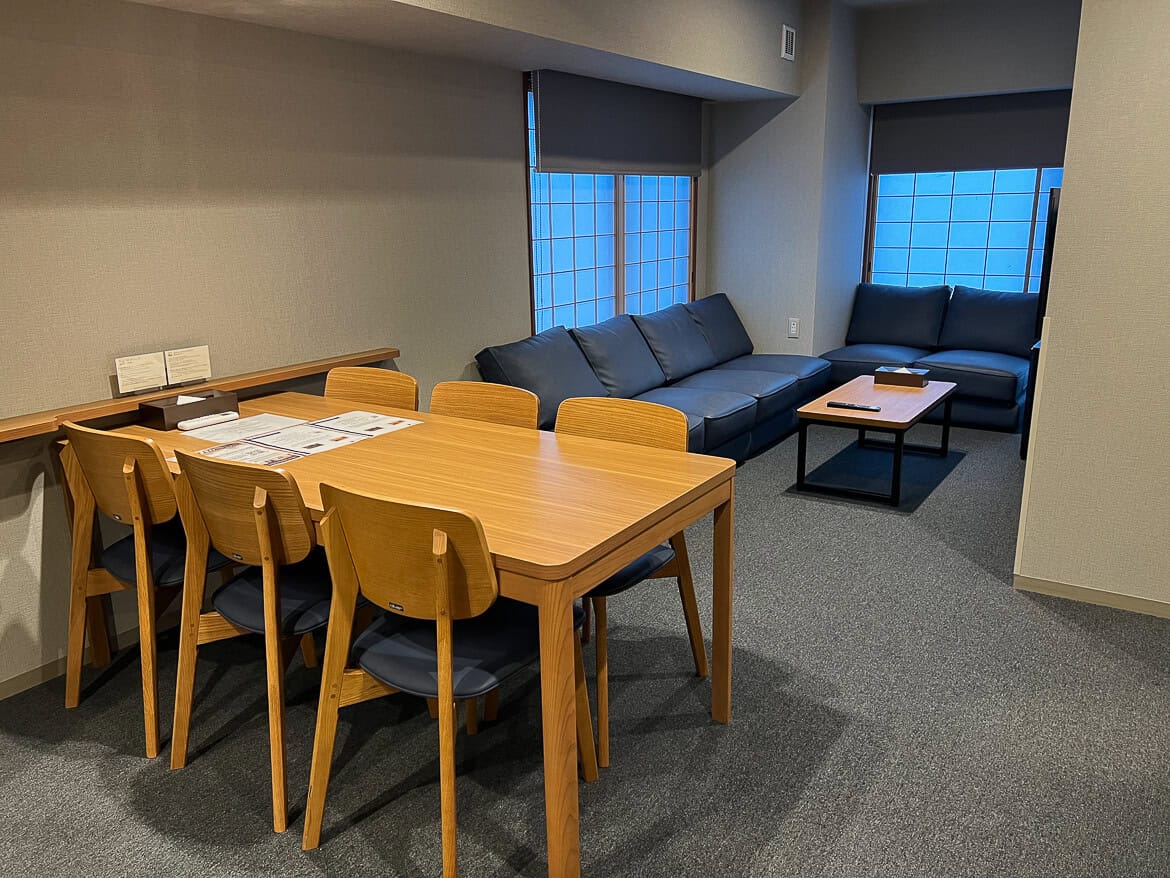
Mimaru Suites offer an extensive range of free rental items too, including baby cots and bedside panels for toddlers and they even provided us with a nappy bin! There are also more unusual items available like rice cookers, kitchen scales, yoga mats and luggage scales.
We particularly loved Mimaru Suites Kyoto Shijo which had lots of nice extras like a coffee machine that was available all day, a free craft beer and sake happy hour and calligraphy lessons.
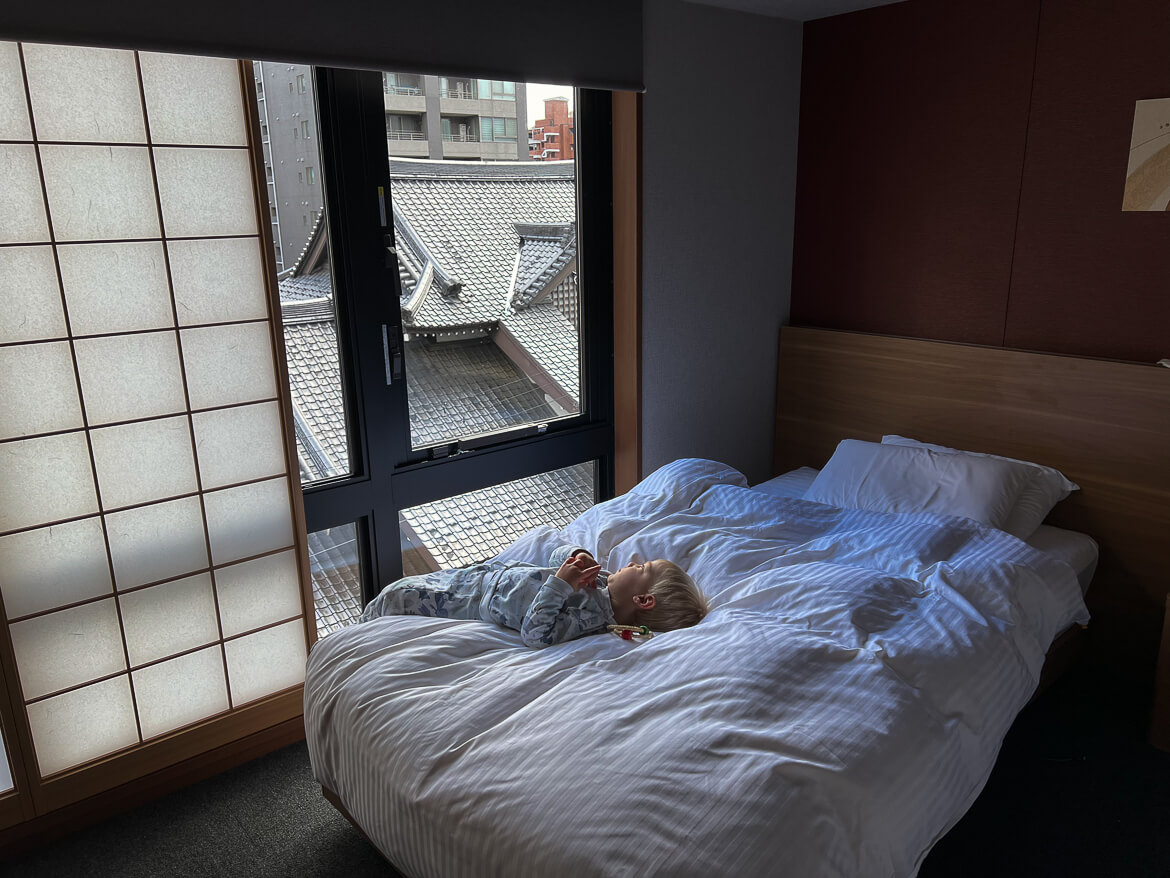
Pack Light
It’s worth being as minimalist as possible when packing for a Japan trip with a baby. We managed to take one suitcase for all four of us, along with a big backpack, a daypack and a nappy bag. It’s not easy pushing a suitcase and a pram simultaneously, so if you can reduce wheeled cases to one, then it makes life a lot easier when travelling between destinations.
This is another reason why staying in an apartment with a washing machine is a great idea. You can take less clothes and wash them during the trip.
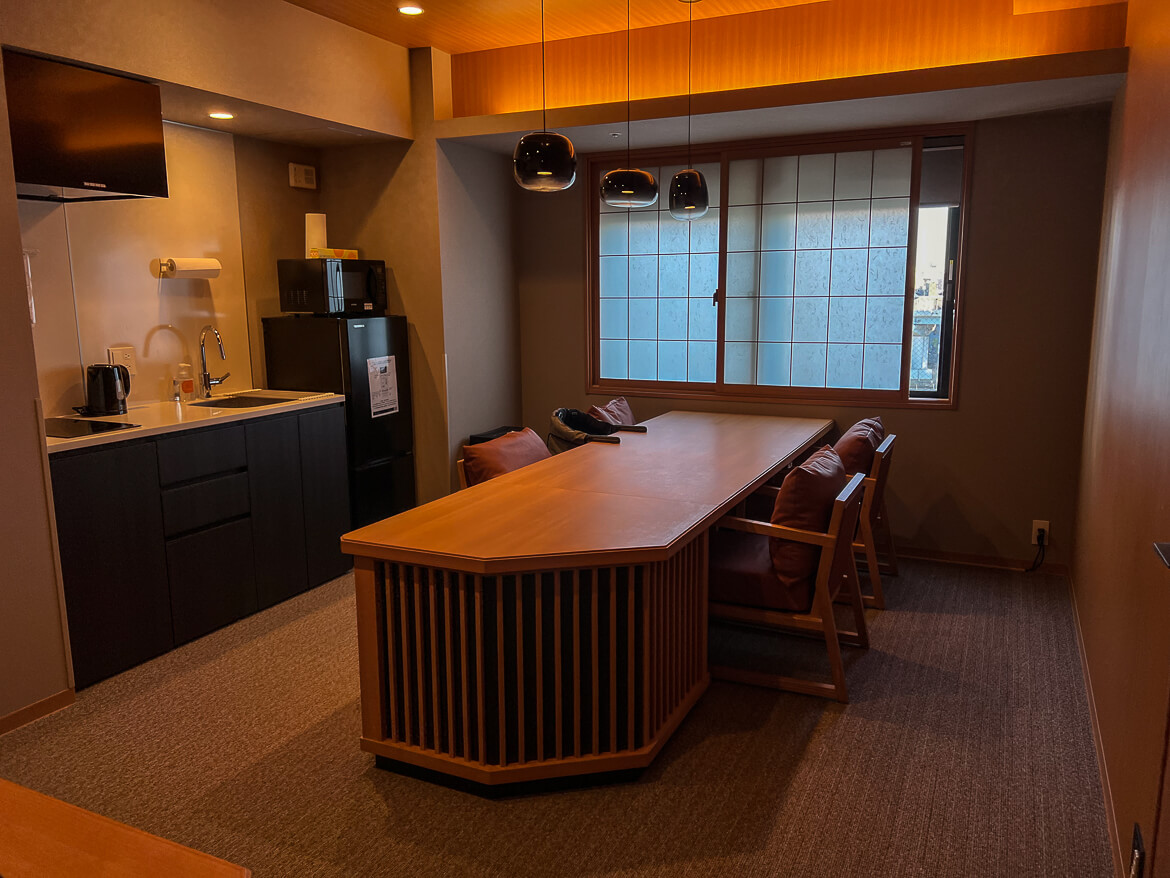
What to Pack for a trip to Japan with a Toddler and a Baby
I’ve written an article all about what to pack when travelling with a baby , which includes most of the things required for a trip to Japan. But a few extra things to point out specifically for travelling in Japan with a baby and toddler are listed below:
- Hand sanitiser – this may sound like a strange one, but we found that while the baby change facilities were excellent, lots of them did not have soap. So it’s well worth bringing hand sanitiser and hand sanitising wipes with you everywhere, as well as Milton wipes .
- Disposable nappy bags – Another thing we noticed in the baby changing rooms was that many of them didn’t have bins and in fact around Japan, it’s very rare to see a bin. People tend to eat in restaurants or at home in Japan – not on the move – so the take-out culture isn’t as common as it is in places like Australia and the UK. If you do get a takeaway coffee for example, you are expected to take your cup home with you or back to the place you bought it from for them to dispose of. So it’s a good idea to have some plastic nappy bags with you as you might not find a place to dispose of a dirty nappy for a while!
- Cash – Japan is such a modern and developed country that I wasn’t expecting to need cash. However, there were many occasions where only cash was accepted or only Japanese credit cards worked, such as for tickets on the Metro and for food at the fish market, so make sure you bring some cash with you or head to the ATM when you arrive.
Restaurants and Food in Japan
One of the main reasons I wanted to visit Japan was to eat the delicious food and it didn’t disappoint. Not all restaurants in Japan are baby-friendly, so it’s worth doing a bit of research before you go, but we had some fantastic meals with the children.
In Tokyo, there are lots of fun little areas of laneways with tiny restaurants, such as Golden Gai. Unfortunately, many of these are not that accessible when travelling with babies. Some only seat a few people so there is no way you’ll be getting a pram into one of these tiny eateries. However, we did manage to sit outside at one of the Omodie Yokocho restaurants and had a great meal with the babies.
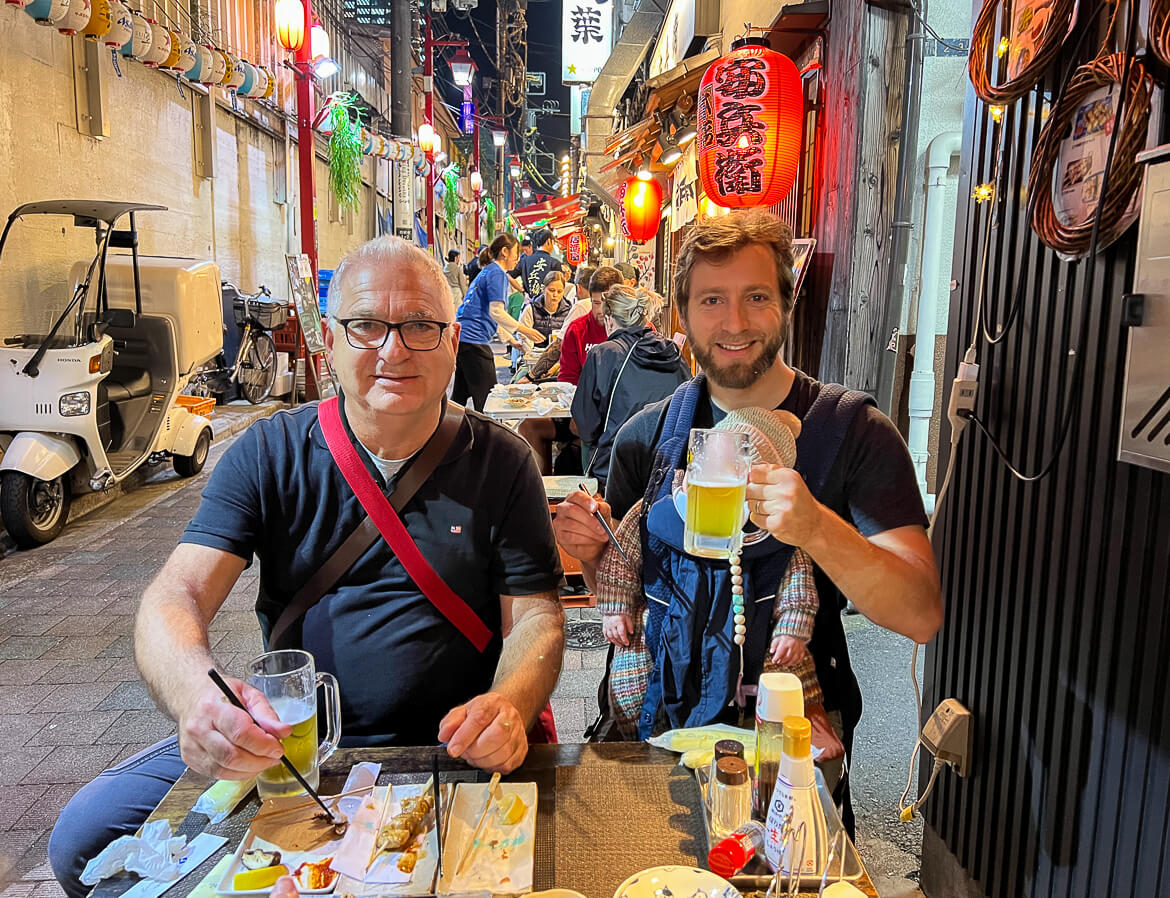
We generally tried to find bigger places to eat, such as Kura Sushi in Asakusa which is very child-friendly and fun. We also enjoyed Yakiniku Marutomi in Kyoto and they were happy to provide a high chair for our toddler which was handy given that there was a hot plate in the middle of the table so we needed to keep him contained!
Quite a few of the restaurants we ate at offered a kid’s menu, including children’s sushi (which generally seemed to be smaller and sweeter portions of regular sushi).
Read our guide on what to eat in Tokyo
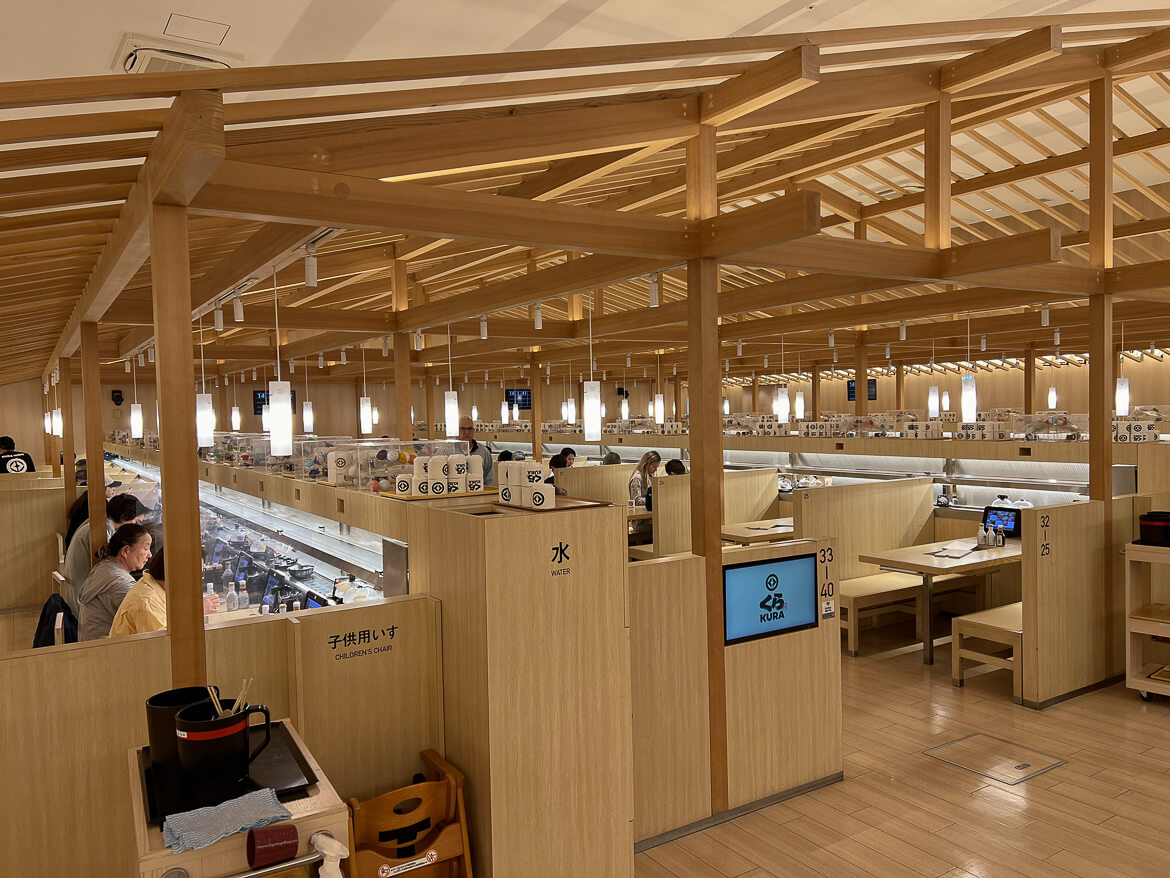
In the evenings, we either ate early at a restaurant or ate at home in our apartment hotel. You can use Uber Eats in Japan and there is also a Japanese app called Wolt. On other evenings we bought sushi from 7 Eleven or Fresco supermarket and ate that in our apartment. Both have great options and are very affordable.
In Japan, legally you have to be 20 to enter a bar. We tried to go out for a drink one evening with the baby in a carrier but sadly couldn’t get in anywhere for this reason. So that’s worth bearing in mind if you’re planning an evening out.
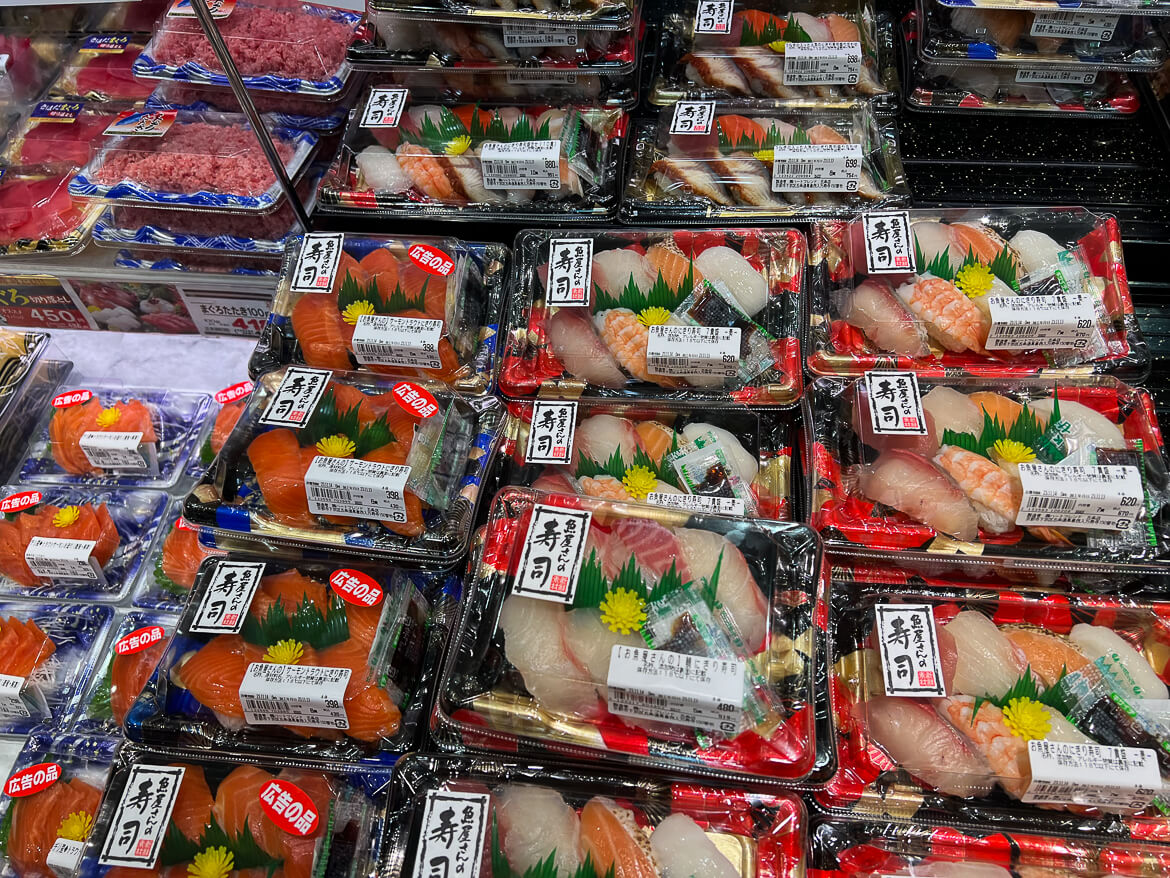
Baby Changing
You will find baby-changing facilities in shopping centres, train stations and most tourist attractions. These are in general very clean and spacious. Though worth noting as mentioned before, that many don’t have soap. Nappies can be purchased from most pharmacies. Lots of the public toilets also have a little seat to put your baby in while you use the toilet which I thought was very cute. Though my baby is far too wriggly to trust putting her in one!
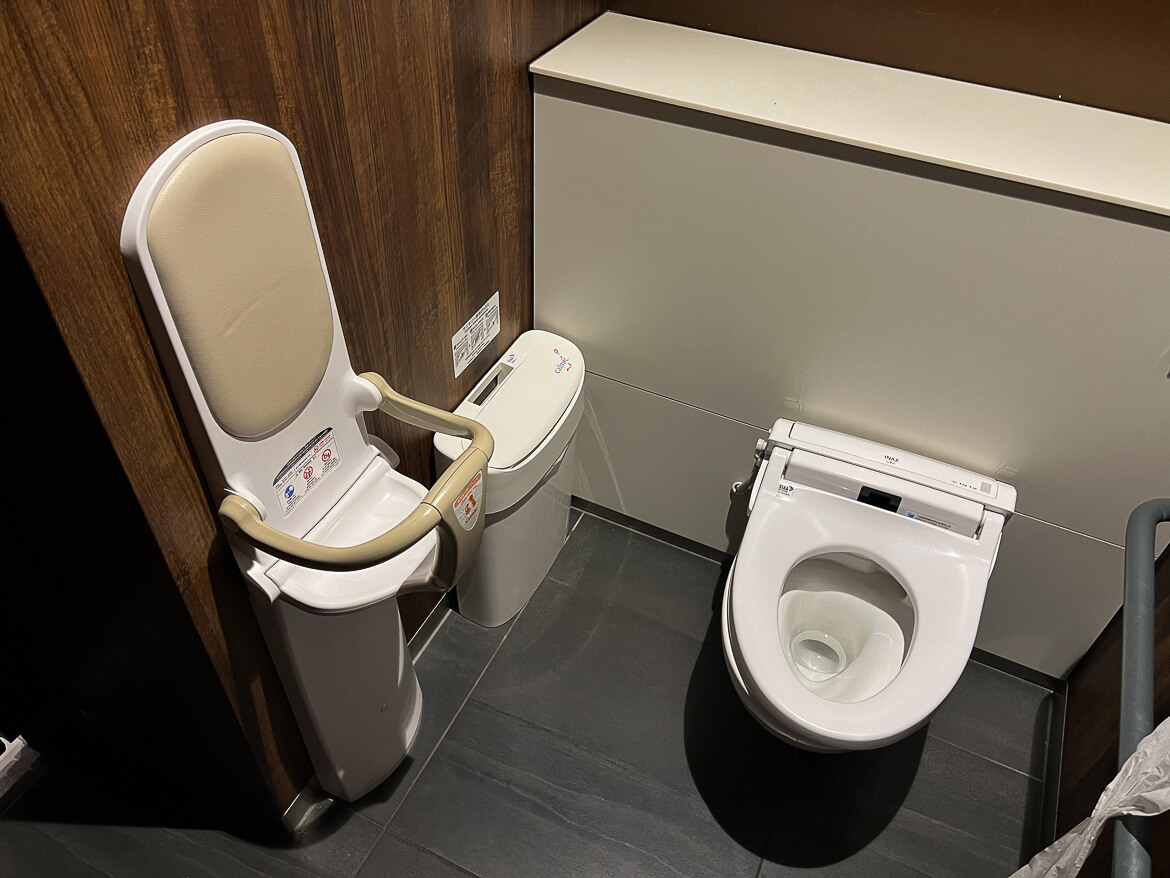
Japanese Parks
Parents of toddlers will know the importance of having somewhere for the little ones to let off steam. Luckily the Japanese cities we visited have fantastic parks. Yoyogi Park in Tokyo is huge and has lots of green space to enjoy – it’s also very beautiful – particularly during the Cherry Blossom and Autumn periods. I also bookmarked a variety of children’s playgrounds on Google Maps before the trip so we could pop to a park for a quick swing or slide when out and about each day.
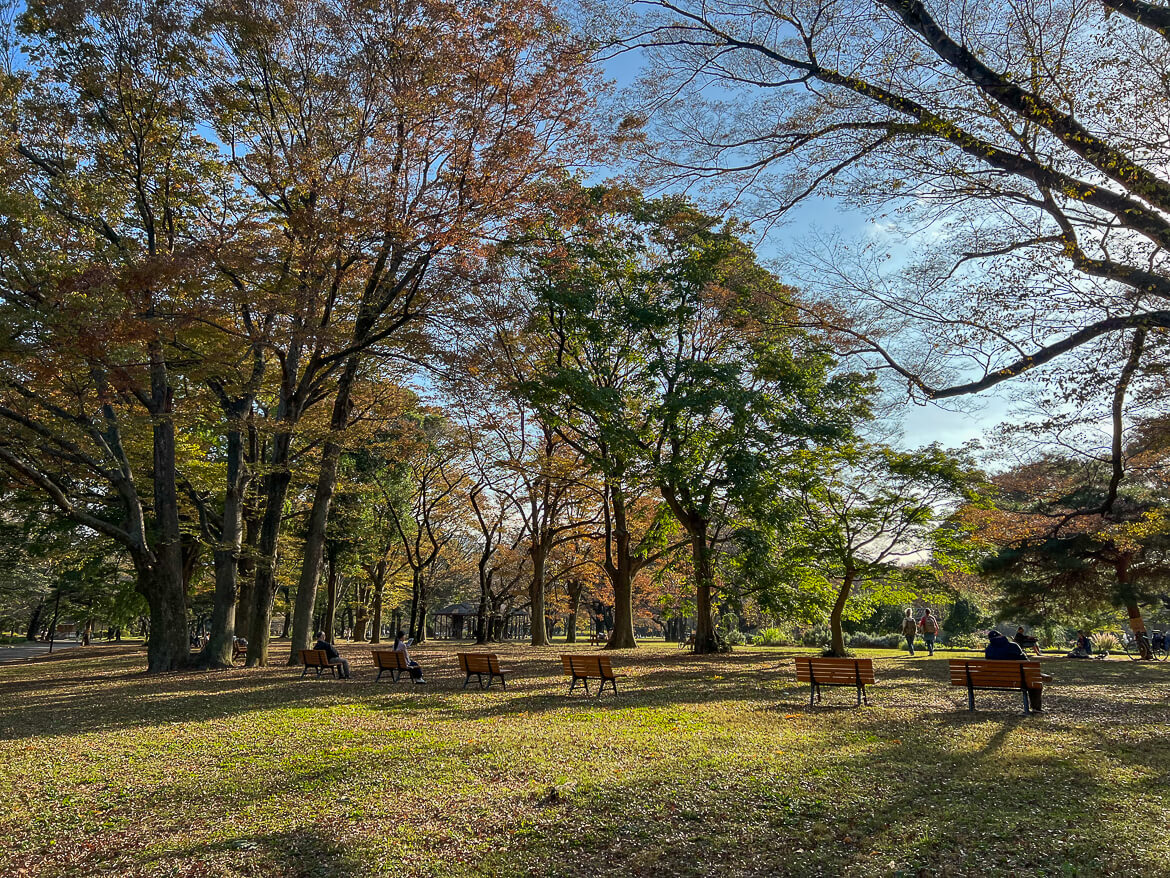
Travelling to and from Japan with Babies
We flew with ANA who were amazing and I would fly with them again. The staff were so attentive and helped us with the baby and the toddler. Tokyo Haneda airport is great and has excellent facilities and they have prams that you can use once you have checked in your luggage. (ANA also had this option when flying from Sydney too).
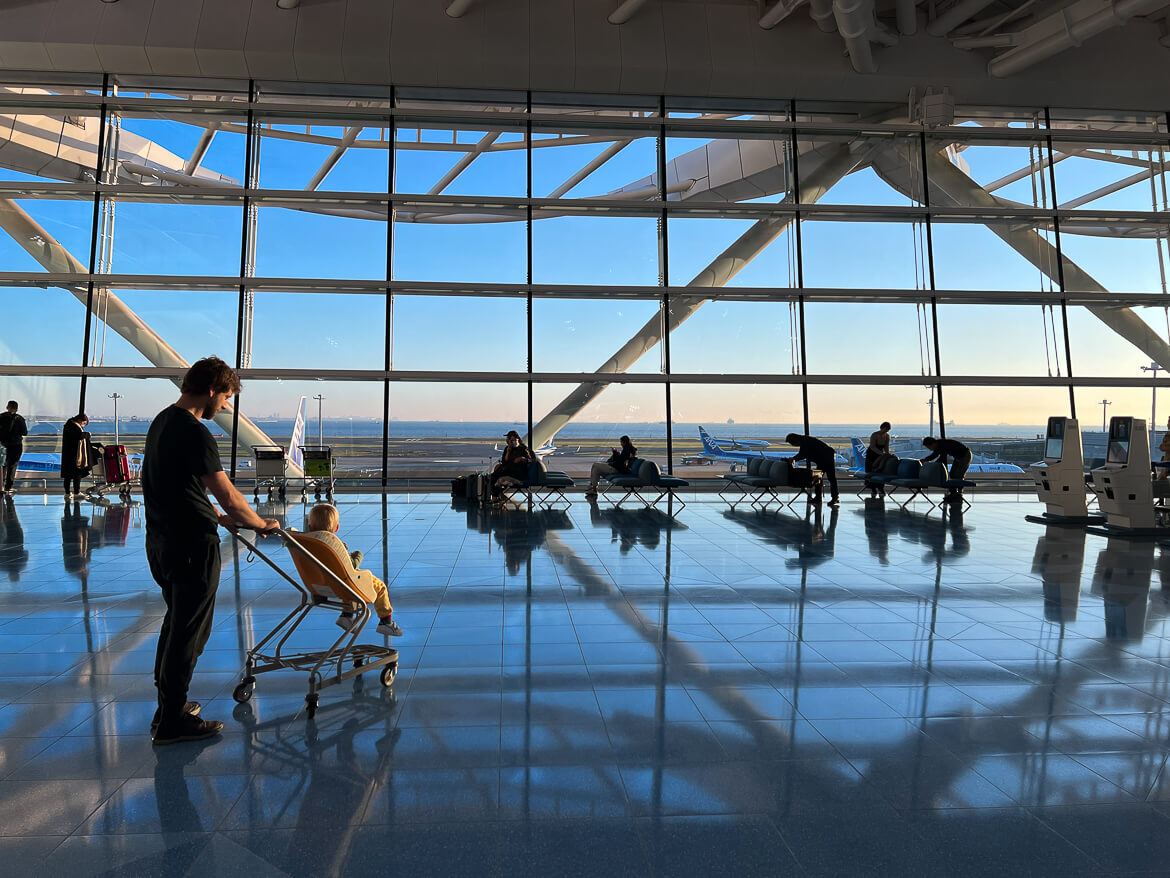
Overall, travelling in Japan with babies was a fun and easy experience and I’m keen to go back soon and see more of the country.
You may also like
Jervis bay itinerary – 3 days in jervis..., a foodie bologna itinerary – 3 days in..., 3 week mexico itinerary.
HI! Great blog entry, super thorough and makes me feel like it will be possible to travel to japan with 20 month old twins! How long were you in Japan for and was this an adequate amount of time?
We were there for 8 days – I’m in the process of writing up our itinerary so check back soon! I think if I were to do it again I would allow a little longer as we loved Kyoto so much I could have spent much longer there. Hope you have a great trip!
Thank you for this! Looking to go in November and would love to spend most of our time in Kyoto!
We travelled in November – it was a great time to visit. Have a lovely time!
Leave a Comment Cancel Reply
Save my name, email, and website in this browser for the next time I comment.
This site uses Akismet to reduce spam. Learn how your comment data is processed .
- Banda Islands
- North Sulawesi
- United Arab Emirates
- Emilia Romagna
- Northern Ireland
- New South Wales
- Northern Territory
- South Australia
- Western Australia
- New Zealand
- Cook Islands
- French Polynesia
Jervis Bay Itinerary – 3 Days in Jervis…
A foodie bologna itinerary – 3 days in…, puglia itinerary – 3 days in puglia, byron bay itinerary – 3 days in byron…, clare valley itinerary – a weekend in the…, 10 day tuscany road trip itinerary, perth to exmouth road trip itinerary, the perfect 10 day samoa itinerary, rome to venice road trip itinerary – 10…, sydney to byron bay road trip itinerary, the great southern – adelaide to brisbane aboard…, the best tacos in mexico city, the best sydney avocado dishes, things to do in tuscany, italy, the best sydney speakeasy bars, the best wineries in mclaren vale, reef magic review – a great barrier reef…, the best sardinia beaches, french polynesia itinerary – two weeks in french…, tasmania road trip – 2 week tasmania itinerary, kakadu itinerary – 4 days in kakadu and…, how to have a finnish lapland summer adventure, queenstown activities – things to do in queenstown, 5 ski resort alternatives to skiing and snowboarding, a beginners guide to skiing & snowboarding, skiing the three valleys, the darling, sydney – hotel review, an overnight yacht stay in sydney, vibe hotel canberra – review, stillwater seven, tasmania – review, the ship inn stanley review, how to travel japan with a baby and…, how to have the perfect holiday in fiji…, essentials for travelling with a baby, tips for travelling with a baby, on the road: tips for a nomadic lifestyle, how to make the most of your money…, the amalfi coast on a budget, long term travel checklist, choosing a travel backpack, my favourite travel gear, 10 essential items to pack for a round…, sustainable hotels – how to choose eco-friendly accommodation, tanja lagoon camp – review, responsible tourism – how to be a sustainable…, volunteering – a different way to travel.
- About A Lovely Planet
- Personal Posts
- Work With A Lovely Planet

- PLAN MY TRIP
- All Destinations
- Discover Hokkaido
- Discover Honshu
- Discover Kyushu
- Discover Shikoku
- THINGS TO DO
- Japan Travel Deals
Exploring Japan With A Baby: 12 Lifesaving Tips & Tricks
6 comments

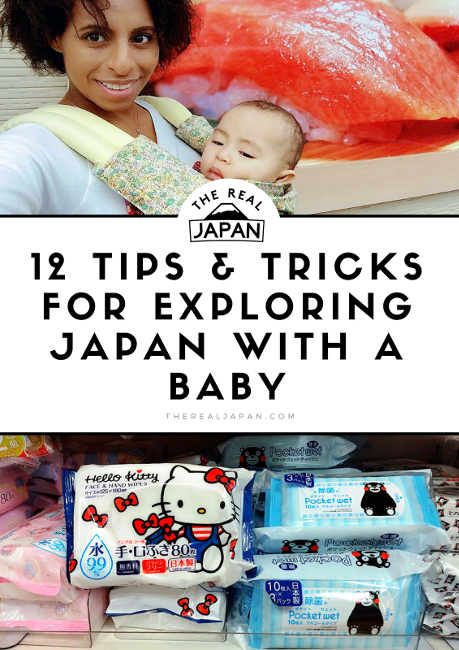
12 Tips And Tricks For Exploring Japan With A Baby by Teni Wada
Ready to see The Real Japan with your little ones?
While I can’t guarantee that your Japan trip will be free of tears and meltdowns, I can share my domestic and international travel experience to help make your trip as smooth as possible.
I’ve put together a list of 12 tips and tricks for exploring Japan with a baby or toddler just for you.
Let’s start with the basics!
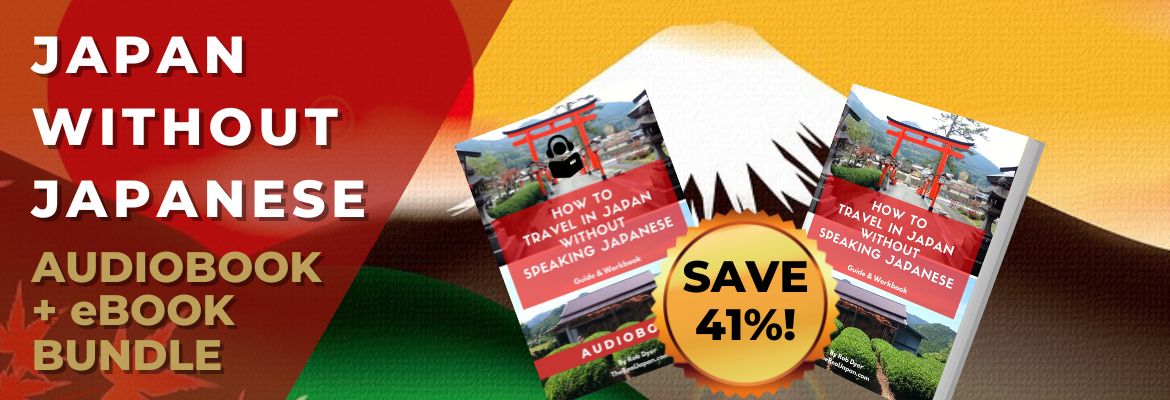
About the Author
Author Teni Wada is a blogger, content creator, and first-time mom documenting her journey of motherhood in Tokyo and travels with baby at The Wagamama Diaries .
If you enjoyed this article please share this image online:
Feedback and questions welcome - please leave a comment below.
Leave A Comment / Ask A Question
Book your trip: japan travel essentials, click to see my recommendations.
Book Your Flight Find the best flight by using Skyscanner . It's my go-to flight search engine because it has the most comprehensive global search options.
Book Your Accommodation I frequently use Booking.com as they consistently offer the cheapest rates and most flexible cancellation options for hotels and guesthouses. Use Hostelworld if you're looking for budget-priced options.
Book Your Japan Rail Pass The best official agent by a country mile is JRPass.com . Clear and easy to use website. Excellent customer service.
Book Your WiFi I never travel in Japan without pocket WiFi. Get Ninja WiFi for unlimited internet everywhere, use Google Maps, supports up to 10 devices.
Book Your SIM Card or eSIM Order your physical SIM Cards or eSIMs to stay connected and in touch while in Japan.
Book Your Hire Car Rent a car in Japan without speaking or reading Japanese via Booking.com's Car Rental portal.
Ready To Book Your Trip? Check out my Recommended Japan Travel Resources . The list covers all the essentials. It’s filled with carefully selected travel resources. And I only include the best travel resources - those I use myself or recommend to my clients.
Need Help Planning Your Trip? My Japan Travel Store includes essential travel items as well as my books, travel guides and more .
Hi! Im so glad to stumble unto your article just before a week of my japan trip with my 9 years old baby, So this is my first trip to japan, im wondering is there any high chair available on the local’s restaurant? I heard that most of japanese restaurant are quite small and arent so baby friendly.
Hello Angel – pleased you found my article in time!
Some local restaurants (and cafes) will have baby high chairs, some won’t. It’s essentially down to the individual owners as to whether or not you’ll have them.
What I would suggest though is if you find a place you’d really like to try but don’t see anything about a baby high chair simply ask at the entrance if they can provide. They may have them but only produce them when asked.
Have a great trip!
We will go to Japan with our daughter SOPHIE when she completes 1 year old.
RICK TAKASHI IKESAKA
That sounds wonderful Rick! Will it be your first trip to Japan, or have you been before?
Where to rent or borrow a stroller and also a car baby seat (age 3)
Thanks for the question Jorn – depends where you’re going to be when you need to rent the items. If you can tell me where you’ll be, I can make some recommendations.
Session expired
Please log in again. The login page will open in a new tab. After logging in you can close it and return to this page.
Privacy Overview
How to Travel With a Baby in Japan
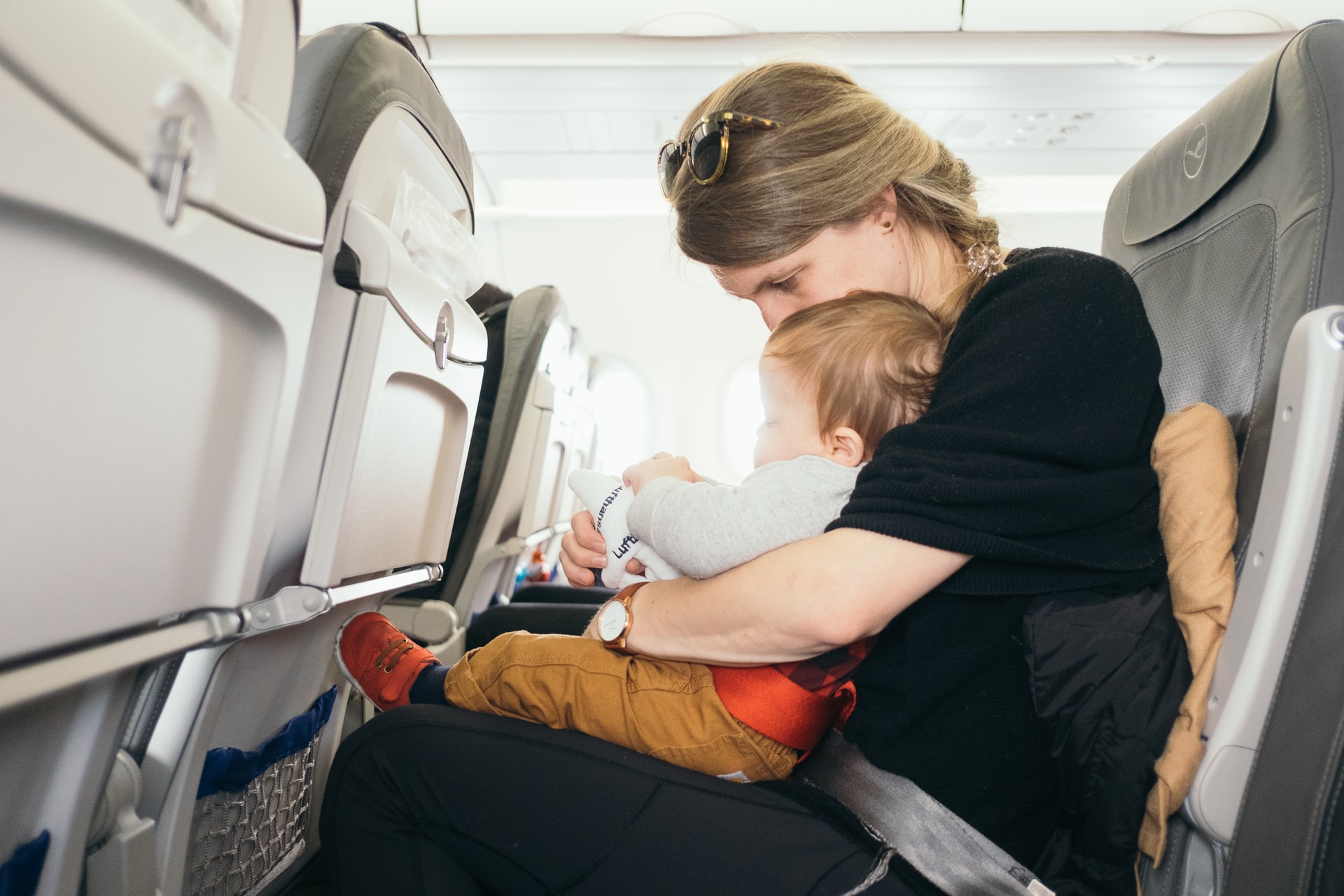
While making an overseas trip may not be the first thing on your mind if you have recently added a new member to your family, if you’d be so inclined you should definitely consider Japan. Japan, including the capital, Tokyo , is a surprisingly family-friendly holiday destination. As traveling with babies is always a bit of a challenge, it is good to be prepared so you can make everyone’s travel experience a great one. Here are 7 tips on how to travel with a baby in Japan for your best family trip to the Land of the Rising Sun!
Clothing for Travel
Family friendly accommodation, public transportation in japan, baggage shipping service, bring a baby carrier and a lightweight stroller, baby friendly spaces in japan, plan for extra time, family friendly tours in japan.
Packing and dressing smart is half of the work of making any long-haul trip as stress-free as possible. First of all, it is always a good idea to travel as light as possible. As most accommodations have laundry machines on the premises and coin laundromats are also ubiquitous in Japan, you shouldn’t worry about packing a change of clothes for every travel day. Bringing 4 or 5 sets of clothing per person is enough for most people, and for babies, you may want to bring one extra set for little accidents that happen on the go. Bringing one comfortable vest or light jacket for everyone is also a good idea, as temperatures can differ quite a lot between air-conditioned spaces and outside. If you travel during the winter , make sure that some of your clothing is thermal clothing, as conditions can be cold and humid. If you don’t have that type of clothing yet, you can buy ‘heat tech’ for a good price at Uniqlo .
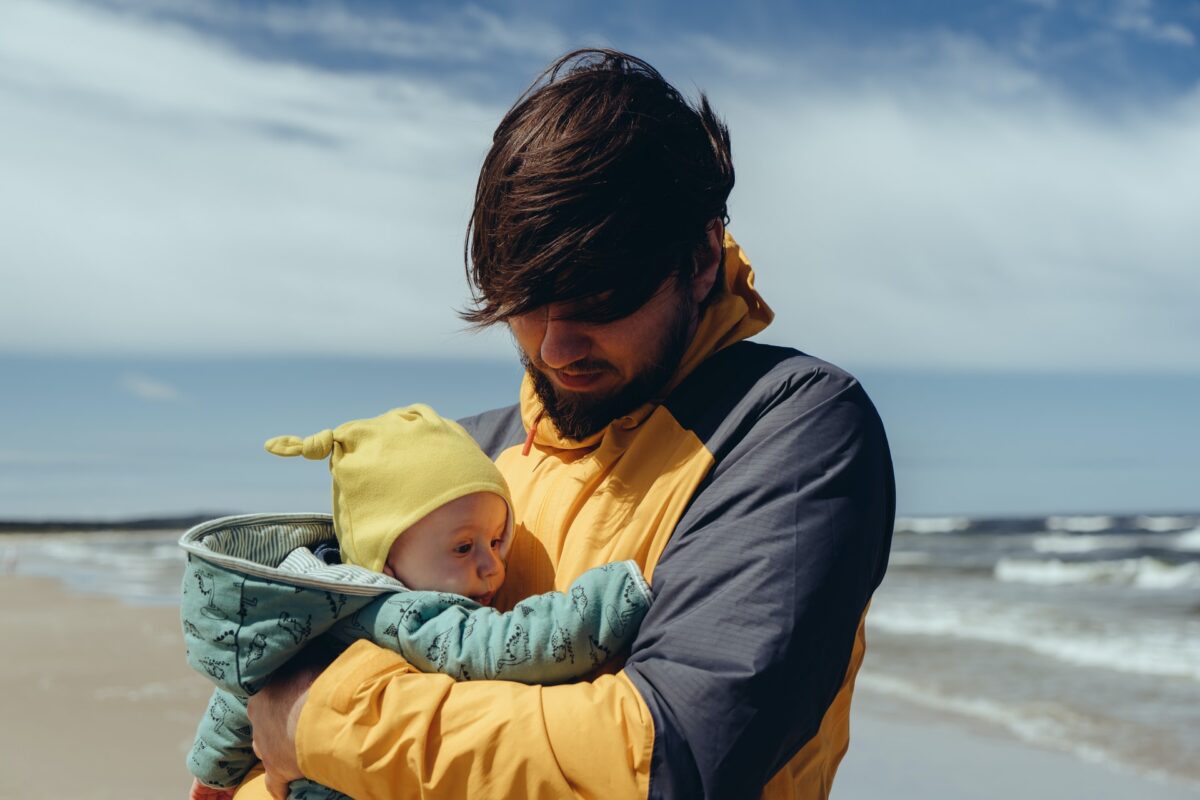
Looking to travel lighter on your trip to Japan? Go sustainable and lighten your load with Any Wear, Anywhere!

Many hotels in Japan cater to business travelers, meaning that the rooms are small and so are the beds. Business-style hotels are great for budget-conscious people who travel solo or as a couple, but for families, they tend to be too cramped. If you travel with a baby or bigger kids that you want to stay in the same room with, you’d better make sure that the accommodations you book are family-friendly. Bigger resorts tend to have family rooms that are spacious and can sleep larger groups, and they also often have special kid rooms where babies and toddlers can play safely. You can also opt for a whole apartment or even a house to yourself through services like Airbnb, especially if you prefer to cook (most of) your own meals. And if you don’t mind a bit of a splurge, luxury ryokan can also be a very comfortable lodging option for those traveling with kids.
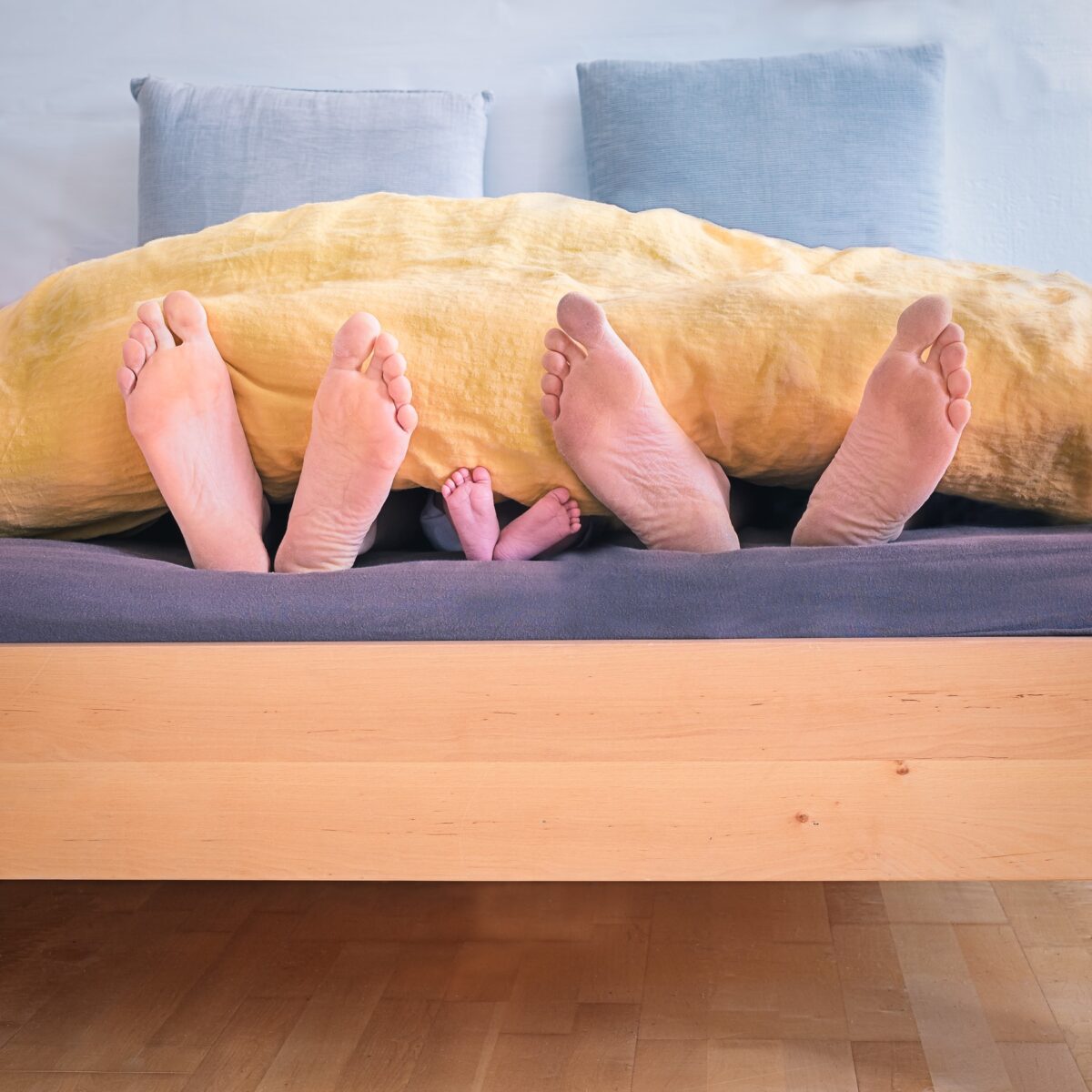
While traveling through Japan in a rental car is possible, we recommend families with young children travel by train. Unlike in some countries, train and bus travel is convenient and comfortable in Japan, and it can also be surprisingly affordable. Longer distances are usually best traveled by shinkansen , the super-fast bullet train that is an experience of its own. There is ample space, and you can take a walk through the long train with your kids if they get restless. The JR pass is what makes the shinkansen affordable for foreign tourists, and kids under 6 travel for free.

If you are using public transportation to get around in Japan, you may be worried about lugging your large suitcases along with you and your baby. Luckily, for those who didn’t manage to travel light, there is a great service available in Japan. The so-called Takuhaibin service can help you ship your large pieces of luggage from one accommodation to the next for as little as 1500 JPY. Hands-free traveling has never been this easy before! If you stay in a hotel, the front desk can take care of the shipping process for you. Are you staying in self-arranged accommodation? In that case, you can get assistance in English by phone to find out where to drop off your luggage.
Getting around can be a challenge if you have one of those large baby strollers that can weigh a ton, especially if you want to use public transportation or want to visit places that can only be reached by taking the stairs. What we recommend is to do what the local parents do, and bring a baby carrier. In Japan, parents usually carry their kids until they are around 1 and a half years old and start to walk on their own. It is so much easier to move around that way, and babies tend to be quieter if they are carried around. If your baby is a bit older but can’t walk long distances yet, a combination of a carrier and a lightweight stroller can be the winner.
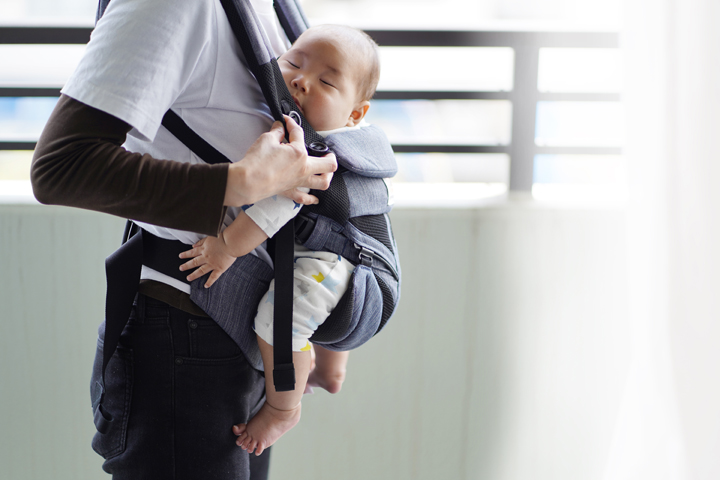
There are many public places in Japan that were designed for the needs of young parents. Newer public toilets in parks as well as in places like shopping malls have clean and spacious accessible toilets with diaper changing stations and small seats where babies can safely sit until the parent is done. Many malls also have nursing rooms near the toilets that can be used for breastfeeding. In Japan, breastfeeding in public is acceptable as long as you use a blanket to stay discreet.
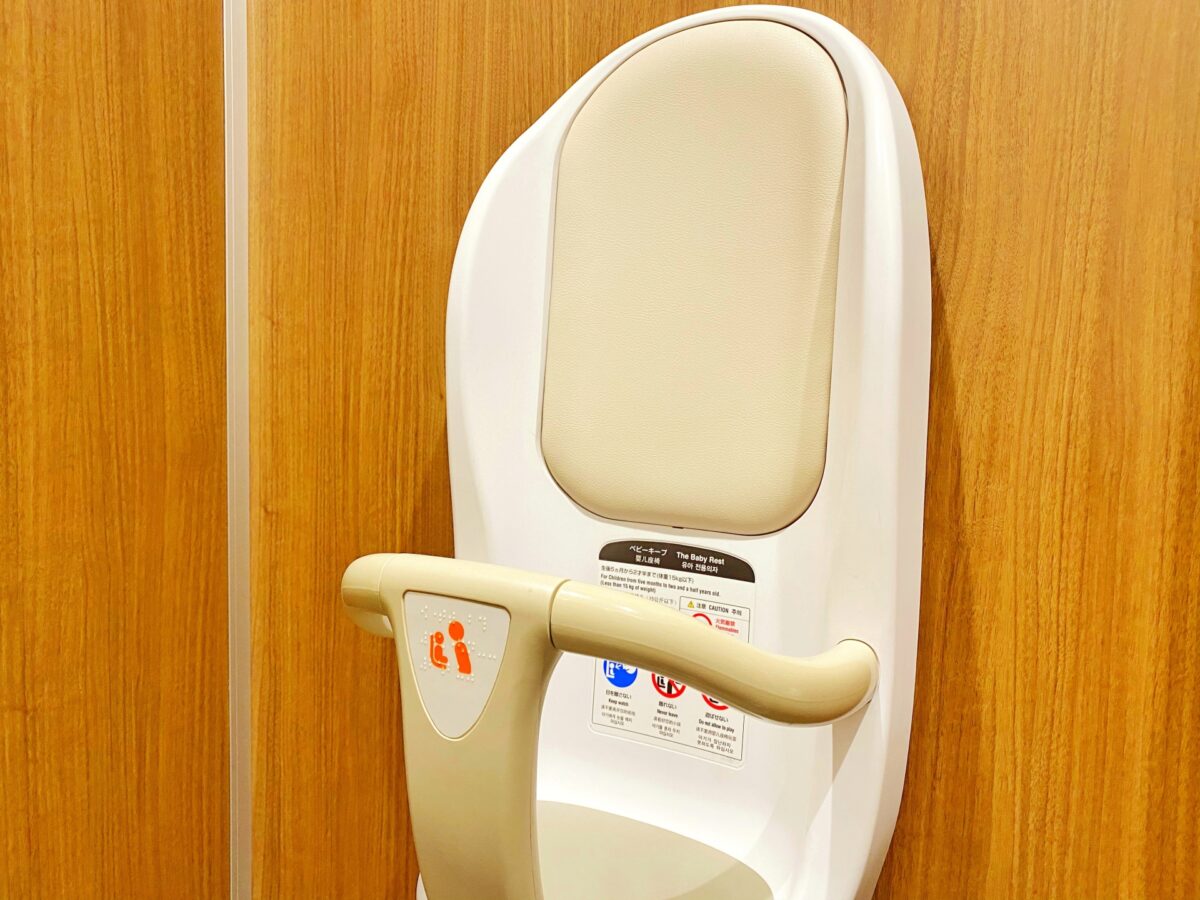
One of the most important things to do if you travel to Japan with a baby or young kids is not to pack your itinerary too tight. As things always don’t go exactly the way you planned them, you will greatly decrease your chances of any travel stress if you leave enough extra time in your schedule to deal with these unforeseen circumstances. Besides, isn’t it much more enjoyable and relaxing to leave yourself plenty of time to actually soak up your surroundings and enjoy the details instead of just trying to cram as many things as you can into your trip? The best way to do this is to limit the number of cities you visit in one travel week to 2 and to only make day trips to places that are easily accessible from the city your accommodation is in. This way, you will maximize your travel time without losing out on many of the beautiful things that can be seen and done in Japan.
If you do your best to stick to the tips mentioned above, you should not have too many issues traveling with young children in Japan. Generally, amenities that make life with babies easier are readily accessible in Japan, especially in larger cities. Another good idea is to book a private guide for one or more days. This can help make your trip even easier as companies like us can make any necessary preparations to make your day smooth, fun, and educational. We offer private tours in Tokyo , Kyoto , Osaka , as well as other cities in Japan. If your kids are a bit older, we also have a special Harajuku tour for the whole family . We hope that your trip to Japan with your baby is a safe, fun, and memorable experience!
As more people get COVID-19 vaccines, travel becomes safer for adults and children. Loveholidays penned this guide to help parents make preparations for traveling with babies and kids abroad.
Follow us on Instagram , Facebook and Twitter for more travel inspiration. Or tag us to get featured!
Happy traveling!

Stefanie Akkerman moved from the Netherlands to Japan in 2013 with her Japanese husband and son. She jumped into the niche of Dutch tour guiding in Tokyo and Kamakura in 2015 and occasionally writes articles about all the great sights and activities Japan has to offer. She loves (Japanese) food, and to work that all off she goes diving, snorkeling, cycling, or hiking.
This post may contain some affiliate links. When you click through and make a purchase we may receive some commission, at no extra costs to you.

- Popular destinations
- Hidden places in Japan
- Tours and workshop
- Food and drink in Japan
- Itinerary in Japan
- Places to visit in Tokyo
- Food and drink in Tokyo
- Seasonal events
- Tours & workshops
- Tokyo This Week
- Day trip from Tokyo
- Itinerary in Tokyo
- Places to visit in Kyoto
- Food and drink in Kyoto
- Itinerary in Kyoto
- Day trip from Kyoto
- Travel tips
- Accommodation
- Cultural tips
- Transportation
- Tokyo Tours
- Kyoto Tours
- Kimono Rental
- Fukushima Tours
- Mount Fuji Tours
- Tour Package
- Media Kit(English/日本語)
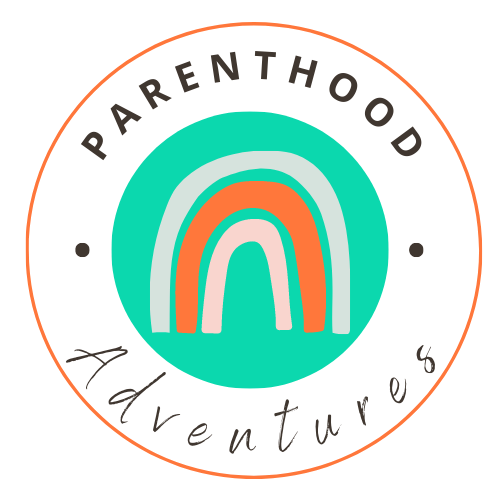
- Airline Reviews
- Baby Travel Tips
- Packing Lists + Hacks
- Toddler Travel Tips
- Baby Essentials
- Toddler Essentials
- Travel Essentials
- Destinations
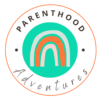
- Mom Confessions
Traveling with a Baby in Japan – Everything You Need to Know
Is Japan baby friendly? Absolutely. Does that mean it’s always easy to travel through with a baby? Not exactly.
We just returned from two wonderful weeks traveling through Japan with our 6-month-old and while some parts of the trip were challenging, I think we did a pretty good job of successfully navigating four cities in two weeks with our baby. Here’s everything we did to make our trip to Japan with our baby a memory we’ll always hold dear:
Table of Contents
Overall Japan Baby Friendliness
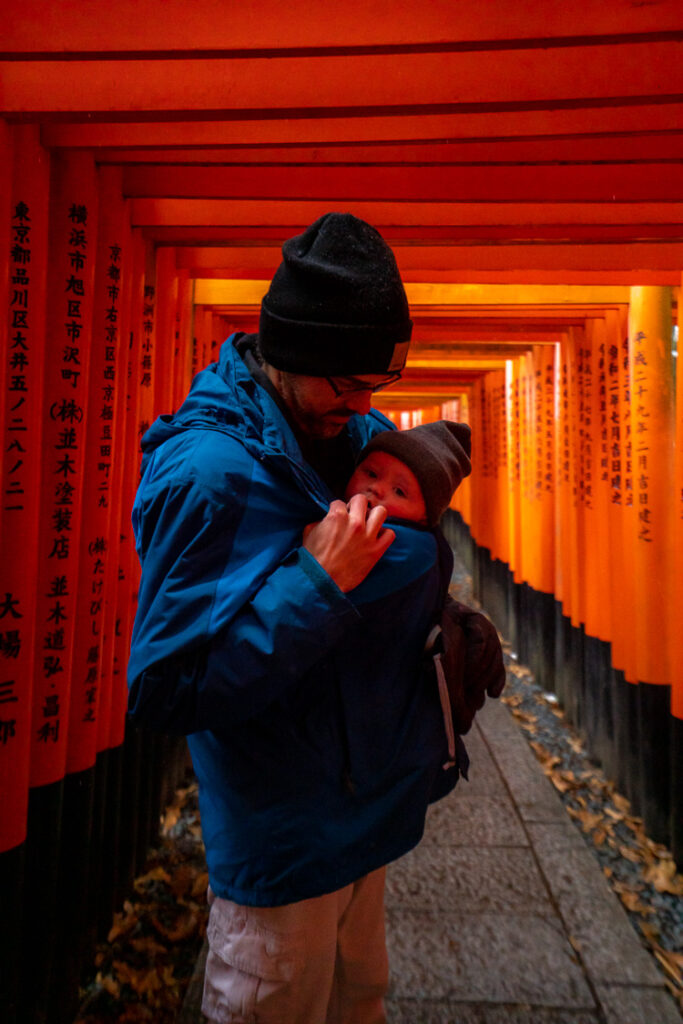
When I was planning our trip, I read mixed reviews from other bloggers of the baby friendliness in Japan. I even received Instagram DMs saying it was the most baby friendly place ever – or not baby friendly at all. So which is it?
I’m happy to say that I was impressed by how family and baby friendly Japan was.
It’s the first country I have traveled to where attendants will usher you to a special family line whether it’s at airport security, check in, or waiting to board. I’ve never had people actually seek us out to help us board like that before.
There were also family/handicap bathrooms everywhere. From train and metro stations to historic folk villages, and more places I really didn’t expect, they were plentiful, clean, and unlike in the US, I never saw a single, able-bodied person walk out of them. People really respected that they were meant for those who actually needed them.
I also saw lactation pods in major transit hubs, and bathroom stalls even had little baby holders!
People were also incredibly friendly and playful with our son. We heard “kawaii!” (cute) all the time. Someone even pulled over on a major city street in Tokyo to tell us that we’d dropped a sock while we were walking on the sidewalk. Can you imagine that happening anywhere else?
We were also given our own private room to dine in at one of the fancier places we stayed – Ubuya near Mt. Fuji. They put two chairs together for a makeshift crib and even brought in toys for Felix when he was fussing. Although we’d heard babies aren’t allowed in some nicer dining establishments in Japan, we never ran into that issue.
Still, I can see why some people struggled. Make sure you do the following when traveling to Japan with your baby.
Pack LIGHT!
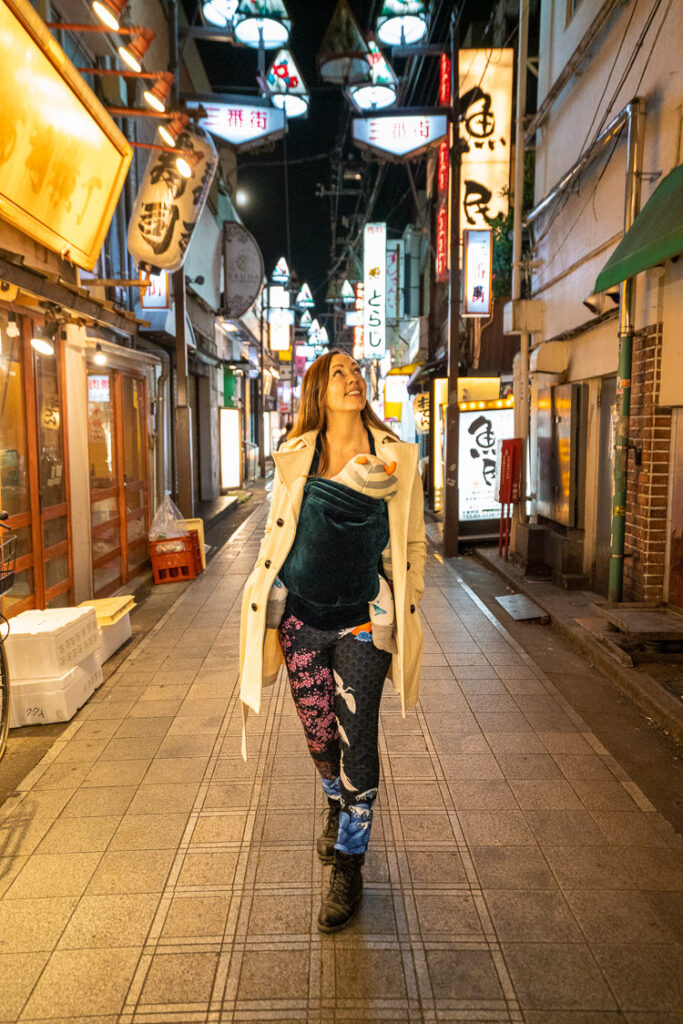
It seemed the biggest struggle people had was with bringing too much.
I understand! It’s easy to do when you have a baby. It seems like the smaller the human, the more things they need.
Between the three of us, we only had one large bag, two backpacks, and one shoulder bag – even in the winter with bigger clothes! Garrett would stack the shoulder bag on the rolling suitcase and wear one backpack during transit while I wore the baby in this front carrier with the diaper bag backpack on my back. This way, we could get through public transport without issue. This is how we pack light with a baby.
Most train stations have elevators and escalators, though you may come across some in Tokyo that don’t. We bought this rolling suitcase/backpack just for this purpose. It’ll come in so handy in Europe as well, where we’ll encounter the same problem.
There were some key things we left out: Half of the diapers for the trip (we bought there), a stroller , car seat , and a baby bed/crib .
There are luggage forwarding services in Japan, but that seemed like more trouble than just packing lighter to me. Still, if you need it, it can be helpful.
Consider Your Transport Plans
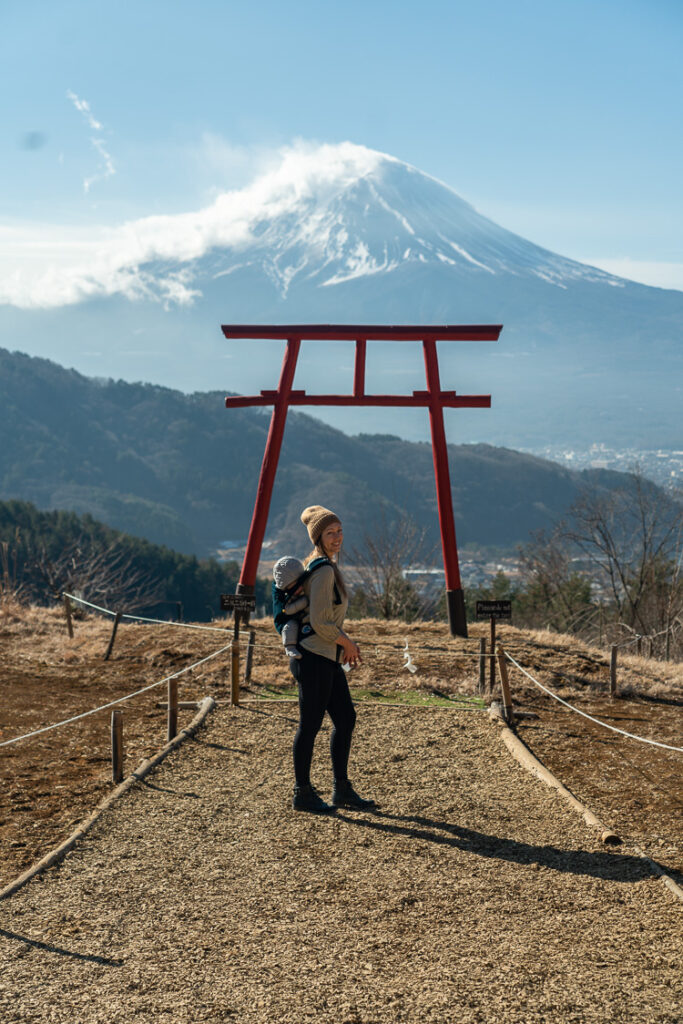
We traveled without a car seat because we were using all trains and buses where they aren’t necessary. The one time we did need to catch a quick taxi, he didn’t mind us having the baby on our laps. That went in contrast to what I had read about Japan’s strict car seat laws. Maybe it’s because we were in a small town?
Regardless, since taxis are crazy expensive in Japan, we didn’t rely on them very often. The one time we took a private transfer to the airport , we reserved a car seat in advance for a few dollars.
The one area where I am still torn is the stroller. There were many times when we were walking down the sidewalk and a stroller would have been great. Our baby is pretty big for his age, so we were hurting from all of the carrying. But there were many times when I thought to myself, I’m so glad we don’t have a stroller to deal with in addition to everything else!
During rush hour, trains in bigger cities can get quite crowded, so you’ll be folding up that stroller anyway.
If I were to do it again, I’m not sure I would do anything differently, although now that my son is older a stroller is a must, and there are plenty that are nice and small!
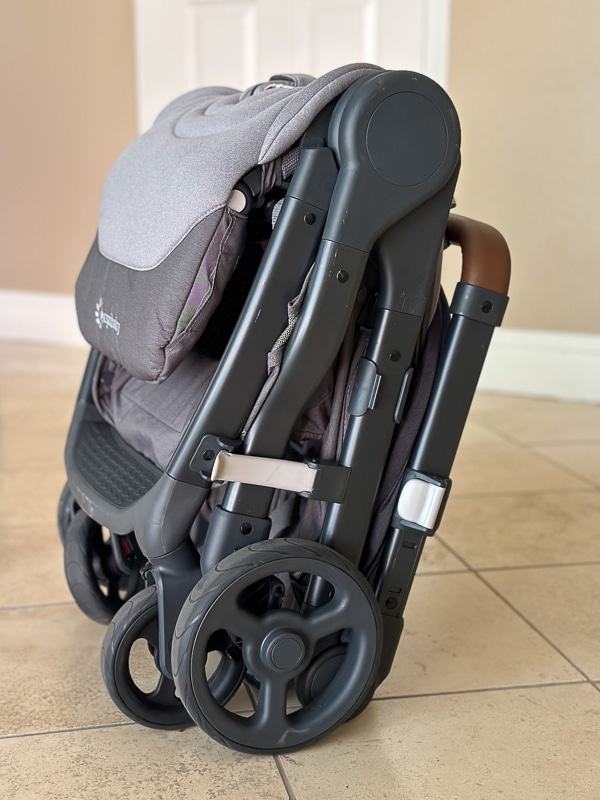
The best strollers that fit in the overhead bin of an airplane
Book the Right Accommodation
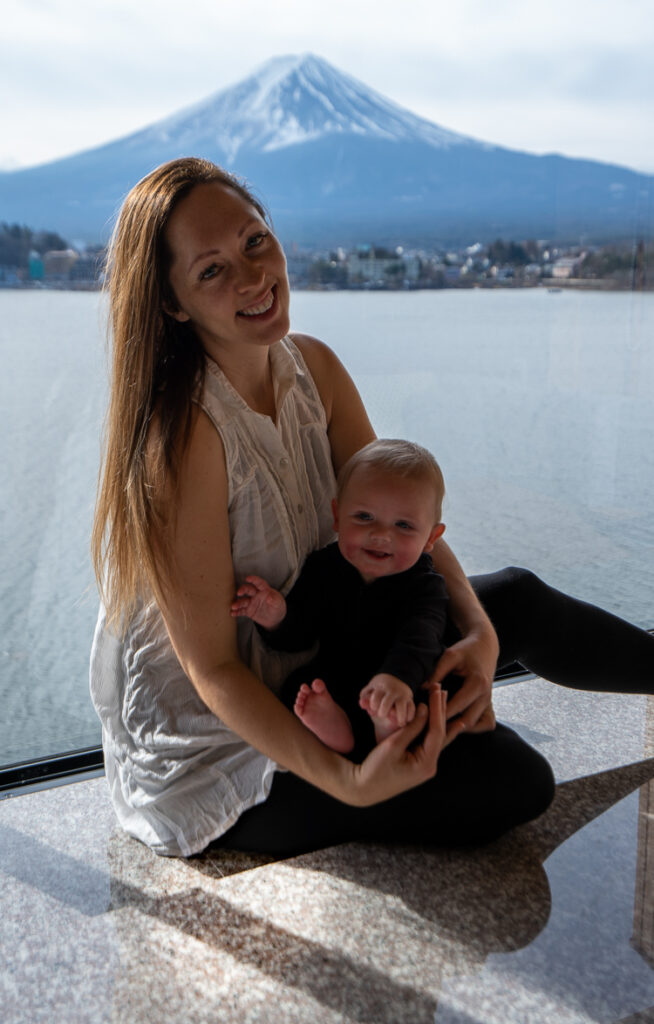
Another area where people ran into issues was with accommodation. It’s true that hotel cribs are difficult to come by in Japan. Affordable hotel rooms can also be quite small, particularly in Tokyo.
I loved using Airbnb for this. We were able to book multi-level apartments in Kyoto and Takayama that cost under $100 per night. Both had floor beds so we had no problem putting Felix on his own mattress and sleeping next to him on our own. He never sleeps quite as well on the road as he does at home, but that would be true regardless of whether we brought a travel bassinet or not.
We did run into a little bit of an issue in Kawaguchiko at Ubuya, which did not have any kind of infant bed despite being a five star, family-friendly hotel. We had to put him between us on two beds pushed together so he wouldn’t roll off. That was the worst sleep of the trip!
In Tokyo, the Prince Gallery Kioicho hotel had a crib for us, which was great.
Buying Baby Products in Japan
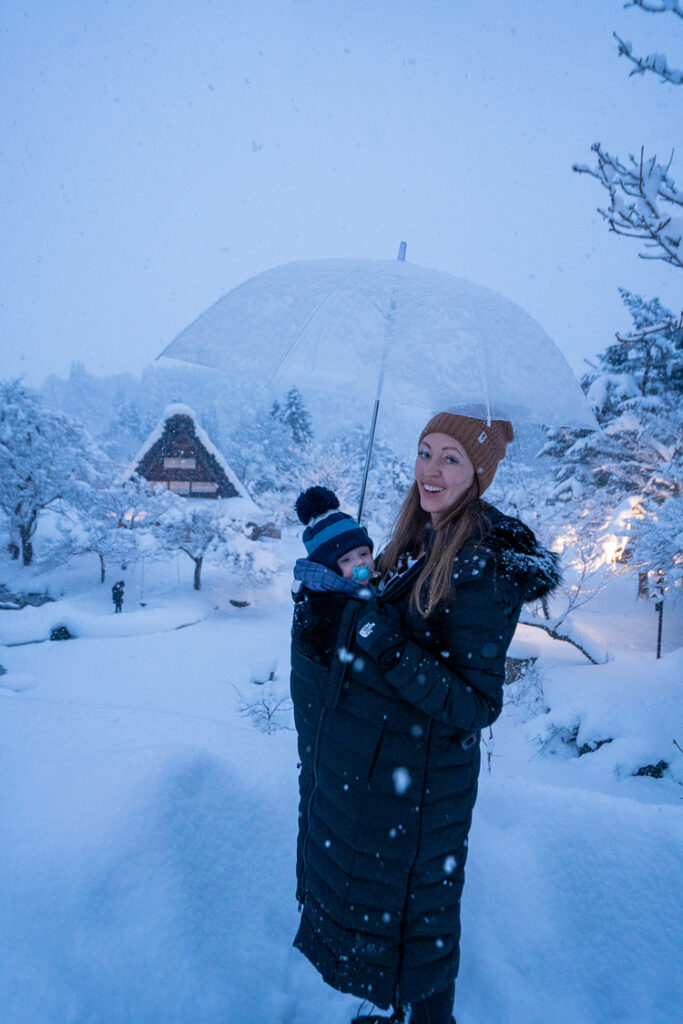
Drugstores are your best bet for buying baby food, formula, diapers, and any other baby-related needs while you are traveling in Japan. Don’t expect to find these things at grocery stores. Matsumoto Kiyoshi (マツモトキヨシ) is the one we came across the most often.
Although you will find a bigger selection in bigger cities, we were able to get the diapers we needed in the smaller town of Takayama. You can easily find the right size as the baby weight in kilos is printed on each package. That said, it may be the brand we bought, which was the only one available, but it just wasn’t as absorbent as the Honest Company ones we use at home, and we had a few pee-throughs.
Since our baby was just turning six months and we mostly do baby-led weaning with him, we mostly fed him a combo of milk I pumped with my wearable pumps and specialized formula we traveled with from home. and bought a few fruits and veggies at grocery stores and fed him at home. I’ve never had such delicious strawberries in my life!
From time to time I’d share any unsalted food I had with him, including some breakfast salmon. I think he was more excited about the chopsticks than the food, which was so fresh and delicious.
Nursing in Japan
Can you publicly nurse in Japan? I never saw anyone do it. My feeling is that it’s not something people openly do there. Since I can’t nurse , I didn’t run into this issue, but I did see lactation pods from time to time. Since the water is clean, pumping on the go and cleaning parts was no problem for me. It’s also common to have hot water kettles in accommodation, which made sanitizing easy.
The family bathrooms are also a great place to nurse since they always had a fold out bench/bed. If it were me, in a pinch, I’d also use a nursing cover.
Overall, Japan was a wonderful place to bring our son for his first ‘big’ international trip. With the right preparation and packing light , we had a blast. You can check out our Japan itinerary here.
*Some links in this post are affiliate links that support us at no extra cost to you when you purchase through them. We only recommend products we love and use ourselves. Your trust always comes first!
Kristin is the founder of Parenthood Adventures, combining her love of travel and newfound joy of motherhood. She's the creator of one of the most-read women's travel blogs in the world, bemytravelmuse.com, with a readership in the millions each year.
Similar Posts
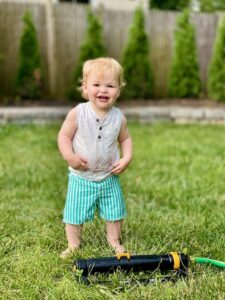
105 Fun Free Things to Do with Kids
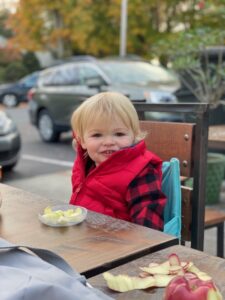
30 Tips for Keeping a Toddler Happy at a Restaurant — Without Screen Time!
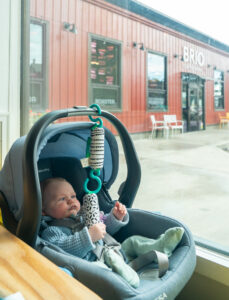
How to Travel with a Baby Without a Car Seat

The 20 Best Car Seat Travel Bags for 2024

Traveling with a Baby in Bali – Everything You Need to Know
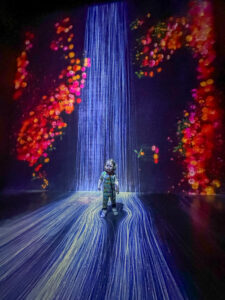
Singapore with a Baby or Toddler – The Ultimate Guide
Leave a reply cancel reply.
Your email address will not be published. Required fields are marked *
Save my name, email, and website in this browser for the next time I comment.
This site uses Akismet to reduce spam. Learn how your comment data is processed .
- Destinations
Wild Junket

Japan with Kids: How to Plan the Perfect Japan Family Trip
Last Updated on March 6, 2024
Japan is a great family travel destination, with its neon streetscapes and kid-friendly amenities. This is my detailed guide to traveling Japan with kids.
There’s nowhere else like Japan. It is ultra modern yet traditional, and highly urbanized yet filled with nature. The multi-faceted country is truly unique in every sense of the word.
I’ve been to Japan three times, and my favorite was definitely the Japan family trip we did with our then 3.5-year-old daughter. It turns out Kaleya is just as crazy about Japan as we are.
Japan is a great destination for kids. T he country is home to psychedelic neon cities, bizarre themed cafes, and ancient towns. The great infrastructure in the country means it’s easy to get around and explore without worrying for your kids’ safety. For those planning to travel Japan with kids, I’m sharing details of our trip to help you plan your Japan family trip.

Table of Contents
How to Get Travel Insurance for Kids
When to travel japan with kids, how long to travel japan with kids, by public transport, language in japan, what to eat in japan with kids, where to eat in japan with kids, traditional ryokan, what you should know about ryokans, modern hotels, our hotel recommendations in japan, go to the robot restaurant , visit the mori digital museum in tokyo, eat at the kawaii monster cafe, try rainbow food in harajuku, go to a hot spring themed park, wander around the omicho market in kanazawa.
- Try on a Kimono in Kyoto
Explore the Arashimaya Bamboo Groves in Kyoto
Feed deers in nara, see the snow monkeys in jigokudani, cost of traveling japan with kids, packing for a trip to japan with kids, final tips for traveling japan with kids, travel resources, japan with kids.
In general, traveling Japan with kids is easy and fun thanks to the great infrastructure and kid-friendly amenities. The whole country is organized, clean and efficient.
Ryokans (traditional Japanese inns) are great places to stay with kids. The tatami rooms have plenty of space for kids to run around. Y ou get to all sleep on futons laid out on the floor, which is a fun experience for kids (though a back-breaking one for adults). Many ryokans have their own onsens (hot springs), which are super fun for both kids and adults alike.
Tokyo is an exception though: Many izakayas (bars) tend to be tiny and not suitable for kids. Most subway stations don’t have elevators, and the Tokyo subway is possibly the deepest underground subway I’ve ever seen. That said, almost everywhere else in Japan is easy and superb for travel with kids.

It’s important to have travel insurance for travel during the pandemic. Safety Wing is the most popular travel insurance company for COVID19-coverage. They cover kids for free as long as you’ve got a plan with them. I use their Nomad Insurance plan , which covers COVID-19 as any other illness as long as it was not contracted before the coverage start date. Refer to my travel insurance guide for more details.

Spring (March-May) and autumn (September-October) are the most popular months to travel Japan due to the mild weather and moderate humidity. Some spots can get overcrowded, especially during the cherry blossom season. Each year, the sakura season varies (usually around April), so make sure you check the predicted dates beforehand.
We traveled to Japan in late September and still found many places quite crowded, particularly Kyoto. During our trip, we experienced mostly warm days of 21-25 deg C, with some rainy days. In the mountainous areas like Takayama and Nagano prefectures, temperatures ranged around 10-15 deg C, but a light jacket was enough.
Winter (December-February) is pretty cold with temperatures dipping to freezing point. But Japan has lots of great ski stations and it’s a good time to see snow monkeys in Nagano.

Japan is a big country and there’s just SO much to see and do, whether your family prefers nature, cities, culture or food. We only had five days on our first trip to Japan and it definitely left us wanting more.
Two weeks in Japan are perfect; though you would probably want to have even more time to see and experience it. In two weeks, we managed to see the best of Japan, but I’ll admit I packed in too much into the itinerary.
If you want to explore Japan off the beaten path , then you would need at least three or four weeks. Tokyo is a must-see; check out my detailed Tokyo itinerary .
Here’s a summary of our Japan itinerary :
- 3 Days in Tokyo — to experience all the wacky fun experiences
- 2 Days in Hakone — with a stay at a hot spring resort and water park
- 2 Days in Okuhida — to experience nature in the Japanese Alps
- 1 Day in Kanazawa — to eat the freshest seafood
- 3 Days in Kyoto — with day trip to Nara to see the deers
- 1 Day in Shibu Onsen — to see snow monkeys in Jigokudani
- 1 Night in Narita — to catch our flight home

How to Get Around Japan with Kids
We chose to rent a car in Japan as we wanted to explore Japan off the beaten path and see more natural sights. It was also a lot more convenient when traveling with our 3.5-year-old daughter who still needs the stroller from time to time.
While the Japanese public transport system has an impressive coverage across the country, there are still some places that are only accessible by car or foot. The quaint villages and mountainous areas that we went, such as Okuhida in the Japanese Alps, happened to be my favorite parts of Japan. I recommend driving the Golden Northward route if you’re looking for a scenic route that brings you off the well-trodden path.
It was surprisingly easy to drive in Japan . Most road signs are in both Japanese and English. We could find our way easily using Google Maps since we had a mobile WiFi dongle. Car rentalin Japan is quite affordable. We booked from Discover Car rental and paid US$565 for our two-week rental of a compact Japanese car and a child seat.
Read all about driving in Japan!

By Intercity Train
Japan is well known for bullet trains (shinkansen) that are ridiculously fast and efficient. I personally think taking a shinkansen is a must-try experience when in Japan! We did it on our first trip to Japan and were blown away. It’s actually faster to travel around Japan by bullet trains than by car. For example, it takes four hours to get from Tokyo to Kyoto by train, but it takes seven hours by car.
If you’re traveling Japan for more than a week, I suggest getting a JR Pass to get unlimited travel on JR transportation (including bullet trains, local trains, buses, monorails and ferries).
A 7-day JR Pass costs around US$265 while a 14-day pass costs US$420. Getting a JR Pass will definitely save you money, as individual trains are super expensive. Kids under 6 travel for free. You can compare individual train prices with the cost of the JR Pass using the handy Japan Rail Pass Calculator .
Get your JR Pass here!

If you’re taking public transport, I’d recommend getting the Pasmo / Suico pass. It’s a prepaid smart card that allows you to use most public transport (metro, trains, buses, monorail) in Japan.
The card also functions as an electronic wallet. You can buy things on trains, in vending machines, convenience stores and restaurants that accept the card. Suica and Pasmo cards can be purchased through ticket machines at any JR stations.
More info here.

English isn’t commonly spoken in Japan. On our first trip to Japan almost 10 years ago, it was quite challenging to travel Japan without any knowledge of Japanese as all signs on the street and public spots were shown only in Japanese.
This time round, we found it much easier as most signs are now in English as well. Japan has definitely become more travel-friendly in the past decade.
Also, free WiFi is easily available in many public places in Japan and you can use Google Translator to translate signs etc. It’s also affordable and convenient to rent pocket WiFi router. We rented our router from GetYourGuide for US$71 that provided us unlimited WiFi for two weeks.

Many people have the misconception that Japanese food is all about raw seafood and sushi. That can’t be far from the truth. The megadiverse cuisine consists of a huge array of food types: from different kinds of noodles to rice bowls, grilled meat to bubbling stews.
EVERY meal we had in Japan was great — even ramen from vending machines tasted amazing. You really can’t get bad food in Japan. My 3.5-year-old daughter, who’s usually a fussy eater, absolutely loved the food in Japan. Her favorites were edamame (steamed peas) and onigiri (triangular rice balls) as well as udon noodles.
Check out my detailed Japanese food guide, including 40 best Japanese dishes to try.

You can find food everywhere in Japan and they’re surprisingly affordable. A meal in a standard sushi restaurant costs around 800-1500 yen per person, not including drinks. Every restaurant/diner provides free iced water or tea with your meal.
There are also entire restaurants devoted to food that looks like characters such as Hello Kitty or Rilakkuma. Other themed restaurants like Kawaii Monster Cafe and Maid Cafe are also great fun for kids.
If you’re on a budget, seek out the vending machines. You can easily get a ramen or katsu rice bowl for around 500-800 yen. Even convenience stores like 7-11, Family Mart, and Lawson’s have cheap and delicious yakitori (meat skewers), onigiri (triangular rice buns) and bento sets.
If your kids aren’t adventurous eaters, there are plenty of fast-food restaurants, western cafes and bakeries in Japan. The convenience stores also stock sandwiches and other food that are familiar to them.

Here are some of the places we ate at and really enjoyed:
Sushi Dai, Tokyo — Located outside the famous Tsukiji Market, this is indisputably one of the best places to enjoy sushi in Tokyo. You’ll get an affordable taste of the freshest and finest seafood for only a fraction of the price of upmarket sushi restaurants. But it’s a tiny place and might not be suitable for those with strollers/babies. Reserve your table here!
Kisoji, Tokyo — Our Japanese friend brought us to this shabu-shabu (hotpot) restaurant and we had some of the best wagyu beef I’ve had. You can book a tatami room and cook the shabu-shabu or sukiyaki yourself. Book a table here.
Sengoku Buyuden, Tokyo — This samurai-themed restaurant is quite an interesting place to celebrate a special occasion. Alberto booked a seven-course dinner here for my birthday and the food was really good. Book your table here.
Sakura Tei, Tokyo — We absolutely loved this restaurant chain that lets you make you own okonomiyaki and monjayaki (pan-fried pancake batter). It’s cheap and casual, and filled with character. Reserve a table here.
Tenka Chaya, Kawaguchiko — While driving around the Mount Fuji area, we chanced upon this gorgeous roadside teahouse and had an amazing meal there. All of its tables are on tatami floor and the menu is traditional hot broth pot.
Kaseidon Ichiba, Kanazawa — Inside the Omichi market, you’ll find the best spots to try fresh sashimi that the city is famous for. This place serves awesome salmon roe, oysters, scallops and outstanding sushi. Read reviews here!
Sakaguchi-Ya, Takayama — Housed in a Samachi traditional building, this restaurant serves the famous Hida beef in the form of handrolled sushi or beef rice bowl. A little pricey but well worth for the quality food and atmosphere! Book a table here.
Hokkyokusei, Kyoto — Right next to Yasaka Shrine is this cute ‘Western’ cafe that specialises in omurice (Japanese omelette rice), which is one of our favorite Japanese dishes. Kid-friendly and good service. See reviews here.

Where to Stay in Japan with Kids
Hotels in Japan get booked up quite fast, especially during the peak period (March to May). I strongly suggest booking early and confirming your hotel stay a few days before arriving in Japan.
Another thing to note is that many hotels don’t seem to respond to emails promptly – even top rated hotels. So you can often wait a day or two for a response to a simple question regarding your accommodations.
One of the experiences I think every visitor must try in Japan is staying in a traditional ryokan. A ryokan is a traditional Japanese inn that usually has tatami flooring, futons as beds, and an onsen (hotspring).
Staying in ryokans gives you the chance to experience how the Japanese traditionally used to live. Plus, they tend to be spacious, which makes it great for families who want to share one room.
Every ryokan provides yukata (simple Japanese robe) for you to wear to the onsen or as pyjamas. In hot spring towns like Shibu Onsen, you can even wear the yukata out to town. Read about our stay at the best ryokan in Hakone .

However, there are some things you need to know about staying in a ryokan. Firstly, ryokans tend to be the same price or even pricier than modern three-star hotels in Japan. We paid an average of around $80-120 per night for a room.
Secondly, you sleep on thin mattresses or futons that are laid out on the tatami floor. We found it quite hard to sleep at first and had backaches after our second night. (I know we sound so spoiled!).
One of the ryokans we stayed at had such bad soundproofing walls that we were kept up all night because of noisy neighbors. It felt like we were staying at a hostel despite the high price we paid.
So take my advice, book just 1-3 nights at a ryokan (instead of 7 nights like we did!).

Recently there was a government crackdown on the use of residential accommodation as Airbnb in Japan. As a result, all hosts must be issued with a permit to offer Airbnb services. This has seen many travellers left without accommodation when their Airbnb was cancelled.
There are several modern hotel chains in Japan that are affordable and have quality facilities. APA Hotels and UNIZO have branches all over Japan and great locations. However, most of these have tiny rooms where you’ll barely have space to walk.
I suggest paying more and booking twin rooms or family rooms if you want to be a bit more comfortable. The APA Hotel we stayed in Tokyo even had an onsen and a rooftop outdoor pool
We wanted to try the capsule hotels, but they turned out to be more expensive than budget hotel rooms (as we would have to pay $30 per capsule and get three capsules). Plus the capsules are divided between men and women, so Alberto would have to be separated from us.

Here are the places that we stayed at and can recommend to family travelers:
APA Hotel Tokyo Nishishinjuku, Tokyo — A modern three-star hotel centrally located in Shinjuku and steps from a subway station. Good quality facilities, including an onsen (hot spring) and rooftop swimming pool. The small double room is tiny; opt for a twin or family room instead. Check latest rates here.
Hakone Kowakien Tenyu, Hakone — Opened in April 2017, this spectacular five-star hot spring resort is a worthwhile destination on its own. Read my detailed review of the hotel here ! All of its rooms have tatami flooring, open-air stone bath and mountain views. The hotel also has an attached hot spring themed park that’s perfect for kids. Check the latest rates here.
Fujino Kirameki Fujigotemba, Gotemba — Possibly the most family friendly hotel we stayed at in Japan, this glamping site has beautifully furnished cabins transformed from cargo containers and huge play areas for families to hang out. Best of all, it has a gorgeous setting high up above Gotemba, with Mount Fuji in the backdrop and a thick cypress tree forests surrounding it. Book here!
Konji Ryokan, Gifu prefecture — Located in the Okuhida hot spring villages, this traditional ryokan is located in the Japanese Alps and close to hiking trails. Sadly it rained the whole time we were there and the nearby Shin-Hotaka Ropeway was closed. Still a gorgeous area to visit. It’s a 1-hour drive to Takayama from here. Book here!
Kaneki Hotel, Shibu Onsen — This ryokan in the village of Shibu Onsen is clean, cute and affordable. It has a nice and brand new private onsen which you can use for your own (which we really appreciate as most other hotels don’t have that). You’ll also get a key to enter the nine onsens that the village is famous for. It’s the nearest village to the Jigokudani Snow Monkeys Park. Check the latest rates here.
Search for Japan hotels here!

Best Things to Do in Japan with Kids
There’s no shortage of things to do in Japan with kids. You can choose from themed cafes, unique museums, cultural experiences and excursions, but these are best booked in advance before your trip to avoid disappointment.
There are also lots of free things to do, for instance most temples in Japan are free to visit. Here are some of our favorite things to do in Japan with kids:
This over-the-top entertainment show is great fun, and kids under three go for free. Take note that it can be very loud and bright for young kids, though they provide noise-cancelling headphones.
Our daughter really enjoyed the crazy show. Note that it’s more of a show than restaurant. You do need to book your tickets in advance (they’re cheaper online as well) as they can sell out.
Book Your Tickets here!

Definitely make some time in your Tokyo itinerary to visit this museum! The newly opened museum is hugely popular thanks to social media, so book your tickets way in advance. In a huge three-dimensional 10,000 square meter space, artworks created by computers move in and out of the rooms freely, creating magical formations.
Personally, the MORI Digital Museum is a MUST-see in my opinion and particularly interesting for kids. There are several areas designated to babies and young kids and lots of interactive artworks for adults. but be prepared to wait in line even if you have tickets (we only waited for 30 minutes to enter). Read reviews and tips here!

Bright, whimsical and bizarre, the Kawaii Monster Cafe is a themed cafe is definitely designed for kids. Besides its psychedelic interiors, the food here also comes in rainbow colors.
There’s an entry fee of 500 yen (US$4.40) and you have to order at least 1 food and 1 drink per person. We ended up spending around $40 here for the 3 of us, twice of what we usually spend. In my opinion, it’s way overpriced and only suitable for young kids. Book your table here!

Harajuku is Tokyo’s wacky playground for those who love alternative stuff. There are lots of cartoon comic stores, cutesy boutiques and big-chain lifestyle shops here. Best of all, it’s home to Tokyo’s most innovative foodie experiences.
We highly recommend trying the rainbow-colored cotton candy at Totti Cotton Factory, and rainbow grilled cheese sandwich at the nearby Le Shinier. Kids (and adults) go crazy over these things!
Sign up for a Harajuku Tour!

Yunessen hot spring park in Hakone is not just any typical water park: here you can dip in pools with wine, sake, coffee and tea. It’s a lot of fun for both kids and adults alike. All the pools are fed with natural hot spring water, so they stay warm even in winter.
Tickets are quite cheap and you can easily spend a whole day here. Entry tickets cost 2900 yen (US$3.30) per adult and 1600 yen (US$1.80) per child. Reserve your ticket here.

Kanazawa is best known for its fresh seafood and out-of-this-world sashimi. The Omicho Market is an excellent spot to bring the family and get a good introduction to Kanazawa’s seafood. You’ll see huge Japanese crabs here as well as larger-than-life oysters, shrimps and sea urchin.
If your kids are adventurous eaters, see if they want to taste some! It costs around 600 yen ($5) to try an oyster or two big shrimps. There are also some interesting things to try like blue beer and gold-leaf icecream!

Try on a Kimono in Kyoto
What an experience it was to try on the Japanese national costume! We got to see the complicated process of putting it on and then experienced wearing it all over Kyoto. Even Kaleya loved putting on the kimono.
To capture the special moment, we even booked a photography session with Flytographer . The results turned out great and we now have gorgeous family shots.
If you’re interested in booking a photography session, use this link and the code “NELLIEHUANG” to get US$25 credits. You can also combine your kimono rental with a tea ceremony to have a full cultural experience.
Book your kimono rental here!

In the outskirts of Kyoto, you can find beautiful bamboo forests as well as large gardens and hiking trails in and around the Katsuragawa River. The Path of Bamboos is packed with tourists these days, but it’s still a beautiful area to visit especially for families.
You can even hire a rickshaw to bring you around parts of the bamboo groves that are exclusive to rickshaw riders. More info here.

Nara park is home to hundreds of freely roaming deer. Considered in Shinto to be messengers of the gods, Nara’s nearly 1200 deer have become a symbol of the city.
Deer crackers are for sale around the park, and some deer have learned to bow to visitors to ask to be fed. The park is big and dotted with temples, shrines and lots of greenery.

The Jigokudani Snow Monkey Park is best visited in winter when the Japanese macaques are often seen dipping in the hot springs. However, the monkeys are fed by park staff, so they do hang out in the park year round.
Even if the monkeys don’t interest you, the area is worth visiting for a chance to hike and experience Japan’s nature. Read more about it here.
The nearest town, Shibu Onsen, is a cute hot spring village that I highly recommend visiting. If you stay at one of their associated ryokans, you’ll get a key to enter all of the 9 onsens in the village for free. These are not scenic onsens, but are rather public baths that villagers use for their daily baths.

Let’s face it, Japan IS expensive (especially if you want to do all kinds of activities) but it’s still affordable compared to the US or Western Europe.
The cheapest way to travel Japan with kids is to use local transport and book budget hotels. Transport was the biggest cost for us and we spent around US$1050 on our car rental, toll fees, parking and gas.
You might spend less if you opt for the JR Pass — remember kids under 6 travel for free and kids aged 6 to 11 enjoy half price on the JR transportation.
As for accommodation, expect to pay at least US$65 per night for a tiny 3-star hotel room and around $100 for a traditional ryokan room . Accommodation in small towns (e.g. Shibu Onsen and Kanazawa) tend to be cheaper. Hostels and capsule hotels are around the same price for families as you’ll be paying around $20-35 per person.
Activities can add up too if you’re planning to book experiences like the Robot Restaurant and sushi-making classes.
Here is a breakdown of our expenses in USD (not including airfare):
Transport: $1050
Accommodation: $1400
WiFi rental: $100
Miscellaneous: $200
Activities:
- Robot Restaurant: $64 x 2
- Harajuku Owl Cafe: $5 x 2
- MORI Digital Art Museum entrance: $28.25 x 2
- Kimono rental: $100
- Kawaii Monster Cafe: $40
- Yunessun hot spring themed park: $10
TOTAL: $3600

The biggest tip I have for those traveling Japan with kids is to pack as light as possible . Japan is very urbanized and you’ll probably be doing lots of walking, using public transport and moving between places. Packing lightly will make getting around easier, especially with kids.
Most cities in Japan are busy and crowded. The subway is often packed and commuters are in a rush. It can be a challenge walking around with a toddler who can’t keep up with the pace. Decide if a stroller is useful as it can be a pain getting strollers in and out of the subway and along busy walkways.
On this two-week trip in Japan , we traveled with just our day-packs, Kaleya’s Pockit lightweight stroller and our Eagle Creek Gear Warrior 32 wheeled suitcase .
Since it was September and the weather was still warm, I packed mostly t-shirts, thin pants, dresses, and leggings. I also had a cardigan and a thin leather jacket for the chilly days. For Kaleya, it was the same — mostly long-sleeved tshirts, a few dresses and skinny jeans.
Be sure to pack comfortable walking shoes as you’ll be walking quite a lot. As it gets quite rainy in autumn, we only packed waterproof jackets for us and a raincoat and rain boots for Kaleya.

The first thing you’ll notice when arriving in Japan is that the Japanese are incredibly polite and respectful. They don’t expect foreigners to follow their etiquette, but they do appreciate it when you make some effort and blend in.
Here are some important things for families to keep in mind:
- The Japanese bow a lot to show their gratitude. You don’t need to do the same if you’re uncomfortable with that. Make sure to learn some basic Japanese words and express some courtesy. “Thank you” is one word you’ll hear a lot: “Arigatō gozaimash ta”. “Hello” is “Kon’nichiwa” and “Excuse me” is “Sumimasen”.
- Japanese toilets are the coolest — both kids and adults are sure to be amused by them! There are plenty of buttons on the side of the toilet, each with a different function (heating, drying, washing etc). However, some places still have the squat toilet (hole in the ground), so get your kids prepared for that.
- Kids would love the fact that it is customary to slurp noodles loudly in Japan to show that you’re enjoying it. My daughter completely embraced it and had slurping competitions with us!

- Keep in mind that placing chopsticks upright in your food, crossing them or passing food with them are what people do at funerals. Just place your chopsticks on the side of your plate when you are not using them.
- Breastfeeding is generally not done in public, though you can find a quiet corner and use a shawl to cover. Many department stores have nursing rooms as well as spacious baby-changing facilities where you can breastfeed in private if you prefer.
- Remember to bring any medication that your child takes regularly (or may need), as Japanese pharmacies don’t sell foreign medications.
- Always remove shoes when entering a private home, temple or traditional ryokan. Some restaurants with tatami mat seating also require you to remove your shoes and use their slippers. Note that they have different slippers for bathroom use, so make sure not to confuse them.

- Japan runs mostly on credit cards, but some places don’t take international cards. It’s best to have some Japanese yen at hand at all times. Many ATMs don’t take international cards either — the best places to withdraw cash are the 7-11 stores.
- There is no tipping in Japan, though of course you’re free to give some spare cash if you want to show your appreciation for their good service.
- No eating, drinking or talking on the cell phone in the train or subway. The Japanese are very considerate to other people, so please try to do the same.
- Always stand on the right side of the escalators.
- It’s extremely rude to blow your nose in public. Try to do that in the toilet.
- Don’t be surprised to see many people walking around with hygienic masks. People who have a cold or illness often wear these to prevent spreading their germs.

Phew! That’s it from me for now. Thanks for reading all the way to the end.
On an ending note, I’d like to remind you not to plan too much when traveling Japan with kids. Because there’s SO much to do, many people end up trying to pack too many places into their itinerary. We made the same mistake and definitely wished we weren’t so ambitious in seeing so many places.
Keep in mind that you’re there to have fun and explore, so slow down and enjoy the beautiful country with your family in a relaxing pace! I hope this guide has been useful. Feel free to leave me any questions or comments you may have below.
Disclaimer: This post contains affiliate links to companies I use and trust. I get a small commission when you click on my links, at NO EXTRA COST TO YOU.
Over the years (and traveling to 140+ countries), I’ve learned a thing or two about travel planning. I’ve put together this list of travel resources that I personally use to find the best deals and book travel! For more details, check out my travel tips resource page .
- Booking Flights : Kayak is brilliant for finding the best dates to fly as it allows you to search for the lowest airfares within a 3-day period. Then I use Skyscanner as they’ve consistently given me the lowest airfares.
- Accommodations: I always use Booking.com to book hotels, mainly because of the flexible cancellation policy and good customer service. You can also find short-term rental apartments there (I prefer not to use Airbnb due to the extra charges).
- Travel Insurance: It’s important to have travel insurance, regardless of whether you’re traveling for a few days or months. Safety Wing is the most popular travel insurance company for COVID19-coverage. I use their Nomad Insurance plan , which covers any healthcare expenses I may have worldwide. Refer to my travel insurance guide for more details.
- Health Advice: I always refer to the travel guides on the CDC website for recommended medications and vaccines. You can get them at your travel doctor’s office or a walk-in pharmacy.
- Tours: If you’re looking for all-encompassing tours, I recommend small-group adventure tour outfitter, G Adventures . I’ve traveled with them to Antarctica, Mongolia, Svalbard, and Nepal, and loved every single trip. For day tours, I always book with Viator and GetYourGuide ; they have easy booking systems and free cancellations.
- Car Rental: I always book car rentals on Discover Cars , as they’ve consistently given us the best rates and customer service (with free cancellations). We’ve used them in Seychelles, South Africa, Spain, Peru, and Mexico.
- Transportation : Whenever possible, I book local transportation online using Bookaway and Busbud . They’re more reliable than many local transport websites and cover trains, buses, and car hire.
- Restaurants: TripAdvisor is my go-to resource for restaurant reviews and bookings. I also make restaurant reservations on OpenTable .
- Travel WiFi: I always travel with my Travel WiFi Sapphire 2 device; it’s the most convenient way to get internet data on the go. Instead of getting a local SIM card in every country I travel, I get an internet data package online and the device works immediately when I land.
Nellie Huang
Nellie Huang is the founder of WildJunket. Originally from Singapore, Nellie has traveled to over 140 countries across 7 continents. As an adventure travel blogger, she has a special interest in unusual destinations and deep experiences. Her work has appeared in many major publications including BBC Travel, CNN and LonelyPlanet.com. Read more about her here and get more life updates from her on her Facebook and Instagram .
Leave a Comment Cancel Comment
Save my name, email, and website in this browser for the next time I comment.
This site uses Akismet to reduce spam. Learn how your comment data is processed .
The Comments
the Curious Pixie
Absolutely loved this guide. It’s my dream trip to go to Japan with kids. I am a veggie, so the food situation slightly concerns me, but not enough to put me off going.
Thank you! I have a vegan friend who just went to Japan, who said she managed to get by. But I met a vegetarian in Japan and he said he struggled to find things that were suitable for him. So I guess it depends on individuals as well.
madhu sharma
Wow it’s great to know that Japan is kids friendly.i also have 3.5 year old son.n this guide is really helpful
hi Madhu, glad you found it useful! :)
I’d love to go to Japan with my daughter one day. Thanks for the inspiring post!
This is a great guide for adults as well as kids. Or for the kid in all of us. Your final tips are also really helpful.
This is a really helpful guide! I just got back from Japan and stayed 3 weeks, and I rushed it, too. I would agree that it’s important to go at a slower pace and spend more time in Kyoto and Tokyo. It sounds like you had a great time!
Thank you so much !!! ? So helpful and detailed !! All your advices are great, can’t wait to go there with my son and husband !
Malvika Vithani
This was such a detailed guide – thank you! I actually don’t have kids but all the activities still sound amazing. :)
Lesia Joukova
I love reading Japan guides so much. I also think family guides really work out well for me because I’m such a kid that I would totally go to a themed hot springs park and a robot show! Thank you for sharing, really-really loved this post!
hi Lesia, thanks for the kind comment! Glad you like the post!!
Muy bonito reportaje Nellie
Hi – great blog post! I do have 2 kids – 6 & 2 so this definitely helps a ton in planning as most vlogs on youtube chronicle singles or couples with no kids.
Similar to the other commentor above – we are also a family of vegetarians. So it’ll be our added challenge. But at the same time kids do need to know there is a whole world that surrounds us – not just where we live. You have definitely given us enough tips & activities to consider. Thank you for being so detailed!
Carla Hookway
Thanks for posting this – very informative, helpful & interesting – it’s inspired my want to travel to Japan even more!
You are welcome and hope you enjoy Japan with your kids!
Really enjoyed your blog. Planning to do a trip with a 10 and 8 year old probably this November and appreciate all the tips!
Thank you so much Gary! Let me know if you have any questions at all and I’m happy to help if I can!
Wonderful review of your trip to Japan, very useful tips. Thanks for sharing all the detailed information. Can’t wait for us to book our trip.
Pamela Robinson
Love this!! I’ll be following your blog from now on. This is such a helpful guide!!
This is great, we’re going to japan with two toddlers in march and im following your itinerary. Did you Book a JR railpass on this visit or just drive it all? I’m contemplating just driving but not sure about getting into tokyo that way?
hey Laura, good to hear you’re following my itinerary! We drove the whole time, though I used a JR pass on my first trip. During our time in Tokyo, we used a combination of the local subway and our car rental. The subway was useful for busy areas like Shinjuku but we found the car to be useful to go to areas that were further out, like Akihabara, the Tsukiji fish market, and the interactive museum. It can be exhausting walking and taking the subway all day, especially for young kids. Driving in Tokyo wasn’t too stressful, but parking can be expensive (around $10-20 a day) and there are tolls in some parts of the city. It was really relaxing and fun to drive though, especially in the mountains. The car hire companies are so good at explaining everything when you’re picking up the car, and they make sure you’ll clear about the rules and how things work.
Thank you Nellie, this was really helpful. We can’t wait! Definitely want to check out the interactive museum too. I’m actually really relieved to be driving. I couldn’t imagine how stressful dragging two toddlers through the busy subways would be!
we will be going to Japan end of March. We want to take our three kids but are unsure since we’ve never been. They will be 6 months. 3 and 4 years old. In your opinion will three under 5 be too challenging for a first time trip to Japan? We travel state side frequently but this will be our first international with them.
Hey Ariel, I don’t think there’s ever the ‘best’ time to travel with kids. So yes, I encourage you to travel Japan with your kids! Japan is honestly fantastic for kids of all ages – the bright lights, animation characters, interesting food will all make your kids go wow! Plus the infrastructure is great and you can easily get around on public transport. To make things easier, I would recommend going slower so you won’t feel too stressed up and the kids get to enjoy and play more rather than moving around. I recommend spending 5 days in Tokyo and 5 days in Kyoto. That way, you can take your time to see and experience things. We rented a car to make moving around easier and to explore the mountains. So perhaps you can consider that too. It is slightly more expensive than taking the train because of the tolls and parking fees.
Such a great guide! I’m in the beginning stages of planning and this helped alot! Thank you!
Aww thank you! I’m really glad you find this useful. :)
Helen Wearmouth
This has been a fantastic post to read, very informative. Thank you very much. We are considering Okinawa, have you been? If so would you recommend it? Many thanks in advance.
hi Helen, oh we haven’t been to Okinawa but I’ve always wanted to go!
You May Also Like
Visiting inle lake in myanmar, why travel with a baby, laos with kids: my detailed guide to planning a laos family trip.
The Ultimate (and detailed) 3 Week Japan Itinerary with Kids
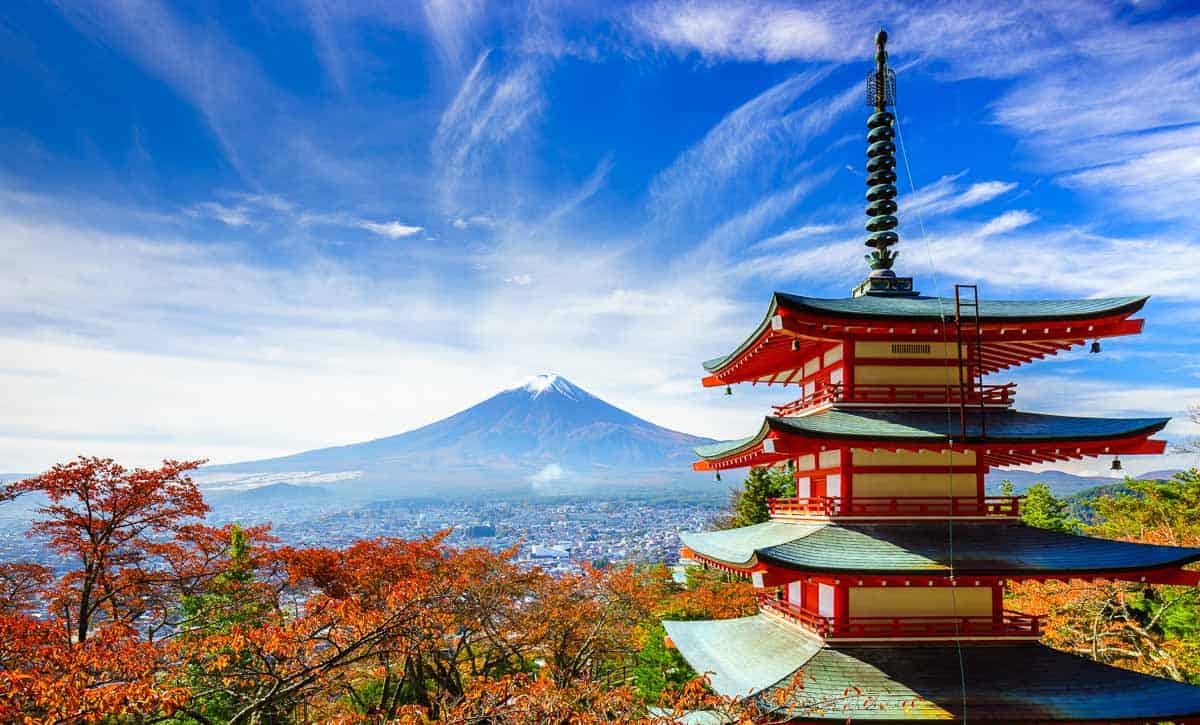
We recently returned from a wonderful 3 week Japan family holiday, it was our first time and we all just loved it! We spent hours and hours working on the perfect 3 week Japan itinerary as we wanted to see and do as much as we possibly could.
Putting together a Japan itinerary with kids is no easy task. For one, there is a huge list of awesome things to do in Japan with kids , so trying to work out what to do and where to go in Japan with kids is a bit tricky. Also just trying to figure out which cities to visit, which order to visit them in, how to get between cities, how long to stay in each, which hotel to stay at and not to mention putting together a budget is extremely time-consuming!
If you’re travelling to Japan with kids soon and in the process of planning your own Japan travel itinerary, you’re going to find this guide super helpful. I have a lot of Japan content to come, but in the meantime, I wanted to start by sharing with you our detailed Japan 3 week itinerary so you might use it when preparing your own Japan trip itinerary.
We also travelled with friends who spent two weeks in Japan, so I’m also going to share with you their 2-week Japan itinerary in case that’s helpful too. Or check out this one week Japan itinerary .
So in this post, I’m going to tell you exactly where we stayed, what we did, how we got around attractions and between cities. I will also tell you exactly where we purchased things to make it super simple for you. Hopefully, you can use this information to assist in your own Japan travel with kids planning and benefit from the crazy number of hours it took me to put together our Japan 3-week itinerary.
So let’s get into it, the finer details of our 21 day Japan itinerary.
Talk to other families about their tips on visiting Japan and join our Thrifty Family Travel Facebook Group or be inspired on our Thrifty Family Travel Instagram Feed .
This post may contain compensated links. Please refer to my disclaimer here for more information.
Page Contents
- 1.1.1 Plan your Japan Travel Itinerary
- 1.1.2 Pre Purchase Attractions Via Klook
- 1.1.3 Stay Connected with eSim or Pocket Wifi
- 1.1.4 eSim by Frewie
- 1.1.5 Pocket WiFi
- 1.1.6 Download APPs
- 1.2.1 Pick Up Pocket WiFi
- 1.2.2 Bus from Narita to Hotel
- 1.2.3 Tokyo Accommodation
- 1.3.1 Buying Public Transport cards
- 1.3.2 Tokyo Metropolitan Government Building
- 1.3.3 Puroland (Hello Kitty Land)
- 1.4.1 Fukagawa Edo Museum
- 1.4.2 Asakusa
- 1.4.3 Shibuya
- 1.4.4 Piss Alley (Omoide Yokocho)
- 1.5.1 Mori Digital Art Museum/ teamLab Borderless
- 1.5.2 Miraikan National Museum
- 1.5.3 Odaiba Statue of Liberty
- 1.6.1 HARRY Hedgehog Café
- 1.6.2 Takeshita-dori Street
- 1.7 Day 6: Disneysea
- 1.8.1 Hakone Free Pass
- 1.9.1 Cruise on Lake Ashi
- 1.9.2 Checkpoint Museum
- 1.9.3 Mishima Skywalk
- 1.9.4 Hakone Kowakien Yunessun
- 1.10.1 Hakone Open-Air Museum
- 1.10.2 Travel from Hakone to Nagoya
- 1.11 Day 10: Legoland
- 1.12.1 Kyoto Accommodation
- 1.13.1 Fushimi Inari Shrine
- 1.13.2 Kinkaku-Ji Temple
- 1.13.3 Nishiki Markets
- 1.13.4 Pontocho Alley
- 1.14.1 Nijo Castle
- 1.14.2 Arashiyama
- 1.14.3 Maiko Dance
- 1.15.1 Kiyomizu-dera Temple
- 1.15.2 Gion District
- 1.15.3 Kodai-ji Temple
- 1.15.4 Ryozen Kannon Statute
- 1.16.1 Nara Deer Park
- 1.16.2 Osaka Accommodation
- 1.16.3 Dontonbori
- 1.17 Day 16: Universal Studios
- 1.18.1 Cup Noodles Museum
- 1.18.2 Kids Plaza
- 1.18.3 Travel to Hiroshima
- 1.19 Day 18: Day Trip to Miyajima Island
- 1.20.1 Hiroshima Peace Memorial Museum
- 1.20.2 Hiroshima Peace Memorial Park
- 1.20.3 Travel to Tokyo and Fly Home
- 2 Final Verdict
3 Week Japan Itinerary with Kids
I’ve done this as a Japan day by day itinerary, so if you like, you can do exactly what we did. Or you can just make changes here and there to fit your individual preferences.
This post is brief in detail about the attractions we visited; I have only provided the necessary information. Full details of all the attractions we visited and additional attractions to consider will be provided in future posts – stay tuned. The purpose of this post is to simply provide you with a Japan sample itinerary to work from, or you can just follow this day by day.
Pre-Trip Tips
Here are my tips on what to do before you jet set off on Japan family holidays:
Plan your Japan Travel Itinerary
Before leaving for our trip, we had our Japan trip itinerary fully planned out. There is a lot to see in Japan, and so by planning out our itinerary beforehand, we were able to ensure we made the most of our time while in Japan. Honestly, pretty much every day in Japan was jammed packed with activities.
Pre Purchase Attractions Via Klook
Where possible, we purchased tickets to attractions beforehand. Most tickets were purchased through Klook, which is absolutely fantastic as 9 times out of 10, we saved a stack of money. Below where I mention each attraction we visited – I will link to where we purchased our tickets so you can too if you like or click here to see what Japan attractions Klook covers.
Stay Connected with eSim or Pocket Wifi
We like to have access to the internet – it is an absolute must when you’re travelling with kids in Japan. We pretty much lived on Google Maps to get around the city as well as navigating the trains.
It’s also great for things like using social media, and if you travel Japan with kids, it’s great to let the little ones play games and stream Netflix when you’re on the long train rides between cities.
We’d like to share two great ways to stay online – the Pocket Wifi or an eSim. They are both slightly different in the way they operate. I will explain the pros and cons so you can decide which might be best for your trip.
eSim by Frewie
One of the main benefits of the eSim is that it is sent via email immediately, so it should be almost instant.
You can purchase an eSim for a duration of 5, 8, 15 or 30 days. The more days you purchase, the better value the eSim.
Your next choice is whether to go for 500MB, 1GB or unlimited data. If you choose unlimited data you can then choose whether to get the first 5GB, 8GB, 15GBb or 30GB as high speed.
Each option alters the price, so it’s worth checking each option to see what works best for you and your family. On the subject of family, although the eSim will be installed on your phone (or whoever deals with the tech in your family!), you will still be able to share your hotspot so additional family members can connect to the internet through you.
The eSim needs to be activated within 45 days of receiving the eSIM QR email. Do check the small print as the eSim will not work with all models.
The main benefit of an eSim rather than Pocket Wifi is there is no extra equipment to carry with you. You don’t need to remember to pick it up in the airport and you don’t need to return it afterwards.
You can purchase an eSim from Klook here.
Pocket WiFi
Pocket WiFi is a device that you carry with you to connect to the internet. With the pocket WiFi you pick it up from the airport when you arrive and drop it back off at the airport when you head home – easy!
You can choose unlimited data with the first 3GB, 5GB or 10GB being high-speed, per day. Unlike the eSim which has a minimum duration of five days you can pay for just one day with the Pocket WiFi.
The main disadvantage of choosing the Pocket WiFi over the eSim is the maximum number of connected devices is five at a time. Using an eSim hotspot you can most likely share with up to ten other users (depending on your handset). The Pocket WiFi limit is only an issue if you need to share with six people or more simultaneously though.
If you decide to go with Pocket WiFi, it’s a good idea to insure it as you will be liable for loss, damage and breakage. You can pay extra to insure it at the time of purchase to give you that protection.
You can purchase pocket WiFi from Klook here.
Download APPs
So as I mentioned we used Google Maps all the time. Google Maps is awesome for working your way around the trains as it will tell you which entry/exit to use as well as which platform. Honestly, this was pretty much the only app I used for getting around Japan – definitely ensure you have it downloaded before your trip.
The other App you want to download is SmartEX App – we used this to book all our Shinkansen trains. The APP is great because you can see exactly how much each train is and what seats are available. For the most part, we just booked trains the day before or sometimes the same day – but just keep an eye on how busy the trains are to avoid not getting tickets on the train of your choice.
You will still need to pick up your tickets at the train station – either from the ticket machines or by going inside a ticket office. You can of course just book tickets when you arrive at the station, but we have heard of trains getting full and so we didn’t want to risk this.
There is also the option of purchasing the JR pass – whether or not the JR pass is worth it for you will depend upon your individual travel plans – for us it wasn’t. There are a couple of JR passes to look at, you can check them out here.
Day 1: Fly to Tokyo

Click here for our full guide on Tokyo with kids.
We live in Brisbane; yet flew from Gold Coast as we landed ourselves one of those cheap Jetstar fares where you get the return flight for free. All up for the 3 of us, we paid $945 AUD, which is pretty amazing! JetStar has these deals a few times a year, so be sure to sign up to their newsletter and Facebook page to be notified of when they have a deal on. Otherwise, if you’re from somewhere else in the world, just check Skyscanner for flights.
Pick Up Pocket WiFi
As mentioned above, a few weeks before our trip we had arranged pocket WiFi, which we picked up at the airport. We did have to go to a different terminal from where we arrived – but we found this really easy as everything is well signposted in Japan – so don’t stress. And everything is also in English too.
Bus from Narita to Hotel
Before our trip, we had also purchased tickets for the Limousine Bus, which takes you from the airport into Tokyo. We bought our tickets through Klook. Through Klook, tickets are cheaper at 3100 Yen ($34.99 AUD) per adult and 1550 Yen ($17.49 AUD) per child as opposed to 4000 Yen ($43.50 AUD) per adult and 2000 Yen ($21.75 AUD) per child. Click here if you want to book discounted tickets via Klook .
However please note that the bus doesn’t take you to your hotel, just a central point in the city, so from there we took an Uber to our hotel. So if you haven’t got it downloaded already be sure to download the Uber App. Uber is great for getting around if you don’t speak Japanese because your driver can see where you are going via the App.
The Limousine Bus isn’t cheap though, and I think next time I will just take the train to the city centre as I found it pretty easy to navigate my way around. If you want to do this option, it’s best to arrange your train card beforehand – see more about transport cards in day 2 below.
However some people get nervous about the bus when visiting Japan with kids and so arrange private transfers. Private transfers through Klook are around 19,990 yen ($224.79 AUD) for up to 5 people – a lot more pricey than the bus, but they will of course pick you up from the airport and take you directly to your hotel. Click here to book private car transfers with Klook.
Tokyo Accommodation
We stayed at the Sakura Cross Hotel Shinjuku East while in Tokyo. Tokyo is not a cheap place to stay and we found this hotel quite good value compared to what was on offer. We thought it to be the best hotel in Tokyo for family and central for all the Tokyo kids activities we had planned. For current pricing click here .
Our hotel was in a great location being between two train stations – Higashi-Shinjuku Station (500 metres away) and Wakamatsu-Kawada Station (550 metres away) – the former being the one we used the most which is also just one station away from the main Shinjuku Station. Our hotel also had various 7/11’s close by, as well as a laundromat and bakery.
We got in pretty late at night – but we all walked across to the 7/11 for some food for dinner (yes 7/11 has amazing Japanese food!!!) and also bought some breakfast so we were ready to go the next morning. When taking kids to Japan this is my number 1 tip for when you need food fast!
Click here for our complete guide on where to stay in Tokyo with kids as well as suggestions for other budget hotels.
Day 2: Explore Tokyo
Here is a brief overview of how we spent our first full day of our 3 weeks in Japan:
Buying Public Transport cards

The first thing we did on our first full day in Tokyo was go to the train station and buy everyone in our travel group a Suica prepaid card – which is a card that you load cash onto so you can ride the trains and buses all around Japan. You MUST get one of these cards while in Japan – as trains are the main form of transport!
I’m not going to lie, this is a bit daunting to arrange – but you can do it! Just find a ticket machine inside the train station and find the button that says English and follow the prompts to purchase your cards. I understand that since we went in June 2019, there is now a tourist Welcome Suica Card which is a bit easier then what we had to do.
For our cards, we had to pay a deposit and then return them before we left to get a refund. Apparently these new cards come with a pre-loaded amount on them and expire within 28 days. The only downside is you can’t get any of the money back that is left on the card – so make sure you use it all up before you leave.
If you are on a family trip to Japan, you will need to have your children’s passports handy to be able to purchase the kid’s Suica cards. It’s quite funny actually as you push a button to say you’re buying kids’ cards and almost immediately a person pops their head out just above the ticket machine to see the passports.
Once you have your cards and loaded some cash on them you are ready to get on the train!
The trains may seem a little daunting at first – but once you get the hang of them, they are really easy. Google Maps is your best friend here as it will tell you what entrance to use and platform number. Everything is super organised in Japan – I just loved it! Plus there are heaps of signs at the stations and they are in English. If all else fails just ask someone – everyone is super friendly and helpful in Japan.
Tokyo Metropolitan Government Building

- There are a few different towers in Tokyo for great views across the city, but the Tokyo Metropolitan Government Building is the only one that is free!!! If you are looking for free things to do in Tokyo with kids then this is top of the list.
- Given this is a free attraction – do get there early and do expect a bit of a line-up. When we arrived soon after 9am, there was already a huge line-up – but surprisingly it went pretty fast.
- We spent about 90 minutes here including lining up for around 30 minutes.
Puroland (Hello Kitty Land)

- After the Tokyo Metropolitan Government Building, we took the train to Puroland.
- We spent about 2-3 hours here, we probably could have stayed another hour or so, but we were short on time.
- For what it’s worth, the adults just didn’t get this place, but the kids seemed to love it – so definitely somewhere to go on your Japan trip with kids.
- Price: Ticket prices vary depending on the day and time you go, with adult tickets averaging 4300 Yen ($46.75 AUD) and kids averaging 2800 Yen ($30.45 AUD). We prebooked our tickets with Klook who currently sells discounted tickets for 2000 yen ($20.99 AUD) per person which is a huge saving! Click here to purchase your discounted Puroland tickets .
Day 3: Explore Tokyo
Here is a brief overview of how we spent day 3 of our Japan 3 weeks itinerary:
Fukagawa Edo Museum

- From our hotel, we took the train to Fukagawa Edo Museum which is a lovely museum that has a replica Edo village set up, which via a tour guide you are encouraged to explore.
- We spent an hour or so here.
- Tickets can be purchased at the museum or at ticket handling facilities or online and are 600 yen ($6.50 AUD) per adult and kids 50 yen ($0.55 AUD). One of the cheapest Japan family tours you’ll find!
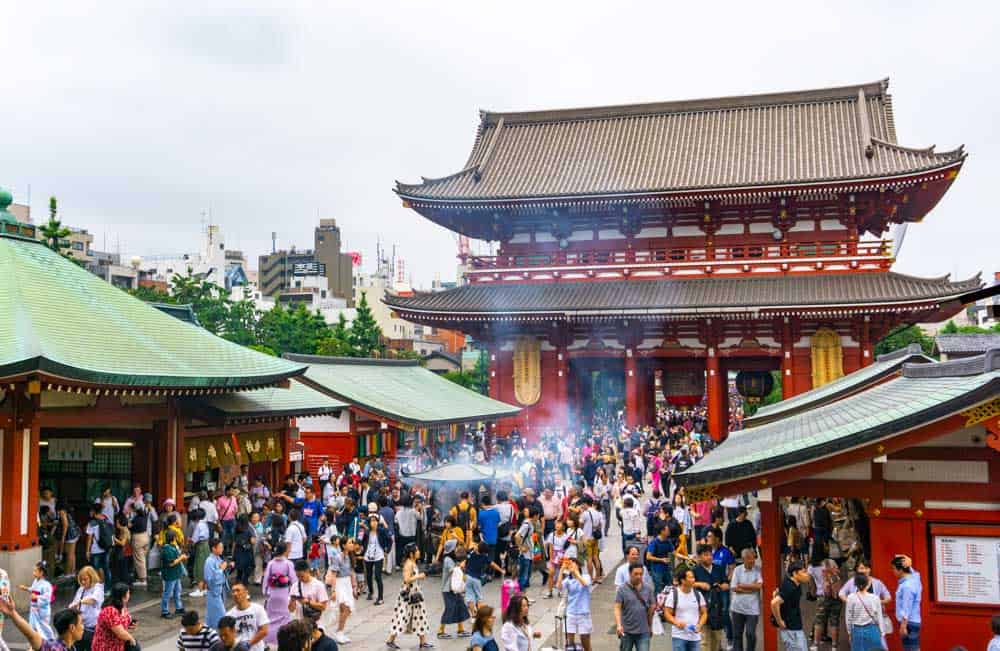
- We then took the train to Asakusa which is a nice tourist area with shops, restaurants as well as a few attractions.
- Here we had lunch as well as visited Denbouin Street – Old Edo Street, walked by Hanayashiki Amusement Park (Japan’s oldest amusement park), looked at the shops and spent an hour or so exploring Sensoji Temple (with everyone else in Tokyo it seems – note go early in the morning or late afternoon to avoid the crowds).
- We had also planned on visiting Uneo Zoo and Park which is close by, but after reading some poor reviews about the zoo we decided to skip it.
- If you had more time then us, you could plan on spending the entire day just in this area on your family holiday to Japan.

- We then took the train to Shibuya Station, which is the busiest train station in Japan! Boy they aren’t wrong.
- We checked out the Hachiko Memorial Statue which is right outside the station.
- We then went up to the rooftop of the Magnet Shopping Mall building to get a bird’s eye view of the world-famous Shibuya Crossing. It’s free to do so.
- We then walked across the Shibuya Crossing… which is just mental – but an iconic activity to do when in Japan, kids will be in awe!
- The kids spent a bit of their spending money at the 100-yen store (great place for them to by some Japanese souvenirs ). This is a big shopping area, so if you want to shop, this is the area to do so.
- We then spent the afternoon at a karaoke booth where the kids all had an absolute ball singing… karaoke, of course, is another iconic activity you have to do on your Tokyo family holiday. It’s just one of the many family friendly things to do in Tokyo.
Piss Alley (Omoide Yokocho)
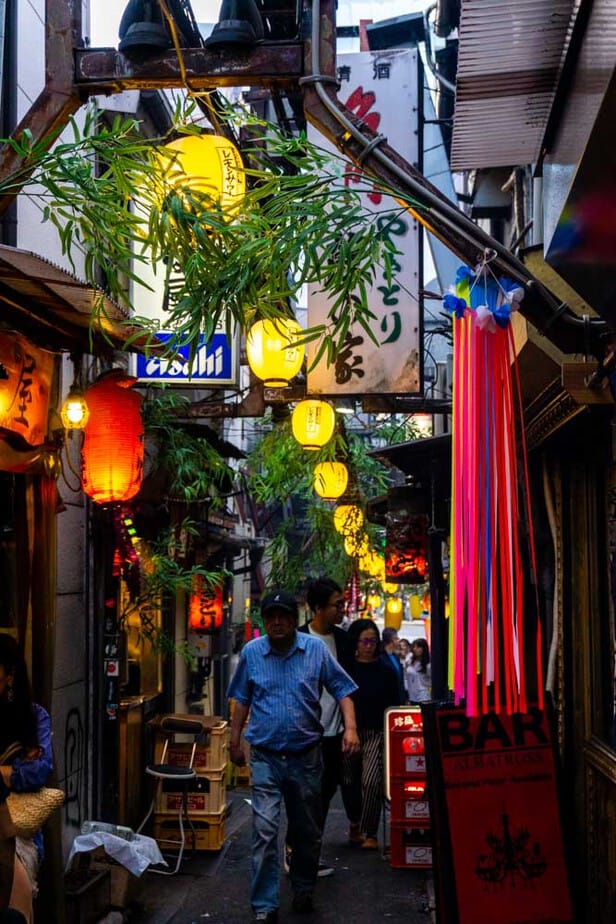
- We then took the train back to Shinjuku Station and checked out Piss Alley which is a cool little bar eatery lane nearby. Such a cool little area.
- We had hoped to eat dinner here – but the restaurants are super tiny and as a group of 7 we had no chance (something to keep in mind for larger families when you travel to Japan with kids) – but we found a place nearby for dinner.
- From here we took a train back to our accommodation.
Day 4: Explore Odaiba
Here is a brief overview of how we spent day 4 of our Japan family trip:
Mori Digital Art Museum/ teamLab Borderless

- From Shinjuku, we took the train to Odaiba and visited the popular Mori Digital Art Museum.
- This is an awesome place for kids so don’t miss it on your Japan family vacation.
- It’s super important to book this in advance ( book here ) as we heard from loads of people missing out. Tickets are 3800 yen ($39.85 AUD) per adult and 1300 yen ($14.99 AUD) per child (4-12).
- We spent around 3 hours here – we actually got hungry and left (you can’t go back in) – otherwise we could have spent much longer here.
Miraikan National Museum
- Take the free Tokyo Bay Shuttle bus to the Miraikan National Museum.
- We didn’t visit here as we were meeting friends and didn’t have time, but our friends we were traveling with who were doing a Japan 2 week itinerary, spent the afternoon here.
- Price is 630 yen ($7 AUD) per adult and 210 yen ($2.30 AUD) per child.
Odaiba Statue of Liberty

- Can you believe Tokyo even has it’s own replica Statue of Liberty!
- From teamLab Borderless we took the free Tokyo Bay Shuttle down to see the replica outside the Aqua City which is an indoor mall.
Day 5: Explore Harajuku
Day 5 of our Japan holiday with kids we had planned to spend the entire day exploring the area of Harajuku. Unfortunately, the weather gods had other plans and the day was pouring with rain. Nevertheless, we did get to do a few things:
HARRY Hedgehog Café

- First up we visited the very expensive and in my view overrated HARRY Hedgehog Café.
- Everyone must pay an entrance fee for this café and so we ended up just sending one adult (me!) with all of the kids, while the other adults went to a nearby café for a coffee. The kids however just loved the place – which seems to have happened a few times over our Japan itinerary, 3 weeks with quirky activities kids love!
- For 30 minutes at the café the cost is 1430 yen ($15.70 AUD) and worm snacks are additional – not for you, for the hedgehogs! Everyone must pay the entrance fee. You can pre-purchase tickets via Klook – but they are not any cheaper and are for one hour so cost 2640 yen ($29.79 AUD) per person – but they do include unlimited coffee and tea. Click here if you wish to pre book via Klook.
Takeshita-dori Street

- We then explored the famous Takeshita-dori Street, which is literally around the corner from HARRY Hedgehog Café.
- We had lunch here and also visited the Rainbow Sweets store where they make colourful fairy floss, ice cream and even colourful toasted cheese sandwiches. At this stage do you you even need to wonder; is Japan kid friendly? They will be in food-heaven!
- It was really pouring at this stage and so our plans of also visiting nearby Yoyogi Park or the Meiji Shrine were unfortunately called off. We also had planned on visiting Kiddy Land – but due to the rain, we went to a nearby shopping mall to spend the rest of the afternoon indoors.
Day 6: Disneysea

What the kids had all been waiting for on this family trip to Japan!!! A day at Disneysea!
We booked our tickets to Disneysea in advance via Klook and picked these up at the Maihama Train station before heading into the park. Tickets to Disneysea vary greatly pending day and time, ranging from 7900 to 10400 yen per adult ($80 – $110 AUD), and 4700 to 5600 yen for kids ($50 – $69 AUD), you can check the prices out here .
Many people choose to stay at a hotel near Disneysea and we had considered it, but rather than changing hotels etc we decided just to take the train. The train does take an hour or so, but it’s simple, reasonably cheap and if you’re trying to save money definitely just do this.
If however you’re travelling to Japan with toddler and need to have a break throughout the day, or if you plan on visiting both Disneysea and Disneyland, it’s probably best to stay at one of the hotels close by.
Day 7: Tavel to Hakone
Day 7 of our trip to Japan itinerary saw us say farewell to Tokyo and travel to Hakone where people go to get a glimpse of Mt Fuji.
Hakone Free Pass
We had pre-purchased a 3 days Hakone Free Pass which provided us with transportation to Hakone via the Odakyo line. The Hakone Pass is well worth it as it includes all your transport and various attractions. The 3 day pass is 6500 yen per adult ($74.85 AUD) and 1350 yen ($14.55 AUD) per child (6-11). If you only want the 2 day pass it’s 6100 yen ($63 AUD) per adult and 1100 yen ($11.50 AUD) per child.
We pre-purchased our 3 days Hakone Free Pass in advance via Klook. Klook don’t sell them at a discounted rate or anything – but you do accumulate loyalty points for your purchases – so might as well buy everything in the one place. Click here to purchase your Hakone Pass from Klook.
All up it took us about 3 hours to go from Shinjuku to our hotel in Gora.

Our friends we were traveling with were doing a 2 week Japan itinerary, decided to spend their time in Hakone in a traditional Ryokan so they stayed at the Ichinoyo Shinkan . Here they had their own private onsen and wore traditional Japanese dress.
As we were doing a Japan budget itinerary we stayed in a private room in a hostel in Gora called the Emblem Flow Hakone . Click here to check current pricing for Emblem Flow Hakone or here for Ichinoyo Shinkan . Click here for our full guide on where to stay in Hakone with kids.
We spent the afternoon relaxing a little, but if you had some energy it’s definitely worth getting out and exploring some of the places included in your Hakone Pass to make the most of your three weeks in Japan
Day 8: Explore Hakone
Day 8 we went off to explore the gorgeous Hakone – this place is beautiful and well worth spending a few days here. But if you’re short on time or doing say a 10 day Japan itinerary – you can still do a day trip from Tokyo which I’d also recommend.
Our plan was to take the Hokane Ropeway (cable cars) and stop at each section – unfortunately while we were there, there was quite a bit of volcanic activity and due to safety reasons, the cable cars were not running , so there was a bus in its place, but unfortunately it didn’t stop at any of the cable car stops.
Such a shame as I was so excited about doing it and from what I could see – the scenery is absolutely spectacular – so don’t skip this on your family holiday in Japan!!!
When the cable cars are running a one-way trip is 1500 yen ($16.95 AUD) per adult and 480 yen ($5 AUD) per child – or free for unlimited rides with the Hakone Pass.
Here is a brief overview of how we spent our first and only full day in Hakone:
Cruise on Lake Ashi
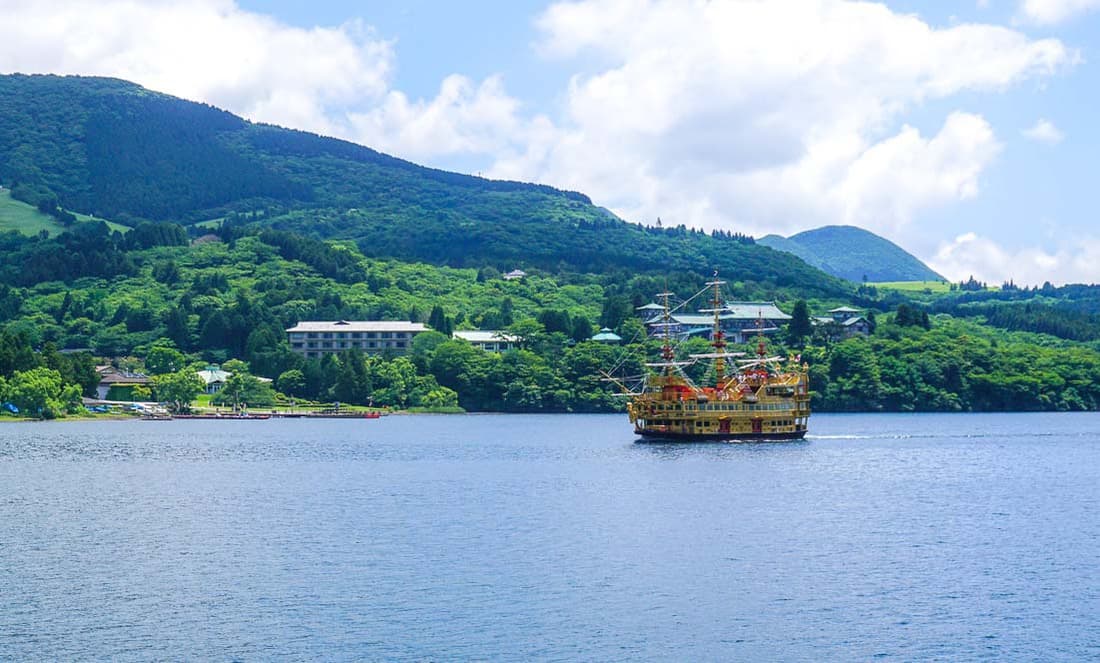
- The cable cars finish down by the stunning Lake Ashi which is also where the bus dropped us off.
- From here we used our Hakone Pass to take a cruise across the lake which was just beautiful. Such a change from Tokyo – I just loved Hakone!! The cruise takes around 30 minutes and is in a pirate ship! Family friendly Japan strikes again!
- The cruise is 1200 yen ($12.26 AUD) per adult or 750 yen ($7.97 AUD) per child – or free for unlimited cruises with the Hakone Pass.
Checkpoint Museum

- Once we got off the cruise we walked around to the Checkpoint Museum.
- We spent around an hour here and it’s also where we got our first glimpse of the gorgeous Mt Fuji!
- The Checkpoint Museum is 500 yen ($5 AUD) per adult and 250 yen ($2.50 AUD) per child. With the Hakone Free Pass you get a discount of 100 yen ($1.10 AUD).
Mishima Skywalk

- From the Checkpoint Museum, we took the bus (which is included in the Hakone Free Pass) to the Mishima Skywalk.
- We spent about 30 minutes walking across the Skywalk.
- The Skywalk is 1000 yen ($10 AUD) per adult and 500 yen ($5 AUD) per child. With the Hakone Free Pass you get a discount of 100 yen ($1.10 AUD).
Hakone Kowakien Yunessun

- From the Skywalk we then took the bus up to the fun Hakone Kowakien Yunessun. Hakone is all about hot onsens right – you know the romantic type where you relax with your partner – but pop a kid in the mix and you’re best off going to Kowakien Yunessun – which is like a warm water park. It has warm pools, water slides and pools such as the coffee pool, red wine pool etc. There are both inside and outside pools.
- You could easily spend the entire day hanging out at the Kowakien Yunessun, but we just spent a few hours here.
- Entry is 2500 yen per adult ($27 AUD) and 1400 yen ($15 AUD) per child. You do get a small discount with your Hakone Free Pass.
- From here we headed back to our accommodation.
Day 9: Travel to Nagoya
Here is a brief overview of how we spent day 9 of our family travel to Japan:
Hakone Open-Air Museum

- In the morning we checked out of our hotel (left our luggage there) and went to visit the Hakone Outdoor Museum.
- The Hakone Open-Air Museum is surprisingly one of the wonderful places to visit when traveling to Japan with kids – Myla just loved the place. Plenty of interactive things for the kids to do here.
- We were short on time so only spent 2 hours here – but could have easily spent another hour or so.
- Entry is 1600 yen per adult ($17 AUD) and 800 yen ($9 AUD) per child.
Travel from Hakone to Nagoya
- We then made our way to Nagoya Legoland by train. The entire trip took around 3 hours.
- Apart from the Legoland Hotel , there is really no other option for a hotel so that’s where we stayed. The hotel is super expensive, so if you’re looking at where to stay in Japan on a budget – this isn’t it and does not meet our usual budget requirements – but I guess this was our splurge of the trip and it is super fun for the kids to stay in the Legoland Resort where absolutely everything is Lego themed, including the food! Click here to see the current pricing of the Legoland Hotel.

Day 10: Legoland
Day 10 of our Japan 21 day itinerary was all about visiting Legoland! Click here to read our complete guide to Legoland in Japan.
- Legoland is just metres from the resort, which is awesome if you’re on a Japan holiday with toddler or travelling to Japan with a baby as you can easily come back to the hotel for a rest in the middle of the day if need be.
- We spent the entire day at Legoland – Legoland is really great for younger kids. All the kids in our group loved it!
- Again we had pre-purchased our tickets through Klook. We did check booking our hotel with tickets but once again it worked out cheaper to get the tickets through Klook. Entry at the gate is 7600 yen ($82 AUD) per adult and 4500 yen ($45.80 AUD) per child (3-12). Klook are currently selling tickets for 4400 yen ($45 AUD) per adult and 3500 yen ($39.45 AUD) per child (3-12) so a HUGE saving!!! Click here to book your discounted Legoland tickets.
Day 11: Travel from Nagoya to Kyoto
Day 11 was all about traveling from Nagoya to Kyoto. This trip took about 1 hour.
Click here for our full guide on Kyoto with kids.
Kyoto Accommodation
In Kyoto we stayed in Kyoumachiya Inn Rakuoan (pictured to the right), which is a gorgeous little traditional Rykon in the back streets of Kyoto. This was a three-bedroom house and we shared it with our friends who were doing a 2 weeks Japan itinerary. Click here to check out accommodation options in Kyoto.
We spent the afternoon getting some groceries for our home in Kyoto as well as exploring the little narrow laneways around our accommodation.
Click here for our full guide on where to stay in Kyoto with kids.
Day 12: Explore Kyoto
Day 12 our friends who were doing a Japan 2 weeks itinerary – took the train to Osaka to spend the day at Universal Studios in Osaka – one of the great attractions in Japan for families. We were going to Osaka after Kyoto, but they were ending their trip in Kyoto. If you’re doing a Japan 14 days itinerary – this may be something you might also like to consider. See more details about Universal Studios below.
This is a brief overview of what we got up to on day 12 of our Japan trip with family:
Fushimi Inari Shrine

- We took the train to the Fushimi Inari Shrine – which is one of the most popular things to do in all of Kyoto and so not surprisingly the place was absolutely packed! If I had my time again I would come here super early in the morning or late in the afternoon to avoid the crowds.
- There are lots of walking tracks here and things to do around the temple so you could easily spend at least half a day here, however given we were short on time we only spent around 2 hours here.
- Entry is free.
Kinkaku-Ji Temple

- We then took a train then bus to the Kinkaku-Ji Temple, also known as the Golden Pavilion.
- I have to say I was a little disappointed with this temple – sure it’s beautiful, but apart from looking at it, there isn’t much to do here. We were probably in and out within 30 minutes. If you’re short on time – give this one a miss.
- The Kinkaku-Ji Temple entry is 500 yen ($5.65 AUD) per adult and 300 yen ($3.25 AUD) per child (7-15).
Nishiki Markets

- From the Kinkaku-Ji Temple we made our way back to downtown Kyoto by bus and checked out the Nishiki Markets.
- For seafood lovers, you’re in for a real treat as there are lots of interesting things to eat. We just stuck with some ice cream though.
- We had also planned on visiting the Imperial Palace which is close to the markets – but we simply ran out of time and steam to be honest (so keep in mind if travelling to Japan with toddlers that little legs will get tired quicker), and so from here we walked back to our accommodation.
Pontocho Alley
- In the evening we headed out to the pretty little area called Pontoco Alley. This area is filled with bars and places to eat and is a must-do while in Kyoto.
- We found a lovely little place that served Shabu Shabu and then afterwards slowly strolled the narrow laneways before heading back to our accommodation.
Day 13: Explore Kyoto
Here is a brief overview of how we spent day 13 of our family vacation to Japan:
Nijo Castle

- We started the day by taking the bus to Nijo Castle. There is plenty to see here so we spent a few hours.
- Entry to the castle is 1300 yen ($13.30 AUD) per adult and 400 yen ($4.09) per child.
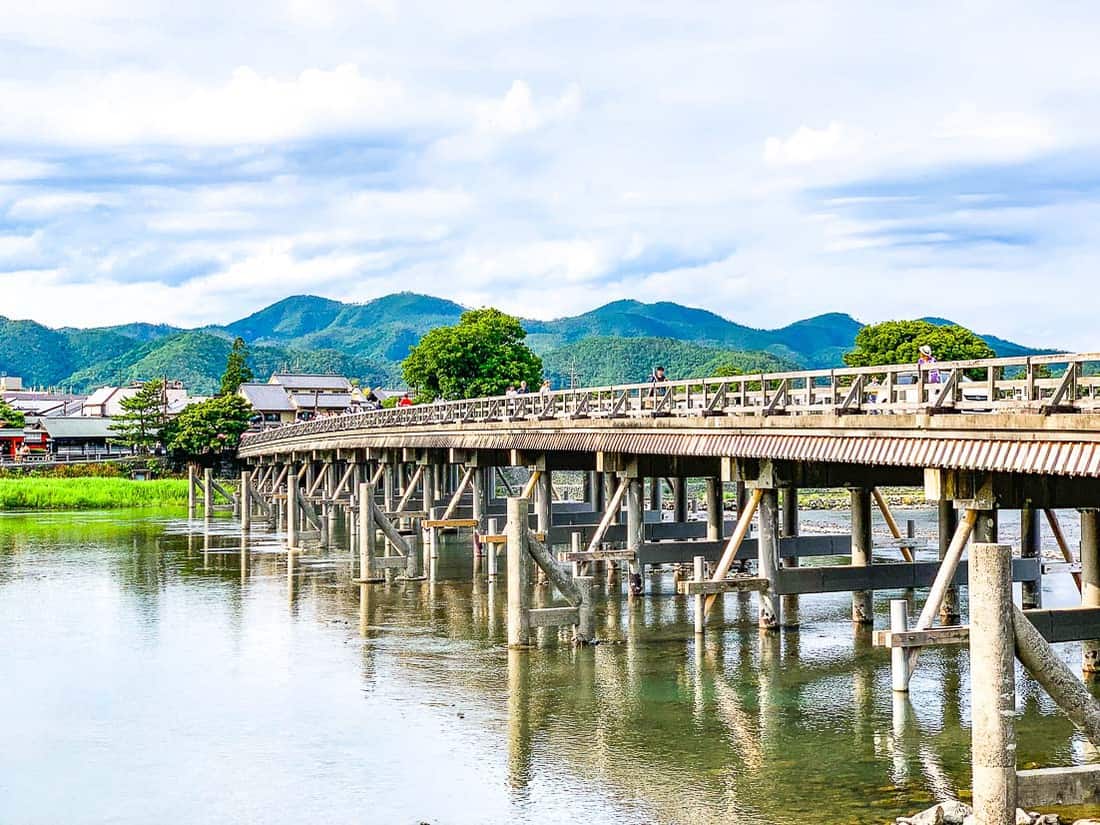
- From Nijo Castle we took a bus to the lovely tourist area of Arashiyama. I really loved this area, it was probably my personal favourite place in Kyoto.
- First of all we had lunch in Arashiyama and strolled around the shops for a bit.
- Then we walked to the Arashiyama Bamboo Grove which is just a short walk away from the main street. Entry to the Bambo Grove is free.
- We then walked across the lovely Togetsu-kyo bridge and over to the entrance of the Arashiyama Monkey Park – which was about a 15-minute walk. From here its a fairly steep walk up to the Monkey Park and takes around 30-45 minutes (depending on how often you have to stop due to tired children! – also keep this in mind if you’re travelling Japan with a baby and have to push strollers/use a carrier). It’s a little hard going and the kids did complain – but worth it once you get to the top and see the super cute wild monkeys. Entry to the Monkey Park is 600 yen ($6 AUD) per adult and 300 yen ($3.25 AUD) per child.
- We then took a bus back to our accommodation.
- Arashyiama is a great place and you easily spend the entire day here if you had more time. But we also found half a day was a good amount of time to see the highlights.
Maiko Dance
- Later in the evening, our friends went to check out the Maiko Dance which happens every night at 6.15 pm outside the Touzan Bar at the Hyatt Regency. We didn’t go simply because we were exhausted – but definitely put this on your list too for Kyoto itinerary with kids. It’s free to watch.

Day 14: Kyoto
Day 14 was the last day of our friend’s 14 days Japan itinerary and also our last day in Kyoto. Here is how we spent our last day in Kyoto:
Kiyomizu-dera Temple

- From our accommodation, we took the bus to Kiyomizu-dera Temple. As you can see, from here you have great views across all of Kyoto.
- You can explore the grounds of the temple for free, but to enter it is 400 yen ($4.35 AUD) per adult and 200 yen ($2.20 AUD) per child.
- We spent around an hour or so here. You could spend longer exploring all the walking trails – but as usual, we were short on time. If you’re going to visit just one temple in Kyoto, I’d visit Kiyomizu-dera in Japan with family.
Gion District
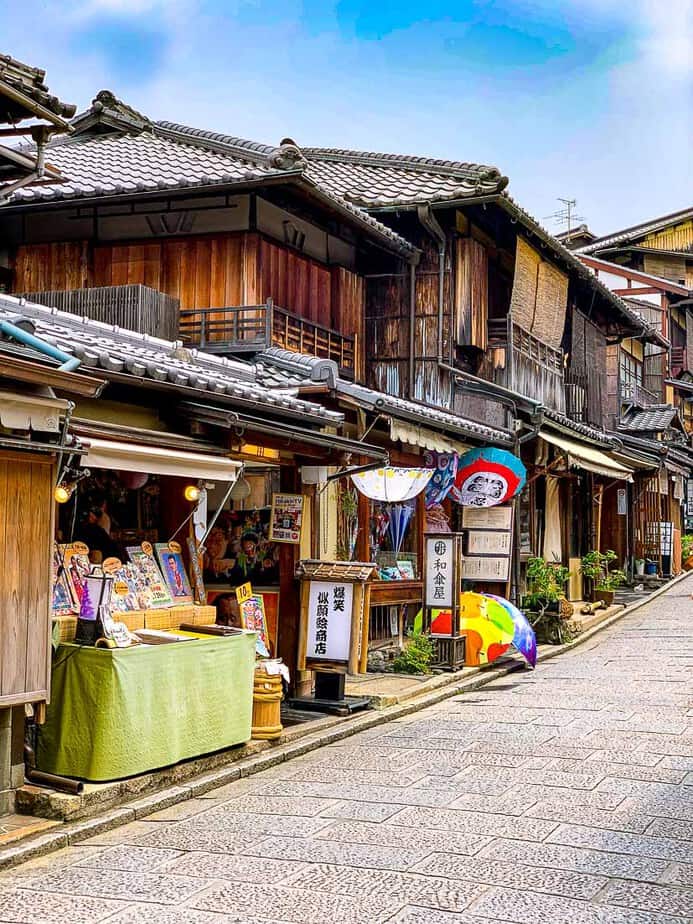
- From the Kiyomizu-dera Temple, we walked around the streets of the Gion District which are full of tourist shops, restaurants and cafes.
- Be sure to check out streets such as Ninen-zaka Street and Sannen Zaka Street for old traditional wooden houses.
- We had lunch in this area, which we found fairly expensive compared to anywhere else in Kyoto – but I guess that’s because there are a lot of tourists around here.
- We spent an hour or so slowly strolling through the streets and looking in the odd shop. If you are a shopper, definitely add this to your Japan trip planner, and you would probably spend a lot more time (and money) than we did!
Kodai-ji Temple

- From the streets of the Gion District, it’s just a short walk to the Kodai-ji Temple which I visited alone – I think most of the group were over temples by this stage.
- This is a really pretty temple, but reasonably small compared to some of the others. I spent around 30 minutes here – but given some of the group was waiting for me outside, I did walk quickly – I could have spent another 15 or so minutes here.
- Entry to Kodai-ji temple is 600 yen ($6.50 AUD) per adult and 250 yen ($2.70 AUD) per child.
Ryozen Kannon Statute
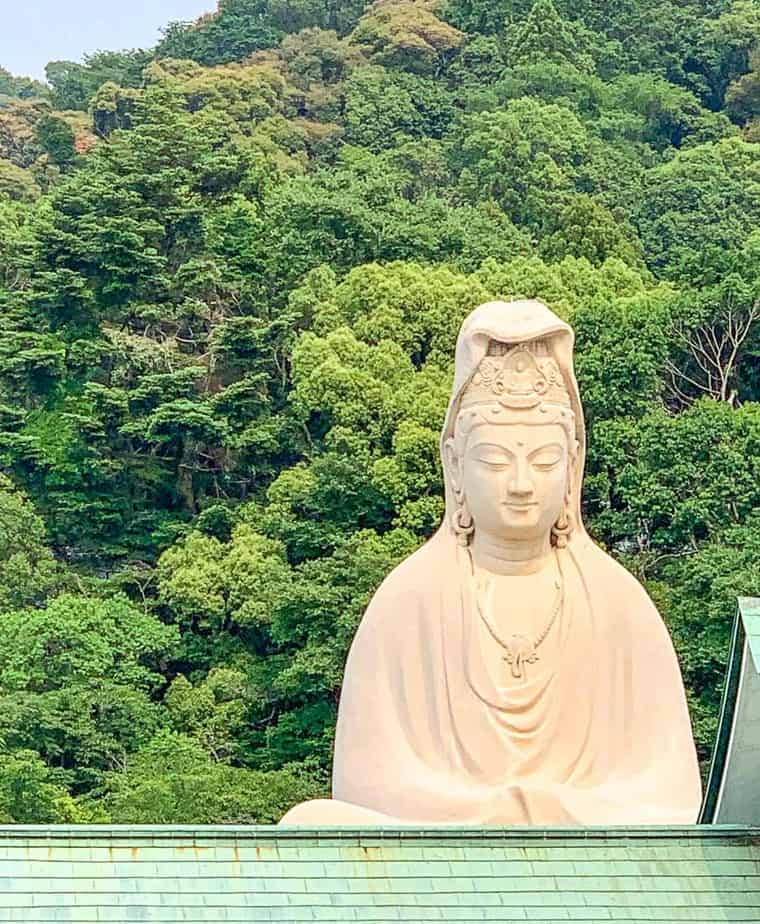
- From the Kodai-Ji Temple, I wanted to visit the Ryozen Kannon Statute – but I couldn’t for the life of me work out how to get into the complex. The statue is huge and I could see it, but just couldn’t work out how to get there. Plus the others in my group were tired and not that interested – so I took a picture and we moved on.
- If unlike me, you do work out how to get to the Ryozen Kannon Statute, entry is 300 yen ($3.25 AUD) per adult and 100 yen ($1.10 AUD) per child.
Day 15: Travel to Osaka – With a Stop in Nara
On day 15 we said good bye to our friends as their two weeks in Japan came to an end. They flew back from Osaka to Narita for their flight back to Australia.
Here is a brief overview of how we spent day 15 in Japan:
Nara Deer Park

- On our way to Osaka we stopped off at Nara as we wanted to visit the Nara Deer Park.
- It was really easy to stop off on our way as the train station at Nara has large lockers that we could leave our luggage in while we visited the Deer Park – Japan family travel does have it’s conveniences!
- The Deer Park is free to visit and you can buy some food to feed the deer if you like. However I’d probably advise against this as the Deer are pretty pushy towards the people with food and it can be a bit scary for the little ones – even adults too!
- We then walked around Higashimuki which is the shopping area of Nara and had some lunch. I also wanted to see the guys pound the Mochi (sticky rice cake) in Nakatanidou, but by the time we had got there they were finishing up for the day. Check it out here . Pretty unique to see on your family holiday, Japan.
Osaka Accommodation
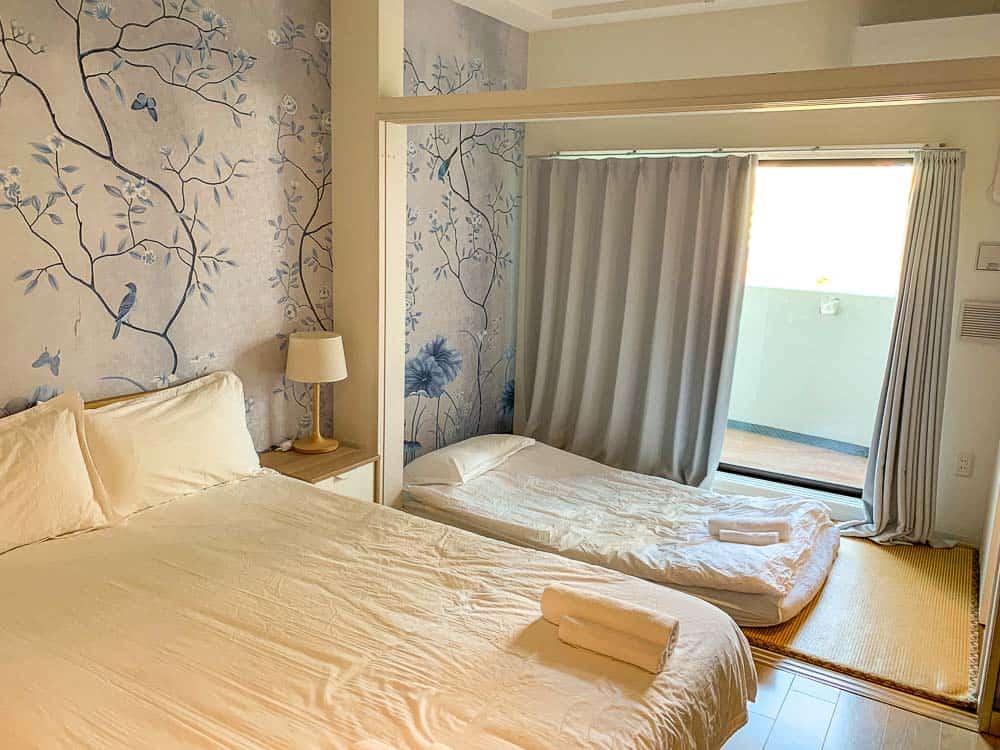
- We then continued our journey onto Osaka and checked into our accommodation.
- In Osaka we stayed in Ostay Umeda DDC Hotel Apartment , which was a great self-contained studio apartment close to the Osaka – Umeda train station. Click here to check out a range of properties in Osaka for your Japan holidays with kids.
Click here for our full guide on where to stay in Osaka with kids.

- We only had a super brief stay in Osaka, so no sooner had we dropped out bags, we headed straight to Dotonbori.
- In Dotonbori we took the 20-minute Tombori River Cruise. This provided a good brief overview of the area and also gave us an opportunity to see all the famous Dotonbori Billboards – can only imagine what this area must look like at night!
- The River cruises depart every hour and half hour and cost 1200 yen ($12.29 AUD) per adult and 400 yen ($4.35 AUD) per child (6-12).
- Dotonbori is also a shoppers heaven, with long shopping arcades absolutely everywhere. We’re not shoppers so pretty much bypassed this.
- We then took a stroll down to the older area of Dotonbori – Hozenji Yokocho. This area is where you will find sweet narrow laneways that head in the direction of the Hozenji Temple. I loved strolling around this area. The laneways are filled with small food shops and cafes. Too bad we didn’t have long here as I would have loved to have eaten in a few of these restaurants.⠀
- We then headed back to our accommodation in Umeda and headed out for dinner at a super cute Okonomiyaki place.
Click here for our full guide on things to do in Osaka with kids.
Day 16: Universal Studios

On day 16 of our Japan trip we headed to Universal Studios:
- We took the train to Universal Studios which was absolutely fantastic and we all loved it. There is plenty to do here for young and old – great rides and awesome shows too. I’ll provide further detail about Universal Studios in a separate post.
- Make sure you are at the park just before it opens as we found it much quieter at this time. And plan to spend the entire day here.
- Entry to Universal Studios is super expensive and there is a range of ticket options too. One day tickets start at 8600 yen ($97.22 AUD) per adult (12+) and kids are 5600 yen ($63.30 AUD) (4-11 – so if travelling Japan with a toddler, they’re free!). We pre-purchased our tickets via Klook. Klook don’t sell them at a discounted rate or anything – but you do accumulate loyalty points for your purchases – so might as well buy everything in the one place. Click here to purchase your Universal Studios from Klook.
Day 17: Explore Osaka and Travel to Hiroshima
Here is a brief overview of how we spent day 17 in Japan:
Cup Noodles Museum

- In the morning we checked out of our accommodation and took the train to visit the Cup Noodles Museum. We left our luggage at the train station by Cup Noodles Museum.
- The Cup Noodles Museum is great for kids and well recommended. We visited on a weekend and it was packed, so I’d recommend getting there by opening hours or maybe it’s not so busy during the week.
- We spent around 2 hours here, but at least 30 minutes of this was lining up, so on a quieter day you could probably get away with less time here.
- Entry to Cup Noodles Museum is free, however if you want to create your own Cup of Noodles – which you should – it is 500 yen ($5.65 AUD).

- We then took the train to Kid’s Plaza – which is basically heaven for kids! Kids Plaza is like a museum – but better! Across various levels – this place has a range of awesome things for kids to discover and play with.
- There is a huge playground the kids can climb, hide and slide in, as well as an area where the kids can try out a range of occupations such as shop keepers, firemen, and postman, as well as musical instruments, science equipment and heaps more.
- We spent around 2 hours here, but you could easily spend at least half the day – there is just so much to do here.
- Entry to Kids Plaza is 1400 yen ($15.25 AUD) for adults, 800 yen ($8.70 AUD) for school kids and 500 yen ($5.45 AUD) for preschoolers. Kids under 3 are free.
Travel to Hiroshima
- We then said goodbye to Osaka and left for Hiroshima, the last destination of our 3 weeks in Japan itinerary.
- We arrived late afternoon in Hiroshima and checked in at our accommodation; Chidori Inn Fukuromachi Hiroshima. Our accommodation was surprisingly huge (well for Japanese standards) with a separate living area and sleeping area. Click here to check current pricing .
Click here to read our full guide on where to stay in Hiroshima.
Day 18: Day Trip to Miyajima Island

On day 18 we took a day trip from Hiroshima to Miyajima Island – one of my favorite places on this trip to Japan. I will explain more about what we did in another post, but here is a brief overview for your Japan family itinerary planning:
- We took the train from Hiroshima to the ferry and from here we took the short 10-minute ferry ride across to Miyajima Island. The return ferry trip is 360 yen ($3.90 AUD) per adult and 180 yen ($1.95 AUD) per child.
- We took the cable car up to Mt Misen – which was just stunning! Even the walk through the forest to get to the cable car was gorgeous. The cable car is 2000 yen ($22.60 AUD) return per adult and 1000 yen ($11.30 AUD) return for children. Many people take the cable car up and walk back down so one way it is 1100 yen ($12.45 AUD) per adult and 550 yen ($6.25 AUD) per child.
- We saw the Itsukushima Shrine – entry is 500 yen ($5.12 AUD) per adult, 300 yen ($3.07 AUD) per high school student and 150 yen ($1.53 AUD) for children 6 and older. As well as the famous Floating Torii, which as you can see from above was under construction during our visit.
- Visited the Miyajima History and Folklore Museum – entry is 300 yen ($3.25 AUD) per adult, 170 yen ($1.85 AUD) per high school student and 150 yen ($1.63 AUD) for kids.
- We walked around Omotesando Shopping Street.
- Saw the Hokoku Shrine – 5 Story Pagoda and Daisho-in Temple.
Day 19: Visit the Hiroshima Peace Museum and Memorial Park
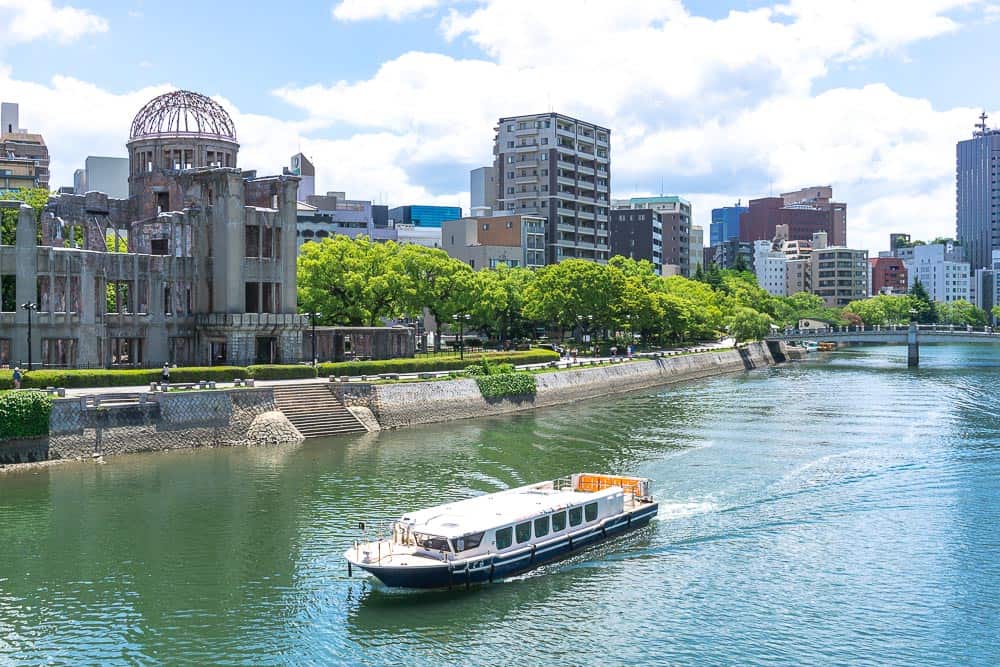
On our last day in Japan, we spent the morning at the Hiroshima Peace Museum and Memorial Park before returning to Tokyo for our flight home.
Hiroshima Peace Memorial Museum
- First up, we checked out of our accommodation and left our luggage in the lockers at the museum.
- For months and weeks before visiting, Andy and I were conflicted as to whether or not to go to the Museum as it would mean, of course, bringing Myla. In the end, we decided to take her and talked about what happened there in an age-appropriate way before arriving. We shielded her from some of the more graphic pictures and stories – but we spoke to her not only about the human suffering but also about the determination in the people to survive, rebuild, forgive and ultimately advocate for world peace.
- The Museum is fantastic, and we spent at least 90 minutes here – if I wasn’t with Myla, I could have probably spent even longer here – there is just so much to look at and to read.
- Entry to the Museum is 200 yen ($2.20 AUD) per adult, 100 yen ($1.10 AUD) for high school students and other children are free.
Hiroshima Peace Memorial Park
- Right outside the museum is the Hiroshima Peace Memorial Park. There is a range of different monuments to look at here including the Atomic Dome and the Children’s Peace Monument.
- The Park is lovely, and it’s definitely worth looking at all the different monuments here. We spent an hour or so here.
Travel to Tokyo and Fly Home
- Around midday, we then got our luggage and took a train back to Tokyo and onto Narita Airport. Later that night we caught a 9pm flight direct to Gold Coast and our Japan trip came to an end.
Final Verdict
We all thought our family trip to Japan was brilliant! There are so many great Japan activities for kids that you will definitely benefit from planning out you’re itinerary first – hopefully, you can use the information contained in this post as a sample Japan itinerary for your own trip. As you can see, a lot of work went into planning this trip – so if you’re planning a trip to Japan, why not save yourself some time and use this as a basis for your own trip to Japan.
____________________________________________________________________________________
We hope this ultimate itinerary in Japan has been helpful. For some of the best family hotels in Tokyo click here and if you plan on visiting Legoland find out all the inside info here and for all the best things to do in Japan have a look here.
7 thoughts on “The Ultimate (and detailed) 3 Week Japan Itinerary with Kids”
This is awesome. Thanks so much.
Hi! Thank you. I’m interested in the 2 week itinerary please, where can I find that? Looks wonderful 😉
Hi Lindsey – the 14 day itinerary is the first 14 days of the trip – this is what the friends that were with us did. We continued on for another week in Osaka and Hiroshima.
Hi Melissa, great itinerary and I’m using this as a basis for our own family trip next year. Is there anything you would have done differently? Spent less or more time anywhere? Gone somewhere else instead? Thanks,
Hi Lauren – not really – but I have made some comments throughout the article about any suggestions or changes to the itinerary.
Can you advise on the budget of your 3 week trip?
I have listed prices throughout the article – so you’ll need to go through and add this up depending on how many people there are in your family. Will also of course depend on time of year as air fares and hotels change.
Leave a Comment Cancel reply
Save my name, email, and website in this browser for the next time I comment.
Get our Japan with Kids Itinerary FREE!
Get our free 44-page guide which our super-detailed day by day Japan with kids itinerary.
It includes all the best places Japan attractions (including where to get discount tickets), best budget family hotels & how best to get around.
Start planning that Japan trip now!
Thank you! Now check your email to confirm your request.
We won't send you spam. Unsubscribe at any time.
We use cookies on this site to enhance your user experience. If you continue to browse you accept the use of cookies on our site. See our Cookie Policy for more information.
- Media & PR
- Meetings & Events
- School Groups
- Travel Trade
- Select Language 简体中文 繁體中文(香港) 繁體中文(臺灣) India (English) Bahasa Indonesia 한국어 ภาษาไทย Tiếng Việt Singapore (English) Philippines (English) Malaysia (English) Australia/New Zealand (English) Français Deutsch Italiano Español United Kingdom (English) Nordic countries(English) Canada (English) Canada (Français) United States (English) Mexico (español) Português العربية Japan(日本語) Global (English)
- India (English)
- Bahasa Indonesia
- Singapore (English)
- Philippines (English)
- Malaysia (English)
- Australia/New Zealand (English)
- United Kingdom (English)
- Nordic countries(English)
- Canada (English)
- Canada (Français)
- United States (English)
- Mexico (español)
- Global (English)
- Fujiyoshida
- Shimonoseki
- Ishigaki Island
- Miyako Island
- Kerama Island
- Tokyo Island
- Koka & Shigaraki
- Hida Takayama
- Ginza, Nihonbashi
- Beppu & Yufuin (Onsen)
- Ginzan Onsen
- Nagasaki Islands

- Kumano Kodo
- Shikoku Karst
- Amami Oshima
- Hachimantai
- Omihachiman
- Aizuwakamatsu

- Diving in Japan
- Skiing in Japan
- Seasonal Flowers in Japan
- Sustainable Outdoors
- Off the Beaten Track in Japan
- Scenic Spots
- World Heritage
- Home Stays & Farm Stays

- Japanese Gardens
- Japanese Crafts
- Temple Stays
- Heritage Stays
- Festivals and Events
- Theater in Japan
- Japanese Tea Ceremony
- Cultural Experiences in Japan
- Culture in Japan

- Local Cuisine Eastern Japan
- Local Cuisine Western Japan
- Local Street Food
- Japan's Local Ekiben
- Japanese Whisky
- Vegetarian and Vegan Guide
- Sushi in Japan Guide
- Japanese Sake Breweries

- Art Museums
- Architecture
- Performing Arts
- Art Festivals
- Japanese Anime and Comics
- Japanese Ceramics
- Local Crafts

- Scenic Night Views
- Natural Wonders
- Theme Parks
- Samurai & Ninja
- Iconic Architecture

- Wellness Travel in Japan
- Japanese Ryokan Guide
- A Guide to Stargazing in Japan
- Relaxation in Japan
- Forest Bathing (Shinrin-yoku)

- Experiences in Japan
- Enjoy my Japan
- National Parks
- Japan's Local Treasures
- Japan Heritage
- Snow Like No Other
- Wonder Around Japan

- Visa Information
- Getting to Japan
- Airport Access
- COVID-19 Practical Information
- Anime Tourism
- Countryside Stays
- Sustainable Travel
- Accommodation
- Sample Itineraries
- Travel Agents
- Deals and Tours

- Traveling by Rail
- How to Travel by Train and Bus
- JR Rail Passes
- Train Passes and Discounted Tickets
- Scenic Railways
- Renting a Car
- Yokohama Cruise Port Access
- Travel Brochures
- Useful Apps
- Accommodation Types
- Online Reservation Sites
- Eco-friendly Accommodation
- Luxury Accommodations
- Traveling With a Disability
- Hands-free Travel
- How to Book a Certified Tour Guide
- Volunteer Guides
- Tourist Information Center

- Japanese Manners
- Sustainable Travel in Japan
- Spring in Japan
- Summer in Japan
- Autumn in Japan
- Winter in Japan
- Seasonal Attractions
- Monthly Events Calendar
- Cherry Blossom Forecast
- Autumn Leaves Forecast

- Japan Visitor Hotline
- Travel Insurance in Japan
- Japan Safe Travel Information
- Accessibility in Japan
- Vegetarian Guide
- Muslim Travelers
- Safety Tips

- All News & Blog
- Travellers Blog
- Guides to Japan
- Stories of Japan
- The Other Side of Japan
- Media Releases
- JAPAN Monthly Web Magazine

My Favorites
${v.desc | trunc(25)}
Planning a Trip to Japan?
Share your travel photos with us by hashtagging your images with #visitjapanjp
Adventures with Baby in Japan

If you are planning a holiday with your baby in a safe, clean and friendly country with lots of cultural experiences, then consider Japan! Three generations – grandparents (that’s us), my daughter and her husband and our little grandson recently spent a few weeks in Japan. Felix was then 11 months old and already an intrepid traveller. It helped that he wasn’t walking yet!
My top 10 tips for travelling with a baby in Japan are –
(1) Visit the countryside
Many people confine their holidays to the major urban areas. Do be more adventurous! We have no Japanese skills but most locals have a smattering of English, and as a back-up, sign language works well. The countryside is beautiful, the pace is slower, everyone will be more relaxed. There’s so much to experience!

(2) Buy a Japan Rail pass
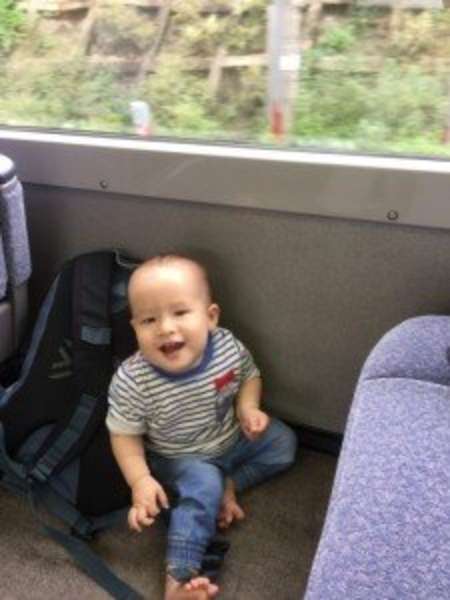
If your budget allows, buy a Green pass (business class seats). I thought it would be an extravagance, and did not want fussing with seat reservations. Instead JR officers were super efficient and patient, it was no bother at all. Having reserved seats also allows you to double check that you are on the right train – all you need to do is show your ticket and JR staff will help. Do some research about the trains and destinations before you buy. The hyperdia.com website is accurate, up-to-date, and gives you more reliable information than some free advice lines.
Activate your JR pass only when you leave your main port of embarkation. In our case we stayed in Tokyo for 5 days and activated our 14-day pass when leaving for Kanazawa. Make your reservations two stops at a time as it is less confusing than making reservations for your whole trip all at once.
You may have to change trains and I saw travellers frazzled because of an 8-minute change. After our first journey, we realized that it was possible to plan on 20-minute changes with appropriate train schedules. All trains are very clean and your baby can safely sit and play on the floor.
(3) Rent a machiya or Japanese-style house
We had a beautiful, spacious, double storey traditional machiya in Takayama and again in Kyoto, which allowed us to cook a few meals and spend more time together than in hotel rooms. A warning – the stairs are steep so look for a house that has (a) a toilet upstairs for night visits, and (b) stairs with a hand rail. Privacy is not great as the sliding doors are made of paper, but I think that’s part of the charm.

(4) Take a taxi for short to medium rides in urban areas
It’s not much more expensive than bus or rail to take a taxi if there are 4 adults. Babies don’t need special seats and it’s quite safe.
(5) Bring a baby sling and a small fold-up stroller
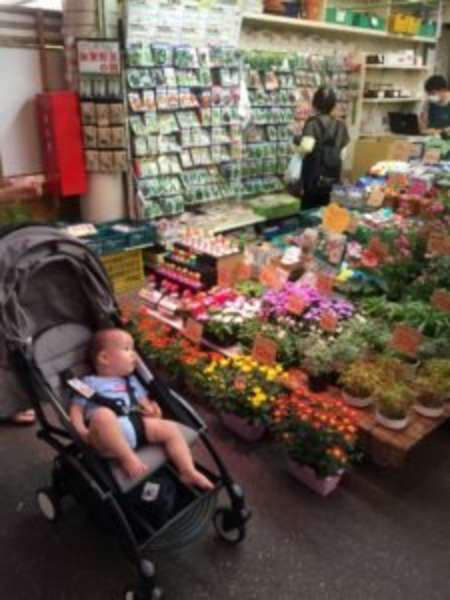
You’ll be very thankful for the versatility, as it may be difficult to find elevators and escalators in many places in Japan including train stations.
When going for daytrips or walks, always bring a baby carrier. Many tourist destinations are centuries old and not disability or stroller friendly, so when you meet with lots of steps you sling the stroller over your shoulder!
We bought a Babyzen Yoyo for the holiday. There are cheaper on-line versions of the popular brands. I checked out a Pocket stroller in Toys- r-us in Aeon Mall, Kyoto, right near the train station and it was priced much less than Australia.
(6) Get access to data
You’ll need data to negotiate the subways, find restaurants, etc. otherwise it gets very stressful. In other countries you can download Google maps before you visit, but this doesn’t work for Japan. If you rent an AirBnB in the main cities your host will probably loan you a pocket wifi. Otherwise the 3 main options are –
- Rent a pocket wifi online outside of Japan for about USD 10 a day and pick it up at the airport. It’s not possible for a tourist to rent a pocket wifi within Japan. After your trip, you need to mail it back to the airport with a pre-addressed and stamped envelope.
- Buy a SIM card for unlimited data at the main airports for about USD 10 a day. However the costs pile up because there’s an administration fee, and also additional fees for making local and international calls and text messages.
- I opted to buy a SIM for data alone (no voice calls) and it cost about USD 30 for 14 days with 2 GB of data, Whatsapp and FB use excluded. This proved indispensable when driving around Hokkaido! Large camera shops (Yodabashi and Bic) in any of the large cities sell these. Avoid the B-mobile visitor SIM card which promised unlimited data for 14 days – it caused me no end of grief. If it’s too good to be true it isn’t!
(7) Ride a bike in Kyoto!
Everyone goes to see the shrines and gardens, but it’s so easy to get overloaded. A bicycle ride was our top experience in that city! I think Felix enjoyed it very much too! Bike rentals can be around the train station. The tours were booked out, but we had more flexibility on our own and managed fine with a free book on bike routes furnished by the rental company.

(8) Catch a sumo match in Tokyo
Your son or son-in law will probably be interested in sumo. It is an authentic cultural experience. The set up is baby friendly and you can walk around between matches. Do visit the official website to see whether the competitions are on. It’s much better to buy tickets online than taking a chance on the day itself. Eager beaver that I am, I waited for sales to open (6 August, 2016) and snapped up 4 tickets. NOTE family tickets are not available to non-Japanese, even if the website appears to say that this is an option. The tickets are for the whole day. Unless you are a very serious fan, plan to turn up only between 3-3.30 pm. The good sumo matches take place at around 4 pm.

I can recommend lunch at a nearby ramen shop before the match. It’s just a “hole in the wall” place, on the same side of the road and several doors down from McDonald’s opposite the sumo centre. There were no other foreigners, no English menu, very reasonable prices and yummy noodles.
(9) Buy baby food at the chemist
Do pack your baby favourite baby food but there’s lots of Japanese food that your child will be able to eat because the food is not spicy. Look at the array at left … If you do run out, you’ll find supplies at chemists not grocery stores. However they are mostly rice based so your baby may not be used to the taste.
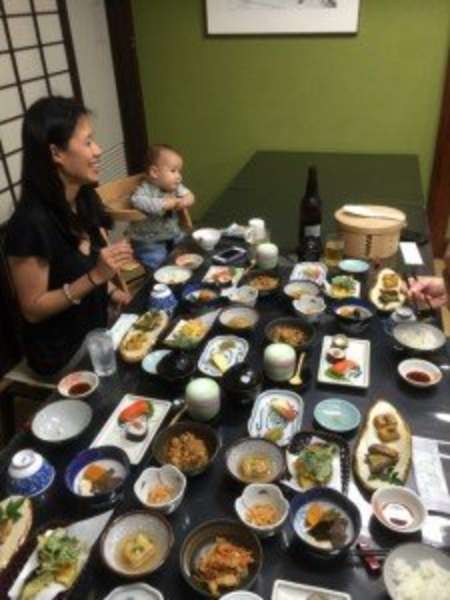
(10) Overcome any embarrassment and visit an onsen (spa bath)
It’s usually gender segregated; babies and children under 6 can go into either men or women’s sections. The water temperature is too hot for babies to be immersed, but Felix was perfectly happy crawling around, splashing at the margins. Onsens are so good, they can be addictive. More of this in a separate post.
Happy travels with your grand baby! Share your adventures!

Reposted with the permission of Poh-Ling Tan of Hello Grandbaby! , embracing the joys of grandparenting.
About Travellers Blog
Travellers Blog entries are submitted by travellers communicating their travel experiences in Japan and are published ‘as is’. Opinions written do not necessarily reflect those of JNTO. If you wish to submit a blog, please submit an enquiry through the contact us page .
- Fukushima 3
- Hiroshima 2
- Tokushima 2
- Kagoshima 1
- Yamanashi 1
- Previous Article
- Back to Overview
- Next Article
- JNTO Sydney
Please Choose Your Language
Browse the JNTO site in one of multiple languages
Tokyo With A Baby: family travel in Tokyo, Japan
This post may contain compensated links. Find more info in our disclosure policy
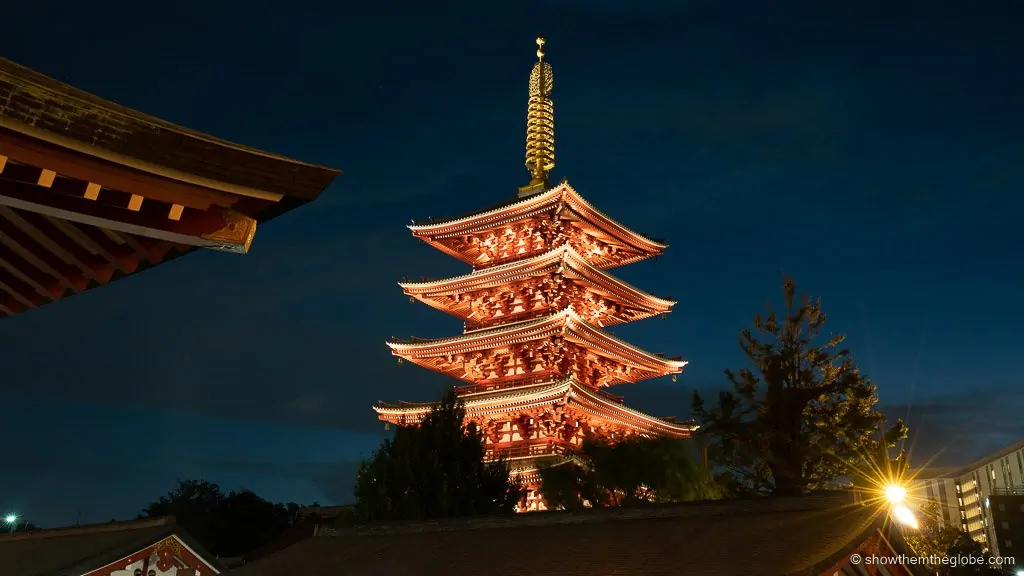
We traveled to Tokyo with baby J when he was 10 months old and loved our family time in one of the world’s most fun, quirky and chaotic cities. Tokyo is an awesome choice for a family vacation and there are endless things to do in Tokyo with kids. Together we explored its iconic sights from Shibuya Crossing to Harajuku to the amazing Digital Art Museum. Here’s our guide to traveling to Tokyo with a baby!
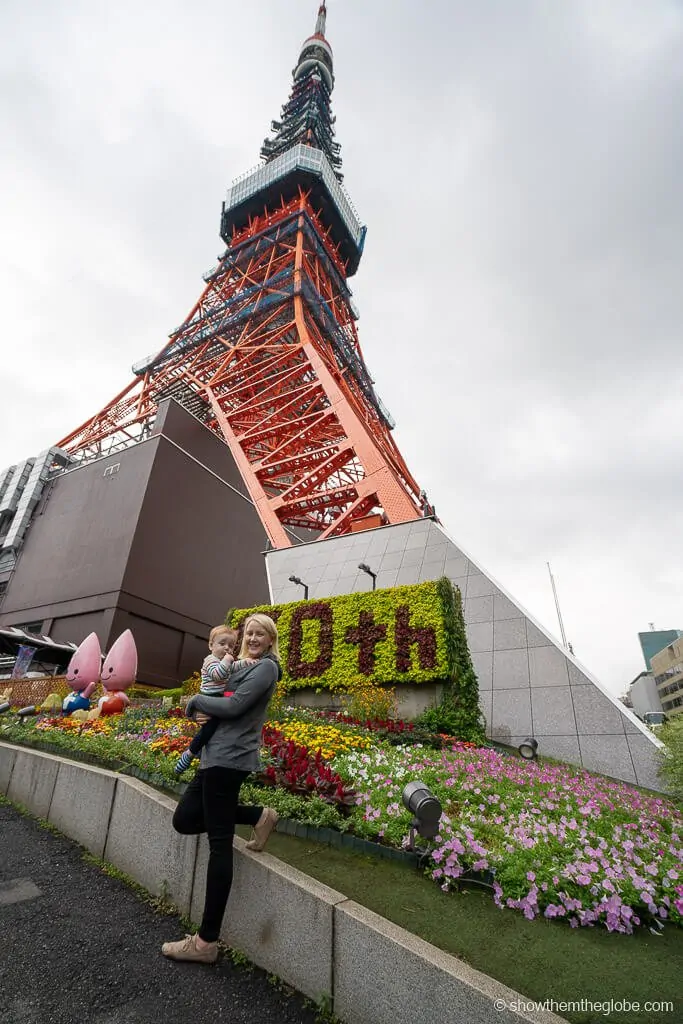
Where to stay in Tokyo with a baby
As we were spending two weeks in Tokyo we wanted somewhere relatively spacious in a city where hotel rooms are notoriously small! We always chose a hotel within a short walking distance of a subway station or, preferably, one of the major train stations such as Tokyo Station.
Most hotels and are very welcoming to younger guests: when we arrived at both our hotels J was gifted a little welcome package with slippers and a baby cloth which was a lovely gesture. Many hotels provide cribs but we prefer to travel with our own compact travel cot which we know meets the recommended safety standards we follow.
Tokyo with a baby tip: lots of hotels in Tokyo have coin operated laundry on site and we loved having the flexibility to do some laundry especially as we were on a multi country trip. We brought baby sensitive detergent with us but the detergent was often automatically included in the washing cycle.
Our Tokyo hotel picks
- Mitsui Garden Hotel Koyobashi: close to both Tokyo Station and the Koyobashi Metro Station as well as within walking distance of Ginza, the Mitsui Garden Hotel is a great base for exploring the city. We opted for a standard room which was a decent size and we appreciated the hotel’s coin-operated laundry – Check prices here!
- Shibuya Excel Hotel, Tokyu: close to Shibuya Station the hotel’s 25th-floor restaurant level offers the best views of Shibuya, has laundry facilities and the location is excellent for exploring the city – Check prices here!
Click here for the best Tokyo hotel prices
Stroller or baby carrier in Tokyo?
We traveled with a stroller and a baby carrier to Tokyo and used both countless times – we would definitely recommend traveling with both to Tokyo if it’s an option.
We tend to walk for miles and miles while on vacation and Tokyo is a city made for walking so it was great to have the stroller for J to relax in. The stroller was perfect for places that required a lot of walking: navigating the airport, exploring Tokyo’s green spaces and wandering through the city.
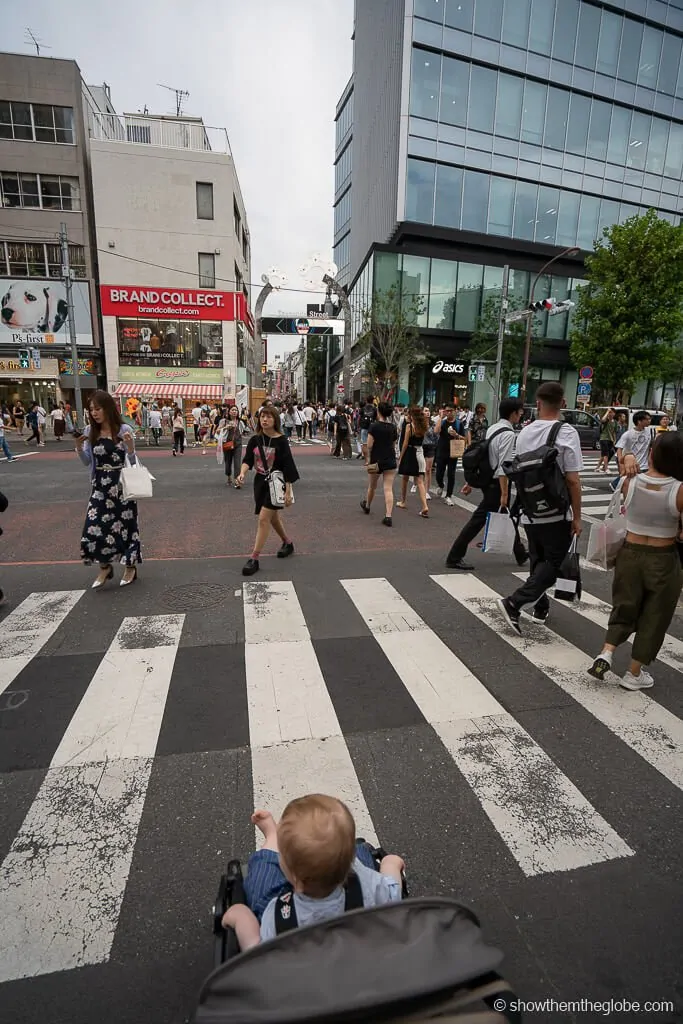
Tokyo with a baby tip: we travel with the cabin friendly BabyZen Yoyo+ and most of the strollers we saw in Tokyo were super compact – we saw many BabyZen’s and GB Pockit’s on the city streets. Bring a compact, foldable stroller if possible as it’s just easier for navigating the crowded city and storing in restaurants.
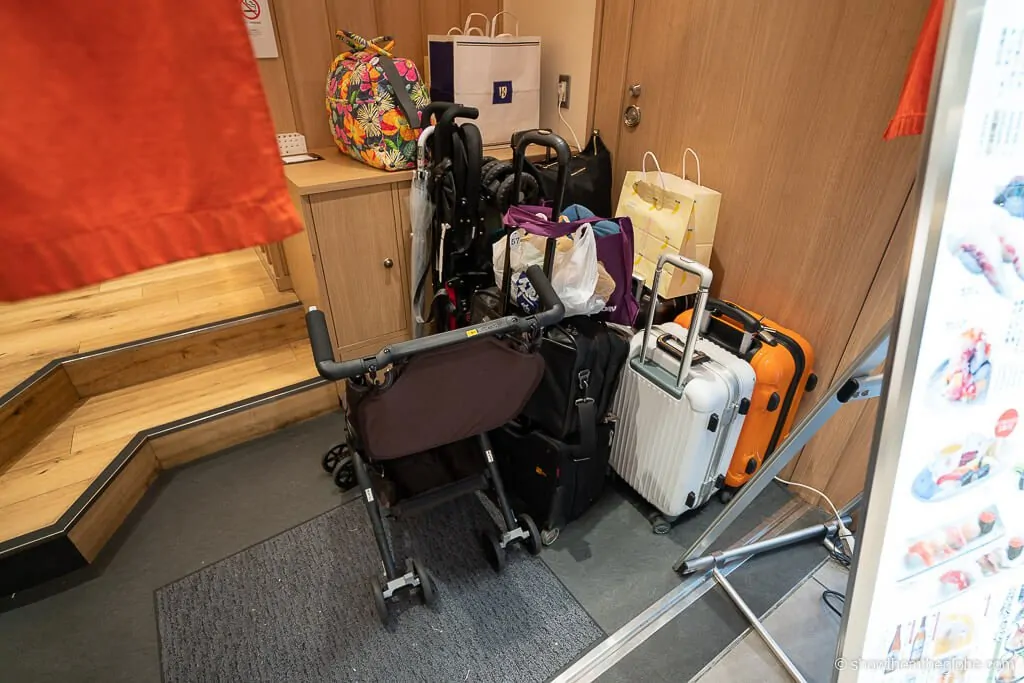
Baby carrier
For subway trips, exploring crowded neighborhoods like Harajuku or wandering through the narrow alleys of Golden Gai and Memory Lane in Shinjuku a baby carrier is a necessity.
Tokyo with a baby tip: we use an Ergobaby 360 baby carrier while travelling.
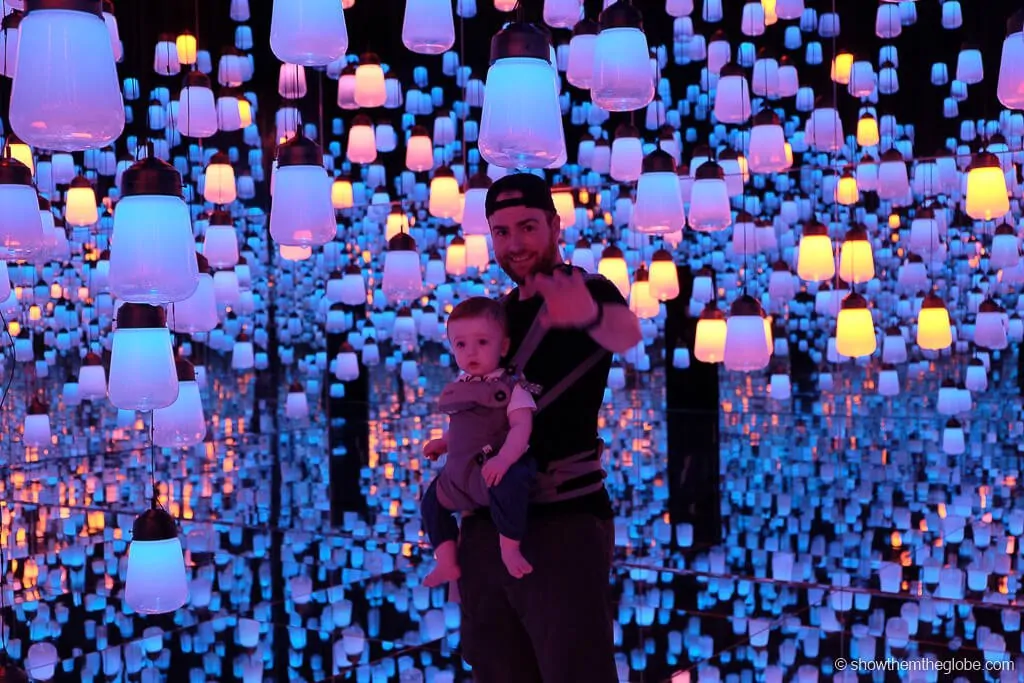
Tokyo Essentials: Sim Cards and Internet
One of the best investments you can make for your trip to Japan is to buy/rent a sim card or 4G hotspot. This will give you internet access while on the go. We have used both sim cards and 4G hotspots during our trips to Japan. A sim card is perfect if you just have your phone while the 4G hotspots are great if you have multiple devices that need internet or if you’re travelling a group. They also avoid any compatibility issues with installing a sim card.
We used the Klook app to order our sim cards for our last trip. The app is great as you can order in advance and pick up on arrival or from various departure cities.
- The best 4G hotspot on offer is provided by URoaming with unlimited data – check prices now!
- The best sim card is from Docomo (who we used) – check prices now!
Click here to order your sim card or 4G hotspot now
How to get around Tokyo with a baby
From airport rides to navigating the city, it is important to plan how you will get around Tokyo with a baby. We used a mix of trains, the subway and walking during our visit.
Tokyo trains and subway
In Tokyo, the trains and the subway are generally the quickest, cheapest and most convenient way to navigate the city. There’s no reason to shy away from the public transport system when traveling with a baby.
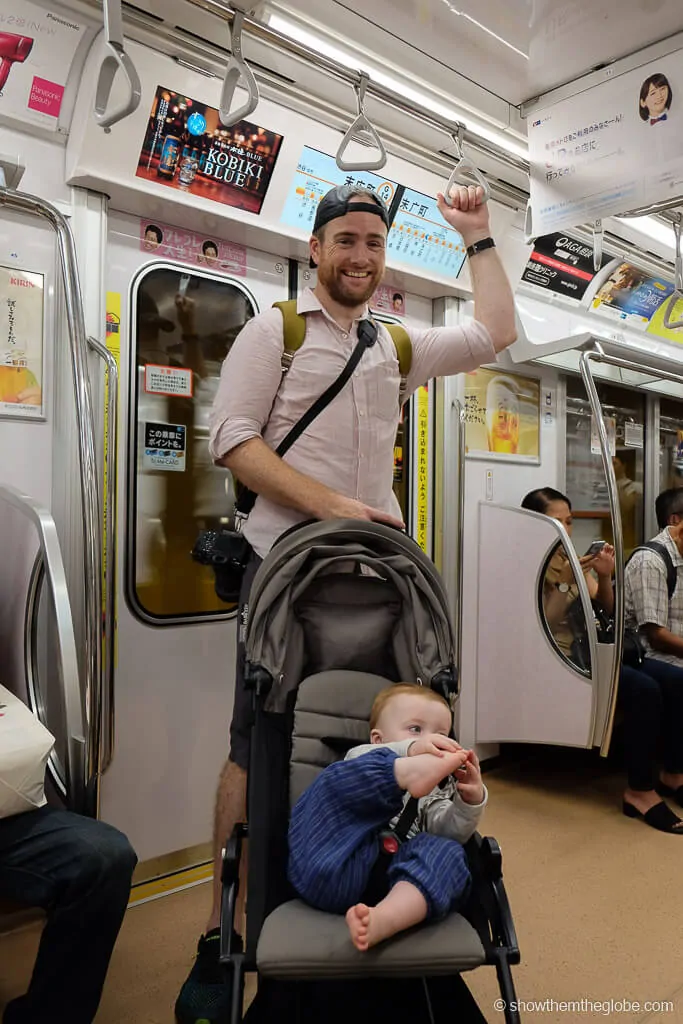
The Tokyo subway (which is made up of the Tokyo Metro and the Toei Subway) and the JR line (run by the private company Japan Railways) are the two main train networks in Tokyo. The Yurikamome Line runs to Odaiba and the Digital Art Museum and the Narita Express operates between Narita Airport and Tokyo Station, Shinjuku and Yokohama.
We found it easier to locate elevators on the JR line. It was more of challenge in the metro stations where elevators often required a lot of extra walking. We got by with a mix of our baby carrier or carrying the stroller up and down the stairs.
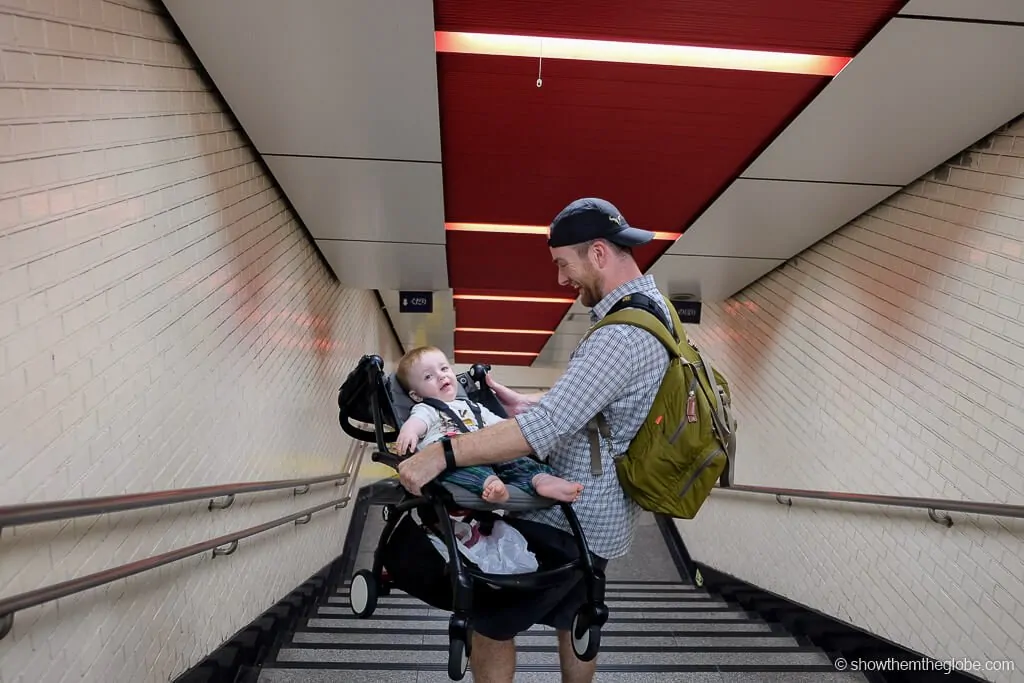
On many of the trains there are designated areas for stroller parking. However, at rush hour, it’s likely you will need to fold the stroller and carry your baby. Also, try to be conscious not to block the subway door or free seats with the stroller.
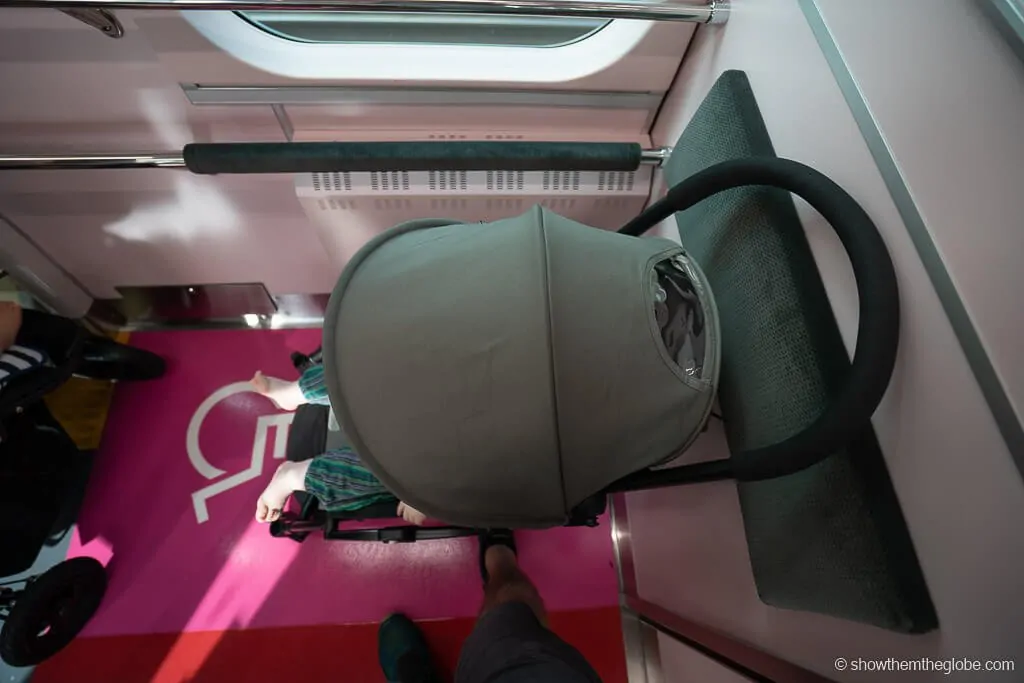
Tokyo Subway Passes
Depending on the duration of your stay, a 24, 48 or 72 hour subway pass is invaluable for navigating the city. We saved so much yen by using our 3 day subway pass for sightseeing trips rather than paying for each individual journey. The passes can be picked up at one of the designated arrival airports in Japan. The pass works for unlimited rides on Tokyo Metro and Toei Subway lines – check prices now!
Click here to order your Tokyo subway pass
Tokyo with a baby tip: To make the most of our subway pass we tried to do as much of our subway travel as possible within the 72 hour pass period. For the rest of our trip we purchased a Suica or a Pasmo card instead of individual tickets for each train ride. The rechargeable cards can be swiped at the ticket barriers and used to pay for the train fare. They work on the JR trains, the subways lines and the Narita Express. We found them much quicker and more convenient than having to find money and purchase a ticket each time we took a train.
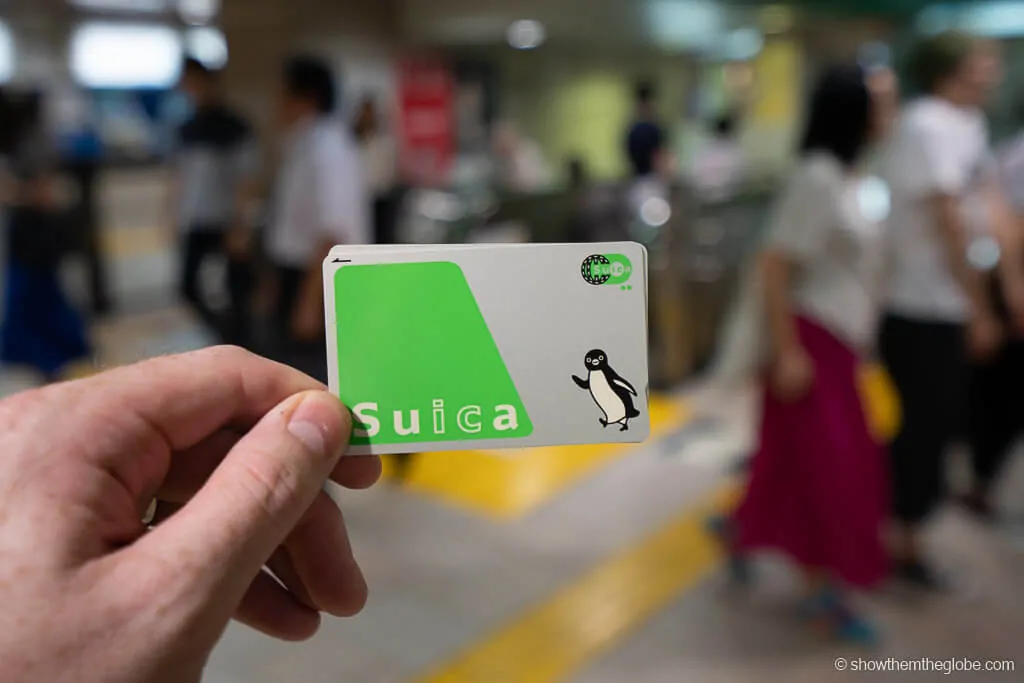
Tokyo Taxis/Cabs
Children below the age of 6 are required to travel in car seats but taxis are exempt. If you plan on grabbing a cab from the airport, you need to either bring a car seat or be comfortable taking a car journey with an infant on your lap.
Dining out in Tokyo with a baby
Tokyo is extremely baby friendly and most restaurants welcomed J – we ate at sushi joints, a gyukatsu (deep fried beef cutlets) hole in the wall, themed restaurants, high-end bakeries and even a Michelin Star ramen bar! The majority of the restaurants we ate in provided high chairs and baby plates and cutlery.
Tokyo with a baby tip: Often it is easier to eat out earlier in the day when places are less crowded and more relaxed. Lots of restaurants have counter seating but ask staff to save a booth for more space.
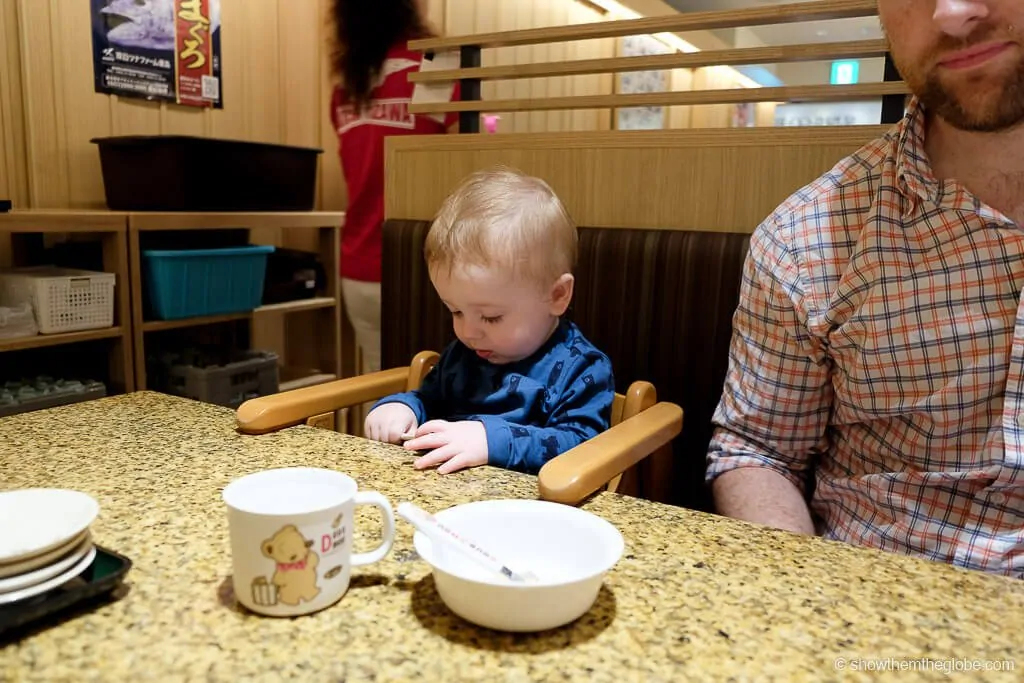
Things to do in Tokyo with a baby
Tokyo is quirky, chaotic and charming and there’s an abundance of things to do which are fun for both adults and kids. Our baby friendly recommendations include Harajuku, Shibuya Crossing, the Digital Art Museum and exploring Tokyo’s parks.
Check out our guide on things to do in Tokyo with a baby for a full lowdown!
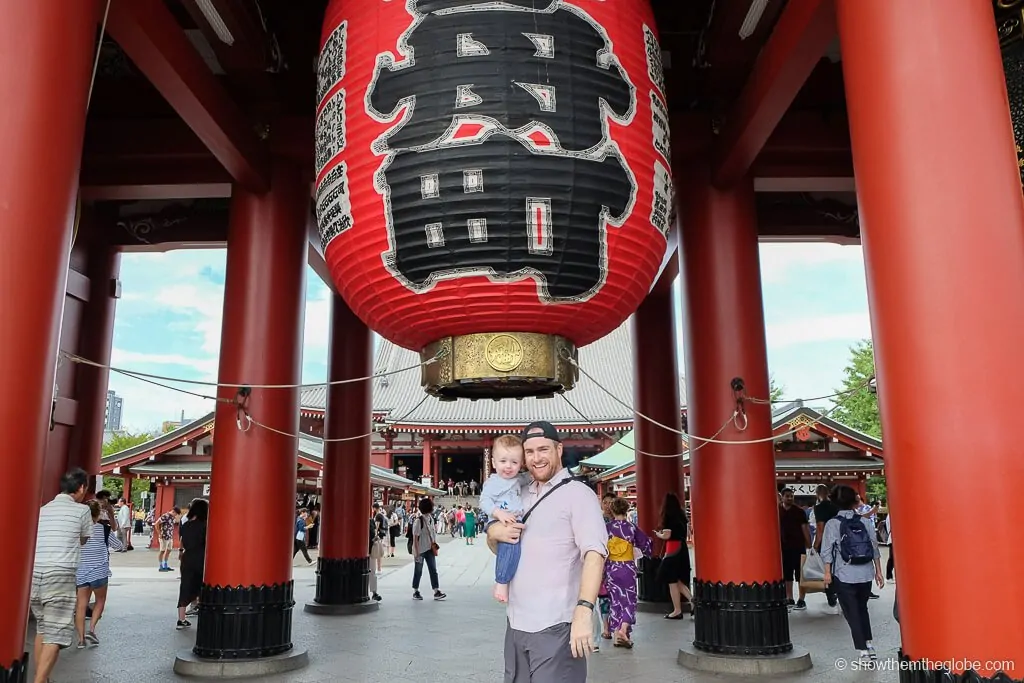
Tips for Tokyo travel with a baby
Tokyo is a world-class city and, as a result, we had no concerns traveling there with a baby. There is an extremely high standard of accommodation, transport and hygiene.
Other considerations include:
- Travel insurance: always purchase travel insurance for the baby so you have access to private healthcare in the event of illness.
- Healthcare: the standard of healthcare is excellent in Tokyo. Check with a medical professional regarding any recommended vaccinations and if they are licensed for a baby.
- Baby Supplies: it can be a little hit and miss finding baby essentials in Tokyo’s supermarkets and pharmacies. Many cater for the local office workers and convenience seeking tourists who pass through. Even the stores which did stock baby supplies tended to have limited ranges. For example, many only had diapers suitable for young babies. As such, a quick google of baby specific stores or nearby residential areas will help, as these tend to be better equipped with baby products.
- Mosquitoes: Mosquitoes are common in Tokyo’s parks and gardens as well as in the grounds of the temples and shrines. They generally make an appearance around dusk. We covered J’s stroller with a mosquito net during our evening adventures.
- Weather: Tokyo can be very hot and humid so, during these times, make sure to avoid the hottest part of the day, use sunscreen and carry water for you and baby. We arrived during a heat wave and had to be really careful that J was hydrated and protected in the extreme temperatures.
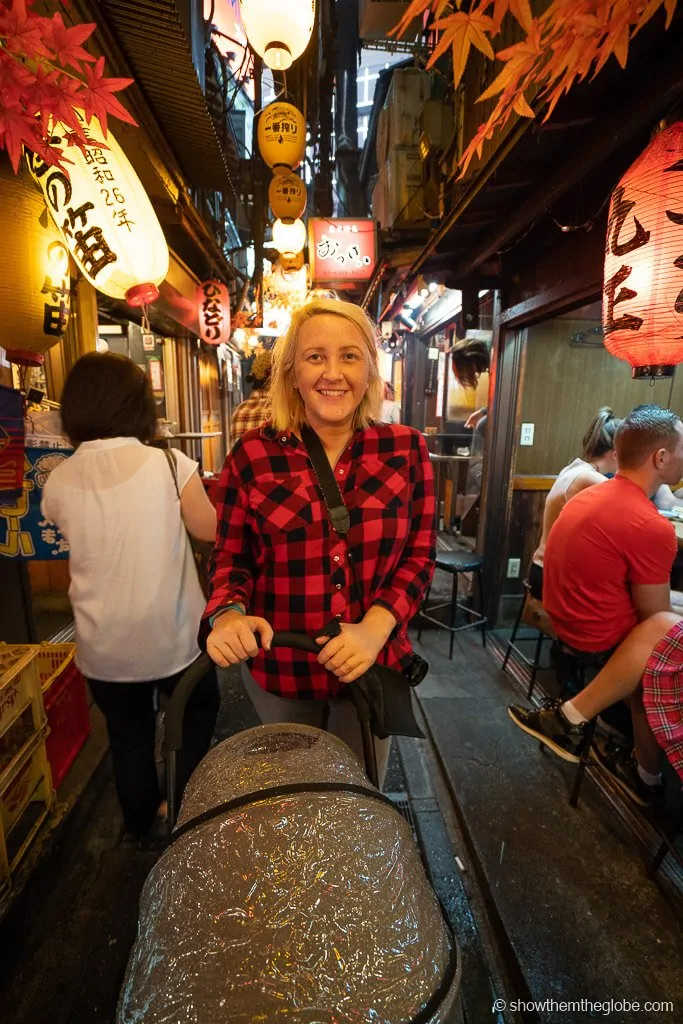
For more on Japan Family Travel
- Check out our guide on the best things to do in Hakone with kids
9 thoughts on “Tokyo With A Baby: family travel in Tokyo, Japan”
What is your recommendation for a travel cot? We are headed to Japan in June with our then 8 month old daughter. Thanks!
Hi Arielle, we used a pop up tent cot until our little guy was about 10 months (until he discovered he could use it like a zorb ball and roll around the floor in it!!). We coslept for a while on trips after that so we could save space.
thank you for sharing all your tips! We are traveling to Japan with our 15 months old baby this fall. We also have the pop up tent cot that we are tending to use, but how did you manage that in hotels? Was there always enough space next to the bed(s) to put it? Also, didn’t your baby woke up when you were in the room 🙂
Thank you for the advice! Karen
There was always space in our rooms but we made sure not to choose any super compact rooms – we use booking.com to reserve and it was usually apparent in the room pics if there was space! Not long into the trip J decided his pop up tent was more fun as a Zorb ball so we spent 2 months co sleeping!
Thankfully lights/noise don’t bother him once he goes to sleep so us being in the room wasn’t a problem.
Your blog is super helpful as we will be traveling to Japan with our 22 and 6 month old babies. Do you have a list with stores where we can find diapers for all ages? And did you buy babyfood? Or 6 month old started eating solids.
Hi, we are going to Tokyo in December with our baby who will be 7 months old. Would you recommend making reservations at all the restaurants we are going to for dinner? We booked one restaurant for a date night where we will have a baby sitter, but figured we will eat on the fly so to speak for the other days (both lunch and diner), wherever we currently are that day. Do you think that’s reasonable?
We didn’t reserve anything although we did queue in a few places. I didn’t notice a lot of places that took reservations but we eat quite casually (ramen and sushi mostly!).
Enjoy the date night! We visited Tokyo before we had kids as well and our nights out were so much fun!
We hope to head out to Tokyo with our 14 month old in a couple of weeks, are there any places you would recommend for getting baby food/restaurants that serve baby friendly food? Or do most places offer baby friendly options?
Thanks if you are able to help! 😀
I don’t remember anywhere we ate having baby friendly options. My little guy was younger and was still favoring milk over solids so we didn’t seek out places that catered to him.
Wishing you a great trip! Elaine
Leave a Comment Cancel reply
Save my name, email, and website in this browser for the next time I comment.
Disclaimer: As an Amazon Associate I earn from qualifying purchases.
Show Them The Globe is a family travel and lifestyle website inspiring you to travel more with your kids.
Signup to our Newsletter
© 2022 All images and content on this website are subject to copyright by showthemtheglobe.com

Travelling to Japan with toddlers
By: Author Wandermust Daddy
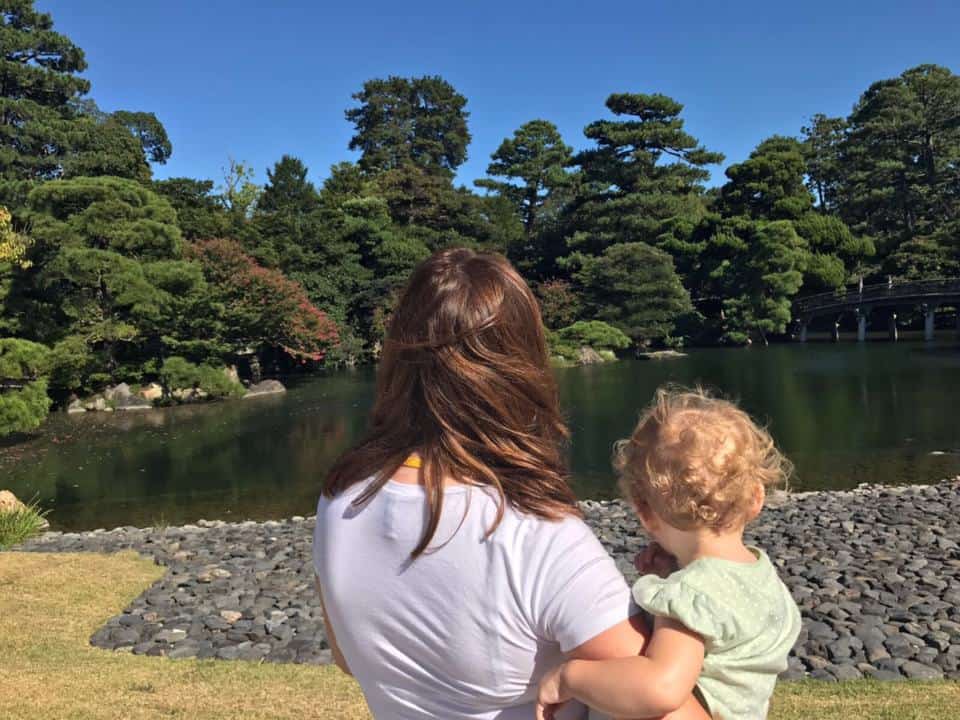
Japan is a country that had long be top of my bucket list but I wasn’t sure if travelling to Japan with toddler in tow was a good idea. I am so glad that we threw caution to the wind as it turned out that Japan was one of the best toddler friendly vacations we have ever done. In this guide up all our tips and tricks for travelling to Japan with toddlers to make sure you have as much fun as we did.
Important Note : This post may contain affiliate links which means if you click through and make a purchase I will make a small commission at no extra cost to you!
Table of Contents
Travelling to Japan with toddlers tips and tricks

Be Prepared for Jet Lag
Now if you are coming from Europe or North America for your Japan vacation then it is best to be prepared for jet lag. Now jet lag with toddlers is never fun however I actually found that my toddler bounced back quicker than I did when we were traveling around Japan. Our biggest tip is to make sure you have plenty of snacks with you, keep to the correct meal time at the correct time and most of all make sure you get outside and into the sunshine.
Move Around – Don’t just stay in one place
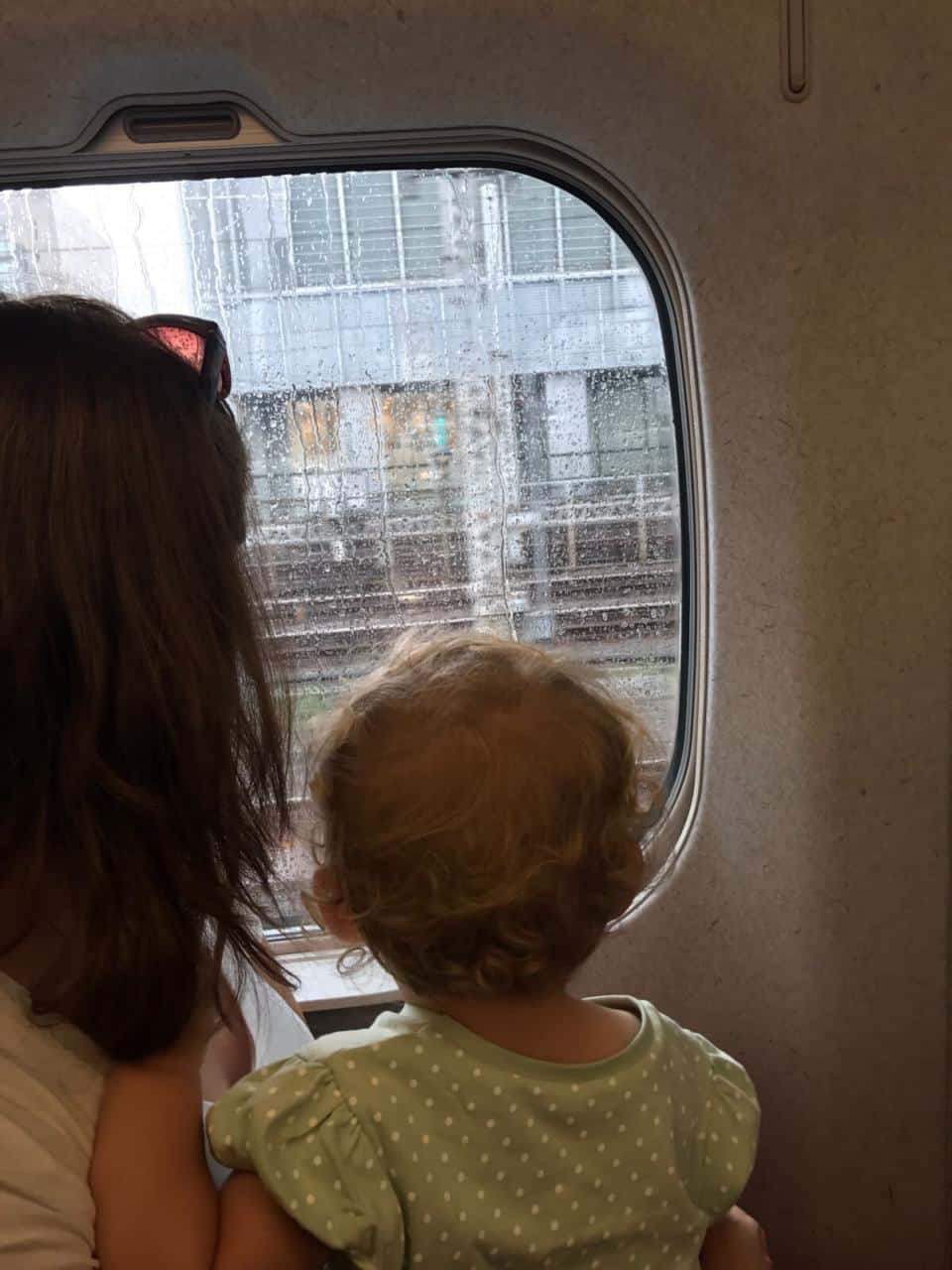
The rail system in Japan is amazing and I would definitely say that it is worth even if you are only in Japan for a week to sample at least two locations. The obvious two are of course Tokyo and Kyoto and they are two completing contrasting sides of Japanese life. But..
Don’t move around too much
Now that we travel with a toddler we have started to embrace slow travel. We find that two locations in a week is more than enough. It can be so tempting especially in Japan with the amazing transport system and bucket list worthy attractions to try and cramp as much as possible into your itinerary. However I would advise limiting how much you travel around and change accommodation on your Japan with toddler itinerary .
TOP TIP : Also while for most couples and solo travellers in Japan who plan to move around a lot the JR Pass can be a definite budget saver however if you are looking at only doing one or two big journeys on the trains I would advise doing the calculation as it might not be a cost saving to you. But be sure to factor in the cost of day trips too.
If you are traveling to Japan with a baby instead of a toddler check out this guide.
Take Day trips
To get as much in your Japan itinerary with toddlers I would advise to consider taking some day trips rather than having to pack everything up every couple of days. Osaka, Hiroshima, Nara and Arashiyama all can be done as day trips from Kyoto while Yokohama, Disney, Hakone and more can be taken as easy day trips from Tokyo with kids.
Avoid Rush Hour if you can
Although the Japanese rail system is amazing, the subway can get extremely busy at peak times especially if you are trying to carry a toddler or stroller around with you. My advice is try and avoid the Tokyo rush hour on the subway if you. We did things in walking distance to our hotel first thing in the morning so we were hopping on the subway once the commuters had all started work which definitely made things a lot easier.
Eating with Toddlers in Japan

Perhaps my biggest concern about traveling to Japan with my toddler was eating out. However we actually found that my child had a relatively good diet while we traveled around Japan but there are a few things that helped.
Try the cuisine at home first
We prepared our toddler for Japanese cuisine by letting her sample a few of the flavours before we went. By the time we were in Japan she was quite happy eating noodles and Katsu.
Don’t expect a plentiful availability of high chairs
Now those of us from Europe and North America might be used to all restaurants having a provision of high chairs however don’t expect this to be the case in Japan. We found very few restaurants had high chairs so we packed a fold up fabric high chair which can covert any chair into a high chair which was very useful. On occasions where we didn’t have this with us she just sat on our lap during the meal.
While we didn’t eat at any high end places we did find that everywhere we went was more than happy for us to take our toddler in and on many occasions the waiting staff are extra helpful with our little one.
Food and Fussy Toddlers in Japan
As I mentioned if you can try and get your toddler used to some of the Japanese food staples before you go it will help but if you have a fussy toddler fear not we found plenty of Pizzas restaurants and places that had more familiar fare.
Japan with toddlers Packing List
Should i use a stroller in japan .
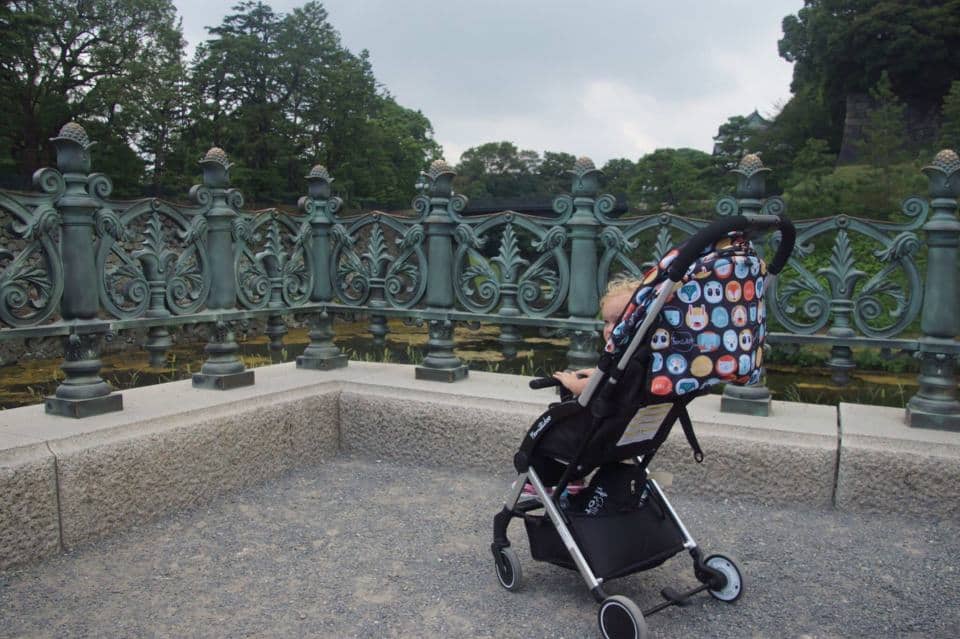
Before we went to Japan I was unsure about taking the stroller with us. I was concerned about how easy it would be to manoeuvre around the busy city and subway of Tokyo with a stroller and wasn’t sure we would use when at temples and shrines as many have uneven ground or steps. But let me tell you we were really glad we did take it. We used it in both Kyoto and Tokyo with our toddler and it was a lifesaver for a toddler with jet lag. My only advice is to be sure that you take an umbrella stroller with you that collapses down to almost nothing as it will be needed if you get on a crowded subway etc. We used this one and it was perfect for our needs.
For a more complete guide of using a stroller in Japan check out this post.
Should I take a Carrier to Japan?
But even if you like us decide to take a stroller to Japan, I would also recommend taking a carrier. We travelled to Japan in August and September and it was crazy hot so my only advice would be to take the right type of carrier with you. If you are traveling in summer make sure it is a hot weather carrier that has extra breathability to make you and your toddler more comfortable.
Next Read: For more information on traveling to Asian countries to visit with kids check out this post.
What are the best places to visit in Japan with toddlers
Tokyo with toddlers.
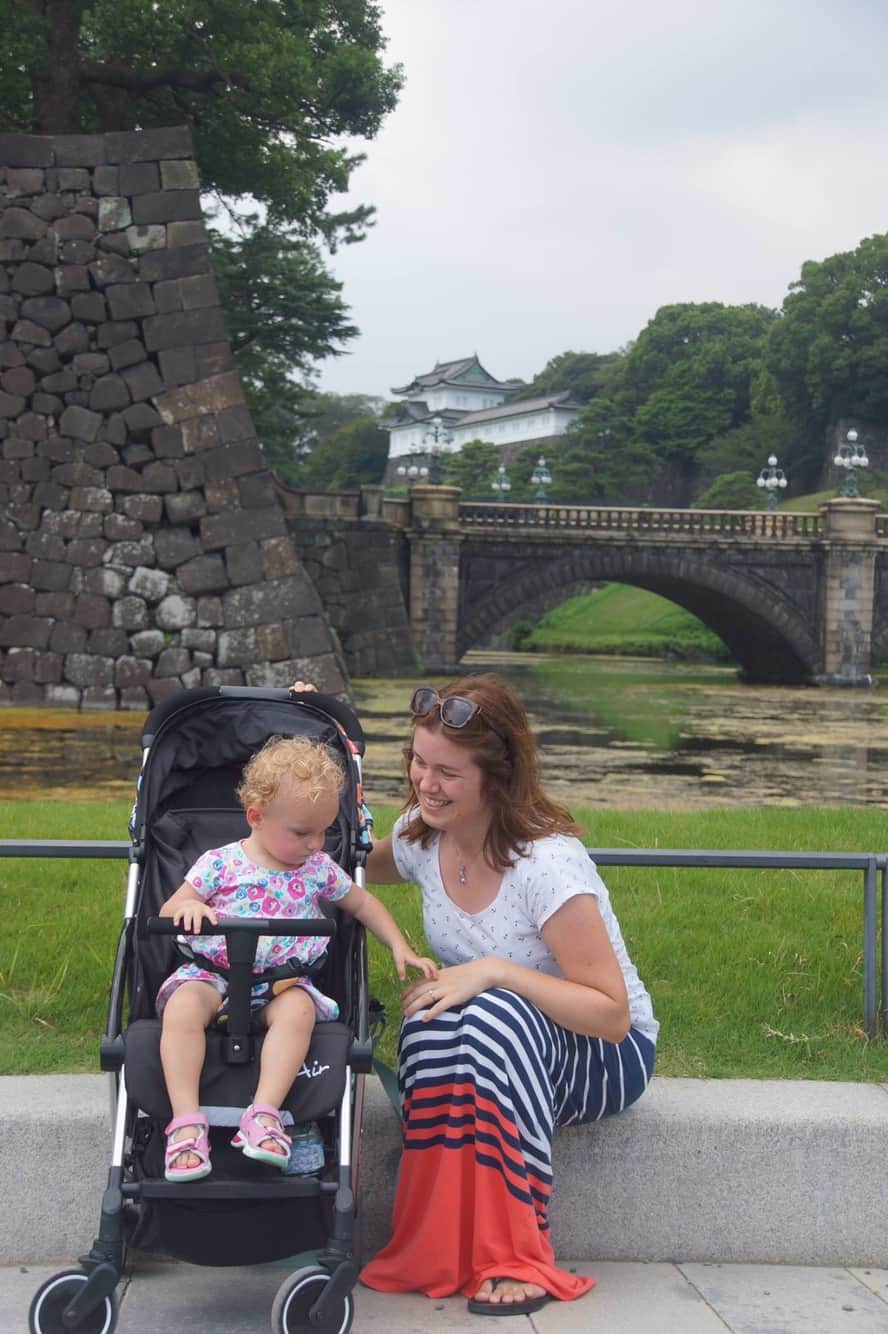
No Japan itinerary is complete without visiting Tokyo. The capital of Japan and the busiest place we went during our trip but not to be missed out. Tokyo has plenty of toddler friendly attractions including the Borderless Teamlab digital art museum, the two Tokyo Disney resorts and plenty of gardens and parks that will keep your toddler entertained. I would recommend spending at least 3 days in Tokyo.
Be sure to check out our Tokyo with toddlers guide for more information on conquering this city with toddlers.
Kyoto with toddlers
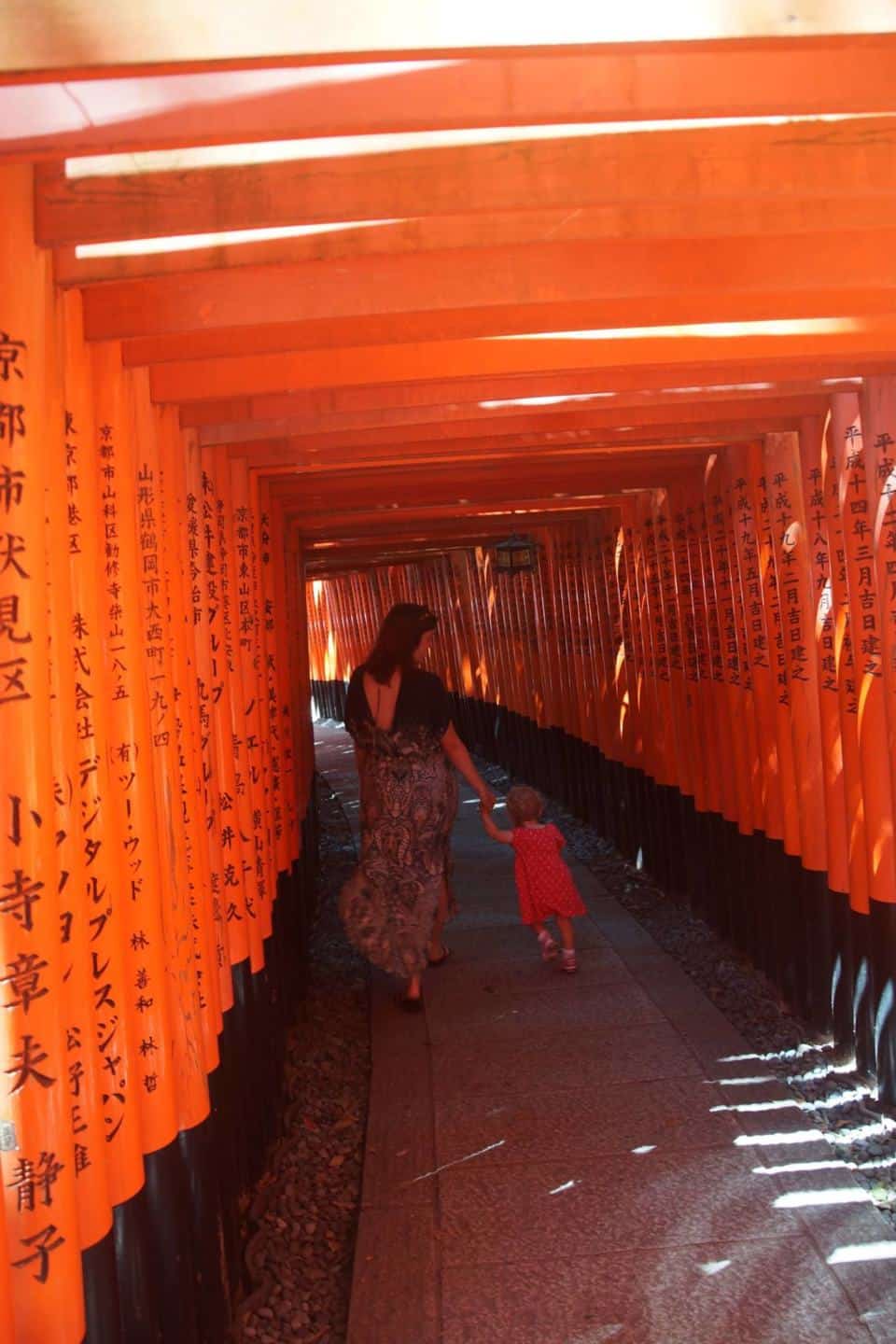
Like Tokyo, no Japan itinerary is complete without a visit to Kyoto. Kyoto is the historic capital of Japan and the cultural heartland. I would personally that you should allocate a minimum of 4 days in Kyoto to make sure you cover all of the main cultural attractions.
For a full guide on what to do on Kyoto with kids click here.
Osaka with toddlers
If you are traveling to Japan with toddlers I would personally recommend either staying in either Osaka or Kyoto as they are quite close together and can easily be done as day trips and will save you having to take luggage and all your toddler paraphernalia to a new location.
We opted to stay in Kyoto as it had more of the things we wanted to see (Gion, Fushimi inure Tashi and the golden pavilion to name but a few) but this is really a personal choice so I would advise picking the one you think you will be spending the most time in for your base location.
Nara with toddlers
Again, this is an easy day trip from Kyoto and while toddlers will love seeing the deer in Nara I think it makes a better day trip from Kyoto than as your base.
Hokkaido with toddlers
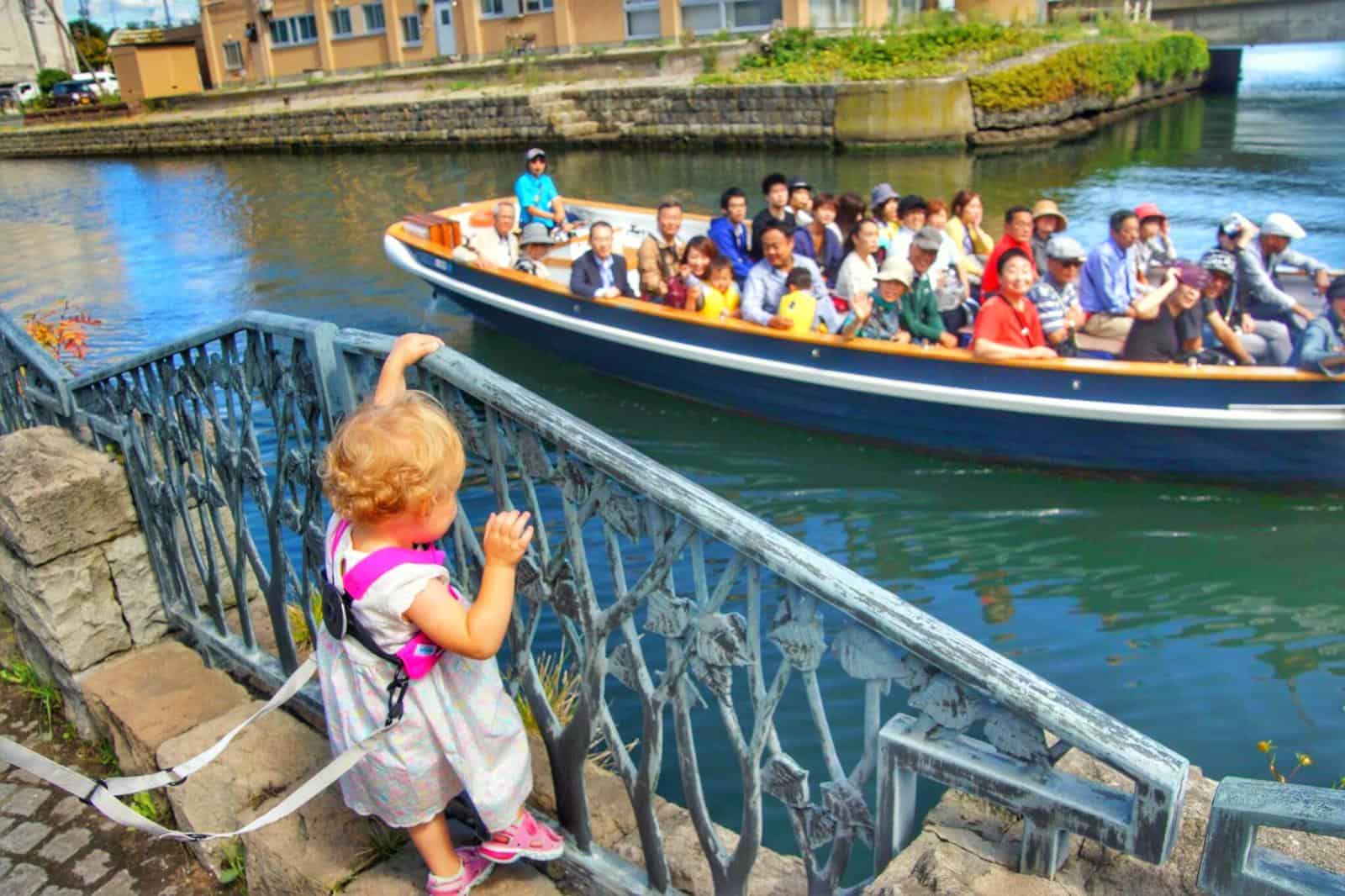
We spent over a month in Japan so decided to head up to Japan’s most northern island of Hokkaido. We loved visiting H okkaido with kids as it is much quieter than the island of Honshu and has lots of things that toddlers will enjoy doing such as the zoo in Sapporo, the ice festival – if you are there in Winter, as well as beautiful flower fields etc.
I wouldn’t advise going to Hokkaido on your first visit to Japan especially if you are short on time but if you are a repeat visitor or like us are in the country for an extended amount of time it is definitely worthwhile. Check out our guides on the best time to visit Hokkaido and our Hokkaido itinerary for more information.
Okinawa with toddlers
We didn’t make it to Okinawa with our toddler but it is currently near the top of our Japan Bucket List . Okinawa still has loads of cultural things to do but the attraction for me is to see its beautiful beaches. Hopefully I will be writing about a trip to Okinawa soon!
Have you been to Japan with toddlers? What were your favourite things or top pieces of advice?
Tuesday 2nd of January 2024
We can't wait to travel to Japan. We love to find children's books to read before the trip - and here are some of the great kids books I've found to get them excited about traveling to Japan: http://storybooklists.com/country/storybooks-with-japan/
Valerie Sattkowski
Wednesday 23rd of August 2023
This is an amazing guide! How old was your toddler when you traveled to Japan and what age would you recommend? thanks :)
Wandermust Daddy
Wednesday 6th of September 2023
Ours was 18 months old when we went and it was lots of fun but obviously depends on toddler. My son, we are taking later, more like 3 as he would have been more fazed by some of the attention
Tuesday 21st of March 2023
Hi! How old was your toddler? Do you recommend the same advices with a 2 year old?
Also - how trick were you with bedtime? I figure it would be hard to fully enjoy Japan if bedtime is at. 7:30-8 every night!
I spent 6 months in Japan before on my own and wanted to visit it again with my husband and baby!
My lo was 18 months old. We did largely stick to early bedtimes but on some nights she slept in the stroller. I would def go again even with a toddler
Sunday 19th of January 2020
Vous êtes simplement Génial! Avec vos astuces, je crois qu'en été prochain, c'est Tokyo qui nous servira de refuge ma famille et moi. Merci et bonne continuation.
- Recipe Index
- Disclosure & Privacy Policy
- Work with Me
Part 1 – Planning the Ultimate Baby-Friendly Holiday to Japan

We recently had the most amazing trip to Japan with our 10 month old baby. A lot of people told us we were brave or crazy to embark on such an adventure, but it went surprisingly well! Don’t get me wrong, travelling with a baby is definitely a lot more stressful and requires a lot more planning, but with a lot of prior organisation (and low expectations), we ended up having a wonderful family holiday.
I shared a lot of our trip via my Instagram stories and received many messages from both mums and non-mums alike begging for a blog post to share my itinerary, tips and tricks. In Part 1 I discuss how we got there, plane tips, and what to pack. In Part 2 I share our full itinerary including where we stayed, where we ate and what child-friendly activities we got up to.

How to get there
To get from where we lived in the Inner West in Sydney to the international airport, we booked a ride with Shebah . I have used their services before and they are absolutely fabulous, I call them lady Uber. All the drivers are female and most importantly, you can pre-book a car seat. The trip was much cheaper than driving our own car to the airport and leaving it in the long-term carpark.
We flew with Qantas direct from Sydney to Osaka on the way there, and from Tokyo (Haneda) on the way home. It is slightly cheaper to fly in and out of the same city, but since time was precious and we didn’t want to back track, we decided to go the open jaw option. I called up 8 weeks out to reserve a bassinet and luckily received one both ways – there were a lot of families flying and many missed out so we were very fortunate to have the extra space. Having said that, she hated sleeping in the bassinet and mainly slept in my arms, but it acted as a great play pen when she was awake. Reserving a bassinet is different with each airline, so make sure you enquire as soon as you book. And bear in mind there are strict height and weight regulations – Zsofia only just fit in lengthwise, and I fear if we had flown even a month or 2 later she would not have fit comfortably.

How to cope with a baby on a flight
Zsofia was pretty amazing on both flights. The flight to Osaka was a day flight, and I’m not going to lie, it was LONG. At around 9-10 hours from Sydney, the first half went reasonably quickly, until she got sick and tired of being in a metal tube and overtired (yay) and then she required a bit more effort to keep calm and happy. Some tips that were shared with me before we left:
- Feed on the way up and down in the plane to help their ears. The sucking reflex helps with the pressure, whether it be sucking a boob, bottle or dummy.
- Bring spare changes of clothing – for bub and you! There is something about the pressurised cabin which seems to do weird things to baby bowels. Zsofia did 3 poos within the first 2 hours of the flight, one which required a complete outfit change.
- Bring more nappies than you think, and put together a small change mat, wipes, scented bags and cream in a small nappy bag. There is literally no room in airplane toilets and trying to change a wiggly baby is less than fun. Make sure you and your partner know exactly where everything is so you are not unnecessarily fumbling around in the toilet.
- Bring some toys she’s never seen before and bring them out one by one throughout the flight. They don’t even have to be proper toys – an empty plastic water bottle is very fun to a baby!
- Bring lots of snacks. We packed yoghurt pouches, baby crackers, blueberries, savoury pouches and rusks.
- Keep on boobin’ – I am still breastfeeding which was an immense help on the flight. It she was upset, tired or just plain bored, I popped her on the boob to soothe.

Getting from the airport to your hotel or Airbnb
Things get somewhat more complicated when you have a baby as previously I would normally jump in an Uber or taxi to get quickly to my hotel after a long flight, but that’s not an option when you have a bub. We left our car seat at home as we had no plans to hire a car, so public transport was the way to go. If you can, try and book your accommodation as close to a main train station as possible. When we landed in Osaka, we caught the airport train from Kansai to Namba and then our hotel was just a short walk from there.

Getting around Japan
The rail system in Japan is so efficient, clean and widespread that I highly suggest using it as your main means of transport around the country with your babe. Purchase a rail pass before you leave – and please make sure you leave sufficient time for it to be processed and delivered to you (at least a week) which I did not do! Fortunately I was able to go to JTB office in Sydney and get it processed on the spot for a small fee. The rail pass is activated once you arrive in Japan, and is available in 7, 14 and 21 day options depending on the length of your trip. There are some restrictions with the rail pass (for example it can not be used on certain bullet trains such as Nozomi and Mizuho) but apart from that it is an affordable and easy way to travel around Japan. We also caught the subway frequently in various cities, as well as the tram in Hirsohima and bus in Takamatsu. All were pram friendly and locals were happy to get out of the way to accommodate our pram, bags and suitcases.

Accommodation in Japan
Japanese hotel rooms are notoriously small and that causes problems when travelling with a baby as a) can you even fit your travel cot in there and b) when they go to sleep at 7pm what on earth do you do?! Sit quietly in the dark for a few hours?
After a lot of research I decided the best options for our budget would be a combination of Airbnb and Aparthotels. The benefit of using the aforementioned styles of accommodation means you get a separate lounge room to the bedroom, meaning you can pop bub down to sleep in the bedroom and then retire to another room to eat dinner, read or watch some Netflix.
As for the travel cot issue, we co-sleep so that wasn’t a problem for us and we left ours at home. Japan is very co-sleeping friendly – in one apartment we were provided with a bed rail, and in one Airbnb they provided her with a little futon to sleep next to us (aww).

Breastfeeding in Japan
The Japanese are very discreet about breastfeeding in public. I am used to getting my boob out wherever and whenever at home, so I wanted to be mindful of respecting their wishes. I made sure to pack plenty of feeding-friendly tops with zippers and buttons for easy access, and brought along my nursing cover. As Zsofia wasn’t used to being fed while covered, she HATED it. The second I put it over her she would thrash about and whip it off, leaving my boob exposed and milk spurting everywhere. Apologies to everyone who saw that!

So I quickly became a lot more tactful with my feeds and tried to plan being around a department store/shopping centre when she was due for a feed so I could pop into one of their lovely feeding rooms. This of course didn’t work when we were out on a day trip to a shrine or island, so I would feed her in the carrier with a muslin cloth draped over, or find a discreet corner to feed.

Buying Baby Supplies in Japan
I packed like we were going into the wilderness for 3 weeks – a full packet of nappies, wipes, countless baby snacks, food pouches and more. I filled up almost an entire suitcase! And despite it being quite annoying to lug around I actually don’t regret it as it was nice for her to have familiar comforts, smells and tastes from home. We ran out of nappies and wipes a few days out from returning home and had no problems buying more from a chemist.
The baby food was a bit more difficult though. In Australia you can buy a lot of baby foods at the supermarket and I could barely find anything! I would purchase some cheese sticks and small tubs of yoghurt along with fruit and vege but that was about it. At the smaller chemists I also struggled to find much and the stuff I did purchase was frankly gross (I thought I had bought her a fruit puree pouch but it was a very sweet jelly.)

In the big chemists I ended up finding her a few more savoury jars of things – turns out she loves Hokkaido corn puree! But there are quite a few Japan-specific flavours she didn’t love like seafood. We tried to just share our own foods with her so she ate a lot of karaage chicken (with the batter removed), edamame beans, omelette, rice and even some seaweed.
What to Pack
I have never been a packing cube kind of person until I had a baby. So my main tip for travelling with a baby is EMBRACE THE CUBE! Babies have so many bits and pieces and keeping them sorted in separate compartments makes finding everything so much easier. I had a cube for onesies/pyjamas, a cube for tops and pants, a cube for bibs and socks etc.
As tempting as it is to pack elaborate outfits (let’s be honest, mainly for photo opportunities) I highly recommend keeping clothing simple with easy access for on-the-go nappy changes. On travel days we just dressed her in a long sleeved onesie with a double zip, and otherwise she was usually in a short sleeve onesie with snaps and some leggings over the top.
I ended up packing 10 onesies (that doubled as pyjamas) and 10 outfits even though we were going for almost 3 weeks. I knew several of our Airbnbs had washing machines so we ended up doing 2 lots of washing all up. I also packed her a cardigan, a warmer jacket, a dress, a few pairs of socks, several bibs and 2 hats. Fortunately as we travelled in October, the weather was quite moderate and I didn’t need to pack too many heavy clothes.
Make sure you bring sufficient medication for yourselves and bub (such as baby Panadol and baby Nurofen) as I found it so hard trying to find the correct medications once there. It seemed they only sell (adult) Ibuprofen with caffeine in it?! Whilst English is widely spoken in bigger Japanese cities, I did bump into a poor Aussie lass who was trying to explain she needed to buy tampons through charades to a local pharmacist who spoke little English. It did not go well.

What we checked in at the airport:
- 2 suitcases (filled with all our clothes, toiletries, baby supplies)
- 1 travel pram (we also managed to fit our entire packet of nappies, some wipes, and a blanket into the travel pram’s carry case!)
What we carried:
- 1 x nappy backpack (2 changes of baby clothes, spare tshirt for me, nappy bag, change mat, wipes, snacks, baby panadol etc etc)
- 1 x Zol’s backpack (laptop, wallet, books, water etc)
- Zsofia in the baby carrier
Once we arrived at our destination, we put the pram up, stashed the carrier and nappies underneath and popped Zsofia in the pram. Then Zoltan was in charge of the 2 suitcases and his backpack and I pushed the pram and wore the nappy backpack. It actually worked quite well!
How baby-friendly is Japan?
In short – very! Locals are so friendly when you have a cute baby attached to you. There were many, many “Kawaii!’ exclamations and requests for photos. Japan is extremely clean and their parents rooms are an absolute treat. Head for a department store or shopping centre for excellent facilities including change tables, futuristic nappy disposal units, feeding rooms and play areas. I also loved that there were changing tables in the male toilets and small urinals in the female toilets – very progressive compared to Australia! Another thing I loved were the baby seats in the toilet cubicles – it was a safe place to put your bub while you could pee handsfree. What a treat.

Baby carrier or travel pram?
We brought both and barely used the travel pram! The pram was great when going from one destination to the next, as mentioned above I would push Zsofia in the pram and wear the backpack whilst Zoltan would drag both suitcases. But when we were out and about during the day we would just pop her in the carrier as it was so much easier. She loves to nap in there, and if we were visiting shrines or other locations with steps/cobble stones it was so much easier to just carry her. It also made it much easier to quickly jump on a train or subway as we weren’t running around with the pram trying to find the lift. By the way – Japanese prams are tiny, so don’t bother lugging your giant Bugaboo over!

If your baby is a pram-fan, I highly recommend the Baby Jogger City Tour Lux . It’s lightweight, the seat can face both ways and it folds down into a backpack which can fit in the overhead bin on planes (although please double check with your airline first!)

If you prefer carrying your baby, you can’t beat the Ergobaby Omni 360 carrier . I use it all the time at home and when away. You can have bub facing you, facing outwards, on your hip or even as a baby backpack! The lumbar support this carrier offers really helps with avoiding lower back pain and I can wear her all day without much discomfort.

If you are keen to use a carrier or travel pram on your next trip but don’t want to fork out all that money, I highly recommend checking out Kindershare . It’s a site where you can rent your baby item from a local family from $10/week!
I hope this post has helped you with planning your trip to Japan with a baby or toddler! If you have any more questions, please feel free to comment. Stayed tuned for Part 2 where I share my itinerary, things to do with a baby in Japan and where to stay!

You Might Also Like

How to eat cheaply on holidays

Bespoke Letterpress and The Press Shop, Bowral

Billabong Retreat – A yoga and meditation holiday in Sydney
I love it when I get a detailed peek of what a trip needs. I know deep down that I am ready to make a trip to Japan any day, knowing that you have made it quite easy for me. Thank you so much for sharing and helping fellow moms.
You are so welcome! Hoping you can do a similar trip once Covid is over!
What happened to part 2? Can’t find it on your page
Covid happened! I paused writing part 2 as Japan had shut their doors to tourists – but now I am working on getting it written ASAP :)
I also keep checking back to see if part 2 is up yet! Loved part 1 and we’re trying to work out if we want to go to Japan while I’m on maternity leave next year :)
Ok this is good motivation to get me writing Sarah! I am about to go on maternity leave again, and hopefully can find some time in bub’s naps to finish it :)
Leave a Reply Cancel Reply
Get the latest posts and a free mini recipe book delivered straight to your inbox.

31 Best Things to Do in Tokyo with a Baby or Toddler
Tokyo is a great destination for families with babies or toddlers. You will feel absolutely spoiled by the facilities as they’re all family-friendly and designed with convenience in mind.
Public playgrounds have clean family restrooms. Every mall is stroller-friendly and has nursing facilities. Most restaurants have kid’s meal sets and highchairs. The cities themselves are incredibly clean. It’s one of the absolute safest countries in the world. And best of all, Disneyland exists!
Aside from this guide, check out our resources for traveling in Japan with your baby:
- Where to buy baby formula in Japan
- Where to buy baby diapers in Japan
- The best family-friendly hotels in Tokyo
Best Tokyo Tours that are Baby and Toddler-Friendly
- Mt. Fuji Scenic Bus Tour from Tokyo .
- Studio Ghibli Museum Tour .
Best Baby and Toddler-Friendly Museums in Tokyo
1. mori building digital art museum by epson teamlab borderless.
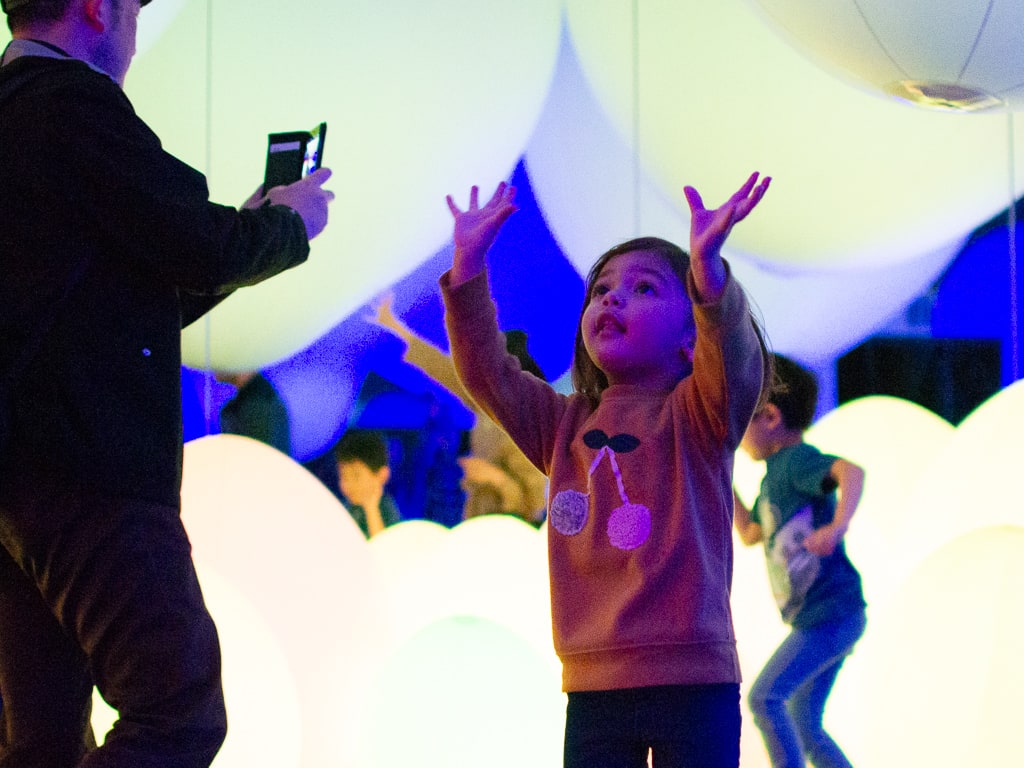
Your babies will love this digital art museum. It’s designed to flood your senses with lights, sounds, and texture. Note that strollers are not allowed so bring a baby-carrier.
Make sure to get your tickets here in advance as they sell quickly within the day.
→ Click here to book your tickets to the teamLab borderless
Getting there: 5-min walk from Aomi Station
2. Ghibli Museum
A trip to Tokyo with kids is never complete without a visit to the Ghibli Museum, which showcases the work of the famous Japanese animation studio, Studio Ghibli. Its museum is like walking into one of its animated films with facilities such as a Bouncing Totoro 3D zoetrope and a Cat Bus room on the 2nd floor.
There are also baby-friendly facilities and a nursing rdoom available on the 1st floor for those bringing toddlers and infants. This is no exaggeration but Ghibli Museum tickets are easily sold out so you have to make sure to book way ahead of time.
→ Click to learn on how to book your tickets to the Ghibli museum in advance
Getting there: 15-min walk from Mitaka Station or Kichijoji Station
3. National Museum of Nature and Science
The National Museum of Nature and Science is one of the biggest science museums in the country with over 10,000 exhibits. Among these are authentic artifacts that include the stuffed body of Hachiko and two famous pandas.
For the little ones, there is a ComPaSS exhibition room on the 3rd floor, designed for kids aged 4 to 6 although kids 0-12 years old can still enter. For parents bringing small kids, a diaper changing table can be found on each floor. A nursing station is also located on the floor B1 of the Japan Gallery.
Three strollers are also available for rent at the Central Information Desk.
→ Click here to learn more about the National Museum of Nature and Science
Getting there: 5-min walk from Ueno Station
4. National Museum of Emerging Science and Innovation (also known as Miraikan)
More popularly known as the Miraikan, this museum is most appealing to families with young children because of the variety of fun yet educational activities that it offers. Its main exhibits can be found on the 1st, 3rd and 5th floors, with the one on the 5th having themed sections: Earth, Lab, Life, and the Universe.
It also has a baby-friendly cafe on the 5th floor and a theater on the 7th. For families bringing infants or toddlers, strollers can be rented but there are only four available inside the museum. There are also 11 diaper changing facilities inside as well as a nursing room behind the cafe on the 5th floor. Free admission for kids on Saturdays. Free admission for preschoolers.
→ Click here to get discounted tickets
Getting there: 4-min walk from Telecom Center Station
Best Indoor Play Spaces for Babies & Toddlers in Tokyo
5. sanrio puroland.
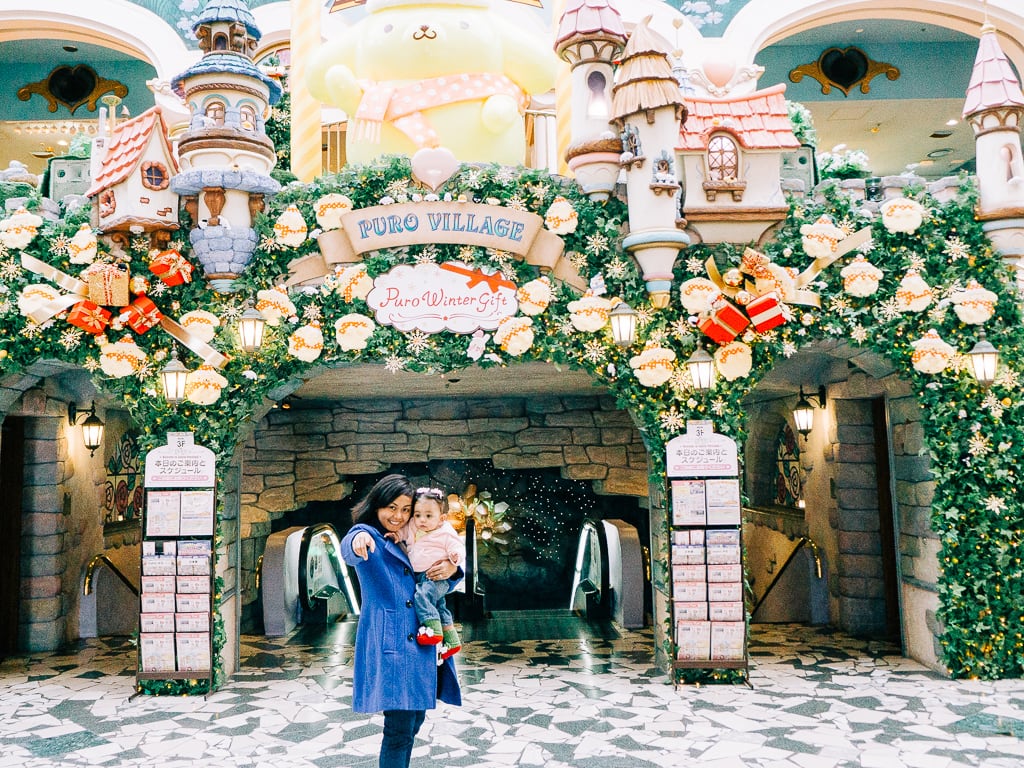
This place has everything Hello Kitty including fun rides, parades, restaurants, souvenir shops, and more Sanrio Puroland is pretty much designed to be extremely baby-friendly. All restrooms are equipped with diaper changing table.
You can head to the Baby Center on the 1st floor where there are more changing tables, children’s toilets, tables, baby food, and nursing rooms. Take note though, strollers are not allowed on the 1st and 2nd floors where it is uneven. So it might be best to use baby slings and carriers in Sanrio Puroland.
→ Click here to get discounted tickets to Sanrio Puroland
Getting there: 10-min walk from Tama Center Station
6. Roppongi Hills Mori Tower Tokyo City View & Sky Deck
→ Click here to get tickets to Mori Tower & Sky Deck
Roppongi Hills itself is a very family-friendly area. Why not visit the Mori Tower Sky Deck? Kids 3 and under are free of charge!
Getting there: 9-min walk from Roppongi Station
7. Duplo Village in Legoland Discovery Center
Lego toys might be a pain to step on and clean up after but if it’s helping your kids develop their motor skills and imagination, it’s really such a small price to pay. Located inside DECKS Tokyo Beach Mall, The Duplo Village is truly made just for toddlers – adults cannot get in if they aren’t accompanied by kids.
Families will also love this place because it has complete amenities such as a family restroom, diaper changing areas, and stroller accessibility. Be sure to book ahead because they only allow a limited number of visitors each day.
→ Click here to get EXCLUSIVE discount to Duplo Village Tokyo
Getting there: Duplo Village is located in DECKS Tokyo Beach Mall, which is a 5-min walk from Tokyo Teleport Station.
8. Aneby Trimpark
If you are a parent who chose the Montessori way, you will love Aneby Trimpark. Aneby Trimpark has every play equipment and activities for infants to 12 years old.
9. Asobono in Tokyo Dome City
Asobono has a kids toilet and a breastfeeding room. The toilets have 2 sizes for 1-2 years and 3-6 years. The breastfeeding room is equipped with two large sofas and two diaper tables. They also provide water which can be used for milk formula.
Getting there: 10-min walk from Suidobashi Station
10. Tokyo Toy Museum
A few minutes walk from Yotsuya San-Chome station, the Tokyo Toy Museum was originally an elementary school that was converted into a museum to house various toys and games from all over the world. It now has several rooms with different themes, and there’s an attendant who will help you figure out the toys and games.
Among everyone’s favorite room is the baby room which comes with various wooden toys that they can play and interact with. Parents will love the fact that the room also has changing and nursing facilities available.
Getting there: 6-min walk from Yotsuya San-Chome station
11. Amazing World (various branches)
From its name, the Amazing World is an all-weather indoor play facility for families. It can be found in many locations all over the country. The place has several facilities that allow kids to explore and pursue their interests, catering to all senses. They have a baby corner especially for kids 0-2 years old, as well as space for changing diapers and breastfeeding. Diapers can be bought at the reception desk.
12. Hakuhinkan Toy Park
While Ginza is better known for the high-end fashion boutiques that line up its streets, it actually has a huge toy shop that’s open all year round. The place is a haven for the kids and kids-at-heart with more than 200,000 toys – party goods on the 1st, stuffed animals and traditional Japanese toys on the 2nd, infant and young kids’ toys on the 3rd, video and card games on the 4th.
There are also restaurants on the 5th and 6th and a theater on the 8th floor. Parents and babies are free to test some of the toys on display. For those bringing infants and toddlers, the nursing room is located on the 4th floor. Admission is free.
Hakuhinkan Toy Park is about a 5-min walk from Shimbashi Station .
13. Lego Clickbrick, Roppongi
We can’t deny the fact that they’re really great toys, especially for encouraging kids’ imagination and creativity. The Lego Clickbrick in Roppongi Hills is full of all sorts of Lego pieces that they can mix and match.
There is even a Lego School nearby where kids can enroll in Duplo building classes as well as more advanced ones involving programming and robotics. Lego Clickbrick is located on the B2F of Roppongi Hills mall, about a 7-min walk from Roppongi Station.
Getting there: Located on the B2F of Roppongi Hills mall, a 7-min walk from Roppongi Station
14. Kid-O-Kid Bornelund in Kawasaki
The Kid-O-Kid Bornelund has various locations throughout Japan but the closest first-rate Kid-O-Kid Bornelund branch is located in Kawasaki City which is 35 minutes train ride from Tokyo. It features various rooms with different themes, toys, and features.
The little ones can enjoy the jumping castle and ball pit, among many others. If you are tagging along with your baby or toddler, there is also a space where they can crawl or even climb structures.
Getting there: Located inside Le FRONT shopping mall, a 5-min walk from Kawasaki Station
15. Ai Port Station
Located in Aoyama, Ai-Port Play Center is a multi-purpose community facility which is super convenient for busy parents. It comes with both indoor and outdoor play areas, a childcare facility as well as a child-raising advice center.
This community space is basically one huge living area with three components: the Hidamari, filled with wooden toys, books and a play kitchen; Aoba; and the Kids’ Garden located outside. They make the perfect place to have play dates in Tokyo.
Getting there: 2-min walk from Exit 1B of Gaienmae Station
16. Akasaka Kids and Teens Hall Nandemo
Not all facilities in Tokyo require families to spend money every time. In fact, in the heart of Tokyo lies a convenient and free public play space called the Akasaka Kids-Teens Hall Nandemo.
The place has a lot to offer, including different rooms with different types of toys and activities. They even offer monthly activities offered per age group. While the place has no cafe, you can bring along food and beverages and eat in the main room. There is also a small kitchen and a nursing room available on the premises. Admission is free.
Getting there: 3-min walk from Akasaka Station
17. Sky Circus Sunshine60
If you decide to visit the shopping center of Sunshine60, make sure to check out their observatory and other facilities as well. Beyond getting a good view of the city, including the Roppongi Hills and Tokyo Tower, the observation deck also has other kid-friendly features such as the Sky Circus and Aerial VR.
The best part about bringing toddlers and infants here is that it allows strollers within the venue. Rentals are also available in the B1 (General Information Office and Broad Street Information Office) and the 1 (Water Fountain Information Office and Broad Street Information Office) levels of Sunshine City Alpa. Baby rooms are available on the B1, 2 and 3 levels, while one changing mat is provided within the men’s, women’s and wheelchair user priority toilets.
→ Click here to get tickets to the Sky Circus Sunshine60
Getting there: Located inside Sunshine City Shopping Center, a 6-min walk from Higashi-Ikebukuro Station
Best Amusement Parks for Babies & Toddlers in Tokyo
18. yomiuriland.
The first amusement park you should consider visiting in Tokyo is Yomiuriland, as it is just near the city center. While this place offers the usual amusement park attractions – roller coasters, free fall rides, and bungee jumps – it also has other features such as swimming pools during the summer and illumination lights in the fall and winter.
→ Click here to get discounted tickets to Yomiuriland
Getting there: 5-min bus from Keio-Yomiuriland Station.
19. Tokyo Disneyland
Although technically not in Tokyo, no trip to Tokyo with kids is complete without visiting the Happiest Place on Earth. There is really no need for introductions on this one, we all know what Disneyland is all over the world offer: fun rides, parades, and shows, shops, and restaurants.
Tokyo Disneyland is full of open spaces to accommodate large crowds. However, it is made extremely baby-friendly for families bringing little kids along. There are stroller rentals for ¥1,000, stations for changing diapers, and spaces for nursing or feeding infants. If you left your items behind, you can also purchase formula, baby food, diapers and even stroller rain covers inside.
→ Click here to get your Tokyo Disneyland 1-Day ticket
NOTE : Tokyo Disneyland appeals to babies and toddlers than Tokyo DisneySea.
Best Parks for Babies & Toddlers in Tokyo
20. imperial palace east gardens.
Not to be mistaken with the Imperial Palace Gardens, which only opens to the public during New Year and the Emperor’s birthday, the Imperial Palace East Garden’s main attractions are gardens and small museums. And, while some areas here are not stroller-friendly, they still make a good place for families with babies and toddlers to stroll around.
In fact, families can easily spend the whole day in this area alone. After exploring the entire palace, be sure to head to the Honmaru grounds to allow the little kids to crawl around while you relax. Admission is free.
Getting there: 6-min walk from Otemachi Station. NOTE : Closed on Mondays and Fridays.
21. Showa Kinen Park
Around 30 minutes away from Tokyo by train is the Showa Memorial Park, a 160-hectare park full of flowers, natural spaces, and play spaces. Many visitors come here to relax and enjoy a picnic with friends and family. However, the park is best visited during the flower festival which is held yearly every early spring as the park is abundant with beautiful cherry blossoms, tulips, and poppies.
You can also head straight to the Children’s Forest which has vast play areas for younger children such as Dragon Dunes, Bouncing Dome, Forest Birds, Rainbow Hammocks and many more. There is also a playground that can be accessed for free from April to September, then becomes a paid area during the pool period.
A limited number of strollers can be borrowed for free at the entrance. Bicycles with child seats start at ¥410 for three hours but you need to strictly bike on the bike paths. Rooms for breastfeeding and changing diapers are also available all throughout with baby beds installed in main toilet areas.
Getting there: Just outside the Nishi-Tachikawa Station.
22. Hanegi Park
Hanegi is popular during plum blossoms, but here are a few different areas here where your child can play while you sit back on a picnic blanket (or even a small tent or tables and chairs) and relax.
The play area is not a typical playground, but instead, areas dominated by wooden structures, a concrete maze, dirt, and, surprisingly, campfires*, this place is filled with activities to let your child’s imagination run wild. Your kid WILL get dirty here, so you may want to bring a change of clothes, but they’ll also have a great time. Admission is free.
* NOTE : The campfires may have been a part of a specific event going on that day and may not be a normal occurrence.
Getting there: 10-min walk from Umegaoka station
23. Sakurazaka Park (best known as Robot Park)
Robots are always such a big hit, even for the little ones, and they will surely love this robot-themed outdoor playground! This 1,539-square-meter large park was designed by Korean artist Choi Jeong-Hwa and is located in a residential area so you can expect it to fill up with kids easily, especially in the afternoons.
The area is also relatively small and does not have a bathroom so it’s best to use the baby-changing facilities inside Roppongi Hills’ malls. Admission is free.
Getting there: 5-min walk from South Exit of Roppongi Station
24. Niko Niko Park (also known as Meiji jingu Gaien Park)
Toddlers can be especially fond of climbing and doing all the dangerous things that scare moms off. If you happen to stay in Tokyo, be sure to visit this park, which has a wide variety of equipment.
It features a tower and a slide, a sandpit, a trampoline, and many others for climbing and bouncing around. You can also bring food with you and eat lunch in the shaded tables or in one of the restaurants nearby.
Getting there: 3-min walk from Shinanomachi Station
25. Shinjuku Gyoen
Shinjuku Gyoen is one of the largest and the most popular park in Tokyo. It is among the best places in the city for cherry blossom watching in spring. The 144-acre park basically has three types of gardens: the traditional Japanese landscape garden, the French garden, and the English landscape garden.
There is even a huge greenhouse, which is home to several tropical and subtropical plants. Families love visiting this park because it is huge and has plenty of space for running, walking and crawling around. Picnic blankets are allowed inside and you can also bring small tents, tables, and chairs. The park also has baby-friendly restrooms as well as nursing rooms for moms with infants.
Getting there: 5-min walk from Shinjukugyoenmae Station Opening hours: 9:00 – 16:30. Closed Mondays, Dec 29 – Jan 3 Admission fee: 200 JPY adults, 50 JPY students, FREE for infants
26. Hibiya Park
Hibiya Park is the oldest Western-style garden in Japan and is home mainly to tulips and roses. The park has a lot of history: during the Second World War, nearly all its trees were cut and its fences taken down in order to aid the war.
Today, it is a popular place for open-air concerts as well as a place for relaxation. There are numerous benches scattered around the park and picnic blankets are also allowed inside, but only in designated areas. Families with infants and toddlers will love that the park has baby-friendly facilities such as restrooms and a nursing room. Admission is free.
Getting there: 5-min walk from Hibiya Station
27. Ueno Zoo
Founded in 1882, Ueno Zoological Gardens is the oldest in Japan and is currently home to 3,000 animals across 400 different species. The huge number of animals make it an ideal place for families, especially those with small kids, to stroll around and explore. There is even a Children’s Zoo inside.
It’s easy to get into from anywhere in Tokyo and, while there aren’t any parking lots, there are toll ones available. You can easily bring kids in strollers or rent one at the entrance, and restrooms come with diaper changing tables. There are also three nursing rooms available within the vicinity.
Getting there: 5-min walk from Ueno Station. Opening hours: 9:30 – 17:00. Closed Mondays. Admission: 600 JPY adults; starts at 100 JPY for kids 4 years and older
28. Tama Zoological Park (Tama Zoo)
Tama Zoo is made up of three different zones: Australian, African and Asian, and an Insectarium. Little kids will love the variety of animals that can be found here including deer, elephants, lions, zebras, and various insects and Japanese animals.
The zoo also has several picnic areas for families to rest and enjoy lunch, but restaurants are also available inside. Restrooms are equipped with diaper changing tables and there are three nursing rooms scattered all throughout the park. Free admission every May 4 and 5, and October 1.
Getting there: Just outside the Tama Dobutsu Koen Station. Don’t drive, there are no parking lots.
29. Inokashira Park Zoo
This park zoo is well-known for featuring indigenous creatures in Japan so if you like the little ones to learn more about uniquely Japanese animals, this is the best zoo to visit. The park is split into two areas: the Zoo Area, which is the main park; and the Aquatic Life Park, which is the lakeside park.
Aside from the animals, there is also a mini amusement park within the park, with tickets sold separately. Restrooms within the Inokashira Park Zoo are equipped with changing tables for those bringing infants and toddlers. A nursing room is also available in the Administration Office at the main entrance.
It’s always a wise choice to bring kids to museums because they are packed full of information about interesting things. While these places are usually best suited for older kids, it can still be an enjoyable day to bring infants and toddlers around – it’s great to expose them early on to these kinds of attractions, and it’s a wonderful learning experience for the parents, too.
Getting there: 2-min walk from Inokashira-Koen Station
Leave a Comment Cancel reply
Save my name, email, and website in this browser for the next time I comment.
For a limited time, book your 2020, 2021 & 2022 group tour packages with no deposit required!!!

- Custom Groups Custom Groups Overview Student Groups MICE Special Interest Groups
- About Japan About Japan Destinations Attractions Must See & Do
- About Us About Us Contact us Testimonials Terms & Conditions Travel Agent Services Disclaimer Site Map
- News Press Releases Blog Media
- Your Trip Get Started How to make a reservation Travel Tip FAQs Inquiries
Last Name *
Grand Tour of Japan: Cherry Blossoms, Baby Blue Eyes & Aoi Festival
- Japan Group Tours

Japan Deluxe Tours
Visit the must see sites of japan with group sizes ranging from 12 to 35 people..
These tours are great for first time visitors to Japan looking for comfortable accommodation with all entrance fees and most meals included. Our Japan Deluxe Tours are accomodated with professional tour guides, fluent in both Japanese and English, to ensure an educational and valuable visit. Air-conditoned, private coaches are also included, so you can enjoy a comfortable and hassle-free time in Japan. Our tours range from 7 to 21 days, to various regions of Japan.
Deluxe-Plus Small Group Tours
Experience the culture of japan at a slower pace with groups of 10 to 18 people. (smaller group departure available).
These tours combine enrichment, enjoyment, and education with time to truly absorb and appreciate your surroundings. Our Deluxe-Plus small group tours are created to cater to those who are interested in having a deeper understanding of Japan's culture. You will have the opportunity to participate in culturally rich activities and visit destinations only locals may know. Experience luxurious hotels and travel at a leisurely pace when you book a Deluxe-Plus small group tour.
Budget Group Tours
Our budget tours are designed for our guests who are on a limited budget..
Explore the must-see sights and enjoy the hassle-free trip to Japan at an affordable price. Our most cost-effective way to see the highlights of Japan while staying in budget-friendly accommodations. If you would like to have a quick stop to sample the must-see sights of Japan, or plan to explore Japan on your own but would like to take a short trip to learn about Japan before your self-guided journeys. These are the tours for you.
Active Small Group Tours
Travel japan more flexibly in groups of 6 to 13 people using public transportation..
Explore Japan off the beaten path via Japanese public transportation, walking, hiking, cycling and more. Take more time to enjoy local experiences and picturesque landscape. Our Active Small Group Tours combine the best of cultural destinations with off-the-beaten-path via Japanese public transportation, Discover the country of Japan the way the locals do and see Japan from a different angle. A focus on getting away from the crowds and into the real Japan, see the diversity of Japan’s countryside unfold before your eyes.
Group Tour | Deluxe Tour Code: GTF1673090 10 reviews
Single Supplement:
The price is per person, based on twin or triple room occupancy
For single travelers, this tour has a single supplement. This guarantees a single room throughout the tour
Prices are excluding international flights

Single Room
Single room types are rooms for single room occupants. One person will be occupying the hotel room throughout the tour.

Twin room types are rooms set for two people who will occupy one room, but will have two separate beds.

Double Room
A double room is a room that has one bed for two people to share.

Triple Room
A triple room is one room where three people may share the same room. It has three separate beds.

Japanese Style Room
A Japanese-style room traditionally does not have a western-style bed, it is a tatami floor room with futon bedding. However, if you prefer a western-style bed, you may request one though we cannot guarantee it.
Please note: If you would like to request neighboring rooms next to your traveling companions, you and your traveling companions must have the same room types in order to be next to each other. For example, if you have requested a double room, but your traveling companions have requested a twin, or triple room, then neighboring rooms cannot be accommodated. However, if both you and your traveling companions match in room type, then neighboring rooms will likely be arranged for your convenience.
If you have missed the beautiful cherry blossoms viewing in March and April, there is still a chance for you to see them in May. Cherry blossoms bloom in Hokkaido approximately one month later than the Honshu Island, between the end of April and early May. This 22 Days Grand Tour of Japan is the longest and most comprehensive escorted group tour of Japan that you will find. Visiting all four main islands of Japan, travelers can indulge in Japan’s culture, architecture, nature, ru... View More
If you have missed the beautiful cherry blossoms viewing in March and April, there is still a chance for you to see them in May. Cherry blossoms bloom in Hokkaido approximately one month later than the Honshu Island, between the end of April and early May. This 22 Days Grand Tour of Japan is the longest and most comprehensive escorted group tour of Japan that you will find. Visiting all four main islands of Japan, travelers can indulge in Japan’s culture, architecture, nature, rural villages, historic towns, modern city attractions, and even a renowned festival. Beginning in the northern island of Hokkaido, we will first visit Otaru for its nostalgic canal area and glassblowing shops. Continue to Sapporo to see the city’s landmarks and entertainment district. You will also get to learn about the indigenous people of Japan in Ainu Museum and visit the steamy valley of Noboribetsu. Next, head to Lake Toya and Onuma Park for a scenic interlude. Experience one of Japan’s three best night views from the Mt. Hakodate Ropeway. Then, our group will proceed to Morioka by crossing the Tsugaru Channel between the islands of Hokkaido and Honshu, via the undersea train tunnel. Head to Hiraizumi, a city of precious cultural values and history, including the photogenic buildings of Chusonji Temple. Continue your journey to Matsushima, a picturesque bay dotted with small islands, where we will explore ancient caves once frequented by meditating monks. Discover the wonderfully ornate shrines of Nikko, which are also designated World Heritage sites. Then, visit the nearly 100 meter (328ft) tall Kegon Waterfall situated in Lake Chuzenji, which is listed as one of Japan's three most beautiful waterfalls. The last stop of the of the day will feature the breathtaking baby blue eye flowers in Hitachi Seaside Park in Ibaraki. The hills are covered by the baby blue eye flowers, creating a beautiful spring scene. Continue your journey to one of the busiest cities in the world, Tokyo, where our guides and drivers will escort you to the top attractions. Visit Tokyo's historical landmarks, fashionable neighborhoods, diverse shopping districts, and even learn how to make your own sushi with a professional sushi chef . Proceed to Mt. Fuji and enjoy the natural scenery of Hakone and Owakudani on a ropeway ride. Experience a high- speed Shinkansen bullet train ride before visiting the beautiful Hikone Castle and uniquely-designed Miho Museum. Experience the Aoi Festival in Kyoto, a well-preserved and graceful procession of 500 people dressed in aristocratic styled clothing. Spend two more days in the historic city of Kyoto, where you will have exclusive access to the city's top gardens, temples, and specialty shops. Our travel group will also have opportunities to experience a traditional green tea ceremony, meet an apprentice geisha (maiko) . Continue to Himeji Castle, an original standing castle and world heritage site. Then, make your way to the photogenic canal town of Kurashiki and the Ohara Museum of Art. Cross the Seto Ohashi Bridge to Shikoku Island, visit the open air museum of Shikoku Mura Village, and stroll through the Japanese landscape masterpiece of Ritsurin Park. Next, drive through the scenic Shimanami Kaido back to Honshu Island, a 60 kilometer long toll road that passes over six small islands in the Seto Inland Sea. Spend time in Hiroshima, where you will visit the Peace Memorial Park and A- Bomb Dome. Afterwards, take a short ferry ride to the picturesque Miyajima Island, home to the famed vermillion torii gate of Itsukushima Shrine. Go back in time and visit the Kitsuki Samurai Districts, discover the boiling hot spring “hells” of Jigoku, and meet some of the 1,500 wild Japanese monkeys at Mt. Takasaki Monkey Park. Explore the legendary town of Takachiho and experience a special Yokagura Dance Performance. In Nagasaki, visit the Nagasaki Peace Park and Dejima, an area with over 400 years of history in Dutch trade. Stop by the Glover Gardens, an open air museum featuring historic mansions of former Western residents of Nagasaki. Finally, visit Oura Catholic Church, the oldest standing Christian church in Japan. Before your tour ends, enjoy a tasty Wagyu beef dinner in Fukuoka.
Tour Information
Experiences.
- Accommodation
Dates & Price
Please Note: All prices are per person, based on twin (double on request) or triple occupancy. International flights are not included on our tours - this allows you the flexibility to choose your own departure and get the best value for your money! We can arrange international flights for US customers if needed, please ask for details.
We require US$200 deposit per person to hold the space at time of booking and the final payment is due 2 month prior to departure.
What's included
- 17 nights Western style and 4 nights Japanese style accommodation
- Meet and greet upon arrival at Sapporo New Chitose Airport
- Airport transfers on arrival and departure
- Private coach transfers between destinations in Japan
- Comprehensive escorted with AJT professional English speaking tour guide
- Breakfast everyday
- 10 lunches and 10 dinners
Admission fees and activities
- All entry fees to sites, activities listed in the itinerary
What's NOT included
- International Airfares
- Meals that are not included in the itinerary
- Travel Insurance
- Alcoholic beverages and soft drinks
- Personal expenses such as telephone and laundry bills
Additional Information
Travel by private coach between destinations, hassle free baggage handling.
Arrival Departure Airports
For arrivals at New Chitose Airport (CTS), this tour starts in Sapporo and ends in Fukuoka, with departures at Fukuoka Airport (FUK).
Meal Requests
Vegetarian or special meals can be arranged.
Meet and Greet
Please note that the meet and greet and airport transfer to the first hotel is ONLY available on the first day of the tour after 11 AM. If you plan to stay extra nights before the start of the tour, we will provide full instructions in advance for you to transfer to your hotel on your own.
Itinerary In Brief
- Day1 Arrive in Sapporo
- Day2 Otaru - Sapporo
- Day3 Sapporo - Shiraoi - Noboribetsu
- Day4 Lake Toya - Hakodate
- Day5 Hakodate - Seikan Undersea Tunnel - Morioka
- Day6 Hiraizumi
- Day7 Matsushima
- Day8 Nikko - Hitachi Seaside Park
- Day9 Tokyo
- Day10 Tokyo
- Day11 Mt. Fuji - Hakone
- Day12 Atami - Bullet Train Ride - Hikone - Koka
- Day13 Kyoto (Aoi Festival)
- Day14 Kyoto
- Day15 Kyoto - Nara - Osaka
- Day16 Himeji - Kurashiki
- Day17 Takamatsu
- Day18 Shimanami Kaido - Hiroshima
- Day19 Bullet Train Ride - Kitsuki - Beppu - Takachiho
- Day20 Takachiho
- Day21 Nagasaki
- Day22 Tour ends
Tour schedule and prices subject to change without notice
Detailed itinerary, sapporo new chitose airport.
Welcome to Sapporo! You will be met at the arrival gate by an AJT representative holding an "All Japan Tours" sign.
ANA Crowne Plaza Hotel Chitose or similar class
NOTE 1: The meet and greet and airport transfer to the first hotel is ONLY available on the first day of the tour after 11 AM. If you plan to stay extra nights before the start of the tour, we will provide full instructions in advance for you to transfer to your hotel on your own.
Otaru (Otaru Canal / Sakaimachi Street - Kitaichi Garasukan - Otaru Music Box Museum), Sapporo (Clock Tower / Odori Park / Susukino)
In the morning we will travel to Otaru, renowned for its picturesque canal town and glassblowing shops. During the first half of the 20th century, the Otaru Canal was a vital part of the city's busy harbor. Today, it remains an integral part of the city's history and culture. The area was even restored during the 1980s, and former warehouses have been transformed into cafes, restaurants, museums, and shops. Just a short walk from the canal area is Sakaimachi Street, a pleasant merchant street that features some of the town's main highlights. This includes Kitachi Garasukan, where we will get the chance to admire the creative and elegant glasswork style of Otaru. Then, our group will go to the Otaru Music Box Museum, which consists of multiple buildings and a large music box shop. In the afternoon, we will travel to Sapporo to see the Sapporo Clock Tower, a landmark of the city. We will also visit Odori Park, a pleasant strolling spot that lies in the center of Sapporo. Today's final attraction is Susukino, a lively entertainment district packed with bars, cafes, shops, and ramen restaurants.
ANA Crowne Plaza Sapporo or similar class
Sapporo (historical village of hokkaido / sapporo beer museum), shiraoi (upopoy national ainu museum), noboribetsu (jigokudani).
In the morning our tour of Sapporo continues with a visit to the Historical Village of Hokkaido, you can view architecture from the Meiji and Taisho periods when Japan experienced rapid expansion. From there we will visit the Sapporo Beer Museum, dedicated to all things beer. Sapporo is Japan's oldest brewery and exports its beer throughout the world. Then, we will visit the Upopoy National Ainu Museum, a newer museum facility that celebrates the cultural heritage of the native Ainu people, including exhibits on Ainu language, culture, history, crafts, music, and dance. In the afternoon, we will stop at Hokkaido's most famous hot spring resort, Noboribetsu Onsen. Our group will spend some time in Jigokudani, or "Hell's Valley", the main source of the town's hot spring water. Visitors can experience the area's hot steam vents, picturesque walking trails, and a sulfurous pond known as Oyunuma. Tonight, we will stay in a traditional Japanese style hotel in Noboribetsu, where you can unwind in a soothing hot spring (onsen) bath.
Breakfast / Lunch / Dinner
Noboribetsu manseikaku or similar class, lake toya (usuzan ropeway), onuma park, hakodate (mt hakodate ropeway).
In the morning, travel up the Usuzan Ropeway to get excellent views of the mountain and the lake below. At the volcano’s summit, you can also get views of the ocean. We’ll then visit Onuma Quasi National Park. This picturesque park is filled with lakes dotted by islands with the majestic volcano, Mount Komagatake, overtaking the horizon. In the evening, take a tram and ropeway ride up to Mt Hakodate from where you can look down upon the twinkling lights that surround Hakodate Bay. The views from the mountain are spectacular and included among Japan's three best night views.
Breakfast / Lunch
Hakodate kokusai hotel or similar classs, hakodate (morning market / kanemori red brick warehouse / fort goryokaku), bullet train from hakodate to morioka through the seikan undersea tunnel, morioka (wanko soba).
In the morning, we will be going to the Hakodate Morning Market. It has over 450 shops and was established after World War II. This morning market is the third largest in Hokkaido. You will then visit the group of warehouses which face Hakodate bay. These warehouses can trace their roots to the Kanemori Haberdasher’s shop, which first opened in 1869. Visit the Goryokaku Pentagonal Fort, built in 1868 and the only structure of its kind in Japan. The surrounding moat and defensive grounds are now a city park and garden which are particularly well known for their beautiful cherry blossom trees. Travel across the Tsugaru Channel between the islands of Hokkaido and Honshu by train via the undersea train tunnel, before arriving in Aomori. Tonight, you will have the chance to try one of the city’s most famous eating experiences: Wanko Soba. This is not so much a dish as it is an eating challenge. Many locals get competitive and strive to eat over 100 bowls of soba in one sitting! But don’t worry, there’s no shame in sitting back and enjoying the flavor.
Breakfast / Dinner
Hotel metropolitan morioka or similar class, hiraizumi (chusonji temple / geibikei gorge - flat- bottomed boat tour).
This morning, we will head to Hiraizumi for a cultural interlude and to stroll around the magnificent Japanese Cedar Trees and photogenic buildings at Chusonji Temple. Hiraizumi is now listed as a UNESCO World Heritage site and is the site of Konjiki-do, or “Golden Hall”, within Chusonji Temple, which attempts to create the ideal world, as seen through the eyes of the particular brand of Buddhism that developed in this region. As such, many artifacts on display here exhibit a “culture of gold” which calls back to said brand of Buddhism which was able to develop in the Tohoku region independent from the influence of the cultural center that was, and still is, Kyoto. This makes Chusonji a rare example of a local culture being allowed to mature to such a degree without outside influence, and for such a long period of time – from the ancient to medieval period. At Geibikei Gorge, enjoy a ride down the river where you will be surrounded by sheer cliffs and magnificent foliage. Partway through your ride, you will be able to disembark and try your hand at tossing a lucky stone at the cliff.
Matsushima Taikanso or similar class
Matsushima (matsushima cruise / matsushima fish market / godaido / zuiganji temple).
After breakfast at the hotel, you will be visiting Matsushima, a picturesque bay full of small islands covered in pine trees where we will explore ancient caves once frequented by meditating monks. Matsushima is famous for being one of Japan's three most scenic views alongside Miyajima and Amanohashidate. The bay is dotted by over 200 small islands covered by pine trees. We will enjoy the best way to view the islands by boarding one of the sightseeing boats. After your cruise, we will stop by the Matsushima Fish Market, with fresh seafood of the highest quality. Be sure to visit the restaurants to try the famous Miyagi Oysters, known for their creamy and slightly nutty flavor. Many of the restaurants even offer all-you-can-eat oysters! We will then visit Godaido which overlooks the bay and has become a symbol of Matsushima. Godaido was enshrined by the same priest who founded the nearby Zuiganji temple – one of Tohoku’s most famous Zen temples – Date Masamune. At Zuiganji, you will be able to see golden sliding doors known as fusuma featured inside the temple.
Hotel Floracion Nasu or similar class
Nikko (toshogu shrine / kegon waterfall), ibaraki (baby blue eyes flowers at hitachi seaside park).
After breakfast at the hotel, we will begin our tour of Nikko. Our first stop is at the lavishly decorated Toshogu Shrine, set in a lush forest of ancient Japanese cedars. It is the masoleum of Tokugawa Ieyasu, who was one of the most powerful men in Japan and the founder of the Tokugawa Shogunate. Then, find yourself gazing upon the nearly 100 meter (328ft) tall Kegon Waterfall, ranked as one of Japan's three most beautiful waterfalls. Afterwards, we will travel to Ibaraki to see the Baby Blue Eye flowers at Hitachi Seaside Park, where 4.5 million of them bloom into a stunning sea of flowers. In the evening, we will proceed to Tokyo.
Hotel Metropolitan Tokyo Ikebukuro or similar class
Tokyo (free day).
Today you will have a free day in Tokyo. Tokyo is Japan's most well known and populated city. From pop culture or historic temples to relaxation or shopping, there is no shortage of things to do here! You are free to plan your own route or we are happy to provide suggestions. Tokyo is well known for its culinary diversity so we recommend that you take this opportunity to explore and find yourself some great eats! Lunch and dinner are not included today so you will be free to choose from the wide range Tokyo has to offer.
Tokyo (Tsukiji Outer Market / Drive by Imperial Palace / Sushi Making Experience / Asakusa Sensoji Temple / Tokyo Skytree)
Today, you will visit Tsukiji Outer Market – a bustling outdoor street market known for its fresh and delicious seafood, produce, and kitchenware. From there, we drive by the Imperial Palace, which offers splendid views of the meticulously maintained front lawn and garden areas, the moat, and the old stone walls. Next, enjoy a fun and simple Sushi-Making Experience, where you can enjoy creating your own sushi, and eating it afterwards! Then, we visit Tokyo’s oldest temple complex – Asakusa Sensoji Temple, featuring the Kaminarimon Gate, in which hangs an enormous red lantern. Leading up to the temple is Nakamise Street, which is lined with shops selling all manner of Japanese souvenirs. At the end of the day, we ascend Tokyo Skytree to the observation deck, which offers a panoramic 360- degree view of the Tokyo cityscape. Note: For Sushi Making Experience, if you are vegetarian, on gluten-free diets, have seafood allergy, or don't eat raw fish, please contact us for other ingredient options.
Mt Fuji, Hakone (Hakone Ropeway / Owakudani)
We will depart from Tokyo to Mt. Fuji on our private coach. Along the way, enjoy the changing scenery, from thick vegetation to lowlands to rolling clouds. Stop at Mt. Fuji 5th station (depending on weather) to admire the world famous peak. Next, we will travel to Hakone, which is among Japan's most popular hot spring resorts, and view the forested slopes of Hakone National Park. We will take a 20-minute ropeway ride from Togendai to Owakudani. Most of the area around Owakudani is considered an active volcanic zone since its creation from the eruption of Mount Hakone some 3,000 years ago. Now, you can experience hot springs and hot rivers there, where sulfurous fumes still linger. Owakudani also has splendid views of Mount Fuji in good weather. Tonight, we will stay at an Onsen hotel in Atami Onsen, where you can soak in the soothing waters of a spa bath and feast on a traditional Japanese Kaiseki banquet dinner.
Atami New Akao Hotel or similar class
Shinkansen bullet train ride from atami to nagoya, hikone (hikone castle - genkyuen garden), koka (miho museum).
After breakfast at the hotel, our group will experience a Shinkansen bullet train ride from Atami to Nagoya, which can reach speeds of up to 320 km/hr (200mph). Visit the Hikone Castle, an original castle, i.e. it survived the post feudal era without undergoing destruction and reconstruction, considered one of the four most beautiful castles in Japan with its three-layered chalk tower. Hikone Castle has a backdrop of Lake Biwa and Konki-zan Hill, and is regarded as one of four national heritage castles, along with Inuyama Castle in Aichi, Himeji Castle in Hyogo, and Matsumoto Castle in Nagano. Visit the Genkyuen Garden, a beautiful Japanese landscape garden located on the castle grounds. Visit Miho Museum, which exhibits stunning architecture that accentuates the surrounding natural scenery while exhibiting a variety of items from ancient civilizations. It was designed by the renowned architect, I. M. Pei, and is named after Koyama Mihoko, one of the richest women in Japan and the founder of the museum. Moreover, the museum has been listed as one of the "1000 Places to See Before You Die". Afterwards, we will proceed to Kyoto for three nights.
Kyoto Tokyu Hotel or similar class
Note: If Miho Museum is close, we will visit Kyoto National Museum or Sagawa Art Museum instead.
Kyoto (Aoi Festival / Free for leisure in the afternoon)
This morning, you will visit the Aoi Festival by train. In addition to being one of the three largest festivals in Kyoto, Aoi Matsuri is the festival of the two Kamo shrines: Kamigamo Shrine and Shimogamo Shrine. Held on May 15th every year, this is one of the most solemn and graceful festivals in the country and has been well preserved since the eighth century when it first started. A very popular festival, the Aoi Matsuri includes a procession of about 500 people who are clad in the elegant and ornate dress of the ancient imperial court followed by gorgeous carriages pulled by oxen. The festival begins at Kyoto’s Imperial Palace where the procession proceeds to Shimogamo for the first ceremonies. The parade then continues to make its way to Kamigamo Shrine. This is the section that most people are referring too when they mention the Aoi festival. A stately procession of palanquin bearers, oxcarts, horses, and men bearing offerings proceed towards their destination: Shimogamo Shrine. Upon arrival at Shimogamo, most of the members of the parade will go inside to perform the ceremonies. However, many others will remain outside and perform a dance for the gods and for the watching crowd. After enjoying the festival, you will be free in the afternoon to explore Kyoto on your own.
Kyoto (Arashiyama - Tenryuji Temple & Zen Garden - Sagano Bamboo Forest / Golden Pavilion / Green Tea Ceremony with Maiko Interaction / Kiyomizu Temple / Gion Geisha District)
After breakfast, we begin our tour of Kyoto – the center of Japan’s traditional culture. We first go to the Arashiyama district to see Tenryuji Temple. Tenryuji is most famous for its Zen Garden, which has been carefully maintained for centuries using the technique of “borrowed scenery” to create a breathtaking landscape. We continue from there to the Sagano Bamboo Forest, where towering stalks of bamboo packed close together create an otherworldly feeling of mystery and awe as you walk the path through the center. Next, we go to Kinkakuji Temple (also called the Golden Pavilion), which is one of Kyoto’s most coveted sights. Shimmering walls wrapped in gold leaf are reflected in the Mirror Pond below; look carefully to see the dainty phoenix sitting on the roof. Then experience a traditional Green Tea Ceremony – an elegant ritual of hospitality once accorded only to the social elite. The experience is made even more special as it is hosted by an elegant Maiko (an apprentice Geisha). After, tour Kiyomizu Temple, also known as the Temple of Pure Water, a celebrated landmark famed for its iconic three-story pagoda, large wooden stage offering a spectacular view, and trio of sacred springs pouring from the base of the main hall. We end our day in the Gion Geisha District, a heritage district where stone-paved streets are lined with exclusive ochaya (teahouses). While admiring the old- fashioned buildings, the fortunate visitor may spot Geisha or Maiko (Geisha apprentices) walking between these establishments.
Kyoto (Fushimi Inari Shrine), Nara (Todaiji Temple / Deer Park), Osaka (Dotonbori - Shinsaibashi)
Today, we travel to Fushimi Inari Shrine – the chief shrine of the thousands throughout the country dedicated to Inari, the Shinto deity of economic prosperity, rice, and foxes. What sets this shrine apart is the sight of thousands of bright vermillion “torii” gates that form long pathways through the forest covering sacred Mount Inari. Next, we will travel to the ancient city of Nara, where we will visit one of Japan’s most famous temples and an icon of the city: Todaiji Temple, which is home to the Great Buddha of Nara – a massive, seated image of Rushana-butsu, known as the “Cosmic Buddha”. Outside the temple, spend some time with the friendly wild deer of Nara Deer Park. These adorable creatures are largely accustomed to interacting with people, and some have even learned to bow when asking for the special deer crackers, which can be bought around the park. We go from there to Osaka to visit the colorful, neon-lit entertainment district of Dotonbori. This area is popularly known for being the heart of Osaka’s food culture. Osaka is known as the city of “Kuidaore” or “to eat until you drop”, and you will find Dotonbori to be filled with numerous eateries underneath large, eye-catching billboards, including the famed Glico “Running Man”. Lastly, make your way to Shinsaibashi, the largest shopping district in Osaka. Originally established during the Edo period, this historic district is now home to various modern retailers including jewelers, trendy boutiques, western clothing and footwear stores, even traditional kimono tailors.
Hotel Elsereine Osaka or similar class
Himeji (himeji castle), kurashiki (canal area).
Today we take a 2 hour ride on a luxury coach to Himeji to visit Himeji Castle. It is known as "White Egret Castle" and "White Heron Castle" because of its brilliant white exterior, resembling a bird taking flight. Himeji Castle is the largest and most visited castle in Japan, and is one of the few remaining original castles in Japan. This splendid example of traditional architecture was declared one of the first UNESCO World Heritage Sites in Japan. Next is a visit to Kurashiki. In merchant days, this scenic town thrived as a port for rice shipments. Several old rice granaries and examples of historic architecture still remain, in addition to the stone lined canal. Tonight, we will stay in a spa hotel in Kurashiki, where you can soak in the therapeutic waters of a spa bath and feast on a buffet dinner.
Washu Blue Resort Kasago or similar class
Seto ohashi bridge, takamatsu (shikoku mura village / ritsurin park).
After your Japanese breakfast at the hotel, we will cross the inland sea through the Seto-ohashi Bridge to Shikoku Island. Seto-ohashi Bridge is a collective term for the six bridges that connects Japan's main island of Honshu to the island of Shikoku, passing over five small islands in the Seto Inland Sea. These beautiful bridges took 40 years and a tremendous amount of money to build. They are the essence of all available bridge-building technologies. Proceed to Takamatsu with a visit to the Shikoku Mura Village. Shikoku Mura (Shikoku Village) is an open air museum situated at the base of Yashima. This pleasant hillside park preserves and exhibits traditional buildings and structures that have been relocated here from all over Shikoku Island. Then visit Ritsurin Park, a masterpiece of Japanese landscape 100 years in the making. This sprawling park features beautiful ponds and pavilions with Mt. Shiun as the perfect backdrop.
Imabari Kokusai Hotel or similar class
Shimanami kaido (scenic driving), hiroshima (peace memorial park - a-bomb museum / miyajima - itsukushima shrine).
In the morning, we will drive through the Shimanami Kaido to Honshu Island. The Shimanami Kaido is a 60 kilometer long toll road that connects Japan's main island of Shikoku to the island of Honshu, passing over six small islands in the Seto Inland Sea. It is also known as the Nishiseto Expressway. In Hiroshima, we will visit the Peace Memorial Park and Atomic Bomb Museum. Then take a short ferry ride to the island of Miyajima, considered sacred by many. At high tide, the famed vermilion torii gate of the Itsukushima Shrine looks like it's floating in the middle of the sea. The shrine complex is listed as a UNESCO World Heritage Site and Miyajima has been selected as one of Japan's three most scenic places (nihon sankei).
Grand Prince Hotel Hiroshima or similar class
Shinkansen to kokura, then board the "sonic" express train to kitsuki, kitsuki (kitsuki samurai districts - ohara residence), beppu (beppu hells / mt. takasaki monkey park), takachiho (takachiho shrine - yokagura performance).
This morning, we will take a ride on the top speed Shinkansen bullet train to Kokura, then board the "Sonic" express train to Kitsuki where we will visit the Kitsuki Samurai Districts. From Kitsuki, we proceed to a bather's paradise - the celebrated hot spring resort of Beppu. Marvel at one of Beppu's most celebrated attractions, the Jigoku Meguri, or "Boiling Hells" hot springs. View two of the nine hot springs or “hells” of Beppu. These hot springs are ideal for viewing rather than bathing. The springs earned their name because it was said that these mysterious, steamy attractions resembled a scene from hell ("jigoku" means "hell"). Then we will enjoy a scenic drive to Mt. Takasaki Monkey Park where we will take a monorail up to the observation area. Mt. Takasaki is a forested mountain just outside of Beppu and home to over 1,500 wild Japanese monkeys. Within this natural habitat, the monkeys have been fed regularly in order to keep them living on the mountain and prevent conflicts with local fruit farmers. The monkeys are quite accustomed to human visitors, and it is possible to get very close in order to take their pictures! From here, we drive west to Takachiho, a town in northern Miyazaki Prefecture that is steeped in Japanese mythology. It is the supposed site of legend where Amaterasu, the Shinto Sun Goddess, disturbed by her brother's cruel pranks, hid herself in a cave, prompting the other gods and goddesses to try and lure her out. Another legend suggests that this is where Amaterasu's grandson Ninigi-no- Mikoto descended to earth to establish Japan's imperial family. Takachiho is also known as a "power spot", a place of profound religious importance and natural beauty, which radiates spiritual energy. After a traditional Japanese Kaiseki banquet dinner, we have a special treat-a Yokagura Dance Performance. An outrageously ribald dance that supposedly caused Amaterasu to leave the cave to see what all the fun was about, and in doing so she returned her light to the world.
Hotel Takachiho or similar class
Takachiho (takachiho gorge / amano iwato shrine), ferry from kumamoto to shimabara.
After breakfast, we will visit Takachiho Gorge, a narrow chasm cut through the rock by the Gokase River. The nearly sheer cliffs lining the gorge are made of slow forming volcanic basalt columns, which resemble the scales of a dragon where the stone twisted and flowed as it was formed. Partway along the gorge is the 17 meter high Minainotaki waterfall cascading down to the river below, and it is truly impressive to see the waterfall against a backdrop of dense green foliage and the surrounding grey cliffs. Then visit Amano Iwato Shrine and Amano Yasukawara. Amano Iwato Shrine was built near the cave where Amaterasu is said to have hid herself. A short walk down the road from Amano Iwato Shrine is a path that leads down to the river below. Eventually the path leads to a simple shrine inside a cave known as Amano Yasukawara. This is said to be the cave where the gods and goddesses met to discuss their strategy of luring Amaterasu out of hiding. The natural beauty of the cave and river lined by countless stacks of stones make Amano Yasukawara a place not to miss. After lunch, proceed to Kumamoto and take a 30 minute ferry crossing the Ariake Sea to Shimabara. Tonight we stay in a western style hotel in Nagasaki.
ANA Crowne Plaza Hotel Nagasaki Gloverhill or similar class
Nagasaki (nagasaki peace park / dejima / glover garden / oura church), fukuoka (wagyu dinner).
After breakfast, we will visit the Nagasaki Peace Park that holds the memorial for the victims of the second bomb that hit the land. A statue of a man pointing up and holding his other arm out is symbolic of the Nagasaki Peace Park. Our next site is Dejima, an area with over 400 years of history in Dutch trade. It features historical warehouses and residences, providing insight into the former Dutch Trade Post and how they lived during Japan's two centuries of isolation. Then, visit the Glover Gardens, an open air museum where we can see a fine collection of historic mansions of former Western residents of Nagasaki. Continue to the Oura Catholic Church, the oldest standing Christian church in Japan. It was also the first Western building in Japan to be designated as a national treasure. In the afternoon, we depart from Nagasaki to Fukuoka, where we will savor the world famous Wagyu beef.
Hotel Nikko Fukuoka or similar class
After breakfast, our tour officially ends. Checkout time is 11 am, free for leisure until transfer Fukuoka Airport for departure.
NOTE 2: If you would like to stay longer in Japan, please contact us to book hotel accommodations.
Otaru is a small harbor city in Hokkaido near Sapporo. There are various activities in Otaru, including food (especially seafood), sightseeing and shopping. There are many hills, including the very steep slope called Jigoku-Zaka, thus is a popular location for skiing and other sports. Otaru beer is also well known in Hokkaido, places like the Otaru Soko No. 1 Brewery is a popular place for beer lovers. The Otaru Canal is a very popular place for tourist to gather. The Otaru Canal is also one of the locations of the Snow Light Path Festival held every February, where the area is decorated in lights and small snow statues. Tourist can visit the various glass workshops and shop for famous Otaru glassware or even make their glassware. The Music Box Museum is one of the most popular destinations in Otaru, guests can explore the sea of music boxes in this Museum.

Beautiful canal lined by old warehouses.
The Otaru Canal was employed by businesses to transport their merchandise to warehouses with smaller ships since the bigger ships could not directly unload their goods to their destinations. However, eventually there was no use for the smaller vessels when the facilities were modernized, making the use of canals less necessary. Now the area is a tourist attraction, during the day people take leisurely walks about the scenic route where there are museums, restaurants, and shops. Furthermore, Otaru Canal is the main site of the Snow Light Path Festival which is celebrated annually during February as a winter festival.

Otaru's famous blown glass factory.
The glass made in Otaru is refined and is made in many workshops that also offer hands-on experience for guests who take interest in making their own glassware for a fee. Otaru is located in the prefecture of Hokkaido, neighboring the city of Sapporo. Aside from glass workshops, there are also many cafés, restaurants, and other shops that also allow guests to admire and purchase their artistic glass.

A unique museum about Music Box.
Among the many shops found on Sakaimichi Street is the Otaru Music Box Museum. It not only displays various objects, but also sells a wide range of music boxes, some of which are more elaborate than others; some move and others light up along with their melody. Midst the various types of music boxes are some made from glass, wood, or even traditional Japanese fabric, some are fashioned after sushi or Western-themed concepts. These music boxes also carry different songs according to a collection that the establishment has at their disposable.
Located in Hokkaido Prefecture, Sapporo was once a dense forest with wildlife that included bears, deer, and wolves until its construction started in 1871. A man named Shima Yoshitake began the city’s development which eventually led to the current North American form it has as a grid-like system layout. Consequently, the northern and southern parts of the city are divided by the main boulevard called O-dori, which runs through the center of the city. Sapporo is known mostly for its beer, beer museum, dairy products, and its annual snow festival every February. One of the oldest standing structures established is the Sapporo Clock Tower, introduced by the North Americans, is now employed as a history museum. Dr. William Clark, a scholar from America, became one of the founders that established educational policies at the Sapporo Agricultural College. Later, this same college became the University of Hokkaido.

The symbol of Sapporo.
The Sapporo Clock Tower is a museum and a symbol of Sapporo’s city. Once used as a drill house for physical education and military training for the students in the Agricultural College, it now holds small displays of the origins of Sapporo’s development and local history. The clock itself was bought in 1881 from Boston, Massachusetts. Its appearance now consists of red roofs and white walls that stand out to people passing by this historical monument. It was once the tallest building when it was constructed, but is now overshadowed by the taller business buildings around it.

Pleasant public park in the city center.
Located in the center of Sapporo, running from east to west is Odori Park. It was supposed to be the main street separating Sapporo north from south as a fire break, but now represents the area holding the annual Snow Festival events. It has 92 types of trees and many flowerbeds, enough to attract tourists and locals for a relaxing time in its vicinity. For guests wishing for good views and photographs, there is the Sapporo TV Tower’s observation deck available to the public for a fee. The deck is especially popular during the Snow Festival’s events held every February.

Sapporo's entertainment district.
Nightlife plans for guests in Sapporo might include activities like hitting the pachinko machines, nightclubs, bars, karaoke, and restaurants. If that is the case, it will probably lead them to Sapporo’s biggest entertainment neighborhood, Susukino, which is similar to Shinjuku’s Kabukicho red light district. As such, it should not come as a surprise that expenses might run a little higher here than in other parts of the city. Susukino is one of the sites that hosts the annual Snow Festival held every February in Sapporo. Genghis Khan nabe, or Susukino’s Ramen Yokocho are local foods recommended to all.

Open air museum about Hokkaido.
The Historic Village of Hokkaido is a restored area based of what remained from the Meiji era and Taisho era. It is now an open-air museum with shops, households, and horse-drawn trams that run through the village. It displays various buildings and shops that were once constructed during Hokkaido’s growing development, including 60 different buildings from all over this northern island. It is also a place where many who lost their positions in the Edo Shogunate went to start their lives anew, especially samurai. It is located in the suburbs of Sapporo. It consists residential, mountainous, fishing, and agricultural zones.

Museum of the Sapporo Beer Breweries.
Sapporo is considered the birthplace of beer in Japan since it started manufacturing beer in the Meiji Period. The building for the Sapporo Beer Museum was originally used as the Sapporo Sugar Company around 1890. Then, it was employed as a location for the cleaning process of barley leaves that were used to make beer in 1965. Finally, it was made into a brewery and, then, the museum that now has two neighboring beer gardens. There are tasting lounges and tours offered at the Sapporo Beer Museum for a fee, though there are few signs containing English for foreign guests.
Shiraoi is a small town in Hokkaido Prefecture. Though officially established in the mid-1800s by the lords of Sendai during the feudal era, this coastal town’s history goes back even further as a former settlement of the native Ainu. In recognition of this dual heritage, the town has constructed the Ainu Museum, which celebrates the language, history, culture, and legacy of the Ainu, through various exhibits and demonstrations for nearly every aspect of daily Ainu life. The museum apparently has collected over five thousand various folk items related to the Ainu people. Shiraoi is also noted for its beautiful nature, especially Lake Kuttara, which, according to Japan’s Ministry of the Environment, is one of Japan’s clearest lakes. Shiraoi wagyu beef is a famous local product, with local farms of black Japanese cattle scattered around the nearby countryside.

A replacement facility for the old “Porotokan” Ainu Museum, this newer exhibit space works to further expand visitors’ understanding of the Ainu People.
Initially opened in 1990, the Porotokan Ainu Museum was dedicated to cataloging, preserving, and teaching the history and culture of the original native peoples of Hokkaido: the Ainu people. In 2018, however, the Porotokan closed down in order to clear the way for the new and expanded National Ainu Museum. This newer museum’s philosophy is based on the ideals of multicultural coexistence and presents various exhibits divided into six separate Ainu-centered themes: history, language, lifestyle, livelihood, worldview, and trade with other peoples. The museum is one building in a larger facility called Upopoy (“singing in a large group” in Ainu language). This facility includes, in addition to the museum, a National Park near Lake Poroto, and a Memorial Site for deceased Ainu.
Noboribetsu is located in southwestern Hokkaido along the southern coast of Hokkaido. Noboribestu is part of the Shikotsu-Toya National Park, which is located in southwestern Hokkaido. This place is known throughout Hokkaido and hosts Hokkaido’s best-known hot spring resort. Surrounding the area is a forest and if visitors wish to, they can travel to Shikotsu-Toya National Park. There are numerous outdoor activities within the park which include hiking, hot springs, camping, boat tours on the lakes, canoeing, and many other activities. Noboribetsu is also home to the famous Noboribestu Jigokudani. The Jigokudani (or known as “Hell Valley”) is just above the town, this valley is the number one destination for nature lovers making a visit to Noboribestu.

Hell valley - displaying volcanic activities.
There are many hot springs in Japan, one of which is located in Hokkaido with the name of Jigokudani, meaning “Hell Valley.” The very characteristics of the valley itself justify the name given to the location. Other physical features of the valley include its crater foundation that is more than a kilometer and half all around.
Lake Toya is located southwest of Sapporo, at the center of the lake are four islands called Nakajima. On the island called O-shima, which is the largest of the four islands, is the Toyako Forest Museum. Kannon-jima used to enshrine a sculpture of Kannon, Goddess of Mercy, from the Edo Period, but now there is just the temple in its place. Benten-jima is connected to Kannon-jima by a sandbank called Toppmoshiri. Benzaiten, Goddess of everything that flows like music, time, water, speech, rivers and knowledge, is enshrined on the island. Manju-jima is off limits to casual visitors because it is known for having many vipers thus it is called “Snake Island.” Another thing you can do around Lake Toya is rent out bicycles and pass by sculptures surrounding the lake shore.

A volcano which has erupted four times in the past 100 years.
Mount Usu, Japan’s most active volcano. The unusual thing with Mount Usu is that it does not spew out tons of lava, but instead forms new landmarks. The rise of volatile magma creates the lava domes as well as the crypto domes. There are several walking trails that can be taken to see the destruction left behind. There are also wrecked houses, confection factory, telephone poles, cars and other buildings that remain there to educate individuals on the destructive power of volcanoes. The trail then leads to the craters where you can still see steam emitting from the fissures.
Lake Onuma, located in the southern part of Hokkaido, is part of Onuma Quasi National Park, together with the nearby Konuma and Junsainuma marshes. Lake Onuma is 24 kilometers in circumference and was formed by the eruption of Mt. Komagatake. It has 126 islands, large and small, and is famous for the spectacular views of these islands connected by 18 bridges. It takes approximately 60 minutes to walk around the lake through a series of arched bridges, including Kogetsubashi, Ukishimabashi, and Hinodebashi.

National park 20 kilometers north of Hakodate.
Onuma Park (known as Quasi National Park) is located north of Hakodate in Hokkaido. Lake Onuma is located within Onuma Park. Lake Onuma is known for the resorts that permit year-round for guests at their hotels some of which offer golfing, canoeing and camping among other activities as part of their outdoor attractions. Even during winter, Lake Onuma has a ski resort for tourists, so people can try snow- based activities in the colder seasons. During colder seasons and even in spring, Lake Onuma is usually frozen until May due to the high altitude in its already cold prefecture of Hokkaido.
Hakodate is a port city and is the third largest city in Hokkaido. It was one of the first ports to be open to foreign trade and the influences of other countries can be shown in the Motomachi area of the city. The architecture still survives even after the 1934 Great Hakodate Fire, which destroyed over 11,000 buildings and World War II bombings. The night view from Mount Hakodate is one of the top tourist spots people go to and is the symbol of the city. Since Hakodate is a port town there is a place called the morning market where you can buy a plethora of fresh seafood and other delectable items. Hakodate is a city of cultural importance that not only reflects the past, but possibilities of the future. As the gateway to Hokkaido it would be a great place to stop and visit all the sites.

One of the Japan's three best night views.
Known as “Lying Cow” for its shape, Mount Hakodate offers one of the best views from its summit some 334 meters high, overlooking both sea and land. The views that can be seen from Mount Hakodate include the peninsulas located south from the summit, the Tsugaru and Shimokita Peninsulas belonging to Aomori Prefecture. In addition to the peninsular views, the night time and daytime views in either direction are popular among the tourists, so tourists need only worry about the observation deck and ropeway operational times when visiting Mount Hakodate.

Enjoy fresh seafood for breakfast.
Hakodate’s Morning Market is a market specializing in seafood. It was created after World War II and extends some four city blocks. This morning market consists of approximately 160 shops, however tourists from all over can buy and have their meals prepared for them at that moment. Seafood like sea urchins, clams, king crab, salmon and more amongst the fruit and vegetables that they sell as well. This market offers sales every day from early in the morning until around noon time.

Atmospheric shopping complex in the bay area.
The Kanemori Red Brick Warehouse refers to the several buildings lined up facing the Hakodate Bay. The Kanemori Youbutsukan is a shopping center, which offers a variety of goods. It is set up daily like a flea market for people to enjoy. The Hakodate History Plaza is where the Hakodate Beer Hall is located. Here you can have a chance to enjoy Hakodate beer, and there is an exhibition hall at the center of the plaza showcasing the history of the area.

Japan's first Western style fortress.
The Goryokaku Fort was first built over a hundred years ago, this established structure held the magistrate’s office where Hokkaido was administered and was the first western-styled stronghold of its kind in Japan. The fort was not always affiliated to military, once it lost its importance for military self-defense, it was employed as a park in 1910. This area is one of the best places to see cherry blossoms in early May because it has more than a thousand trees blooming there each year. An observation tower is also available for public use to view the grounds from above.
Morioka is the capital of Iwate Prefecture and is known for their various noodle dishes like Wanko Soba. In the background of the city is the active volcano Mount Iwate. One of the best places to see the mountain is from Kaiunbashi Bridge in Morioka. Mount Iwate is considered one of the 100 Most Beautiful Mountains in Japan. Morioka is also famous for the different types of noodles they have like the Wanko Soba, Reimen, and Jajamen.

Wanko-soba (buckwheat noodles) is the local cuisine of Iwate and is eaten in a very unique and entertaining manner.
Wanko-soba (buckwheat noodles) is the local cuisine of Iwate and is eaten in a very unique and entertaining manner. As soon as you finish the first bowlful, a server flings a fresh ball of noodles into the empty bowl with a wild cry and keeps on filling it until you have had enough! Only about a mouthful of noodles is served each time, so if you are an adult male you should be able to eat about 50-60 bowls. Some say that this tradition stems from when landowners hospitably served their guests until they were full. It is now known throughout Japan as a specialty of Morioka and Hanamaki. The trick to eating a lot is to slurp it down without chewing. National championships are held every year in Morioka and Hanamaki, so if you are confident of your appetite, why not take up the challenge?
Hiraizumi was once the home of the powerful Northern Fujiwara Clan and rivaled Kyoto as a city during the Heian Period. In 2011 Hiraizumi was inscribed as one of Japan’s World Heritage sites. Because of their representation of the Buddhist teachings of Amida, Hiraizumi is a reflection of a world centered on peace and harmony. Hiraizumi is located within the Iwate Prefecture of the northeastern region of Tohoku. It was once part of the ancient Mutsu Province. It was also the place where the Northern Fujiwara Branch thrived for nearly 100 years. For those 100 years Hiraizumi was in a Golden age of economic and political grandeur. Also it served as the capital of Oshu. Visitors can expect to receive a great cultural experience from the many temples and learn some history from this historical site.

Hiraizumi's most famous temple (UNESCO World Heritage Site).
Iwate Prefecture’s Chusonji Temple was built on the Kanzan Hill, which is why it is also commonly referred to as the Kanzan Chusonji Temple. The grounds originally had many buildings created like pagodas, temples, and halls, however, only two of the buildings remain standing. One of these structures is called Kyozo Hall, which holds Buddhist scripture. The second building is called Konjikido, which is covered in gold and is often compared to the famous golden pavilion located in Kyoto.

Geibikei Gorge is located to the west of Ichinoseki and is one of the 100 best landscapes of Japan.
Geibikei Gorge is 2 km long with limestone cliffs over 50 meters tall. The name comes from Geibi, which translates to lion nose. There is a formation of limestone at the end of the gorge that resembles a lion’s nose. The gentle flow of the Satetsu River allows the boats in the shallow areas to be navigated by poles. These flat bottomed boats are large enough to transport several dozen passengers. The boat lasts for 90 minutes and at the halfway point you will be able to walk a few meters into the gorge to reach the famed lion nose. Here you can buy 5 small undama (lucky stones) for 100 yen. It is said that if you throw the rock and make it into the hole you will have good luck. This hole is located next to the lion nose shaped rock. Geibikei Gorge has different sceneries for every season. The autumn leaves of fall, wisteria blossoms in summer, and kotatsu (heated table) with nabe (hot pot) in the winter are some of the experiences people can enjoy. Then on the travels back to the port the boatman will sing a folk song through the peaceful gorge for the patrons. When entering the boat please remember to remove your shoes since there will be mats to sit on.
Matsushima is famous for having one of the most scenic views in Japan and is located half an hour away from Sendai. Matsushima is located half an hour away from Sendai the largest city in Miyagi Prefecture. It is also a Prefectural National Park on top of being a city. Matsushima has 260 small and large islands located 10 kilometers away from the city, which are covered by pine trees. There are a couple of islands that can be reached by a bridge and is open to the public. Near the pier of Matsushima is the Godaido, a small temple hall, which has become the symbol of the town. Matsushima Bay is one of the top three most scenic places within all of Japan.

One of Japan's three most scenic views.
Matsushima Bay has been known as one of the top most scenic places in all of Japan for many years. Without a doubt the most popular and best way to see the bay is by boat cruises. There are many cruises available for visitors to ride on to experience one of Japan’s best scenic views.

Visit a popular indoor fish market with stalls selling top quality seafood and with restaurants offering all-you-can-eat Miyagi Oysters.
The Matsushima Fish Market is a popular location for guests to enjoy local seafood specialties and shop for all of their seafood needs. Run by a captain who owns 7 large tuna fishing boats, visitors will find several kinds of fresh seafood being sold. As an indoor market, guests will find several stalls selling their products on the first floor, whether it be ingredients to cook with or live fish. Another popular aspect of the market, and Matsushima in general, are the Miyagi Oysters, known for their creamy and slightly nutty flavor. You will also find food vendors at the market, which serve these Miyagi Oysters as an all-you-can-eat treat for a low price. Because the water near Matsushima is rich with nutrients, their seafood is considered to be one of the highest quality in Japan. The market also holds tuna cutting shows every month as well as other events. Be sure to give the fresh tuna or the Miyagi Oysters a try, whether you prefer them raw, steamed, or fried, there is something for everyone. Even if you're not a fan of seafood, there are several other foods offered at the market including rice bowls, sushi, and even ramen.

Small temple hall and symbol of Matsushima.
Godaido serves as a symbol of Matsushima since it is a on an islet of the bay in Miyagi Prefecture, which is known for its cruises and natural scenery. Inside the temple itself are five statues that are presented to the public once every 33 years. The small island is connected a short, red bridge that gives the scenery a particularly attractive elegance to the temple’s surrounding environment. Admission to this temple is free, however it does close in the evenings.

One of Tohoku's most famous Zen temples.
One of the most distinguished temples of the Tohoku region is the Zuiganji Temple. The temple is so notable that it has been received as a national treasure in Japan; particularly special places are the main hall with golden sliding doors, the Kuri of the main hall, the “Gate of Honor”, and the “Inner gates” are some examples. Visitors going to the temple can also visit the museum called Seiryuden, also called the Zuiganji Art Museum, where many artifacts and some temple treasures are displayed, in particular a wooden statue of an armored Date Masamune.
Nikko is a city that developed around the temples that were established in the 8th century. The shrines and temples of Nikko were inscribed as a World Heritage site in 1999 for its breathtaking sceneries, magnificent craftsmanship and cultural impact. The 103 structures and nature surrounding area of Nikko is a World Heritage Site, however the most famous are the Toshogu Shrine, Futarasan Shrine and Rinnoji Temple. The Toshogu Shrine is home to the famous carving of the “See no Evil, Hear no Evil and Speak no Evil” monkeys. The Futarasan Shrine was the first Shinto shrine built and is comprised of smaller reliquaries that embody the fusion of man with nature much like the city Nikko itself. The Rinnoji Temple, which was built in 766, provided solitude for monks because of its location deep in the mountains.

Lavish mausoleum of Tokugawa Ieyasu (UNESCO World Heritage Site).
Nikko is famous for the Toshogu Shrine, which holds the mausoleum of Tokugawa Ieyasu, the famous founder of the Tokugawa Shogunate that ruled for over 200 years (1603-1868). The original resting place for Tokugawa Ieyasu was much simpler in design that it is today. The construction was carried out in accordance to his father’s will by Ieyasu’s son, Hidetaba Tokugawa, in 1617. However, it was later expanded to its modern size by Ieyasu’s grandson, Tokugawa Iemitsu. The dozens of buildings were built with grandiose designs, unique with its brightly- colored carvings of animals and various types of images.

One of Japan's three most beautiful falls.
Kegon Waterfall is listed as one of the three most beautiful falls in Japan along with Nachi Waterfall in Wakayama Prefecture and Fukuroda Waterfall in Ibaraki Prefecture. It is located in Nikko and is the most famous waterfall out of the many in the area. Kegon Waterfall is about 100 meters high and is the only exit for the waters of Lake Chuzenji to exit from. The best time to see the waterfall would be in the autumn season. The surrounding foliage of Kegon Waterfall painted in fall hues is a sight not to miss.
Hitachinaka is located near the Tokyo metropolitan, within approximately 110 kilometers of the city and northeast of the center of Ibaraki Prefecture. It is situated on the great Pacific Ocean. Hitachinaka City is blessed with a traditional history and magnifi cent nature around the area, as well as incredible seafood. The town combines the fl avor of bygone days with a modern atmosphere.

Home to more than a million baby blue eye flowers.
Just north of Tokyo is Ibaraki Prefecture, home to Hitachi Seaside Park where the beautiful baby blue eye flowers bloom each spring. The hills full of more than a million baby blue eyes (Nemophila) match the bright blue skies on sunny days, making it a truly wonderful spring scene.
Tokyo is the number one destination for tourist bound for Japan. It is the number one most populated, the biggest city, and is the capital of Japan. From shopping to sightseeing, this city offers everything that tourist want to see. There are a number of places to see the entire city, tourist can visit the Tokyo Skytree or Tokyo Tower to get a breathtaking view of the city. For shopping, visitors can head to the most popular areas such as Ginza, Ikebukuro’s Sunshine City, or Shinjuku. There are also many museums available such as the Edo Tokyo Museum or the Tokyo National Museum. This modern city still has many parks, temples, and shines for anyone interested in a cultural experience.

Visit a famous Japanese market filled with fresh fish and agricultural products, plus delicious dishes.
The outer Tsukiji Fish Market offers a variety of freshly prepared food products and ingredients. Travel in between the different stores and taste a few of their dishes, freshly prepared with some of the best ingredients.

Main residence of the Imperial Family.
The Imperial Palace is located in the center of Tokyo, only a short walk away from Tokyo station. The palace is home to the current Imperial Family. The inner grounds of the palace is not open to the public, except on January 2nd and December 23rd where guests are able to enter and see the current members of the Imperial Family from a balcony. Visitors can view the Nijubashi, two bridges that form an entrance to the inner palace grounds. The stone bridge in front is called Meganebashi (Eyeglass Bridge) for its looks. The bridge in the back was formerly a wooden bridge with two levels, from which the name Nijubashi (Double Bridge) is derived.

Learn how to make and prepare fresh sushi for yourself in Japan.
Take a lesson from an expert and prepare fresh sushi. Experience the difference in the taste of Japanese-grown ingredients. Then, enjoy eating your masterpiece for lunch after completing your sushi lesson.

Buddhist temple with souvenir shopping street, an atmosphere of old Tokyo.
The Sensoji Temple located in Asakusa is one of the most popular Buddhist temples to visit. The temple was built and completed in the year 645 and is Tokyo’s oldest temple. The surrounding area offers shopping for souvenirs and food. The Sanja Festival is one of Tokyo’s biggest festivals and is held every May at Asakusa Temple.

World's tallest stand-alone communication tower.
The Tokyo Skytree is Japan’s tallest structure ever built and the world’s second tallest structure ever built at the time of its completion. Located not too far from Asakusa, this 634 meter tall tower is now one of the most popular destinations for visitors. The main observatory is 350 meters high and the second observation deck is 450 meters high and both offer a breathtaking view of the city.
The highest mountain in Japan, Mt. Fuji is 3,776 meters above sea level, and is located more or less in the center of Japan, stretching over Shizuoka and Yamanashi prefectures. Its elegant conical form has frequently been depicted in many paintings and literary works since ancient times. Many artists have been captivated by the diverse expressions shown by this mountain depending on the season, or depending on the time of the day, whether in the morning or early evening. It is widely believed that Mt. Fuji is unparalleled worldwide as a mountain that has so frequently been narrated, sung in verse, and drawn.

Great view of the Fuji Five Lakes area below.
Mt. Fuji is a widely-known symbol of Japan. At 3,773 meters, Mount Fuji is Japan’s tallest mountain. “Station (gome)” is the unit representing one tenth of the length from the trail entrance to the top.The fifth station Mt. Fuji is the fifth point from the base at the height of 2,305 meter. Being the end of the Fuji Subaru Line toll road and the highest point that general cars can reach. From the observatory you can see below Komitake Shrine, an ancient place for prayer that has been visited by worshippers and disciplinant, and Yamanaka-ko, the largest lake among the five Fuji lakes.
Hakone is located in Kanagawa Prefecture and is only about two hours away from Tokyo. Hakone is park of Fuji-Hakone-Izu National Park and is a popular destination for tourist. Hakone is famous in Japan for its hot springs and beautiful natural views. Visitors can go to the many hot spring resorts to relax and unwind or visit the many museums and shrines available. Guests that would appreciate nature more could go to the parks and trails to experience the natural beauty.

An aerial lift that provides nice views of Mount Fuji and Lake Hakone.
One of the most popular ways to get around Hakone is by taking the Hakone Ropeway. The ropeway travels between Sounzan and Togendai. The Hakone Ropeway gives visitors a beautiful view of Hakone and on a clear day, it is possible to get a nice view of Mount Fuji as well.

Sulfurous vapors and warm rivers.
Owakudani is located in Hakone and is an area around a crater where gaseous fumes, hot springs, and hot rivers exist. Just like most of Hakone, on a clear day, it is possible to see Mount Fuji as well. There are hiking trails available for guests, but these trails are difficult for inexperience hikers.
Hikone is located off the shores of Lake Biwa, which is also Japan’s largest lake. It is also the location of Hikone Castle which is one of four castles in Japan that is declared as national treasures. Visitors can come here as a quick side trip traveling to and from Tokyo, Kyoto, or Osaka.

One of only 12 Japanese original castles, and one of only five castles listed as a national treasure.
Hikone Castle is located in Hikone Japan not too far from Kyoto off the shores of Lake Biwa. This castle is one of the four castles in Japan that were declared as national treasures. This castle is an original castle that has never been destroyed and rebuilt. Around the castle is the Hikone Castle Museum and the beautiful Genkyuen Garden.

Landscape garden at the base of Hikone Castle.
Built on the grounds of Hikone Castle in 1677, the Genkyuen Garden features a central pond and a circular walking path. It was originally built as a means of entertainment for the local lord, his family, and his guests. From the garden visitors can see the Hikone Castle’s mainkeep, known as “borrowed scenery”. There are also a cluster of wooden buildings where tourists can enjoy a cup of tea during their serene visit.
The city of Koka is located in the Shiga Prefecture and together with the city of Iga, is known as the home of ninjas. Koka is a nice side trip when visiting Kyoto or Osaka since it is not too far off east of Kyoto. Tourist can visit the Miho Museum to look at art or visit the Ninja Village or Ninja Mansion to learn more about Japanese Ninja.

Unique art museum in the mountains. Listed as one of the
The Miho Museum is located in the city of Koka and along with Koka’s ninja attractions, is a fun side trip from Kyoto. This museum has a unique architecture that blends in well with its surroundings and artwork display. This museum features many exhibits of world history and culture.
Kyoto was once the old capital of Japan and is filled with historic temples, shrines, buildings, and other structures. Kyoto is filled with many temples and shrines such as the famous Fushimi Inari Shrine and the Golden Pavilion. It is also home of the Gion Festival, which is the most famous festival in Japan. Kyoto is the number two destination for tourist bound for Japan, and is the number one destination for tourist looking for a full Japanese cultural experience.

One of the three main annual festivals in Kyoto.
The Aoi Festival is among of Kyoto’s three most famous festivals that takes place between the Kyoto Imperial Palace, Shimogamo Shrine, and Kamigamo Shrine. The main attraction is the large parade that starts from Kyoto Imperial Palace to Shimogamo Shrine and then proceeds to Kamigamo Shrine. This fun festival takes place every year on the 15th of May.

Pleasant district at the outskirts of Kyoto.
Arashiyama is located on the western outskirts of Kyoto and is a well-known destination for both the cherry blossoms and fall colors seasons. North of the famous Togetsukyo Bridge is Sagano, and together they make this place a nice little getaway from temples and shrines to enjoy nature. Popular destinations include the Togetsukyo Bridge and the Bamboo Forest of Arashiyama.

Zen Temple in the Arashiyama district (UNESCO World Heritage Site).
Located in the Arashiyama district in Kyoto, the Tenryu- Ji Temple is Arashiyama’s most popular temple. The temple is listed as one of Japan’s UNESCO World Heritage Sites. The original buildings of Tenryu-Ji Temple was lost many times throughout its history, except for Tenryu-Ji’s garden. The Tenryu-Ji Temple Zen Garden that visitors see today is the original garden and landscape.

One of the most popular and well-known spots for visitors in Arashiyama.
One of the most popular and well-known spots for visitors is the Arashiyama Bamboo Forest. A nice walking path takes visitors through the groves of bamboos. The Arashiyama Bamboo Forest is also one of the most famous and photographed places in all of Kyoto and brings many visitors every year during the autumn color season.

Temple building covered in gold (National Special Historic Site).
The famous Kinkakuji (Golden Pavilion) Temple is located in northern Kyoto and is most known for the building covered in gold leaf. This famous building is the number one most popular destination for tourist visiting Kyoto. The Golden Pavilion sits overlooking a large pond and various small attractions and shops are available for visitors.

Experience a live interaction with a maiko. Drink tea, asking her questions, take a photo!
Take the chance of interacting with a maiko while drinking tea, ask her about her profession, training, and lifestyle. What is different between her life and other girls in Japan? Drink a cup of tea with her, and fulfill some of your curiosity, and even take a picture with her.

Temple famous for its large wooden terrace (UNESCO World Heritage Site).
The Kiyomizu-Dera Temple is located only 15 minutes away by bus from Kyoto Station to the eastern side of Kyoto. This temple is one of the most popular temples in Kyoto and is listed as one of Japan’s UNESCO World Heritage Sites. The temple features a large wooden terrace that offers a fantastic view of the cherry blossoms in the spring and autumn colors during the fall season with the city of Kyoto in the background.

Kyoto's most famous geisha district.
Located only 20 minutes away by bus from Kyoto Station, is the Gion Geisha District. The Gion Geisha District is one of the most famous and popular destinations for tourist visiting Kyoto. This area is filled with restaurants, teahouses, shops, and other attractions to entertain guests. The machiya merchant houses along with river and the occasional geisha walking around, brings visitors from everywhere to experience everything that this area has to offer.

One of the most famous and visited shrines in Kyoto.
The Fushimi Inari-Taisha Grand Shrine is located in southern Kyoto and is one of the most famous and visited shrines in Kyoto. This shrine is only five minutes away from Kyoto Station by train, and features over a thousand vermillion colored torii gates that brings many tourist to this shrine every year.
The city of Nara was once known as the first capital established in Japan. Nara is located only less than an hour away from both Kyoto and Osaka. Nara is home to some of Japan’s oldest, largest, and historic temples. The landmark and symbol of Nara is the Todaiji Temple, which was built in the 7th century. One the most popular attractions is Nara Park where visitors come every day to see the wild deer that roam free throughout the park.

One of Japan’s most historic and famous temple (UNESCO World Heritage Site).
Located north of Nara Park is one of Japan’s most historic and famous temple called the Todai-Ji Temple. This temple is listed as one of Japan’s UNESCO World Heritage Sites. The temple’s main hall named Daibutsuden, is the largest wooden building in the world. It is home to one of Japan’s largest bronze statues of Buddha siting at fifteen meters tall.

Over 1,000 Sika deer roam free.
Located in central Nara is Nara Park, it is one of the most famous and popular parks in Japan. The park is famous and popular because it is home to over one thousand deer. The deer roam freely throughout the park and visitors are able to get up close and feed the deer as well. This park is conveniently located near most of Nara’s main tourist destinations, which include Todai-Ji Temple, Kasuga Taisha Shrine, Kofuku-Ji Temple, and the Nara National Museum.
Osaka is the second largest city in Japan in terms of size located not too far from Kyoto. This city is one of the top three destinations for tourist visiting Japan after Tokyo and Kyoto. Osaka is the location of the popular Universal Studios Japan, Osaka castle, and Namba. There is plenty to experience in Osaka, from shopping to visiting temples and shrines, Osaka has plenty of destinations to experience Japan.

Shopping, food, and entertainment district, perfect for last minute shopping.
Shinsaibashi is Osaka’s main and most popular shopping center. This crowded area is full of stores that cover everything from clothes to food and entertainment. Nearby this busy shopping center is also the famous entertainment district called Namba. This area also is full of restaurants and shops as well.
They city of Himeji is located in western Kansai and is known for one of Japan’s most beautiful and finest castles. This is a popular destination or side-trip for tourist visiting Kyoto or Osaka. Himeji is famously known for the beautiful Himeji castle, which is both a national treasure castle and listed as one of Japan’s UNESCO World Heritage Site. There are plenty of shops, food, and sight-seeing spots available for tourist visiting Himeji.

Japan's best preserved feudal castle (UNESCO World Heritage Site).
Himeji Castle is located in the city of Himeji and is only a five minute bus ride away from Himeji Station. Himeji Castle the most popular and visited castle in Japan, it is also listed both as one of Japan’s national treasure castles and as a UNESCO World Heritage Site. This castle is also one of Japan’s twelve original castles, which means it was never destroyed in its history and has been standing since it was originally completed in the year 1609. The surrounding area is also one of Japan’s most popular cherry blossom destinations during the spring.
Located near Okayama City in the Okayama Prefecture is the city of Kurashiki, which is known for its well preserved Edo Period canal area. Guests can visit one of the most beautifully canal areas in Japan, where many of the buildings that were once storehouses have been turned into modern attractions. The Ohara Museum of Art is also a great museum for tourist to visit while exploring Kurashiki. Other popular destinations include the Ohashi House, Ivy Square, and many museums.

Canal lined by willows and old storehouses.
Kurashiki’s canal area is one of Japan’s most beautifully preserved canals that date back as far to the Edo Period. The canals were once used to transport rice into the storehouses where they would be shipped to cities such as Osaka and Tokyo (was known as Edo during those times). Now this historic area is the most popular destination for tourist visiting Kurashiki. Many of the historic storehouses have been turned into shops, cafes, restaurants, and museums for guests to enjoy.
The city of Takamatsu is the capital of the small Kagawa Prefecture. It is the home of one of Japan’s most beautiful gardens and is famous for its udon. There is plenty for visitors to explore and experience in this city. One of the most popular attractions is the Ritsurin Koen Park, which is one of Japan’s most beautiful gardens. There are also many museums available, like the popular Shikoku Mura Village and the Isamu Noguchi Garden Museum. Other attractions and activities include tasting the famous Sanuki Udon, hiking, bike riding, shopping arcades, and many more.

Open air museum about Shikoku architecture.
One of the most popular museums located in the city of Takamatsu is the Shikoku Mura Village. This is an open air museum that features preserved buildings and structures from all over Shikoku. Many of the structures on display have been relocated from all over Shikoku and provide guests with a pleasant experience of Shikoku’s history. The exhibits feature old traditional buildings, farmhouses, storehouses, and other structures.

Outstanding Japanese style landscape garden (Place of Scenic Beauty).
Ritsurin Koen Park is one of Japan’s most beautiful landscape garden located in the city of Takamastu. Many consider this garden to belong on the list of Japan’s three most beautiful gardens. This spacious and beautiful park features many ponds, hills, trees, bridges, and pavilions. There are a number of walking routes throughout the park and provides views that would leave any guest satisfied.
In the eastern Hiroshima Prefecture is the town of Onomichi, which is located along the Seto Inland Sea on the mainland side. There are many attractions in this town, and the most popular are Onomichi’s Temple Walk, and the Shimanami Kaido. Onomichi’s Temple Walk is a long walkway that allows visitors to visit over more than 20 of Onomichi’s temples. The Shimanami Kaido is a unique roadway that connects different islands together across many bridges. Visitors can also explore the many museums and shrines also available.

A 60 kilometer long toll road that connects Japan's main island of Honshu to the island of Shikoku.
One of the most unique attractions in Onomichi City is the Shimanami Kaido. This long 60 km (close to 37.25 miles) road connects the main island of Honshu to Japan’s Shikoku Island and passes over six small islands in the Seto Inland Sea. This roadway is the only way to travel into Japan’s Shikoku Island by foot or bicycle. Visitors can rent bikes to travel between Onomichi, the small six islands, and Imabari City on Shikoku Island. The scenery is spectacular and lets travelers enjoy the natural beauty of the Seto Inland Sea and the islands.
Hiroshima is the capital city of the Hiroshima Prefecture located on the western region of Japan’s main island Honshu. This city is unfortunately remembered for its tragic history from the dropping of the atomic bombs, but this modern city is now a top destination for travelers. Many western visitors, especially Americans, feel apprehensive about visiting this city, but it is like any other friendly city in Japan that welcomes tourist. Guests can visit the many museums available, the Hiroshima Peace Park, or Hiroshima Castle, and other popular destinations.

Remembering the drop of the atomic bomb (UNESCO World Heritage Site).
The Hiroshima Peace Park is a memorial park located in the center of the Hiroshima City. Many of the memorials related to the dropping of the atomic bomb are located in and around this area. The park is the location to the memorials such as the A-Bomb Dome, Children’s Peace Monument, and the Peace Memorial Museum. This area is also listed as one of Japan’s UNESCO World Heritage Site.

The Hiroshima Peace Memorial Museum collects and displays belongings left by the victims.
The Peace Memorial Museum is one of the main destinations for guests visiting the Hiroshima Peace Park. The features the history of Hiroshima, effects of the atomic bomb, and its aftermath. Guests visiting the museum can explore the various artifacts and displays related to the atomic blast.
Itsukushima Island, is famously called Miyajima Island and located only an hour outside of Hiroshima and is a popular tourist destination for people visiting the Hiroshima area. It is famous for the large torii gate that seems to be floating on water during high tide (ranked as one of Japan’s top three most scenic views). There are many activities for visitors to explore, there is a temple, museum, walking trails, aquarium, and more to view.

Famous shrine with floating torii gate (UNESCO World Heritage Site).
One of the most famous and well known shrines in Japan is the Itsukushima Shrine. This location is one of Japan’s top three most scenic places along with the famous Matsushima Bay and Amanohashidate, and brings plenty of tourist every year. This shrine and its famous torii gate are built over the water, which makes it seem like it is floating in the sea. Guests can stay in the ryokan hotels nearby or ride one of the many boat cruises while here.
Japan's main islands of Honshu, Kyushu and Hokkaido are served by a network of high speed train lines that connect Tokyo with most of the country's major cities. Japan's high speed trains (bullet trains) are called shinkansen and are operated by Japan Railways (JR). The shinkansen network consists of multiple lines, among which the Tokaido Shinkansen (Tokyo - Nagoya - Kyoto - Osaka) is the oldest and most popular. All shinkansen lines (except the Akita and Yamagata Shinkansen) run on tracks that are exclusively built for and used by shinkansen trains. Most lines are served by multiple train categories, ranging from the fastest category that stops only at major stations to the slowest category that stops at every station along the way.

High-speed railway at speeds up to 300 km/hr.
The shinkansen (or "bullet train") is a type of high speed train that travels between most of the major cities in Japan. By taking the shinkansen, trips between destinations that might take almost a full day by car can be reached in a few hours. The bullet trains can run up to 320 kilometers per hour (close to 200 miles per hour), and are known to be generally on time, comfortable and safe.
The city of Kitsuki is located on the southern side of the Kunisaki Peninsula, which part of the Oita Prefecture on Kyushu. This city is most known for its two popular well preserved samurai districts. These two historic districts brings many visitors to Kitsuki every year and features many historic attractions. Another popular destination is Kitsuki Castle and there is plenty to explore while on a visit to this city.

A unique and well preserved samurai district located in Oita Prefecture.
Kitsuki’s most popular attraction is its two well preserved samurai districts. The samurai districts sit opposite to each other on hills north and south with a commercial district in between both areas. Both areas are well preserved with hidden powerlines and no large modern signs to keep a well preserved authentic atmosphere. There are plenty of former residences and museums in both districts for visitors to explore and learn about the history of the area.
They city of Beppu is located within the Oita Prefecture on Kyushu and is known throughout Japan as one of the most famous and popular hot springs resort. Beppu is known for its hot springs and produces more hot spring water than other resort in Japan. There are a large variety of hot spring onsen baths available for guests, including mud baths, sand baths, steam baths, and regular hot springs baths. Popular locations other than the baths is the Jigoku Hell Hot Springs, Umitamago Aquarium, Mount Tsurumi, Museums, and the popular Takasaki Monkey Park.

Hot springs for viewing rather than bathing (Place of Scenic Beauty).
There are a few hot springs located in Beppu that are very unsafe for people to go into, but those hot springs are perfect for viewing. There are eight different hot springs that are open for the public due to how beautiful and unique they look. These eight hot springs are all located in different areas within Beppu and offer its own unique view. Some of the hot springs are blue, white, and red or have animals like crocodiles. Some of the hot springs are also a designated national special scenic spot as well.

Known for being the home to over 1500 wild monkeys.
The Takasakiyama Monkey Park is located at the base of Mount Takasaki between the city of Beppu and Oita. This park is one of the most popular destinations for tourist visiting Kyushu and is known for being the home to over 1500 wild monkeys. Guests can watch the monkeys up close as they are fed and watch the monkeys play or relax in the sun. Guests should avoid eye contact or feeding the monkeys for their own safety.
Within Miyazaki Prefecture is the town of Takachiho, one of the most famous and religious towns in Japan. Takachiho is known for the Takachiho Gorge and both the Amano Iwato Shrine and Takachiho Shrine. This town is known for its religious importance, mythology and natural scenery. Guests can take one of the boat tours through the Takachiho Gorge or walk the trail above the cliffs. Visitors can visit one of the shrines and witness the traditional Yokagura performance.

A traditional dance.
Located within Takachiho is the Takachiho Shrine, and is one of the most popular destinations for guests visiting the town. The town is known for the legend of the sun goddess hiding herself in a cave and thus taking the world’s sunlight with her. One of the other gods performed a ridiculous dance which caused all the other gods to laugh, and the sun goddess came out to see what all the commotion was and thus brought back the light into the world. The Yokagura dance is a reenactment of the legend and is one of the most popular events to see.

Picturesque gorge, known for its natural beauty and religious importance.
Takachiho Gorge is a beautiful ravine in which the Gokase River flows through. This place is known for its natural beauty and religious importance. The Takachiho Gorge features the scenic Manai-No-Taki Falls and is a popular tourist destination. Guests can view the gorge from renting a boat and rowing down the gorge itself. Another popular way to see the gorge is by walking along the trail above the cliffs to get a good view of the entire gorge.

Cave where the sun goddess hid herself.
Located within Takachio is the Amano Iwato Shrine, and is one of the most popular destinations for guests visiting the town. The town is known for the legend of the sun goddess hiding herself in a cave and thus taking the world’s sunlight with her. The Amano Iwato Shrine is near the cave where the sun goddess hid herself in the legend. This beautiful location is one of the most visited and famous destinations in Japan.
The city of Nagasaki is the capital of the Nagasaki Prefecture on Kyushu and is one of the most popular destinations for guests visiting Japan. Nagasaki has historically been known for being one of the first port cities in Japan to have been participating in foreign trade. It is also tragically known for being the second city to be destroyed by an atomic bomb during the Second World War. There are many popular attractions for guests visiting this popular city, including the abandoned Gunkanjima Island and the Nagasaki Peace Park.

Commemorating the atomic bombing.
The Nagasaki Peace Park commemorates the atomic bombing of Nagasaki of August 9, 1945, which destroyed wide parts of the city and killed ten thousands of inhabitants.

Former district reserved for Dutch traders.
Located in the city of Nagasaki is Dejima, the former district that was once reserved for Dutch traders. During Japan’s period of isolation, the Dutch were the only ones to trade with Japan and were restricted to this district. This popular location is free for guests to explore and has plenty of shops and restaurants for travelers.

Open air park exhibiting Western mansions.
One of the most popular tourist attractions in Nagasaki is the Glover Garden, a popular destination representing Japan’s trade history with foreign countries. Nagasaki was one of the earliest port cities that traded with the western world, the Glover Garden is a nice mix of Western and Japanese culture and is an important cultural location.

Japan's most famous Christian church.
As a part of Catholic religion in Japan, the Oura Church is often regarded as a must-visit site. It is not only the first foreign building declared as a national treasure, but is often referenced along with the 26 martyrs who were murdered for their conversion to Catholicism despite established laws.
The city of Fukuoka is Kyushu’s largest populated city, and is one of Japan’s most populated cities as well. This harbor city features popular attractions such as the Gion Yamakasa Festival, Uminonakamichi Park, Ohori Park, Fukuoka Castle Ruins, and Shofukuji Temple. Another one of the most popular attractions is the Yatai open air food stands spread throughout the city.

Japanese cattle.
There are many restaurants located within Kobe that serve Japanese or international cuisine, but there are many places that offer Kobe beef. Kobe is known around the world for its famous Kobe beef, which is beautifully marbled, delicious, and very expensive beef. The most popular way to enjoy Kobe beef is in a restaurant where the chef grills the meat in front of the guests. Eating Kobe beef is a popular activity for tourist visiting Kobe and can provide a delicious and unforgettable experience.
Accommodations

Chitose (Day 1)
Western Style Accommodation
Located just a five minute walk from JR Chitoise station and a 10 minute drive from the airport, the hotel offers guests comfort and convenience. The in- house restaurant serves up traditional Japanese dishes. However, if you are in the mood for other cuisines, just step out of the hotel and you will find numerous restaurants and bars where you can indulge with your favorite cuisine or drink.

Sapporo (Day 2)
This modern luxury hotel and resort, situated in the northernmost major city of Japan, is a landmark for opulence and leisure. Guests will enjoy a location that is just a short walk from the Sapporo Subway Station and an additional six minutes from the JR Sapporo Station. ANA Crowne Plaza Sapporo is an ideal choice for guests who want a central location close to public transport links and a vast selection of on- site facilities as well as first class professional service.

Noboribetsu Onsen (Day 3)
Japanese Style Accommodation
Noboribetsu Manseikaku is standing at the entrance of Hokkaido's famous hot-springs Resort, Noboribetsu Onsen and promises the stay in comfort and relaxation. It is the modern style ryokan which offers genuine courtesy services.

Hakodate (Day 4)
Facing beautiful Hakodate Port, this hotel is located in exotic and poetic surroundings including Motomachi Park, a historical church and the morning market.

Morioka (Day 5)
3 minutes on foot from the station. This top class facility features a mixture of classic European style and elements of Morioka. The large banquet hall can host international conferences.

Matsushima (Day 6)
Hotel Taikanso is located on the highland overlooking Matsushima bay in the three most famous scenic places in Japan. The largest resort hotel sprawls atop a plateau surrounded by pine- covered hills and offers the best views in town. Matsushima's splendid view are enjoyed from the observatory public bath, open-air bath, lobby and several other locations in the hotel.

Nasu (Day 7)
Surrounded by a forest and an expansive pasture, this stylish, Northern Italian-style hotel is wrapped in the verdant, peaceful bosom of nature. The baths use water from the hotel's own constant and free-flowing hot spring.

Tokyo (Day 8, Day 9 & Day 10)
Hotel Metropolitan Tokyo Ikebukuro is located 3 minutes by foot from Ikebukuro Station, a massive terminal with eight different subway and JR lines. From the station, over 17 round trip buses depart to both Narita and Haneda International Airports each day, assuring convenience for guests arriving by or planning to make a transfer by air. When setting off from the hotel, guests can easily reach popular attractions such as the Tokyo Metropolitan Theatre and Ikebukuro Café, a unique space where visitors can play with owls and other animals.

Atami Onsen ( Day 11)
Hotel New Akao is located at the tip of Uomisaki Point in Atami and all rooms are oceanfront. All rooms have the exclusive superb view of Nishikiga- Ura, one of the most scenic spots in Izu and the night view of Atami. Akao Resort includes Japanese garden, herb and rose garden, and private beach in the total site of 750,000 square meters. The founder, who was very impressed by the unique place and scene, established this resort without destroying nature and managed to fit the hotel in the land like a big tree.

Kyoto (Day 12, Day 13 & Day 14)
Just 5 minutes from Kyoto Station on the free shuttle, Kyoto Tokyu Hotel features 3 restaurants, a bar and a fitness gym. The modern rooms have Tempur comfort pillows and a satellite LCD TV. Free WiFi is available throughout the property. All rooms are air-conditioned and include a fridge and an electric kettle. Guests are entitled to complimentary access to the on-site fitness centre. All guest rooms are non-smoking, while there is a designated smoking area on site.

Osaka (Day 15)
Located in the Umeda city centre, Hotel Elsereine Osaka features stylish accommodation and plenty fresh flowers. This completely non-smoking hotel offers 3 dining options, and comes with a concert hall with a grand piano and a meeting space. JR Osaka Train Station is a 10-minute walk, and the JR Kita-shinchi Train Station is a 5- minute walk away. Universal Studios Japan is a 25-minute train ride away, and Osaka Castle is a 30-minute train ride away from Osaka Hotel Elsereine. Umeda Station is a 10-minute walk away from the property.

Kurashiki (Day 16)
Located just a 3-minute walk to Washu Highland Amusement Park, Washu Blue Resort Kasago features open-air natural hot spring baths on the rooftop. Each Japanese-style room is fitted with tatami (woven-straw) flooring, and in-room facilities include a flat-screen TV, a fridge and an electric kettle. Mini-bar and yukata robes are also provided. The private bathroom has a hairdryer and free toiletries. While staying at Washu Blue Resort Kasago, guests can unwind at the public bathing area which includes large indoor baths and a sauna. Guests can savor delicately prepared buffet-style dinner featuring local seafood. A breakfast buffet can be enjoyed at the restaurant with an open kitchen.

Imabari (Day 17)
Imabari Kokusai Hotel is 22-story landmark tower building standing in the center of Imabari city and over looking Kurushima Kaikyo Bridge. Here, one will feel refreshed while overlooking the beautiful Inland Sea. The hotel has large main bath with open-air bath and sauna in addition to the fitness center with swimming pool and gym.

Hiroshima (Day 18)
Grand Prince Hotel Hiroshima is located beside Motoujina Park and commands the picturesque islands dotted in the Seto Inland Sea. With magnificent views of the Hiroshima Port and Miyajima Island, the hotel is a dramatic prism structure tower of 23 floors. The hotel's private pier is a great starting point to enjoy leisure activities along the marina or to take a cruise to the nearby islands.

Takachiho (Day 19)
One of the most popular places to stay in Takachiho. As a Kokuminshukuha ("Peoples Lodging"), they offer great indoor public bath room and facilities of the rooms are the same as standard Japanese ryokan and can feel the calm atmosphere and the heartfelt hospitality. Great access down to Takachiho Gorge.

Nagasaki (Day 20)
ANA Crowne Plaza Hotel Nagasaki Gloverhill is located on a mountainside in Nagasaki- Minamiyamate, the southern part of Nagasaki City. The area is famous for its cosmopolitan atmosphere, with historical structures like the Oura Catholic Church and the memorable Glover Garden built at the time when Nagasaki City itself was playing a very important role as the international seaport of Japan. ANA Crowne Plaza Hotel Nagasaki Gloverhill provides guests with first class service and refined facilities for their relaxation.

Fukuoka (Day 21)
Hotel Nikko Fukuoka is a prestigious world class hotel located in front of Hakata Station, the entrance gate of Kyushu. It is conveniently located only two subway stations away from Fukuoka Airport and 3 minutes walk from JR Hakata City (Hakata Station). It has 360 guest rooms all with a relaxing atmosphere and of various styles including authentic Imperial Suite Room and rooms with an atmosphere of a classy study room. You can visit any of the 8 authentic restaurants residing in the hotel and enjoy a variety of dishes made by skillful cooks with seasonal ingredients. This hotel run by the flag carrier company promises you a refined and comfortable time with its great hospitality.
PLEASE NOTE: These are the hotels All Japan Tours generally uses on the touring styles and regions shown. There is no guarantee that you will stay in the lodgings listed on the website. We encourage you to check your travel documentation for confirmation of the exact accommodation you will be staying in.

Destinations
Sapporo / Otaru / Shiraoi / Noboribetsu / Lake Toya / Hakodate / Seikan Tunnel / Morioka / Hiraizumi / Matsushima / Nikko / Hitachi Seaside Park / Tokyo / Mt Fuji / Hakone / Hikone / Koka / Kyoto / Nara / Osaka / Himeji / Kurashiki / Takamatsu / Shimanami Kaido / Hiroshima / Kitsuki / Beppu / Takachiho / Nagasaki
Other Japan Tours you may interested

Grand Tour of Japan (Reverse): Takayama Spring Festival & Cherry Blossom Tour

Grand Tour of Japan (Reverse): Takayama Autumn Festival & Autumn Leaves

Hokkaido, Tohoku & Central Japan: Cherry Blossoms, Baby Blue Eyes & Aoi Festival
North Carolina welcomes a historic visitor in Japan's Prime Minister Kishida
Japanese Prime Minister Fumio Kishida is cementing economic links and cultural amity with North Carolina by visiting the Tar Heel state after a few days in Washington focused on global security issues
RALEIGH, N.C. -- Japanese Prime Minister Fumio Kishida cemented economic links and cultural amity with North Carolina on Friday, following up time in Washington during his official U.S. visit by checking up on benchmark Japan ese companies building in the ninth-most populous state and meeting with students.
In between, Kishida lunched at the governor’s mansion in Raleigh, a historic first for the head of a foreign country in the Tar Heel state. Japan is North Carolina’s largest source of foreign direct investment, where over 200 Japanese companies have now set up shop, employing over 30,000 people, according to Democratic Gov. Roy Cooper and his office.
“I am honored to be here in North Carolina to showcase the multilayered and strong ties between Japan and the United States,” Kishida said through a translator, inside the mansion ballroom, where about 60 people listened. The guest list included Democratic state Attorney General Josh Stein, Republican state House Speaker Tim Moore and executives of several Japanese and American companies in the region.
He called North Carolina “a state at the forefront of the times” and flexed his knowledge about its landmarks, mentioning Kill Devil Hills, where the Wright Brothers had their first successful flight, as an example of the state's ingenuity.
Until now, Kishida's trip to the U.S. had been focused on global safety. He met President Joe Biden to discuss security concerns about China’s military, participated in the first trilateral summit between the U.S., Japan and the Philippines, and made the case in an address to a joint session of Congress for the U.S. to remain involved in global security.
But Kishida, who has been Japan’s prime minister since 2021, said before his trip that he chose to stop in North Carolina to show that the Japan-U.S. partnership extends beyond Washington, according to a translation posted on his website.
Kishida, Cooper and others traveled to the Greensboro area for Friday morning visits to a Honda Aircraft Co. production facility, as well as to the construction site for a Toyota Motor Corp. electric and hybrid battery plant that is expected to ultimately employ more than 5,000 people.
Hours before Kishida and his wife arrived Thursday night at Raleigh-Durham International Airport, a subsidiary of another Japanese company, Fujifilm, announced an additional $1.2 billion investment in its upcoming biopharmaceutical manufacturing plant and another 680 jobs.
Chiaki Takagi, a Japanese studies lecturer at the University of North Carolina Greensboro, said this week that the prime minister's visit surprised her but that it could signal a “positive future partnership” between Japan and the U.S. and more Japanese workers coming to the state.
“This whole thing will provide the area with opportunities to be engaged in very active cultural exchange between Japan and the U.S.,” Takagi said.
The luncheon marked the first time a foreign head of state has visited the governor's mansion since record-keeping began in 1891, the state Department of Natural and Cultural Resources said.
“What a better way to start than with one of our closest allies and friends from the country of Japan, with whom we share so many common interests,” Cooper said at the luncheon. “So today we make history, welcoming our wonderful friends.”
Cooper has a history of visiting Japan, making two trips to Tokyo in 2017 and 2023 during his time as governor. When it was announced Kishida was coming to the U.S., Rahm Emanuel, U.S. ambassador to Japan, said during the luncheon Cooper was the first to call to ask for the prime minister to visit his state.
Guests dined on a three-course meal prepared by James Beard award-winning Raleigh chef Ashley Christensen, which included wagyu beef tenderloin and Carolina Gold Rice pudding. Meanwhile, additional members of the Japanese delegation and the governor's staff listened to live bluegrass music as they ate barbeque.
Kishida, Cooper and others went to North Carolina State University in Raleigh later Friday, where they met students ranging from those in middle school to adults studying Japanese. They visited the university's Japan Center, which was established by former Gov. Jim Hunt and others in 1980 following a state trade mission to Tokyo. North Carolina State also has long, formal ties with Japan's Nagoya University.
Earlier Friday, Kishida's wife, Yuko, and North Carolina first lady Kristin Cooper shared a traditional Japanese tea at Sarah P. Duke Gardens in Durham.
Associated Press writer Gary D. Robertson in Raleigh contributed to this report.
Top Stories
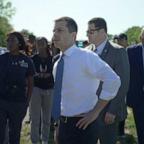
Buttigieg visits predominantly Black community following flooding investigation
- Apr 11, 2:56 PM
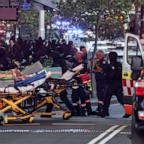
6 dead, suspect killed in attack at major shopping mall in Sydney near Bondi Beach
- 4 hours ago
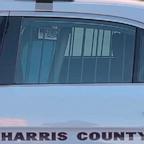
Mom accused of leaving 2 young children home alone for days to go on cruise
- Apr 12, 1:54 PM

Heavy rain across Kauai prompts rescues from floodwater
- Apr 12, 10:03 PM
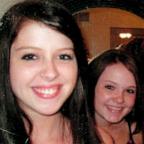
How 2 teenagers plotted their best friend's murder
- Apr 12, 1:14 PM
ABC News Live
24/7 coverage of breaking news and live events
- Cast & crew
- User reviews
Back to Black

The life and music of Amy Winehouse, through the journey of adolescence to adulthood and the creation of one of the best-selling albums of our time. The life and music of Amy Winehouse, through the journey of adolescence to adulthood and the creation of one of the best-selling albums of our time. The life and music of Amy Winehouse, through the journey of adolescence to adulthood and the creation of one of the best-selling albums of our time.
- Sam Taylor-Johnson
- Matt Greenhalgh
- Marisa Abela
- Eddie Marsan
- Jack O'Connell
- 9 User reviews
- 23 Critic reviews
- 52 Metascore

- Amy Winehouse

- Mitch Winehouse

- Blake Fielder-Civil

- Cynthia Winehouse

- Janis Winehouse

- Raye Cosbert

- Nick Shymansky

- A & R Manager

- Aunt Melody

- Perfume Paul

- Island Records Senior Executive

- CID Officer

- Uncle Harold
- All cast & crew
- Production, box office & more at IMDbPro
More like this

Did you know
- Trivia Marisa Abela did all the singing in this film herself. She trained extensively to mimic Amy Winehouse 's vocals.
Technical specs
- Runtime 2 hours 2 minutes
Related news
Contribute to this page.

- See more gaps
- Learn more about contributing
More to explore

Recently viewed

IMAGES
VIDEO
COMMENTS
You will find information on where to go in Japan with a baby or toddler down lower in the post. 1. Passports. Children are required to have their passports to be allowed to travel to and around Japan. You will also need to carry the passport when you travel on trains as you might be required to show it. 2.
Take Day trips. The great thing about basing your self out of big cities in Japan such as Kyoto and Tokyo with a baby is that there are almost endless possibilities for day trips. For instance the city of Osaka, Hiroshima, Nara for the deer and Arashiyama Bamboo Forest all can be done as day trips really easily from Kyoto.
Posted: 10/9/2023 | October 9th, 2023. I love Japan. It's one of my favorite countries in the world. But is it a suitable destination to visit with a baby? Solo female travel expert Kristin Addis from Be My Travel Muse was recently there with her baby and has tons of tips and advice for travelers thinking of taking a baby with them to Japan.. Japan was our first major international trip with ...
Siner's husband and their 8-month-old son on the 13-hour flight to Tokyo. Siner says their baby loved watching other passengers on the plane. Emily Siner. Preethi Harbuck, author of the travel ...
The tickets were fairly reasonable at $2,000 each, plus $250 for having a lap infant. I was so glad we opted for business class on this part of the trip. Not only was the service top-notch, but Japan Airlines' Sky Suite meant we had almost complete privacy, with plenty of room for naps and tummy time. During the trip, I scanned for deals and ...
Visits. Japan happens to be an easy country to enjoy with a baby, at least in the cities. Numerous visits are possible with a young child, and some are even created for them (including numerous gardens and squares in Japan). Also, we easily find bathrooms for babies with changing tables in malls.
Travelling in Japan with our travel pram - the Baby Jogger City Tour 2 Double. It's worth noting that not all tourist attractions are stroller-friendly. For example, Fushimi Inari Shrine in Kyoto has lots of steps, especially the later sections. So it's better to leave the pram at your accommodation when visiting and use a baby carrier.
In this blog post, we've collated some hints, tips and advice from our various InsideJapan mums and dads, gleaned from their experiences travelling with sprogs in Japan. If there's anything we've neglected to cover, please don't hesitate to let us know in the comments below. Mark & Rie, both members of the InsideJapan team, in Japan ...
1. Dress in layers, no matter the season. In the summertime, air conditioned buildings, buses, and trains can feel extremely chilly. Likewise, heated buildings, buses, and trains can feel stuffy. Dress your child in layers so that you can adjust for temperatures. An alternative is to bring a lightweight blanket.
Japan, including the capital, Tokyo, is a surprisingly family-friendly holiday destination. As traveling with babies is always a bit of a challenge, it is good to be prepared so you can make everyone's travel experience a great one. Here are 7 tips on how to travel with a baby in Japan for your best family trip to the Land of the Rising Sun!
Not exactly. We just returned from two wonderful weeks traveling through Japan with our 6-month-old and while some parts of the trip were challenging, I think we did a pretty good job of successfully navigating four cities in two weeks with our baby. Here's everything we did to make our trip to Japan with our baby a memory we'll always hold ...
Tokyo is a must-see; check out my detailed Tokyo itinerary. Here's a summary of our Japan itinerary: 3 Days in Tokyo — to experience all the wacky fun experiences. 2 Days in Hakone — with a stay at a hot spring resort and water park. 2 Days in Okuhida — to experience nature in the Japanese Alps. 1 Day in Kanazawa — to eat the freshest ...
The kids however just loved the place - which seems to have happened a few times over our Japan itinerary, 3 weeks with quirky activities kids love! For 30 minutes at the café the cost is 1430 yen ($15.70 AUD) and worm snacks are additional - not for you, for the hedgehogs! Everyone must pay the entrance fee.
2 Weeks Japan Itinerary with Kids. Tokyo (Days 1 - 5) Day One: Central Tokyo. Tokyo Day 2 - Museums: TeamLab: Borderless and Shinjuku. Tokyo Day 3. Tokyo Day 4-5 Disneyland and Disneysea. Hakone Day 6-7. Week 2 of your Family Trip to Japan Itinerary (Kyoto, Osaka and Nara) Day 8 - Kyoto.
Your son or son-in law will probably be interested in sumo. It is an authentic cultural experience. The set up is baby friendly and you can walk around between matches. Do visit the official website to see whether the competitions are on. It's much better to buy tickets online than taking a chance on the day itself.
Things to do in Tokyo with a baby. Tokyo is quirky, chaotic and charming and there's an abundance of things to do which are fun for both adults and kids. Our baby friendly recommendations include Harajuku, Shibuya Crossing, the Digital Art Museum and exploring Tokyo's parks. Check out our guide on things to do in Tokyo with a baby for a ...
Travelling to Japan with toddlers tips and tricks. Be Prepared for Jet Lag. Move Around - Don't just stay in one place. Don't move around too much. Take Day trips. Avoid Rush Hour if you can. Eating with Toddlers in Japan. Try the cuisine at home first. Don't expect a plentiful availability of high chairs.
We had just under two weeks, which was still enough time to visit some of the main highlights at a relatively steady pace, which we felt was an important factor when travelling with a baby. Tailor-made holidays in Japan. Classic Japan in 2 weeks: Tokyo, Kyoto & the Alps. Tailor-made holidays. 14 days, From £2,895 pp.
2 suitcases (filled with all our clothes, toiletries, baby supplies) 1 travel pram (we also managed to fit our entire packet of nappies, some wipes, and a blanket into the travel pram's carry case!) What we carried: 1 x nappy backpack (2 changes of baby clothes, spare tshirt for me, nappy bag, change mat, wipes, snacks, baby panadol etc etc ...
14. Kid-O-Kid Bornelund in Kawasaki. The Kid-O-Kid Bornelund has various locations throughout Japan but the closest first-rate Kid-O-Kid Bornelund branch is located in Kawasaki City which is 35 minutes train ride from Tokyo. It features various rooms with different themes, toys, and features.
Whether you're interested in Japanese cherry blossom tours, festival tours, autumn leaves tours or special interest tours, our Japan tour packages will bring your vacation dreams to reality. Choose tours based on style, interest, date, or season. Our Japan group tour packages are fully escorted, and we can also arrange special-interest ...
All Japan Tours brings you outside the big city of Tokyo for an enchanting 5-day itinerary strewn with flowers in this Beyond Tokyo Deluxe Group Tour. ... you will behold millions of Nemophila or "baby blue eyes", covering the grassy hills. Before we move in, take a walk through Kairakuen Garden - one of Japan's Three Great Gardens. Then, in ...
22 days 21 nights. |. from USD $8998.00. Single Supplement: USD $1900.00. View more details. View Room Type Explained. Take the ultimate journey to Japan during cherry blossom season, see the baby blue eye flowers, and view the elegant Aoi Festival. Tour Information.
Roy Cooper, Governor of North Carolina and Kristin Cooper, arrive at the Booksellers area of the White House for the State Dinner hosted by President Joe Biden and first lady Jill Biden for Japan ...
Back to Black: Directed by Sam Taylor-Johnson. With Marisa Abela, Jack O'Connell, Eddie Marsan, Lesley Manville. The life and music of Amy Winehouse, through the journey of adolescence to adulthood and the creation of one of the best-selling albums of our time.